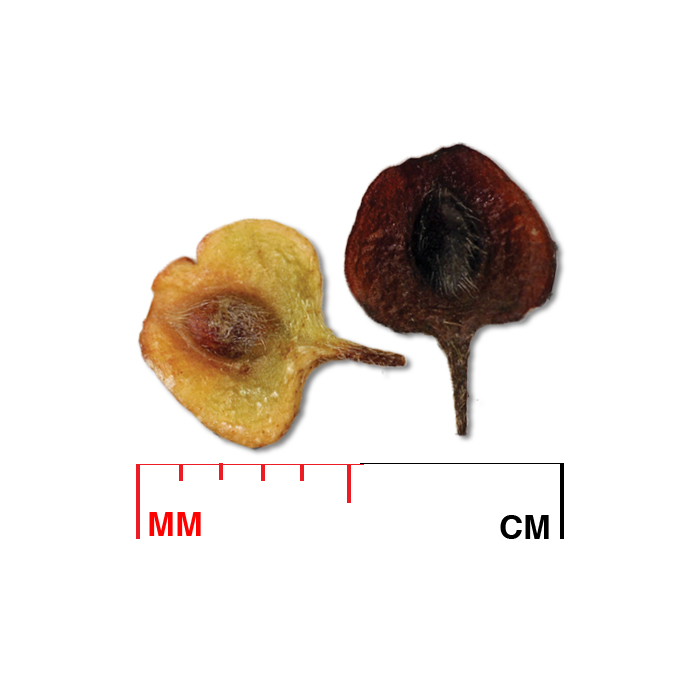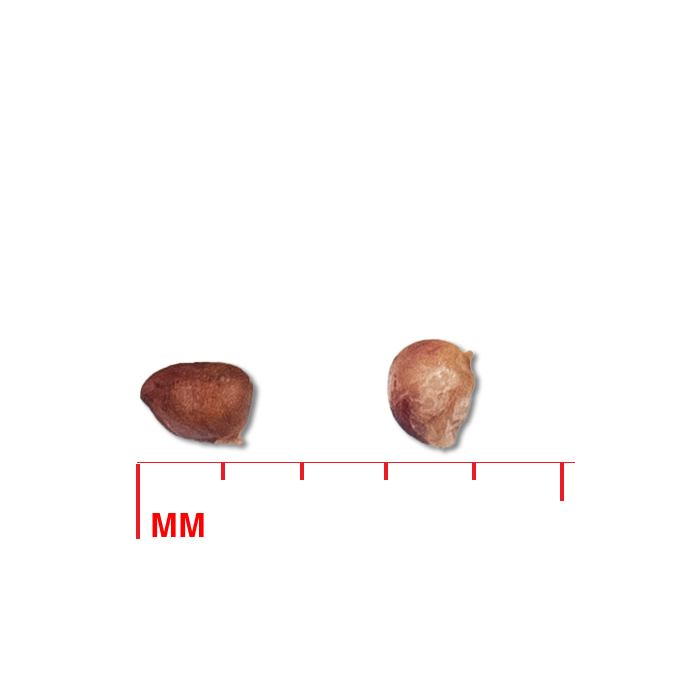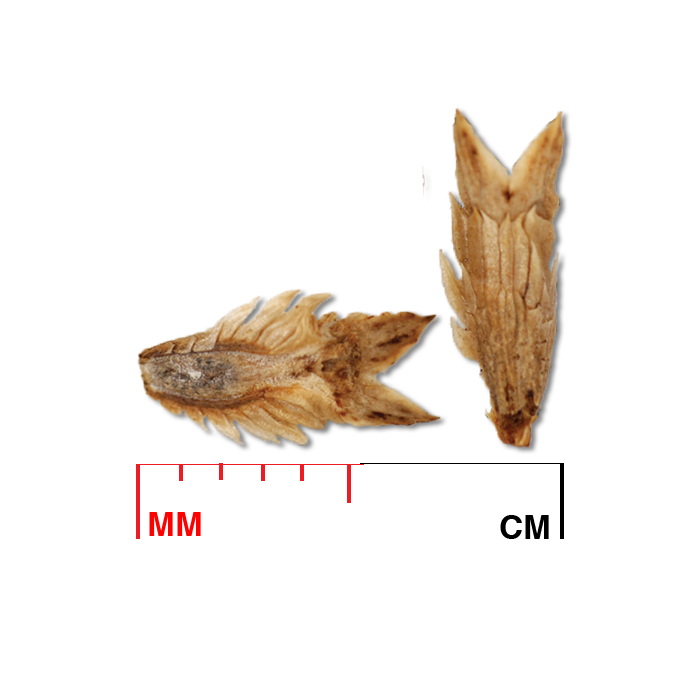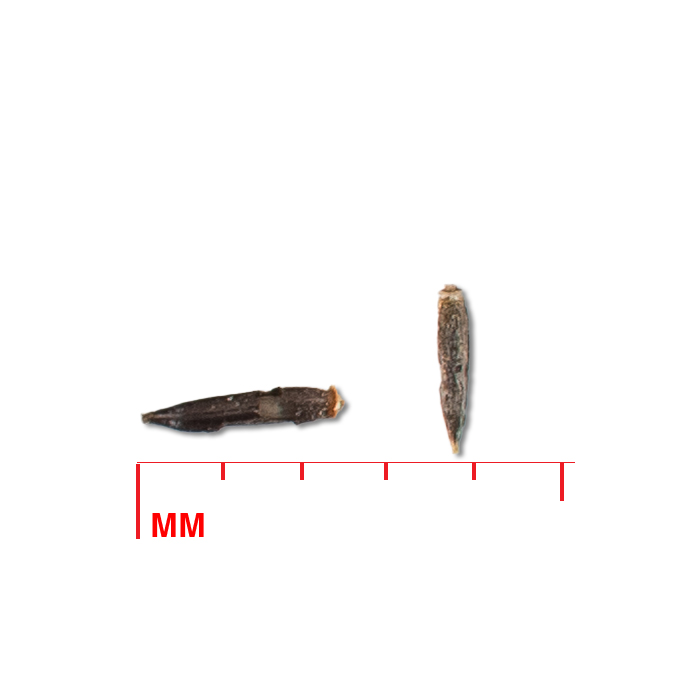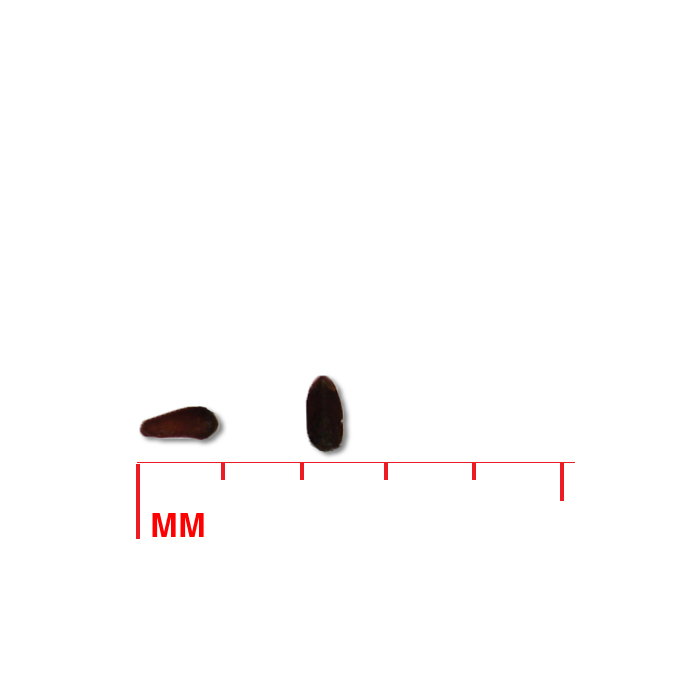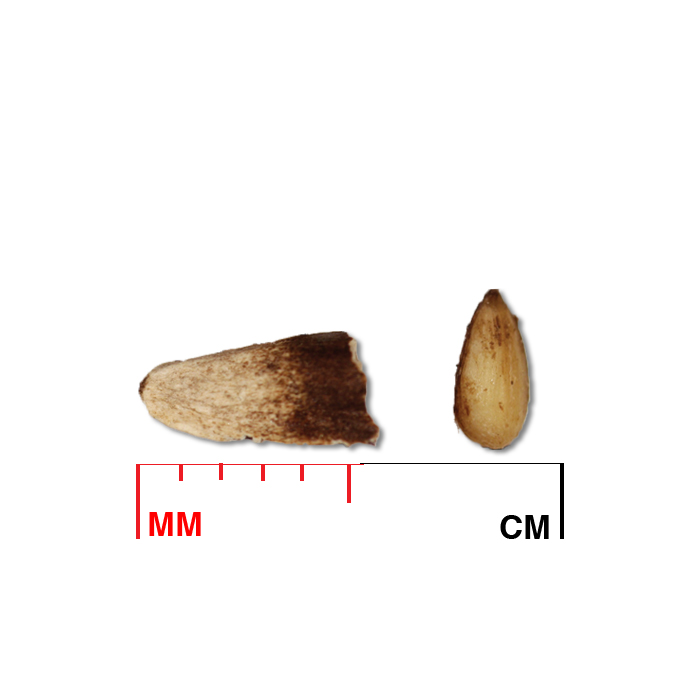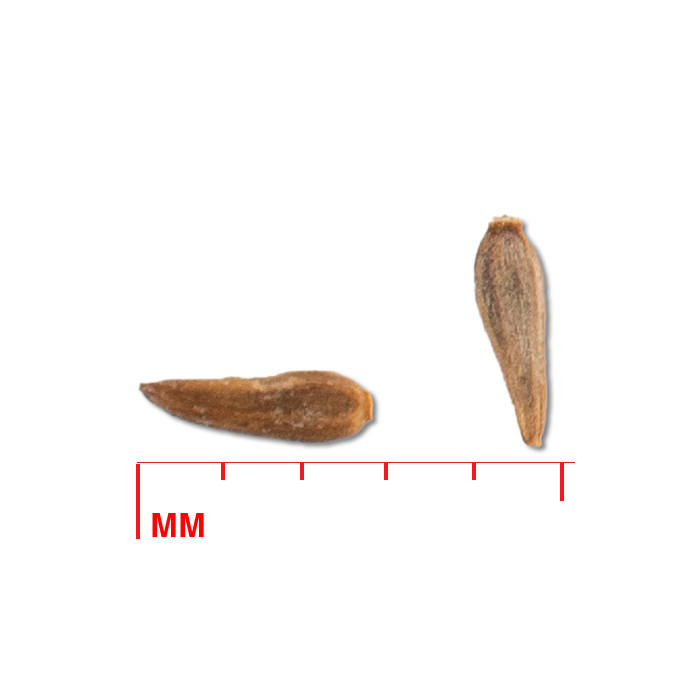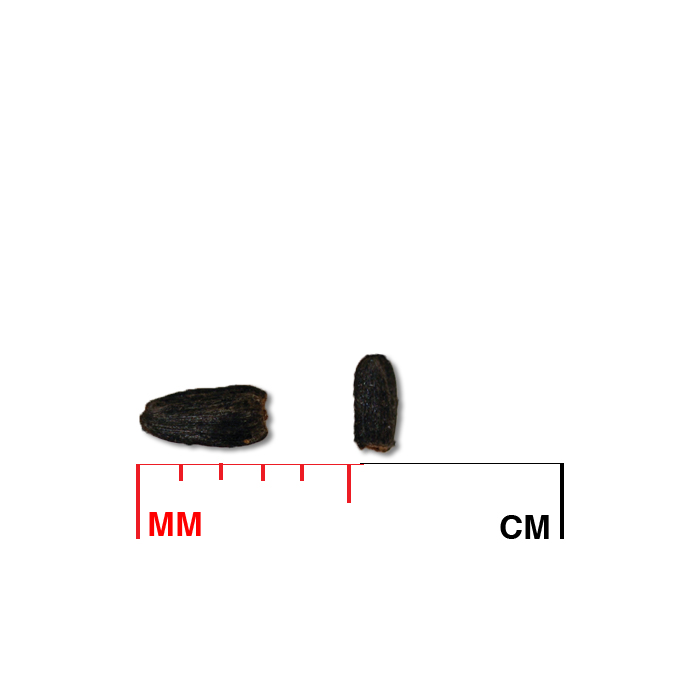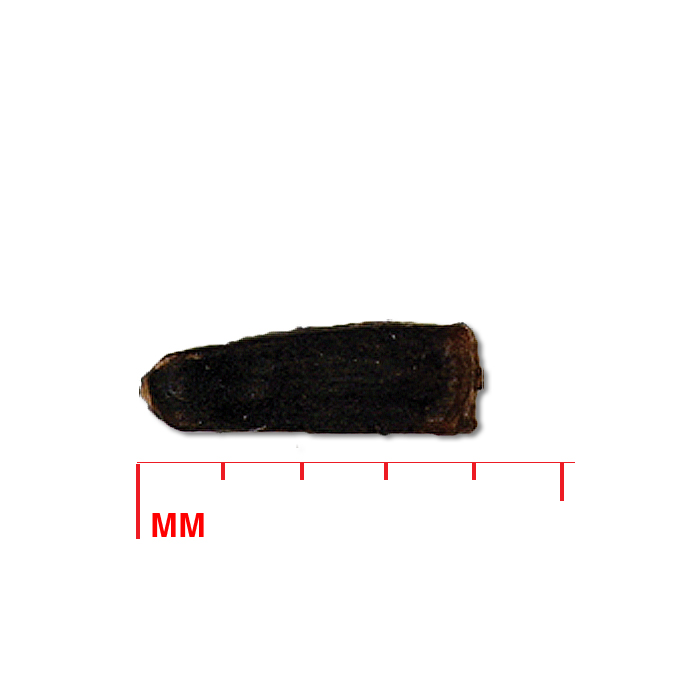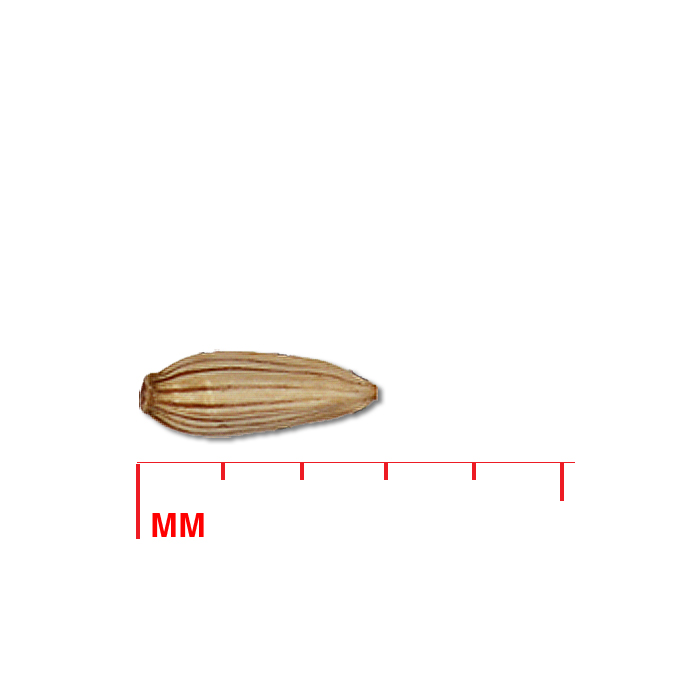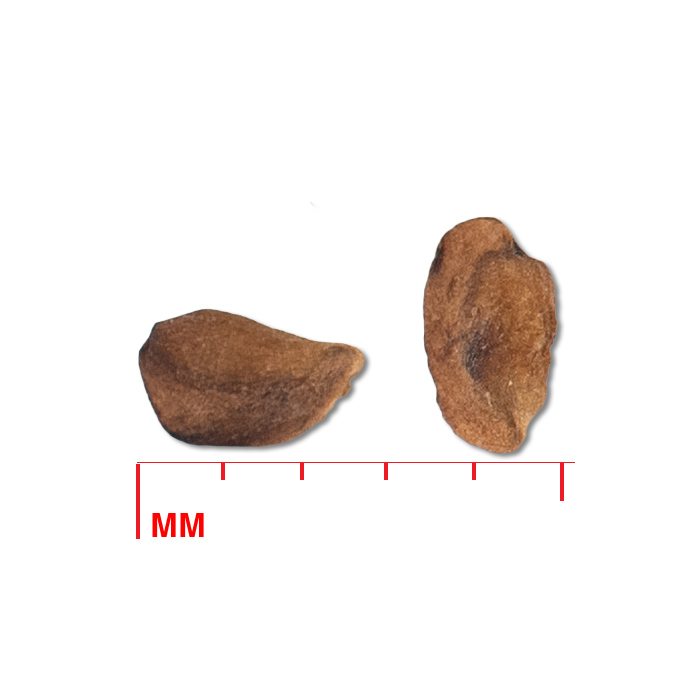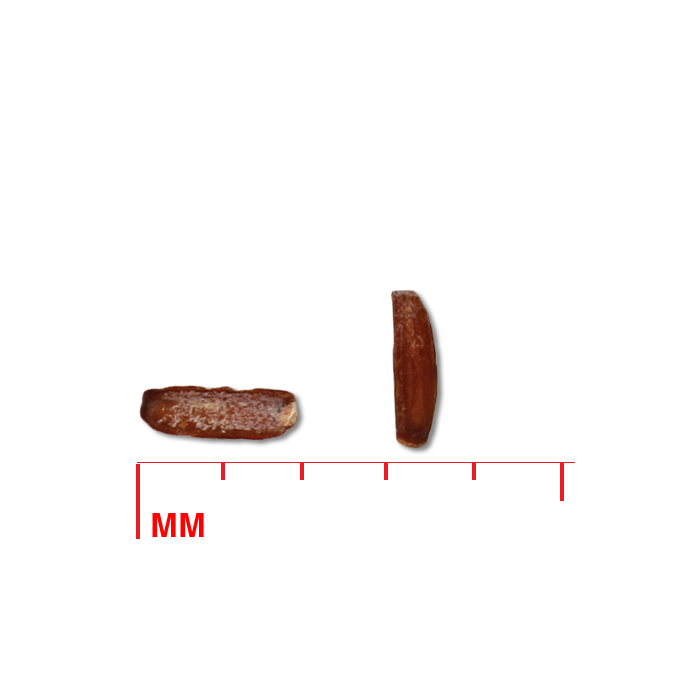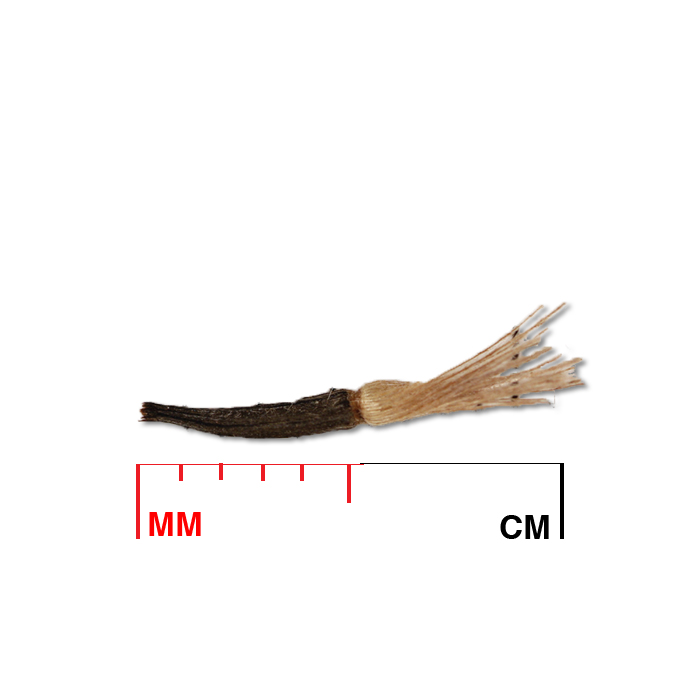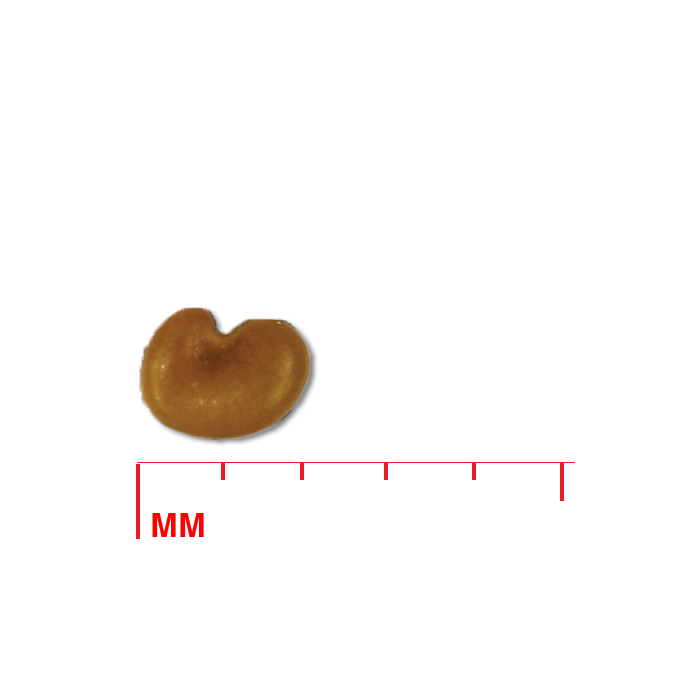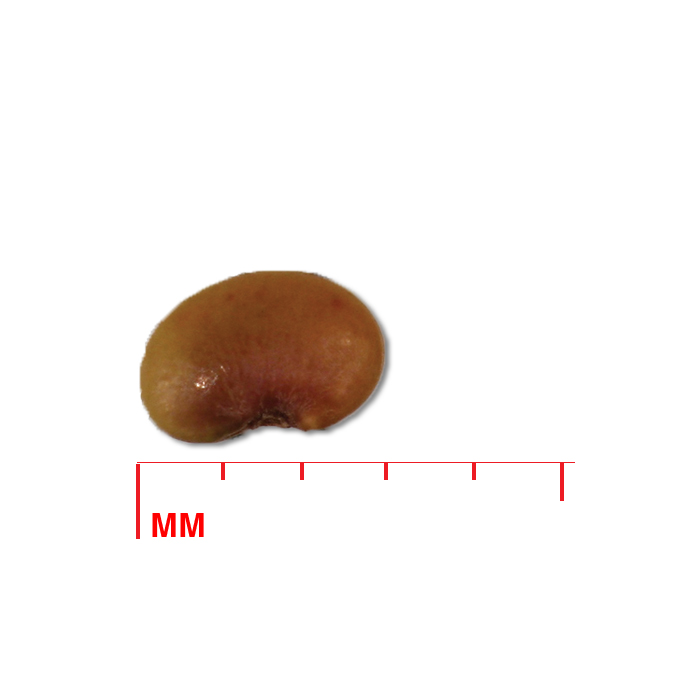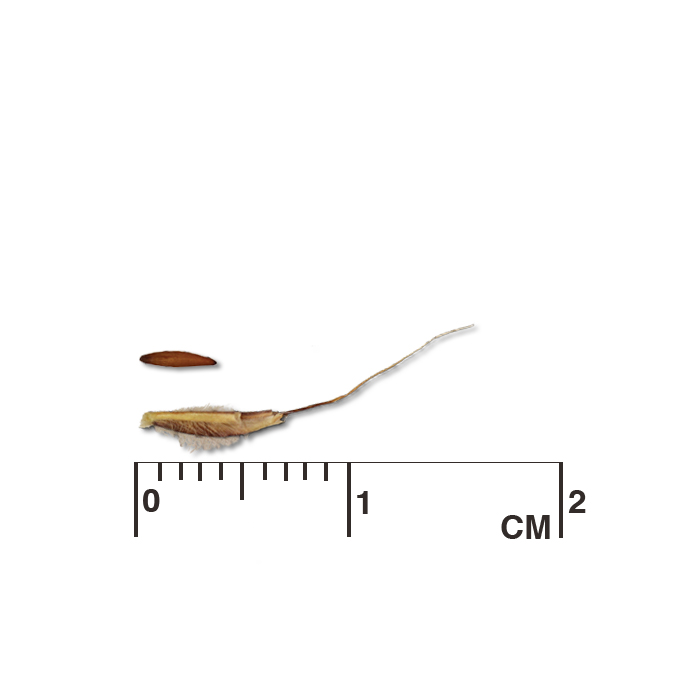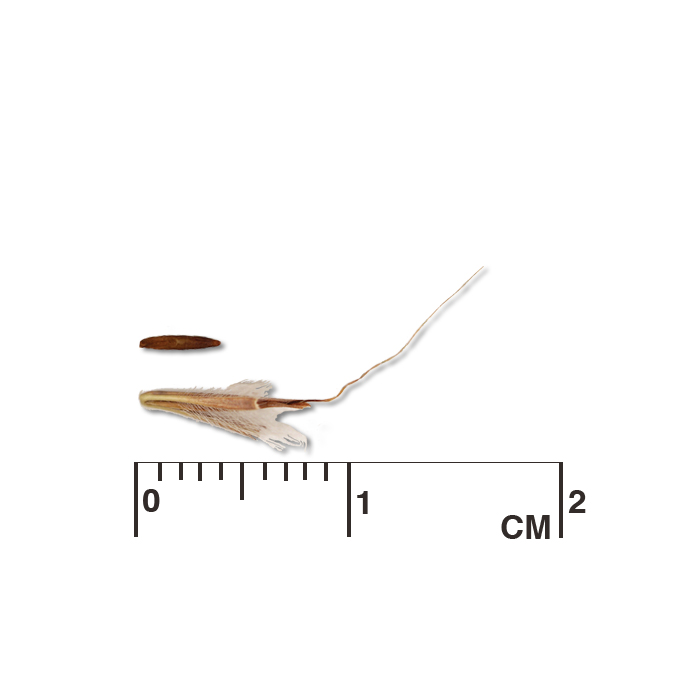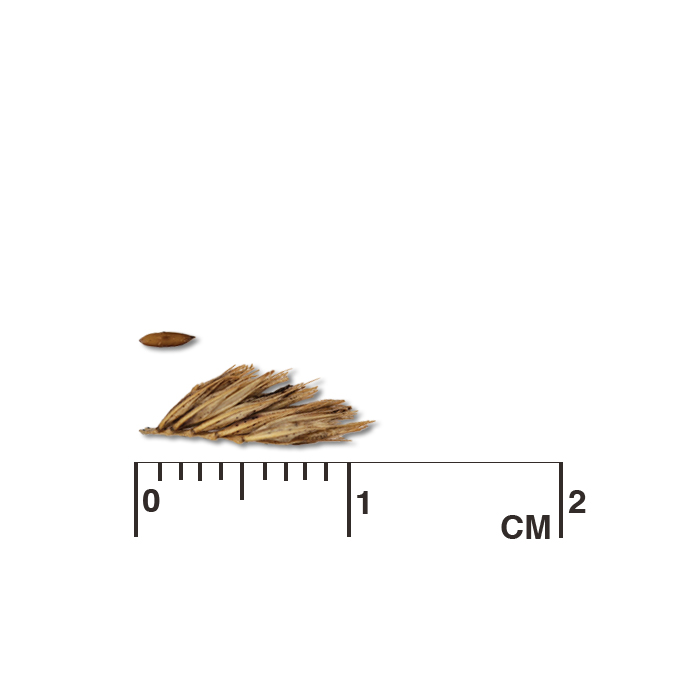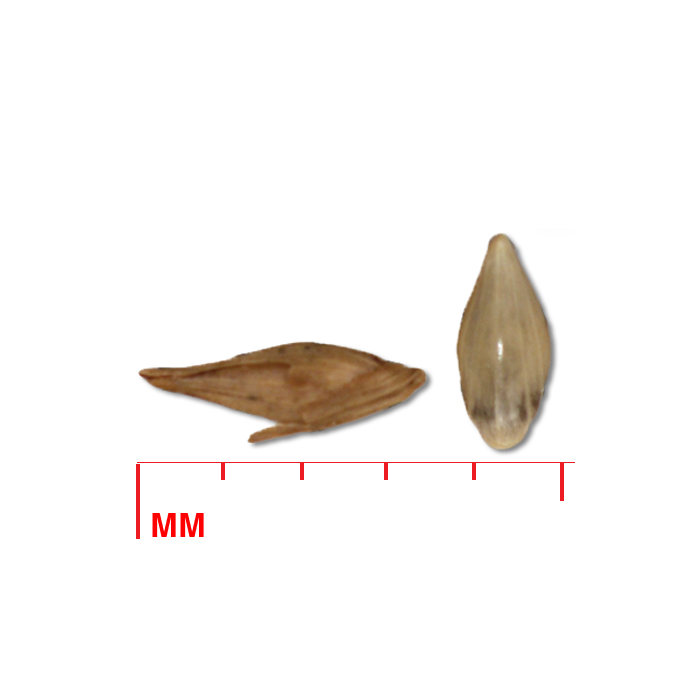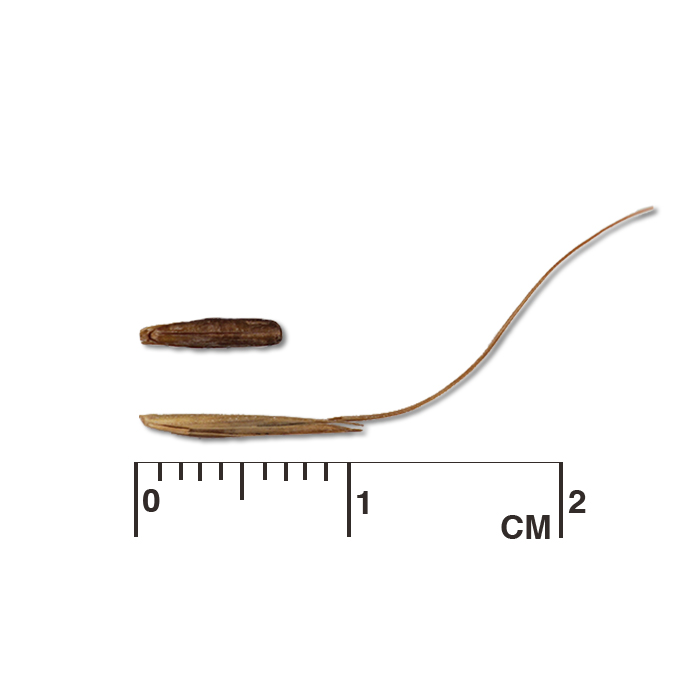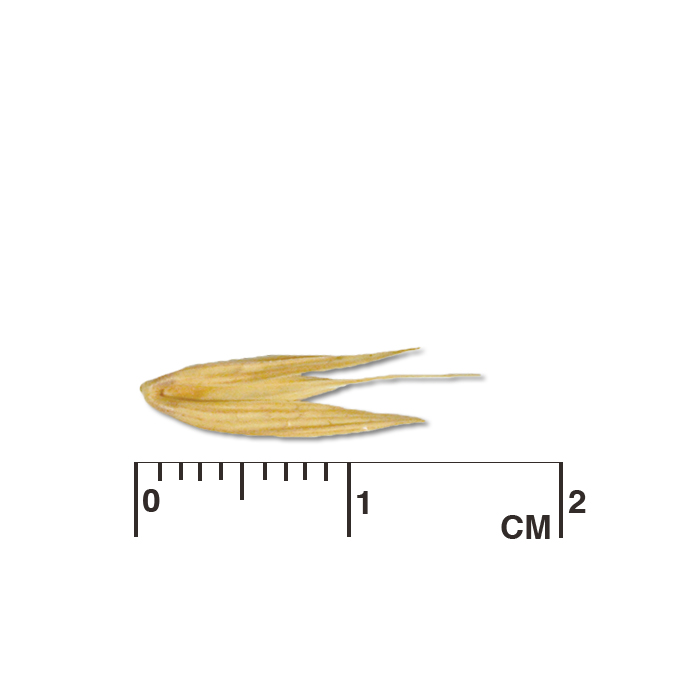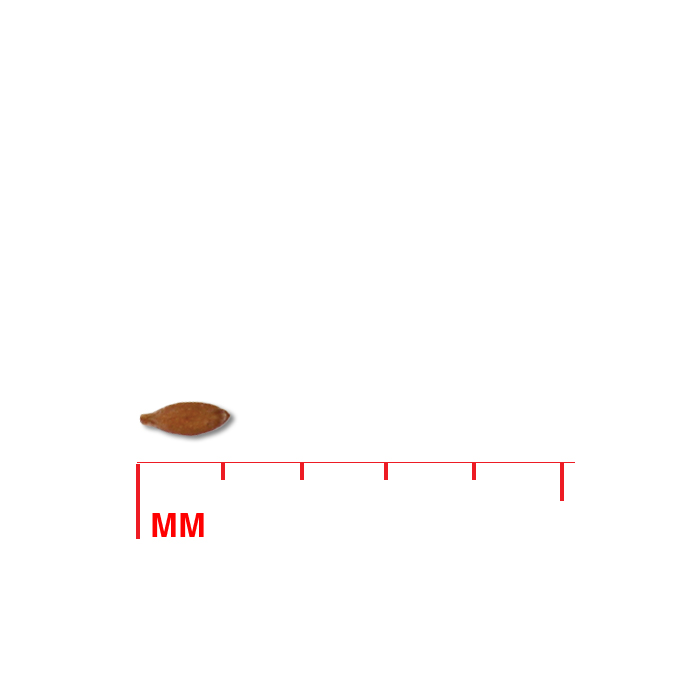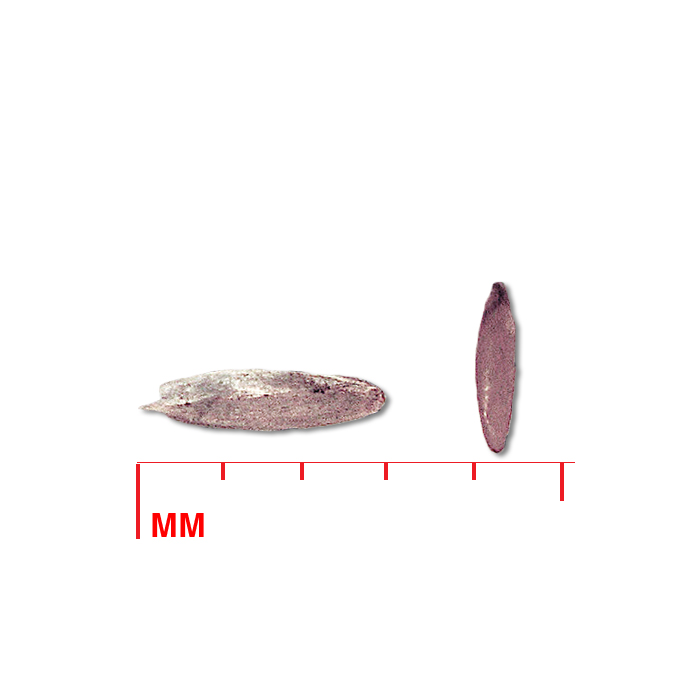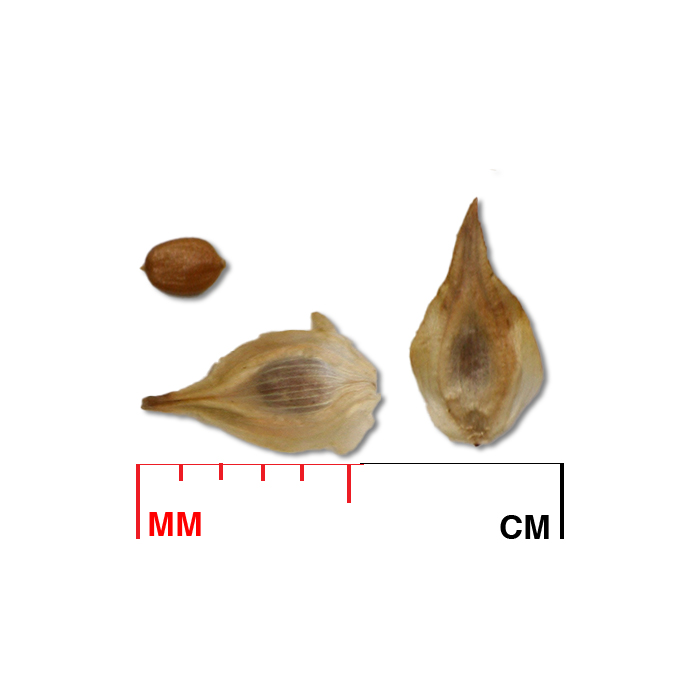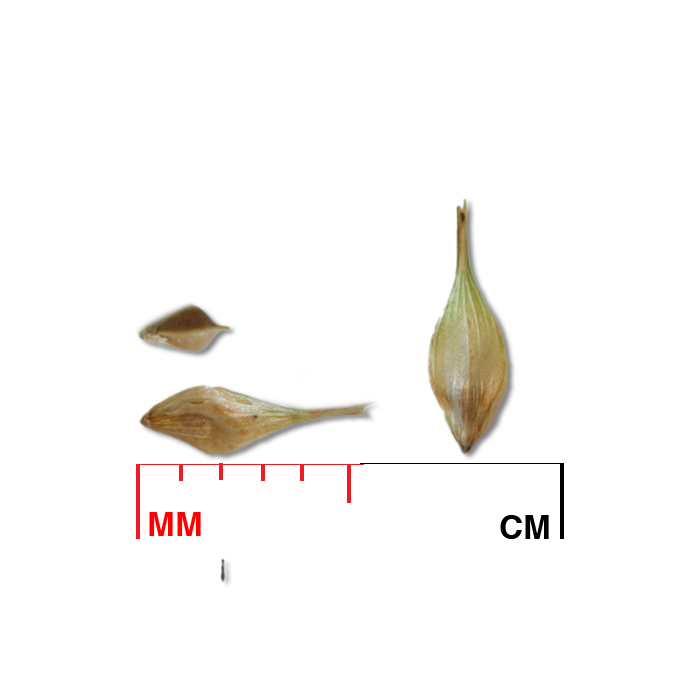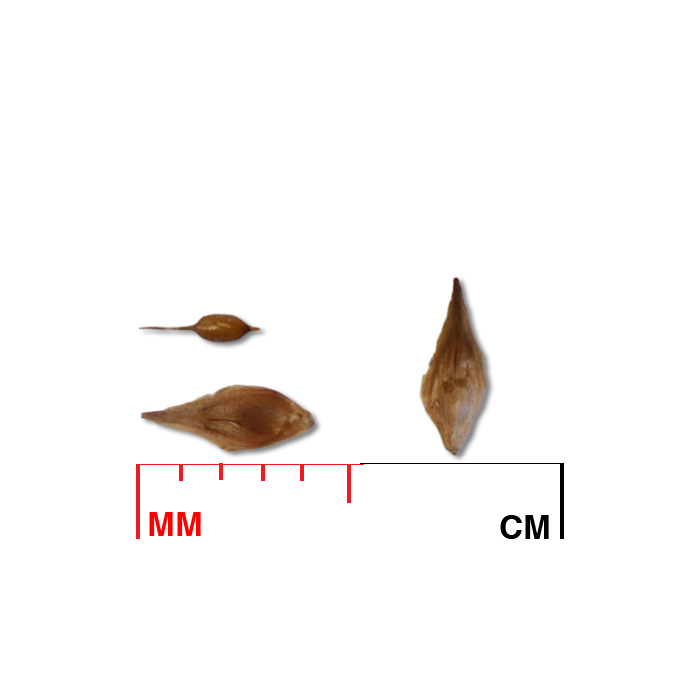Species Production Guides
Species Production Guides sagemThis section consists of specific information on seed production for selected species in the following functional groups: forbs (wildflowers), legumes, warm season grasses, cool season grasses, sedges, and woody species (prairie shrubs). Each species production guide includes a description of the species (with photos), its habitat, range map, and conservation status.
Recommendations for stand establishment, management, seed harvest, and seed cleaning are provided. These are based primarily on direct experience at the Tallgrass Prairie Center, together with published information from the NRCS Plant Materials Program, scientific publications, personal communication with other native seed growers, and publicly available databases such as the Seed Information Database and the Propagation Protocols Database of the Native Plant Network. A graph of potential seed yields is provided in each guide, based on harvest records from seed production plots at the Tallgrass Prairie Center.
Each species guide is provided as both a webpage and a printable file (pdf). If you prefer to work with a print version, we encourage you to print pdfs of the species you need and organize them in a binder.
This section is a work in progress. We will continue to add new species guides as they are completed. If you have comments, questions or would like to share propagation information for potential inclusion in these guides, please email laura.walter@uni.edu.
Forbs
Forbs sagemThe Species Production Guides for forbs (wildflowers) provide specific information about growing each of these species for seed production.
Scroll the list (alphabetized by scientific name) or press ctrl-f (or command-f) to search for any name in this page.
A printable file (pdf) is also provided on each species page for those needing a print version.
This section is a work in progress. We will continue to add new species guides as they are completed.
Anemone cylindrica / candle anemone
Anemone virginiana / tall thimbleweed
Asclepias syriaca / common milkweed
Asclepias verticillata / whorled milkweed
Chelone glabra / white turtlehead
Coreopsis tripteris / tall tickseed
Potentilla arguta / tall cinquefoil
Euthamia graminifolia / flat-top goldentop
Gentiana alba / plain gentian
Gentiana andrewsii / closed bottle gentian
Helianthus pauciflorus / stiff sunflower
Hypericum ascyron / great St. Johnswort
Liatris ligulistylis / Rocky Mountain blazing star
Liatris pycnostachya / prairie blazing star
Lobelia cardinalis / cardinalflower
Lobelia siphilitica / great blue lobelia
Lythrum alatum / winged lythrum
Monarda fistulosa / wild bergamot
Monarda punctata / spotted beebalm
Oligoneuron riddellii / Riddell's goldenrod
Parthenium integrifolium / wild quinine
Prunella vulgaris ssp. lanceolata / lance selfheal
Pycnanthemum verticillatum var. pilosum / whorled mountainmint
Pycnanthemum virginianum / Virginia mountainmint
Rudbeckia subtomentosa / sweet coneflower
Ruellia humilis / hairy wild petunia
Silphium integrifolium / wholeleaf rosinweed
Silphium laciniatum / compassplant
Solidago missouriensis / Missouri goldenrod
Solidago speciosa / showy goldenrod
Symphyotrichum laeve / smooth blue aster
Symphyotrichum novae-angliae / New England aster
Symphyotrichum oolentangiense / skyblue aster
Symphyotrichum praealtum / willowleaf aster
Tradescantia bracteata / longbract spiderwort
Tradescantia ohiensis / bluejacket
Vernonia baldwinii / Baldwin's ironweed
Vernonia fasciculata / prairie ironweed
Veronicastrum virginicum / Culver's root
Zizia aptera / meadow zizia
Zizia aurea / golden zizia
Canadian anemone
Canadian anemone dickeye
Anemone canadensis L.
Alternate Common Names: meadow anemone, Canada anemone, roundleaf thimbleweed, crowfoot, round-leaved anemone
Scientific Synonyms: Anemonidium canadense (L.) Á. Löve & D. Löve, Anemone dichotoma var. canadensis (L.) C. MacMillan
Family: buttercup family (Ranunculaceae)
Functional Group: forbs (wildflowers)
Description
- Life cycle and growth form
Perennial, rhizomatous, forms colonies.
Height: 1-2 ft
- Leaves and stem
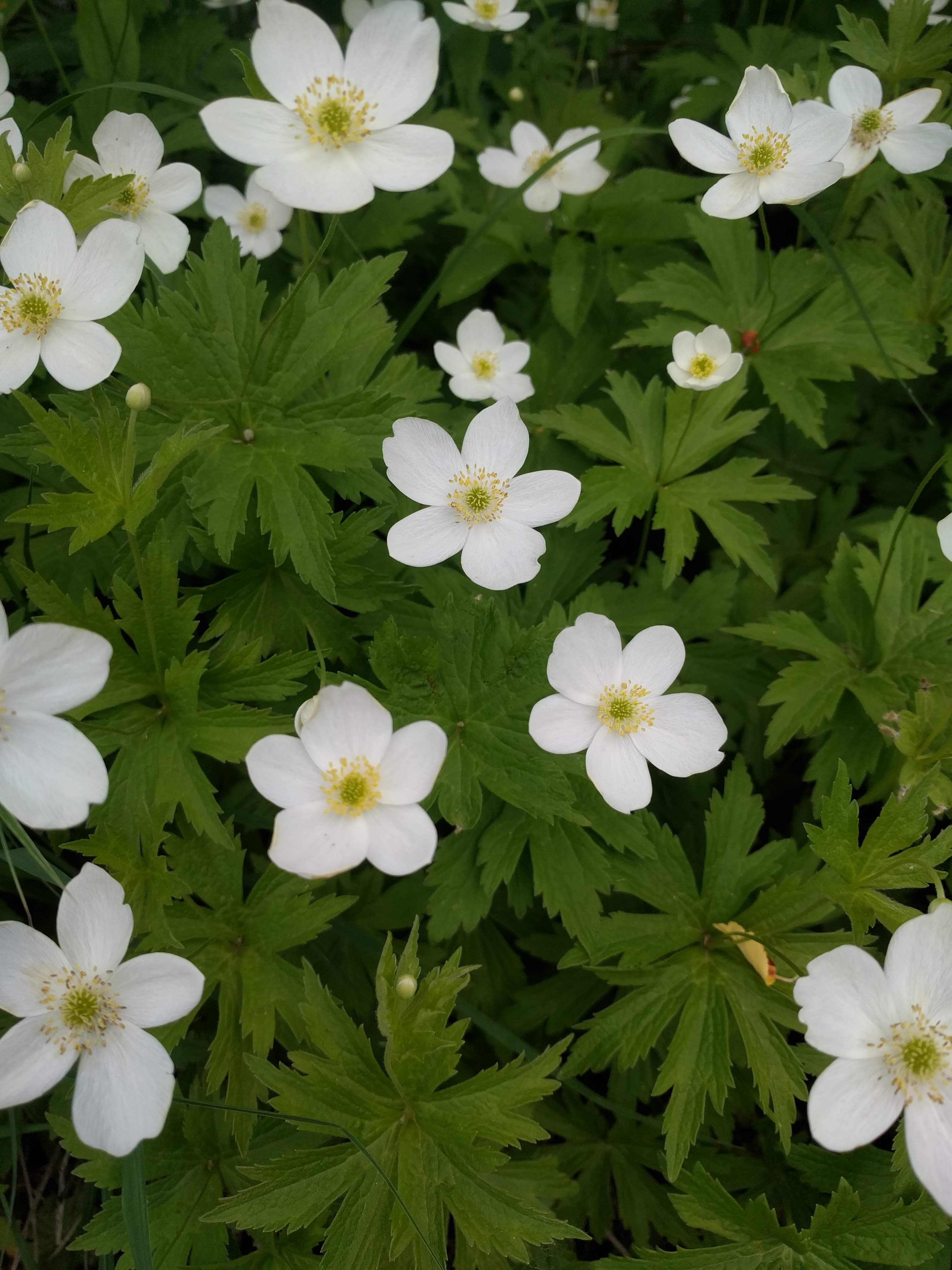
Leaves basal with long (6 in) stalks, roughly round in outline with 3-5 deep lobes, irregularly toothed margins, and flattened hairs; flowering stem is stiff and hairy and bears a whorl of three stalkless leaves.
- Flower, fruit and seedhead
Flower: Large white flowers, 5-parted, with numerous yellow stamens and a green center, up to 1 1/2 in wide, borne singly or in loose clusters of up to 3 flowers at tops of stalks.
Fruit/seedhead: Seed head mace-like, globular, containing numerous beaked achenes, often overtopped by foliage at maturity.
Pollination: Small bees and flies.
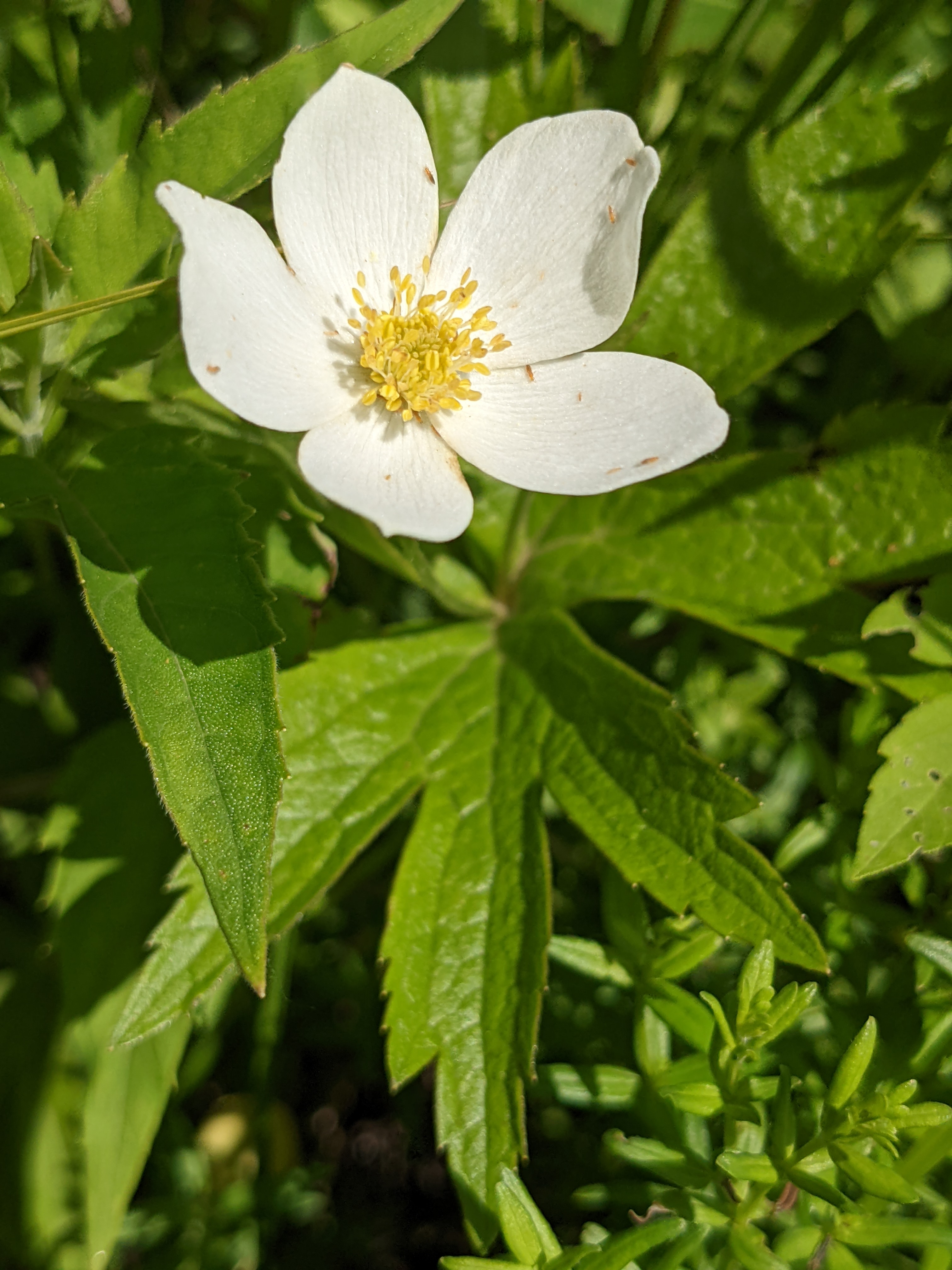
- Seed
Seed characteristics
Seed weight:
Seeds per ounce: 8,000 (IA NRCS)
Seeds per pound: 128,000 (IA NRCS)
1000 seed weight: 2.89 g (Seed Information Database)
Description: ‘Seeds’ are actually one-seeded flattened fruits (achenes), about 1/8 in diameter, arranged in a ball-shape about 3/8 in diameter.
Typical seed test
PLS: 88% (n = 11)
Purity: 96% (n = 11)
Germination: 2% (n = 6)
Dormant: 91% (n = 6)
(averages obtained from n tests of purchased seed lots)
- Habitat and range
Habitat: Mesic to wet-mesic soil; partial to full sun; moist prairies, sedge meadows, openings in floodplain woodlands, woodland borders, banks of streams, swampy areas; Wetland Indicator Status is Facultative Wetland (FACW) for the Midwest.
Conservation status: Global- G5, secure; Kentucky and Tennessee- SX, presumably extirpated; District of Columbia, Maryland, and Virginia- SH, possibly extirpated; New Jersey and West Virginia- S1, critically imperiled; Connecticut and Wyoming- S2, imperiled; Kansas- S3, vulnerable (NatureServe)

General Comments
Canada anemone blooms early in the growing season, making it an important option for inclusion in pollinator habitat seed mixes. Remnant populations of this species persist along rural roads in Iowa, suggesting that it could be a long-lasting addition to roadside plantings, once established. Its low growth form, adaptability, and spreading habit may also be suitable for novel planting situations such as beneath solar panels. This species is challenging to propagate from seed because of its deep dormancy and difficulties with germination, but once established it tends to spread prolifically and is relatively easy to manage, harvest, and clean. Canada anemone may also be propagated by division of the rhizomes, but more than one genetic clone is needed for seed production.
Recommendations for Seed Production
- Establishment for seed production
Direct seeding
Row spacing: 30-36 in rows
Seeding rate: 4.5 PLS pounds/acre (40 seeds/linear foot)
Seeding method: Native seed drill.
Seeding time: Dormant season
Weed control: Prepare clean, firm, weed free seedbed prior to seeding.
Greenhouse
Seed pre-treatment: Moist stratify 12 weeks at 40° F, or alternatively in ambient winter conditions (unheated building).
Sowing: Sow seed in greenhouse two months before last frost free date. Typically this species exhibits very high dormancy (low germination) and may require two winter cycles to germinate.
Transplanting: Transplant into bare soil in rows or weed barrier at 8 in intervals after all danger of frost is past. Once plants are established they spread prolifically by rhizomes, so the weed barrier will need to be removed or slit open to accommodate growth and enhance seed production.
- Stand management
Weeds: Post-emergent grass herbicide, tillage, hand roguing. Weed control is critical to successful establishment and seed production of this species. Read and follow label instructions.
Pests: Blister beetles may forage voraciously on foliage.
Diseases: None noted.
- Seed production
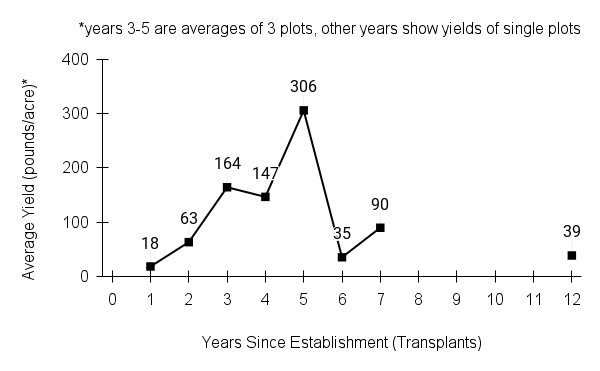
First harvest: Some flowering and seed set at the end of first growing season from greenhouse grown transplants. Direct seeded stands may take 3 years to become productive.
Yield: 18-306 pounds/acre (yields extrapolated based on production from 3 plots)
Stand life: Peak harvests occurred in the years 3-5 after transplanting. Stands at TPC have persisted for 20 years without management, but harvests made from one plot in years 7 and 12 were much smaller than peak yields.
Flowering date: mid-May - late June.
Seed maturity/Harvest date: mid - late July
Seed retention: Shattering occurs soon after (and perhaps before) seed maturity.
Harvest date range at TPC (2003-2015): July 15 - July 29
Recommended harvest method: Combine near maturity, but before seed head breaks apart.
- Seed cleaning and storage
Cleaning process: Pre-clean air-dried material by scalping thru 1/2 in and 1/4 in mesh to remove large particles. Air-screen to clean.
Seed storage: Stores well in refrigerated conditions (32-40° F, 40-60% RH).
Released Germplasm
Source Identified material: Natural Selections/Iowa Ecotype Zones 1, 2, 3
- References
Chayka, K. (n.d.). Anemone canadensis (Canada anemone). Minnesota Wildflowers. https://www.minnesotawildflowers.info/flower/canada-anemone
Dutton, B. E., Keener, C. S., & Ford, B. A. (2020, November 5). Anemone canadensis Linnaeus. Flora of North America. https://floranorthamerica.org/Anemone_canadensis
Hilty, J. (2019). Meadow anemone - Anemone canadensis. Illinois Wildflowers. https://www.illinoiswildflowers.info/prairie/plantx/mdw_anemone.html
Houseal, G. A. (2007). Forbs wildflowers. In G. A. Houseal (Eds.), Tallgrass Prairie Center’s native seed production manual (pp. 26–27). Tallgrass Prairie Center - University of Northern Iowa.
Kartesz, J.T., The Biota of North America Program (BONAP). 2023. North American Plant Atlas. (http://bonap.net/napa). Chapel Hill, N.C. [maps generated from Kartesz, J.T. 2023. Floristic Synthesis of North America, Version 1.0. Biota of North America Program (BONAP). (in press)]
NatureServe. 2024. NatureServe Network Biodiversity Location Data accessed through NatureServe Explorer [web application]. NatureServe, Arlington, Virginia. Available https://explorer.natureserve.org/. (Accessed: February 29, 2024).
Runkel, S. T., & Roosa, D. M. (2009). Canada anemone. In Wildflowers of the tallgrass prairie: The upper Midwest (2nd ed., pp. 54–55). University of Iowa Press.
Society for Ecological Restoration, International Network for Seed Based Restoration and Royal Botanic Gardens Kew. (2023) Seed Information Database (SID). Available from: https://ser-sid.org/ (February 2023)
USDA NRCS National Plant Data Team. (n.d.). Anemone canadensis L.. USDA plants database. https://plants.usda.gov/home/plantProfile?symbol=ANCA8
Species Guide Updated 12/1/2025
Stiff tickseed
Stiff tickseed dickeye
Coreopsis palmata Nutt.
Alternate Common Names: stiff coreopsis, prairie coreopsis, prairie tickseed, finger tickseed, tickseed
Family: aster or sunflower family (Asteraceae)
Functional Group: forbs (wildflowers)
Description
- Life cycle and growth form
Perennial, fibrous-rooted and rhizomatous, spreads vegetatively to form clonal colonies.
Height: 1-3 ft
- Leaves and stem
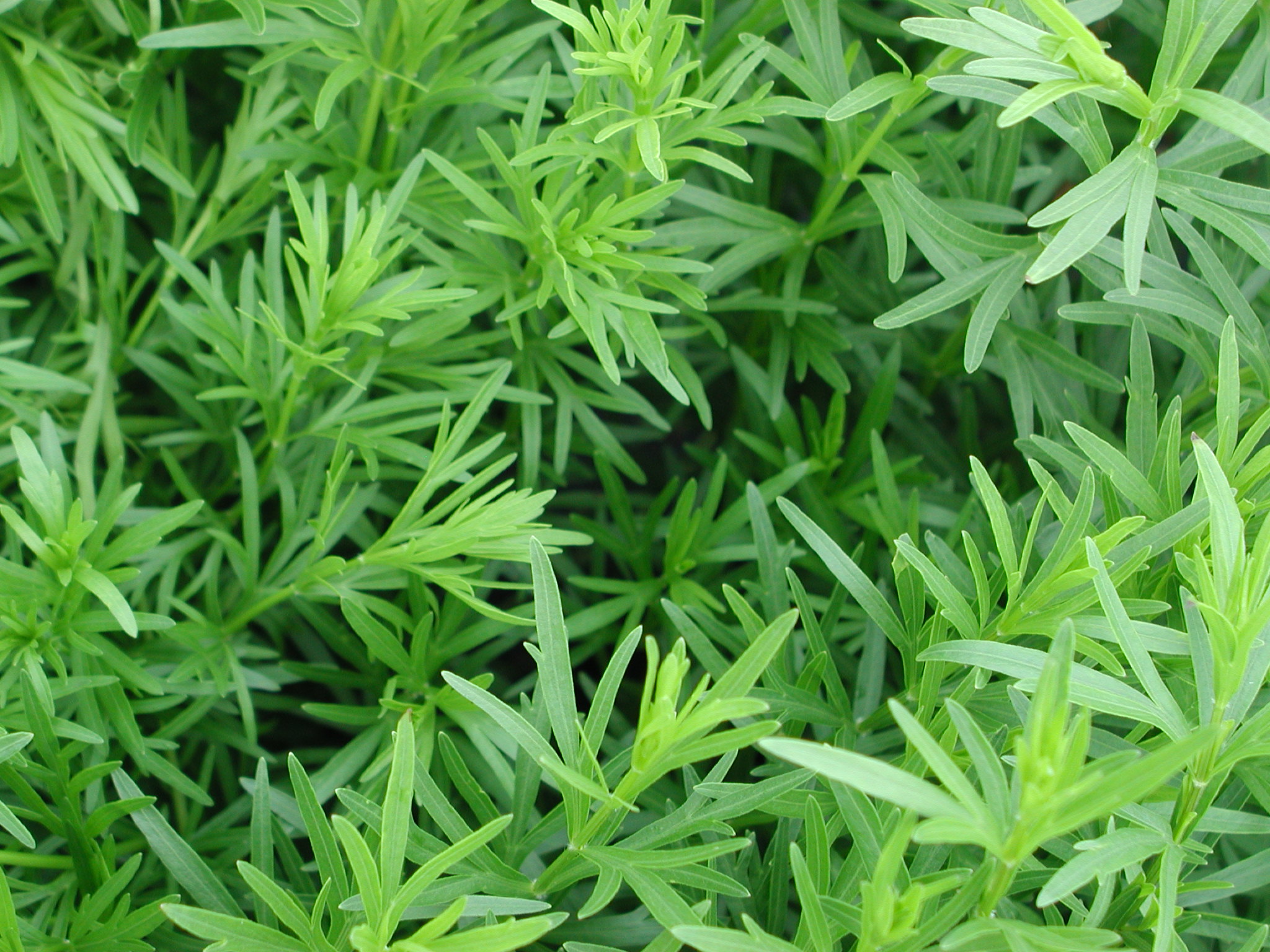
Leaves opposite, sessile on the stem, deeply divided into 3 finger-like lobes; stem is rigid and grooved, mostly hairless except at the nodes, dark green in color, leafy, typically unbranched.
- Flower, fruit and seedhead
Flower: Yellow composite flower heads 1-2 in across with yellow centers that turn brown as they mature, ringed by 8-12 notched “petals” (ray florets); one to a few flower heads per stalk.
Fruit/seedhead: Center disk of head turns dark brown-black at maturity; only marginal flowers produce “seeds” (achenes).
Pollination: Insects such as bees, moths, butterflies, flies, and beetles.
- Seed
Seed characteristics
Seed weight:
Seeds per ounce: 10,000 (IA NRCS)
Seeds per pound: 160,000 (IA NRCS)
1000 seed weight: 2.13 g (Seed Information Database)
Description: Seed units are oblong, flattened, inwardly curved achenes with winged margins, 1/4 in (5 mm) long.
Typical seed test
PLS: 64% (n = 11)
Purity: 70% (n = 11)
Germination: 41% (n = 10)
Dormant: 51% (n = 10)
(averages obtained from n tests of purchased seed lots)
- Habitat and range
Habitat: Mesic to dry-mesic soil; full sun; medium to high quality prairie and savannas. For seed production, avoid wet or poorly drained soils.
Conservation status: Global- G5, secure; Louisiana and Michigan- S2, imperiled; Nebraska- S1/S3, critically imperiled to vulnerable; South Dakota- S3, vulnerable (NatureServe)
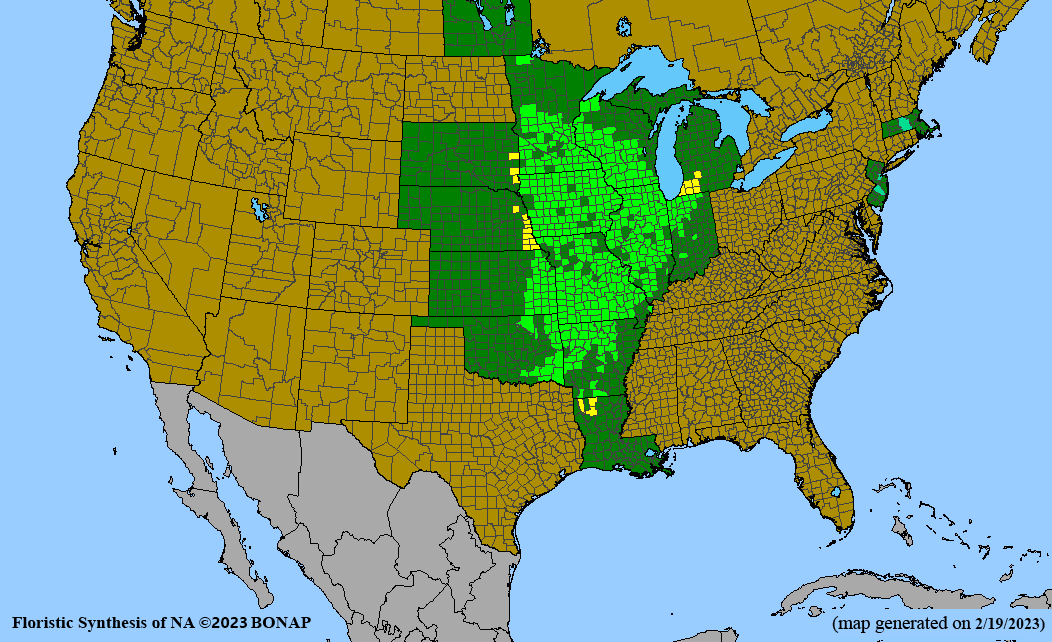
General Comments
Stiff tickseed typically occurs in colonies (clonal) in native prairies, spreading from rhizomes. This species supports numerous species of pollinators, including a specialist bee (Melissodes coreopsis), and herbivorous insects. Flattened, inwardly curved, winged achenes make air-screen separation of “seed” from inert plant parts difficult and this is reflected in the average purity reported from seed tests.
Recommendations for Seed Production
- Establishment for seed production
Direct seeding
Row spacing: 30-36 in rows
PLS pounds/acre: 3.0
Seeds per linear foot: 40
Seeding depth: 1/4 in
Seeding method: native seed drill
Seeding time: dormant season
Weed control: Prepare clean, firm, weed free seedbed prior to seeding.
Greenhouse
Seed pre-treatment: Wet stratify 8-12 weeks at 40° F.
Sowing: Sow seed in greenhouse at 1/4 in depth two months before last frost free date.
Transplanting: Harden off, transplant into prepared rows after all danger of frost. Permanent weed barrier is NOT recommended since this species spreads vegetatively, however, a biodegradable barrier can help reduce weed pressure during the first year. If planted into non-biodegradable plastic, holes must be opened further or plastic removed entirely in subsequent years.
- Stand management
Weeds: Weed barrier in first year can suppress many weeds. Mow or cultivate between rows. Consider post emergence grass herbicide and roguing to prevent weed seed from contaminating seed lots.
Pests: None noted.
Diseases: Crown root rot if planted in too wet soils.
- Seed production
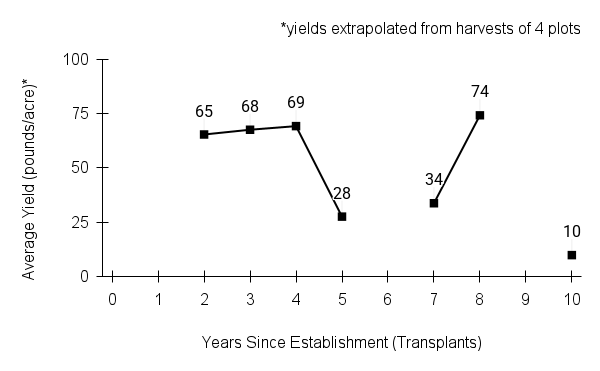 First harvest: Some flowering in the first growing season from transplants, but minimal seed production. Flowering and seed production increases in the second year.
First harvest: Some flowering in the first growing season from transplants, but minimal seed production. Flowering and seed production increases in the second year.Yield: 10-80 bulk pounds/acre (per acre yields extrapolated based on production from 4 plots)
Stand Life: Peak harvest appears to occur in the second to third year. Stand persists but seed production may decline or fluctuate in later years. Aerating the soil of the plot post-harvest with a turf aerator may enhance seed set the following season.
Flowering date: June - mid-July in northern Iowa
Seed maturity/Harvest date: October in northern Iowa
Seed retention: Relatively low risk; shattering occurs late October to early November
Harvest date range at TPC (2003-2021): Sept 11 - Nov 6
Recommended harvest method: Combine
- Seed cleaning and storage
Cleaning process: Pre-clean combined material by scalping through 1/2 in and 1/4 in mesh to remove large plant matter and brush (stiff bristles) to make flowable, then air-screen repeatedly, and indent if needed to remove small seeded weeds. Because seeds are flat, separation from leaf particles of similar size and weight requires repeated air-screen cleaning to improve purity. (No awns or appendages to remove.)
Seed storage: cool/dry (33-50° F, 30-50% RH)
Released Germplasm
Source Identified material: Natural Selections/Iowa Ecotype Project Zones 1, 2, and 3, Northern Missouri Germplasm, Western Missouri Germplasm
- References
Chayka, K. (n.d.). Coreopsis palmata (prairie coreopsis). Minnesota Wildflowers. https://www.minnesotawildflowers.info/flower/prairie-coreopsis
Cochrane, T. S., Elliot, K., & Lipke, C. S. (2014). Prairie tickseed. In Prairie plants of the University of Wisconsin-Madison Arboretum (3rd ed., p. 73). University of Wisconsin-Madison Arboretum.
Hilty, J. (2019). Praire coreopsis - Coreopsis palmata. Illinois Wildflowers. https://www.illinoiswildflowers.info/prairie/plantx/pr_coreopsisx.htm
Houseal, G. A. (2007). Forbs wildflowers. In G. A. Houseal (Eds.), Tallgrass Prairie Center’s native seed production manual (pp. 30–31). Tallgrass Prairie Center - University of Northern Iowa.
Kartesz, J.T., The Biota of North America Program (BONAP). 2023. North American Plant Atlas. (http://bonap.net/napa). Chapel Hill, N.C. [maps generated from Kartesz, J.T. 2023. Floristic Synthesis of North America, Version 1.0. Biota of North America Program (BONAP). (in press)]
NatureServe. 2024. NatureServe Network Biodiversity Location Data accessed through NatureServe Explorer [web application]. NatureServe, Arlington, Virginia. Available https://explorer.natureserve.org/. (Accessed: February 29, 2024).
Runkel, S. T., & Roosa, D. M. (2009). Prairie coreopsis. In Wildflowers of the tallgrass prairie: The upper Midwest (2nd ed., pp. 124–125). University of Iowa Press.
USDA NRCS National Plant Data Team. (n.d.). Coreopsis palmata Nutt. USDA plants database. https://plants.usda.gov/home/plantProfile?symbol=COPA10
Species Guide Updated 12/2/2024
Virginia strawberry
Virginia strawberry dickeye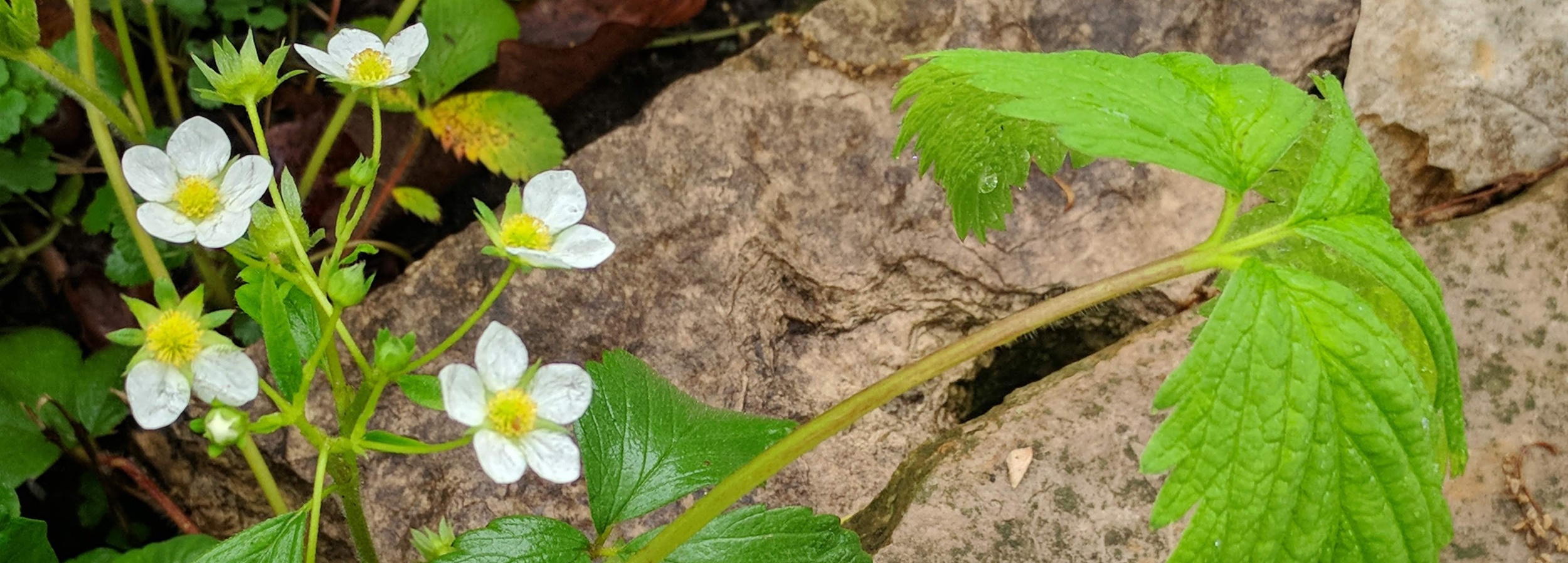
Fragaria virginiana Duchesne
Alternate Common Names: wild strawberry, common strawberry
Scientific Synonyms: Fragaria australis, Fragaria canadensis, Fragaria grayana, Fragaria terrae-novae
Family: rose family (Rosaceae)
Functional Group: forbs (wildflowers)
Description
- Life cycle and growth form
perennial, spreading by runners to form extensive clones.
Height: 4-8 in
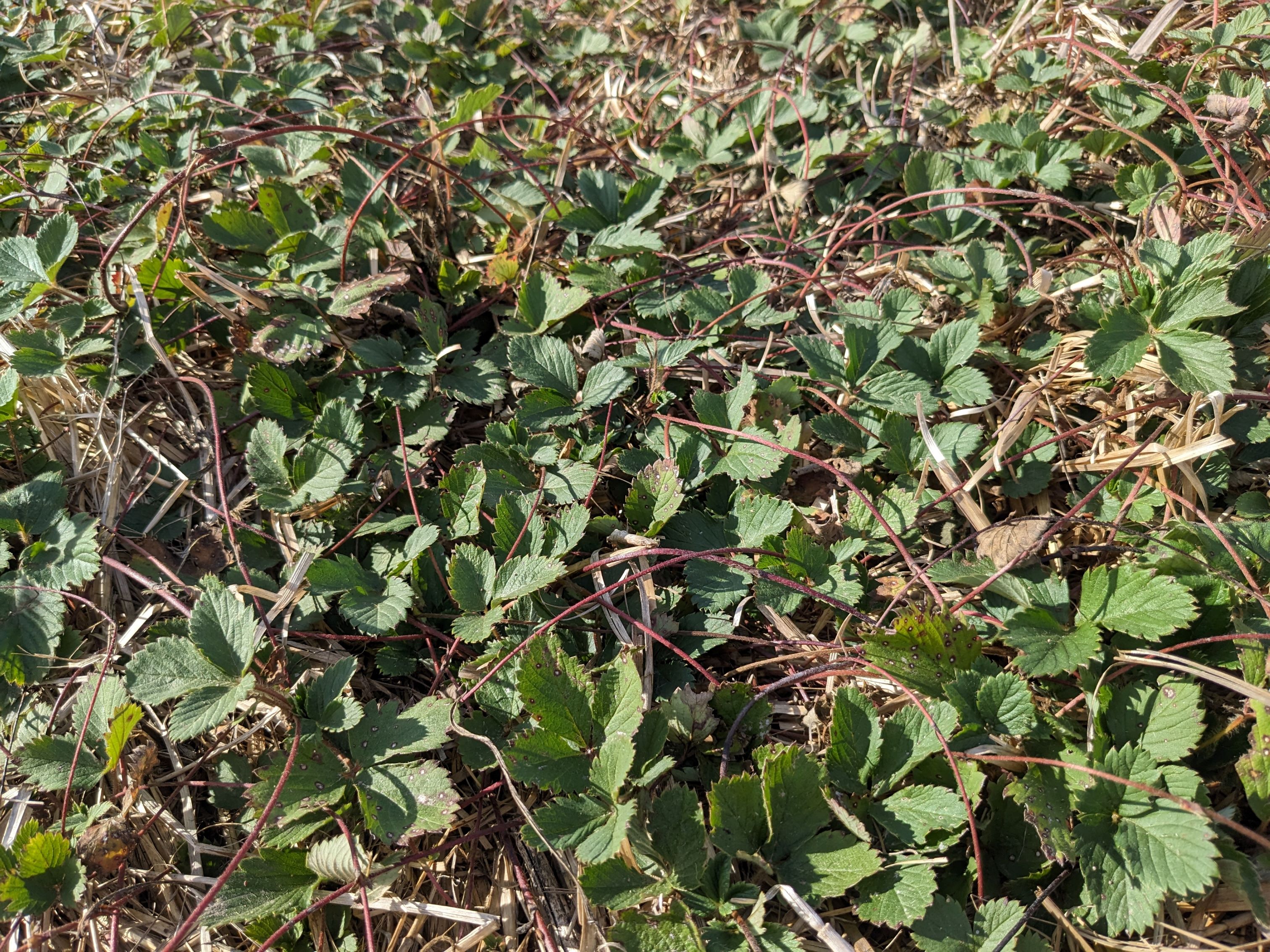
- Leaves and stem
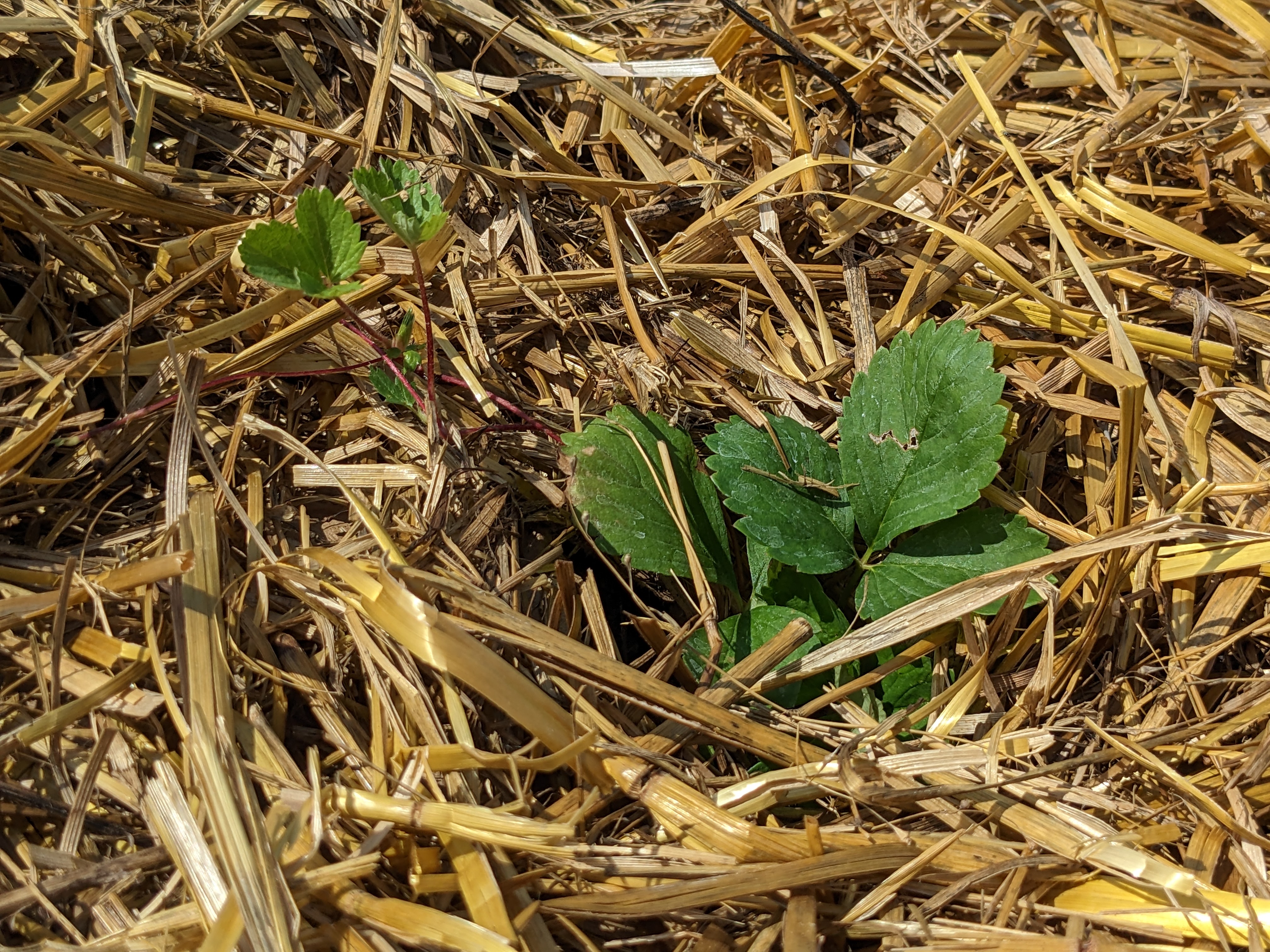
leaves basal, palmately compound; oval shaped leaflets (3) are up to 2.5 in long and 1.5 in wide with coarsely toothed margins and often finely haired, especially on the undersides; stems are sprawling stolons, often reddish in color, that root at the tips where new plants can emerge.
- Flower, fruit and seedhead
Flower: regular, five-petaled, 1/2 in diameter, petals white, stamens and pistils in center of flower yellow, 4-6 flowers in a loose cluster that is usually shorter than the leaves.
Fruit/seedhead: 1/2 in globular to ovoid “berry” with numerous achenes (“seeds”) in pits on the berry’s surface, bright red at maturity.
Pollination: Insects such as bees, flies, and butterflies.
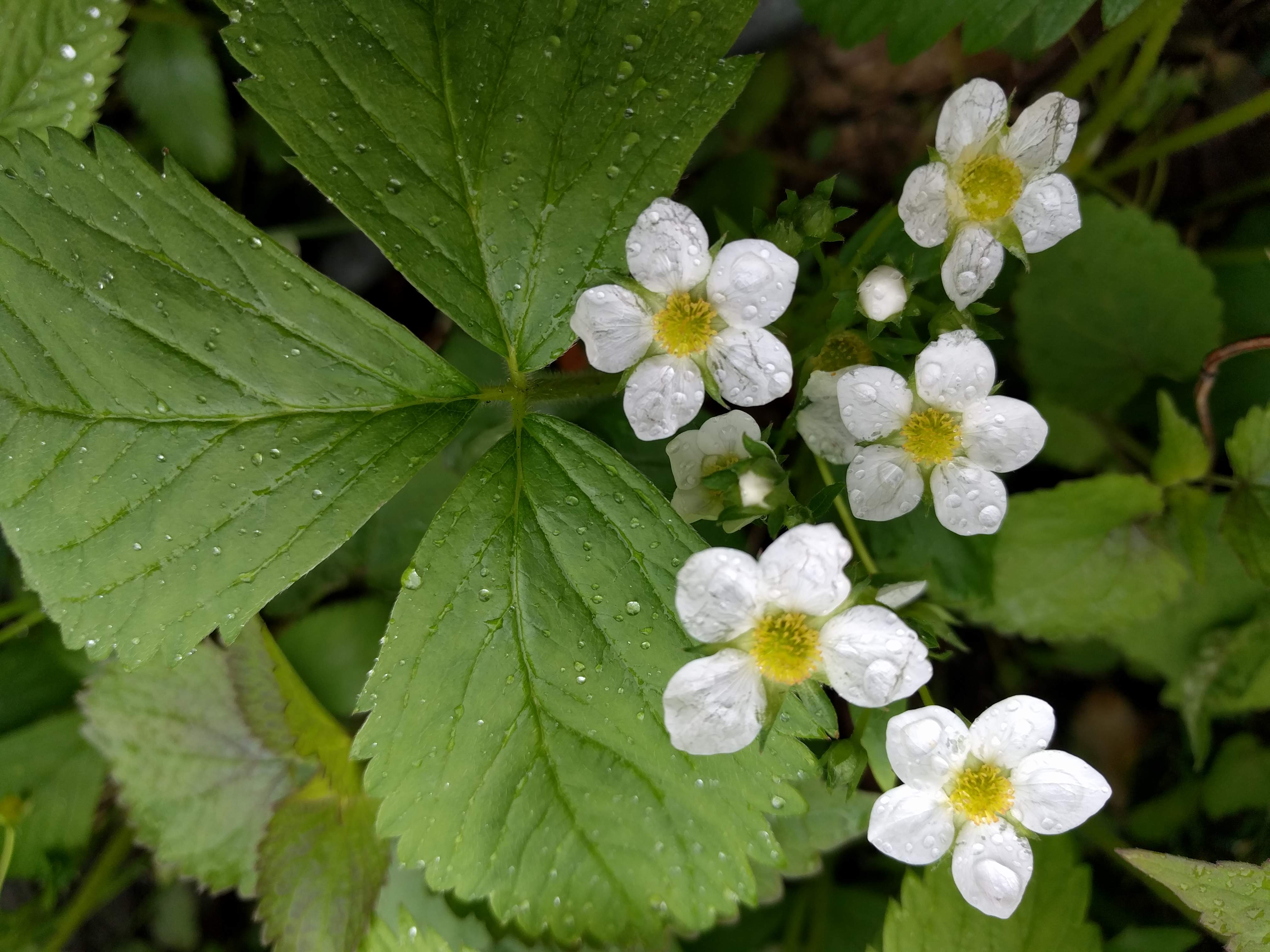
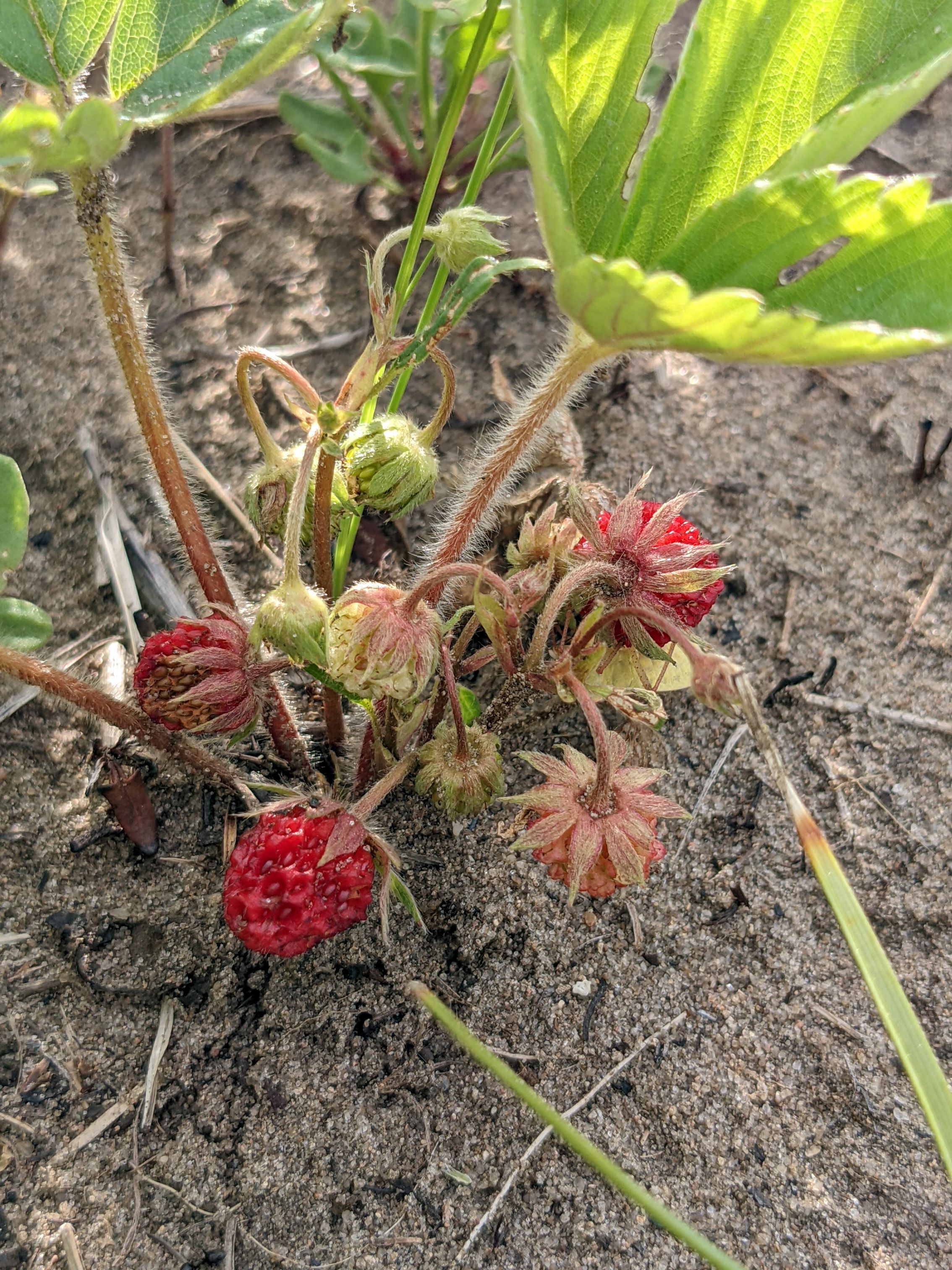
- Seed
Seed characteristics
Seed weight:
Seeds per ounce: 83,000 (Prairie Moon)
1000 seed weight: 0.46g (Seed Information Database)
Description: “Seed” is a reddish-brown achene, 1.2-1.8 mm in diameter, roughly egg-shaped.
Typical seed test
PLS: 83.35%
Purity: 99.81%
Germination: 21%
Dormancy: 61%
TZ: 85%
(averages obtained from 1 test of a purchased seed lot, and 1 test of seed produced at TPC)
- Habitat and range
Habitat: Dry to moist soil; partial to full sun; prairies, meadows, woodland openings and edges, roadsides, along railroads, savannas, limestone glades; Wetland Indicator Status is Facultative Upland (FACU) for the Midwest.
Conservation status: Global- G5, secure; Louisiana- S1, critically imperiled; Nevada- S2, imperiled; Illinois- S2/S3, imperiled to vulnerable (NatureServe)
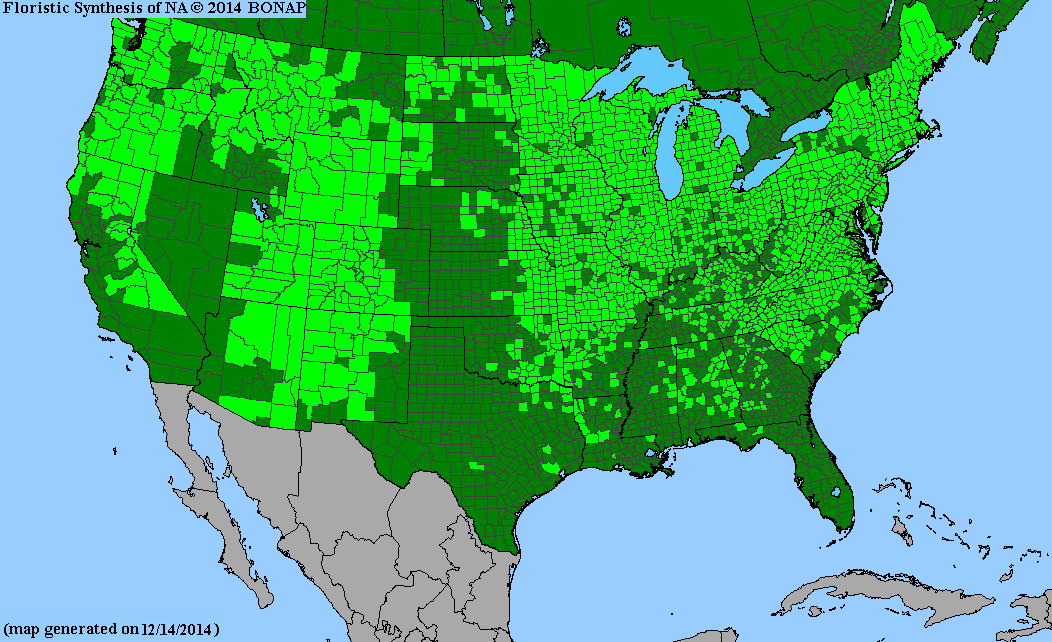
General Comments
Virginia strawberry can be found in the “understory” layer of most remnant prairies in Iowa. These small plants pack a large ecological punch. They flower early in the season, providing nectar and pollen resources for many species of small bees, flies, and skipper butterflies. Various herbivorous insects and mammals feed on the leaves, and the fruits are eaten by birds, mammals, and even reptiles (turtles), which disperse the seeds. When wild strawberries were abundant across the Iowa landscape prior to agricultural conversion, the fruits were an important early summer food for both Native people and Euro-American settlers. Virginia strawberry is one of the species that produced the cultivated strawberry through hybridization. Propagation and processing of this species is not difficult compared to other prairie forbs, and the most significant barrier to seed availability is probably the cost of labor required to pick the berries several times during the 2-3 week fruiting season.
Recommendations for Seed Production
- Establishment for seed production
Direct seeding
We do not have experience with direct seeding this species for seed production.
Greenhouse
Seed pre-treatment: 8 weeks cold/moist stratification
Sowing: Sow seed in greenhouse 8-10 weeks before average frost free date; spread stratified seed on germination flats and lightly cover (1/8 in or less) with germination mix; move seedlings to plugs when they have a pair of well-developed true leaves.
Transplanting: When plugs are well rooted and danger of frost is past, harden off seedlings and transplant into weed-free beds prepared with biodegradable paper mulch weighted with clean straw. Mulch must be biodegradable so that the new plantlets that form at the ends of stolons can grow roots into the soil.
- Stand management
Weeds: Biodegradable mulch in the first growing season suppresses most weeds; mowing at the highest setting of a typical riding mower after the fruiting season keeps weeds from becoming overly competitive in the second year.
Pests: Mammalian herbivores may browse foliage, and birds and small mammals consume fruits.
Diseases: None noted, though diseases that affect commercially grown strawberries such as botrytis molds may become a problem.
Plot renewal: Commercially grown strawberries are known to produce more fruit at the edges of plots. Since wild strawberries are closely related to the cultivated varieties, they may behave similarly, and techniques of cultivation, fertilization, and irrigation that are used by commercial strawberry farms may be beneficial. We will update this information as we gain more experience.
- Seed production
First Harvest: Plants flower and set fruit in the second year after planting.
Yield/Acre: 17-18 lbs of seed per acre (extrapolated from first year’s production of one production plot); it takes roughly 30 pounds of berries to obtain a pound of seed.
Stand Life: Probably long-lived, but production may decline as plots grow densely in subsequent years; plants at the edges of clones may set more fruit than those within dense patches; techniques used for “renewing” cultivated strawberry production such as rototilling narrow strips through beds may be helpful.
Flowering Date: May in northern Iowa
Seed maturity/Harvest date: late May to mid June in northern Iowa
Seed retention: There is a risk of seed loss from animals consuming the fruit or from fungal diseases; during the fruiting season (2-3 weeks), berries must be picked every 2-3 days.
Harvest date range at TPC: May 26 to June 13 (first harvest, 2024)
Recommended Harvest Method: Hand pick every other day. The labor required to harvest the small berries is significant: it took over 40 person-hours to gather ripe berries from an 840 sq ft plot every few days over a 19 day period, yielding 11.52 lbs of fruit and 5.47 oz of clean seed.
- Seed cleaning and storage
Cleaning process: Place 2 parts water to 1 part fruit in a blender and process for 30 seconds. (Blender blades do not need to be altered or wrapped.) Pour the resulting mash into a 5 gallon bucket and add additional water. Stir, then allow the filled seed to settle out. Pour off the floating material, being careful to save the heavy seed at the bottom (J. Carstens, USDA-NCRPIS, personal communication, January 10, 2022). Spread the seed onto muslin cloth and place in front of a fan to dry. Airscreening will remove remaining debris.
Seed storage: cool/dry (33-50° F, 30-50% RH)
Released Germplasm
Source Identified material: Natural Selections/Iowa Ecotype Zone NI
The map below shows the collection locations for populations used in development of this ecotype on a base map of the Generalized Provisional Seed Transfer Zones of the US Forest Service.
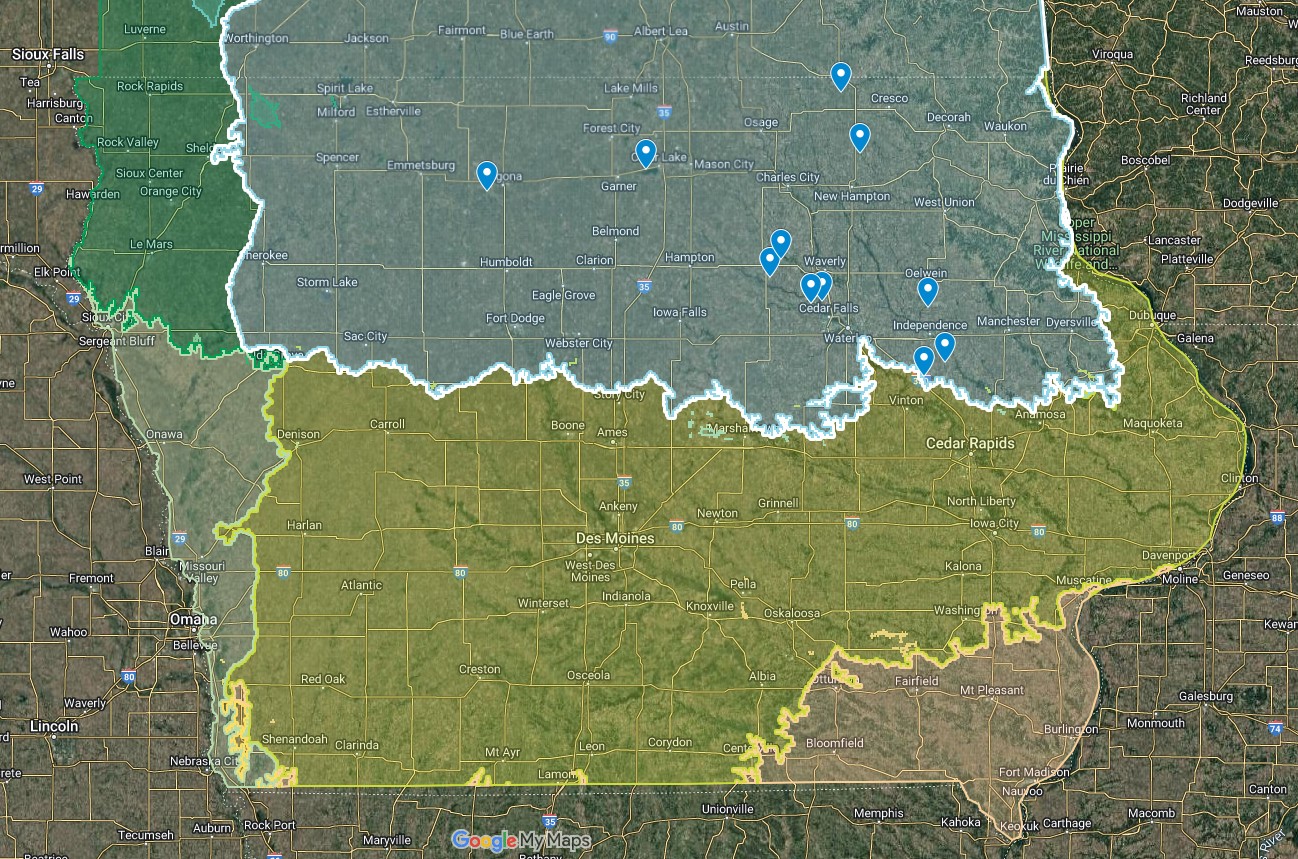
- References
Chayka, Katy. (n.d.). Fragaria virginiana (wild strawberry). Minnesota Wildflowers. https://www.minnesotawildflowers.info/flower/wild-strawberry
Cochrane, T. S., Elliot, K., & Lipke, C. S. (2014). Wild strawberry. In Prairie plants of the University of Wisconsin-Madison Arboretum (3rd ed., p. 301). University of Wisconsin-Madison Arboretum.
Gleason, H. A., & Cronquist, A. (1991). Rosaceae. In Manual of Vascular Plants of Northeastern United States and Adjacent Canada (2nd ed., p. 242). The New York Botanical Garden.
Kartesz, J.T., The Biota of North America Program (BONAP). 2023. North American Plant Atlas. (http://bonap.net/napa). Chapel Hill, N.C. [maps generated from Kartesz, J.T. 2023. Floristic Synthesis of North America, Version 1.0. Biota of North America Program (BONAP). (in press)]
NatureServe. 2024. NatureServe Network Biodiversity Location Data accessed through NatureServe Explorer [web application]. NatureServe, Arlington, Virginia. Available https://explorer.natureserve.org/. (Accessed: February 28, 2024).
Staudt, G. (2020, July 30). Fragaria virginiana (Miller). Flora of North America. http://dev.floranorthamerica.org/Fragaria_virginiana
University of Minnesota Extension. (2025). Strawberry Farming. https://extension.umn.edu/fruit-and-vegetable-farming/strawberry-farming
USDA NRCS National Plant Data Team. (n.d.). Fragaria virginiana Duchesne. USDA plants database. https://plants.usda.gov/home/plantProfile?symbol=FRVI
Species Guide Updated 2/3/2025
butterfly milkweed
butterfly milkweed dickeye
Asclepias tuberosa L.
Alternate Common Names: butterfly weed, pleurisy root, yellow milkweed, orange swallowwort, orangeroot, whiteroot, Indian posy, windroot, Canada tuber, Canada flux, chigger flower
Family: milkweed family (Asclepiadaceae)
Functional Group: forbs (wildflowers)
Description
- Life cycle and growth form
Perennial with a woody taproot that forms elongated tubers, can form clumps of many stems but does not spread by rhizomes.
Height: 1-2.5 ft
- Leaves and stem
Alternate leaves are lance-shaped with entire margins and dense to scattered hairs, short stalked or nearly sessile on the stem; stems are visibly hairy, branched, green to reddish in color. Unlike other milkweeds, butterfly milkweed has no milky sap.
- Flower, fruit and seedhead
Flower: Orange (sometimes red or yellow) blooms, 5-parted, in flattened clusters of up to 25 flowers on tips of branches.
Fruit/seedhead: Seedpods (follicles), 4-6 in long, often in clusters, covered in peachlike fuzz, seeds bear a silky, white “parachute” and are distributed by the wind.
Pollination: Insects, particularly butterflies, bees, and wasps.
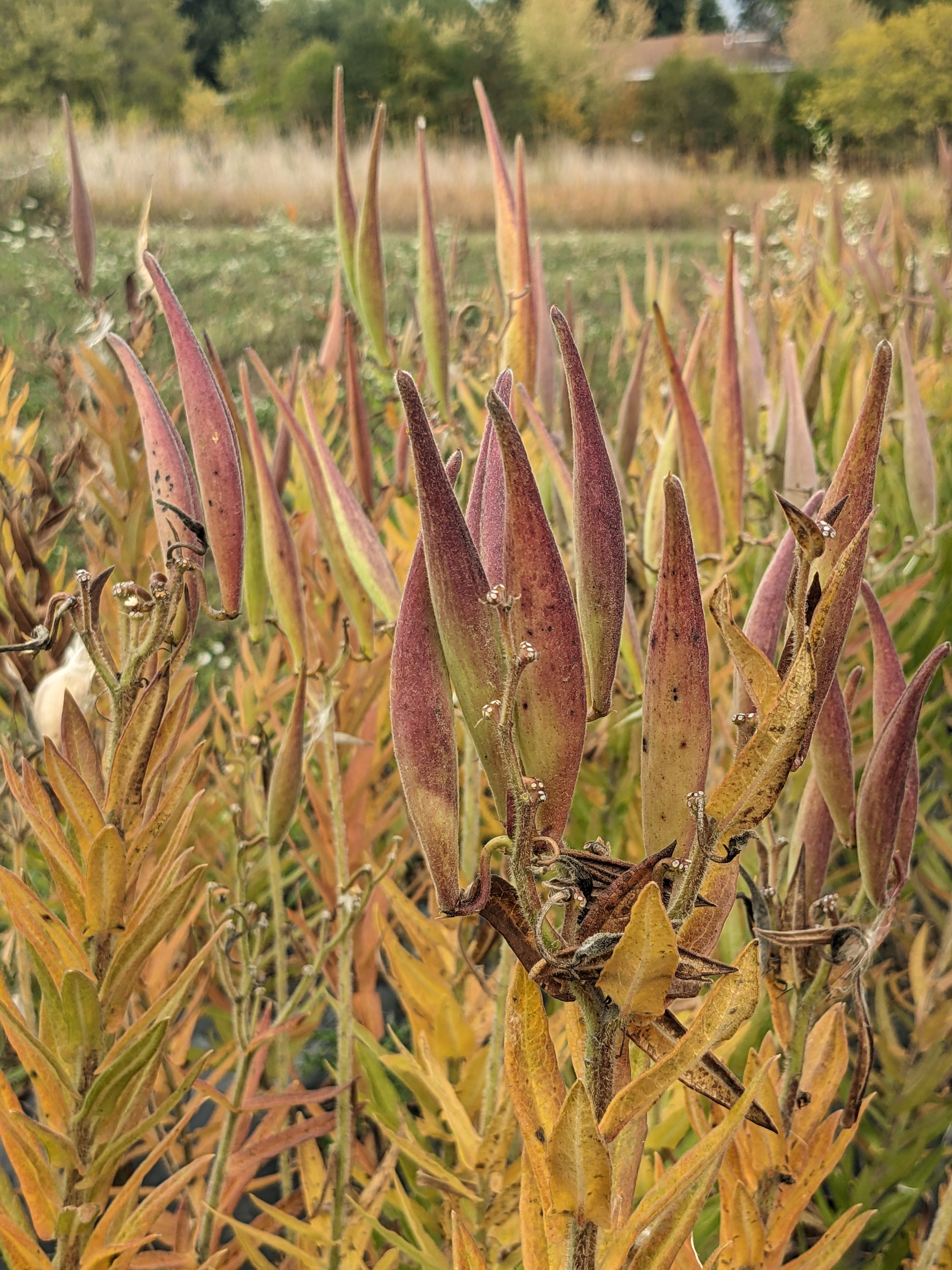
- Seed
Seed characteristics
Seed weight:
Seeds per ounce: 4,300 (IA NRCS)
Seeds per pound: 68,000 (IA NRCS)
1000 seed weight: 6.76 g (Seed Information Database)
Description: Seeds are flat and chocolate-brown, about 1/4 in by 3/16 in with a tuft of fine filaments (floss).
Typical seed test
PLS: 93% (n = 12)
Purity: 100% (n = 12)
Germination: 63% (n = 8)
Dormant: 48% (n = 9)
(averages obtained from n tests of purchased seed lots)
- Habitat and range
Habitat: Dry to mesic, well-drained soil; full sun; high quality remnant prairies, savannas, glades, roadsides.
Conservation status: Global- G5, secure; Maine- SX, presumably extirpated; Vermont- SH, possibly extirpated (NatureServe)

General Comments
The bright orange flowers make this a desirable species for horticultural displays as well as prairie reconstructions. This species, like other members of the genus Asclepias, is an important host plant for monarch butterfly caterpillars. Seeds germinate readily in the greenhouse with proper stratification or use of gibberellic acid. Seedlings require care in transplanting because of the taproot structure. Butterfly milkweed does best in very well-drained soils. Requires hand-harvesting as pods ripen.
Recommendations for Seed Production
- Establishment for seed production
Direct seeding
Row spacing: 30-36 in rows
PLS pounds/acre: 8.5 (40 seeds/linear foot)
Seeding depth: 1/4 in
Seeding method: native seed drill
Seeding time: dormant season
Weed control: Prepare clean, firm, weed free seedbed prior to seeding.
Greenhouse
Seed pre-treatment: Wet stratify 8 weeks at 40° F or treat for 24 hours with 250-ppm gibberellic acid.
Sowing: Sow seed in greenhouse two months before last frost free date. Susceptible to damping off in the greenhouse. Use sterile potting mix with added perlite, sanitize planting materials, and provide adequate ventilation. Also vulnerable to greenhouse pests such as thrips and aphids. If possible, empty and sanitize greenhouse between growing seasons to reduce pest pressure.
Transplanting: Plant into bare soil in 36 in rows or weed barrier at 12 in intervals.
- Stand management
Weeds: Mow or cultivate between rows and/or use a weed barrier. Post-emergence grass herbicide, tillage, and/or roguing may be used to control weeds. Always read and follow label instructions.
Pests: Yellow milkweed aphids on upper portions of plant, including pods. Light infestations may be controlled by naturally occurring aphid predators and parasites. Heavy infestations can cause abortion of pods and failure of crop. Monarch larvae eat foliage and pods, but not a serious problem on this milkweed species. Milkweed bug nymphs feed on developing seeds within pods. In small scale plantings, manual removal of clusters of bug nymphs can improve seed quantity and quality.
Diseases: Susceptible to various fungi, bacteria, a phytoplasma, and protozoan pathogens (Borders and Lee-Mäder, 2014).
Hybridization risk: Hybrids have been found between Asclepias tuberosa and some related species in the genus Asclepias, however it appears to be rare.
- Seed production
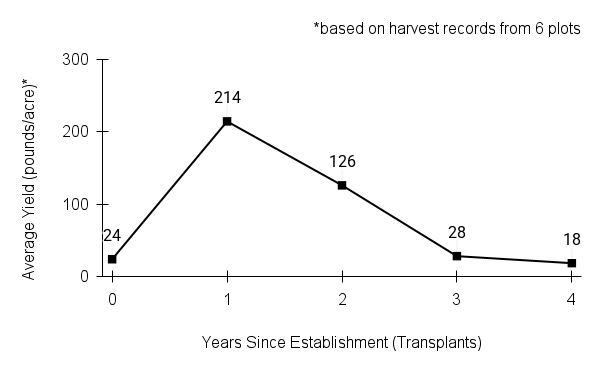 First harvest: Some flowering and minimal seed production is possible in the planting year with greenhouse transplants.
First harvest: Some flowering and minimal seed production is possible in the planting year with greenhouse transplants.Yield: 18-214 bulk pounds/acre (yields extrapolated based on production from 6 plots)
Stand life: Peak harvests are typically in the second year. Stand persists in well-drained soils if disease free, but seed production may decline significantly in subsequent years. Aeration of the soil may improve stand life and productivity.
Flowering date: mid-June - mid-August in northern Iowa
Seed maturity/Harvest date: mid-August - mid-October in northern Iowa
Seed retention: Seed dispersed by wind soon after pods split open.
Harvest date range at TPC (2003-2023): Aug 10 - Oct 14
Recommended harvest method: For small plots, check daily and hand harvest as pods ripen. Ripe pods usually have a blush of yellow (somewhat like a ripe peach) and split readily with an audible “pop” when gently squeezed at the “seam.” Seeds are mature if they appear chocolate brown. If they’re still creamy white, leave the pod unpicked for another day or two.
- Seed cleaning and storage
Cleaning process: Seeds can be separated from freshly picked pods with a hammer mill, or from dried pods using a debearder. Winnow the debearded material through a coarse screen on a day with a steady, gentle wind or in front of a box fan to reduce the bulk and fluff, then air-screen.
Seed storage: Stores well in refrigerated conditions (32-40° F, 40-60% RH).
Released Germplasm
Source Identified material: Natural Selections/Iowa Ecotype Project Zones 1, 2, and 3; Glacial Lake Albany Germplasm (NY)
Cultivated variety (cultivars): Horticultural varieties may also exist.
- References
Borders, B. & Lee-Mäder, E. (2014). Milkweeds, A Conservation Practitioners Guide. Xerces Society for Invertebrate Conservation. https://www.xerces.org/publications/guidelines/milkweeds-conservation-practitioners-guide
Chayka, K. (n.d.). Asclepias tuberosa (butterfly-weed). Minnesota Wildflowers. https://www.minnesotawildflowers.info/flower/butterfly-weed
Hilty, J. (2019). Butterfly milkweed - Asclepias tuberosa. Illinois Wildflowers. https://www.illinoiswildflowers.info/prairie/plantx/btf_milkweedx.htm
Houseal, G. A. (2007). Forbs wildflowers. In G. A. Houseal (Eds.), Tallgrass Prairie Center’s native seed production manual (pp. 28–29). Tallgrass Prairie Center - University of Northern Iowa.
Kartesz, J.T., The Biota of North America Program (BONAP). 2023. North American Plant Atlas. (http://bonap.net/napa). Chapel Hill, N.C. [maps generated from Kartesz, J.T. 2023. Floristic Synthesis of North America, Version 1.0. Biota of North America Program (BONAP). (in press)]
NatureServe. 2024. NatureServe Network Biodiversity Location Data accessed through NatureServe Explorer [web application]. NatureServe, Arlington, Virginia. Available https://explorer.natureserve.org/. (Accessed: February 29, 2024).
Runkel, S. T., & Roosa, D. M. (2009). Butterfly milkweed. In Wildflowers of the tallgrass prairie: The upper Midwest (2nd ed., pp. 128–129). University of Iowa Press.
USDA NRCS National Plant Data Team. (n.d.). Asclepias tuberosa L.. USDA plants database. https://plants.usda.gov/home/plantProfile?symbol=ASTU
Species Guide Updated 12/2/2024
button eryngo
button eryngo dickeye
Eryngium yuccifolium Michx.
Alternate Common Names: button snakeroot, rattlesnake master, rattlesnake-master, yucca-leaf eryngo, corn snakeroot, water-eryngo, rattlesnake flag, rattlesnake weed
Family: carrot family (Apiaceae)
Functional Group: forbs (wildflowers)
Description
- Life cycle and growth form
Perennial from a central taproot; forms small clumps through offsets after blooming.
Height: 2-5 ft
- Leaves and stem
Tough, fibrous, yucca-like leaves are mostly basal, with a waxy surface and widely spaced spiny teeth along margins; stem is hairless, waxy and rigid, pale bluish green in color.
- Flower, fruit and seedhead
Flower: Spherical flowerheads composed of numerous small white flowers are arranged on short branches on the upper portion of the plant.
Fruit/seedhead: Seed head with prickly bracts turns golden-tan by winter; mature seed heads are dark brown when wet.
Pollination: Insects, predominantly bees and wasps, but also butterflies, flies, moths, and beetles.
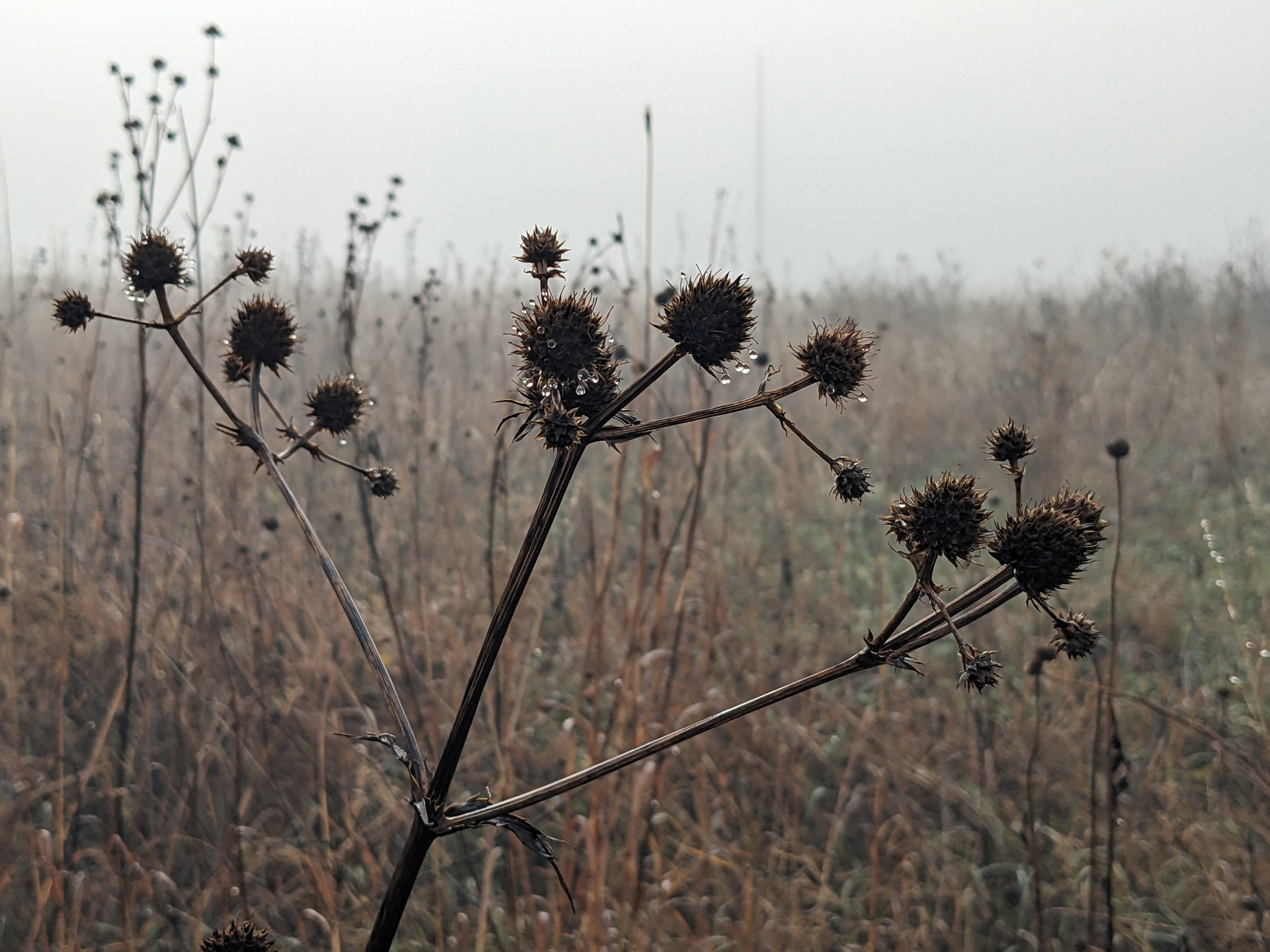
- Seed
Seed characteristics
Seed weight:
Seeds per ounce: 7,500 (IA NRCS)
Seeds per pound: 120,000 (IA NRCS)
1000 seed weight: 3.82 g (Seed Information Database)
Description: Typical “seed units” are one-seeded scaly fruits, 3/16 in long.
Typical seed test
PLS: 93% (n = 10)
Purity: 98% (n = 9)
Germination: 19% (n = 8)
Dormant: 43% (n = 8)
(averages obtained from n tests of purchased seed lots)
- Habitat and range
Habitat: Dry-mesic to wet-mesic soil; full sun; occurs in medium to high quality remnant prairies, savannas, and limestone glades; Wetland Indicator Status is Facultative (FAC) for the Midwest. Well-drained loamy soils preferred for seed production.
Conservation status: Global- G5, secure; Maryland- SH, possibly extirpated; Nebraska- S1, critically imperiled; Michigan and Virginia- S2, imperiled; Minnesota and Ohio- S3, vulnerable (NatureServe)

General Comments
Greenhouse propagation is recommended for this species. It grows readily, and produces some seed the first year from transplants. Potentially high seed yield. Fairly straightforward to combine harvest and air-screen clean.
Recommendations for Seed Production
- Establishment for seed production
Direct seeding
Row spacing: 30-36 in rows
PLS pounds/acre: 3.25
Seeds per linear foot: 40
Seeding depth: 1/4 in
Seeding method: native seed drill
Seeding time: dormant season
Weed control: Prepare a clean, firm, weed free seed bed prior to seeding.
Greenhouse
Seed pre-treatment: Wet stratify 8-12 weeks at around 40° F.
Sowing: Sow seed (1/4 in deep) in greenhouse two months before last frost free date.
Transplanting: When roots are developed enough to produce a sturdy plug, harden off, then transplant into bare soil in rows or weed barrier at 8-12 in intervals after all danger of frost.
- Stand management
Weeds: Weed barrier or plastic mulch suppresses weeds during the first year. Mow/cultivate between rows. Post emergence grass herbicide, tillage, and/or hand roguing prevent weed seed contamination of crop. Anecdotal reports from commercial seed growers suggest that this species may persist and produce well within a matrix of grasses, including non-native cool season species, which may help suppress other weeds.
Pests: None noted.
Diseases: Cucumber mosaic virus detected in populations in Ohio (Whitten and Nameth, 2004).
- Seed production
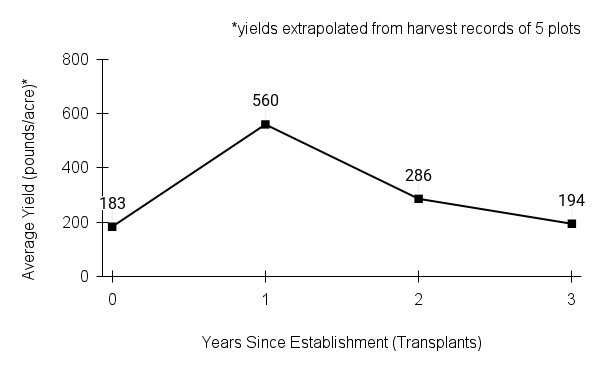 First harvest: Small harvest first growing season if greenhouse propagated in March and planted into a weed-barrier in spring. Flowering and harvest may be delayed in the planting year. First harvest in second year if direct seeded.
First harvest: Small harvest first growing season if greenhouse propagated in March and planted into a weed-barrier in spring. Flowering and harvest may be delayed in the planting year. First harvest in second year if direct seeded.Yield: 180-560 bulk pounds/acre (yields extrapolated from harvest records from 5 plots)
Stand life: Peak harvests in the second to third years. Stand declines fourth year.
Flowering date: mid July-mid August in northern Iowa
Seed maturity/Harvest date: early October in northern Iowa
Seed retention: Shattering occurs mid to late October
Harvest date range at TPC (2003-2023): Sept 7 - Oct 25
Recommended harvest method: combine
- Seed cleaning and storage
Cleaning process: Pre-clean combined material by scalping thru 1/2 ft and 1/4 in mesh to remove large particles and make flowable, then air-screen. (Brushing is not needed; no awns or appendages to remove.)
Seed storage: cool/dry (33-50° F, 30-50% RH).
Released Germplasm
Source Identified material: Natural Selections/Iowa Ecotype Project Northern Iowa Germplasm (IA Zone 1), Central Iowa Germplasm (IA Zone 2), Southern Iowa Germplasm (IA Zone 3)
- References
Chayka, K. (n.d.). Eryngium yuccifolium (rattlesnake master). Minnesota Wildflowers. https://www.minnesotawildflowers.info/flower/rattlesnake-master
Cochrane, T. S., Elliot, K., & Lipke, C. S. (2014). Rattlesnake-master. In Prairie plants of the University of Wisconsin-Madison Arboretum (3rd ed., p. 45). University of Wisconsin-Madison Arboretum.
Hilty, J. (2019). Rattlesnake master - Eryngium yuccifolium. Illinois Wildflowers. https://www.illinoiswildflowers.info/prairie/plantx/rattlesnakex.htm
Houseal, G. A. (2007). Forbs wildflowers. In G. A. Houseal (Eds.), Tallgrass Prairie Center’s native seed production manual (pp. 34–35). Tallgrass Prairie Center - University of Northern Iowa.
Kartesz, J.T., The Biota of North America Program (BONAP). 2023. North American Plant Atlas. (http://bonap.net/napa). Chapel Hill, N.C. [maps generated from Kartesz, J.T. 2023. Floristic Synthesis of North America, Version 1.0. Biota of North America Program (BONAP). (in press)]
NatureServe. 2024. NatureServe Network Biodiversity Location Data accessed through NatureServe Explorer [web application]. NatureServe, Arlington, Virginia. Available https://explorer.natureserve.org/. (Accessed: February 29, 2024).
Runkel, S. T., & Roosa, D. M. (2009). Rattlesnake master. In Wildflowers of the tallgrass prairie: The upper Midwest (2nd ed., pp. 130–131). University of Iowa Press.
USDA NRCS National Plant Data Team. (n.d.). Eryngium yuccifolium Michx. USDA plants database. https://plants.usda.gov/home/plantProfile?symbol=ERYU
Species Guide Updated 12/4/2025
common boneset
common boneset sagem
Eupatorium perfoliatum L.
Alternate Common Names: boneset, thoroughwort
Scientific Synonyms: Eupatorium chapmanii Small, Eupatorium perfoliatum var. colpophilum Fernald & Griscom, Eupatorium perfoliatum var. cuneatum Engelmann
Family: aster or sunflower family (Asteraceae)
Functional Group: forbs (wildflowers)
Description
- Life cycle and growth form
Perennial, short-rhizomatous, spreads slowly to form small colonies.
Height: 2-4 ft

- Leaves and stem

Leaves join around the stem making them look like one leaf (perfoliate) and then taper to a point, opposite arrangement (rarely whorled), leaf margins are wavy with small teeth (crenulate), leaf surfaces have a wrinkled appearance, upper and lower leaf sides are hairy; stems are hairy, erect, and branched in the upper portion of the plant.
- Flower, fruit and seedhead
Flower: Tiny heads (1/4 in) of up to 15 disc florets (no visible “petals” or rays), grouped in flat-topped to slightly domed clusters of dozens to hundreds of heads; flower clusters appear fuzzy due to thin styles that extend from each floret.
Fruit/seedhead: Clusters become fluffy from the center outwards as seeds mature and pappus expands.
Pollination: Insects, particularly bees, butterflies, flies, beetles, and wasps.

- Seed
Seed characteristics
Seeds per ounce: 160,000 (IA NRCS)
1000 seed weight: 0.11 g (Seed Information Database)
Description: Long slender, dark gray seeds (achenes) up to 2.5 mm long with a short tuft of white hairs (pappus).
Typical seed test
PLS: 68% (n = 6)
Purity: 71% (n = 6)
Germination: 16% (n = 5)
Dormant: 81% (n = 5)
(averages obtained from n tests of purchased seed lots)
- Habitat and range
Habitat: Moist to wet, organic-rich soil; full sun; wet pastures, sedge meadows, fens; The USDA classifies it as an Obligate Wetland species in the Midwest region. It benefits from irrigation in production systems.
Conservation status: Global- G5, secure; Kansas- S3, vulnerable (NatureServe)

General Comments
The clouds of sweet-scented flowers attract a diverse assemblage of pollinating insects. Bitter compounds in the foliage deter mammalian herbivores, although some moth larvae use common boneset as a host plant. This species has traditional medicinal and ceremonial uses among Native tribes within its range, and was adopted as a treatment for colds and fevers by colonial settlers. It is currently under investigation by researchers in Germany and India for use in treatment of viral illnesses such as colds, flu, and dengue fever as well as malaria. Caution: this plant also contains phytochemicals that may be toxic to the liver.
Recommendations for Seed Production
- Establishment for seed production
Direct seeding
We do not have experience direct seeding this species for seed production. It reportedly has low germination rates in direct seedings. High seeding rates and fall planting are recommended.
Greenhouse
Seed pre-treatment: 60 days cold-moist stratification.
Sowing: Seed is small and should be surface sown. If started in germination flats, transplant to individual plugs when seedlings have their first pair of true leaves, about 4 weeks after seeding.
Transplanting: Seedlings are ready to transplant to the field about 6-8 weeks after being transferred to plugs, when their roots are well-branched and numerous root tips are visible at hole(s) in the base of the plug. Pop out a few plugs to check for adequate root development that will provide sturdy plugs for planting. Seedlings are fast growing and may need to be clipped back before transplanting to improve the shoot:root ratio. A week or two before transplanting, move flats outside to ‘harden off.’ (See Propagation chapter in General Information for more details).
- Stand management
Weeds: In the first season after transplanting, weeds are suppressed by a plastic weed barrier. Plants spread slowly by short rhizomes; in second and subsequent years, holes in plastic may need to be expanded or plastic removed to make room for new stems. Well-established plots shade out most weeds.
Pests: None noted.
Diseases: None noted.
Soil moisture: Irrigation is necessary in most soils to obtain maximum seed yield.
- Seed production
 First harvest: Plants flower and set a little seed the first year when transplanted in spring.
First harvest: Plants flower and set a little seed the first year when transplanted in spring.Yield: 80-130 pounds/acre (based on 1 plot)
Stand life: unknown
Flowering date: August - September in northeast Iowa
Seed maturity/Harvest date: mid-September - mid-October
Seed retention: Seeds are wind dispersed soon after maturity, when fluff (pappus) expands in late September through mid-October.
Harvest date range at TPC (2022-2023): Sept 15 - Oct 7
Recommended harvest method: Watch for the centers of seed clusters to begin shattering, and pick early maturing seed heads (clip stalks below seed clusters). If some heads in a cluster are still closed (not fluffy), pull apart a few heads to see if the seeds are dark colored and separate easily from the base (receptacle). Combine the rest of the plot at peak maturity. Turn off air or combine will disperse the fluffy seeds.
- Seed cleaning and storage
Cleaning process: If hand clipped, run dried material through a 1/4 in mesh to thresh seed from stalks. Use a brush machine (soft bristles, minimum vacuum) to remove pappus. Seed is fragile, and some seed is dehulled, even when soft bristles are used. Winnow with a box fan to separate seed from most of the pappus and chaff. Airscreen 2-3 times to finish cleaning. See Appendix C for specific settings.
Seed storage: cool/dry (33-50° F, 30-50% RH) for up to 3 years (USDA Plant Fact Sheet).
Released Germplasm
Source Identified material: Natural Selections/Iowa Ecotype Zone NI
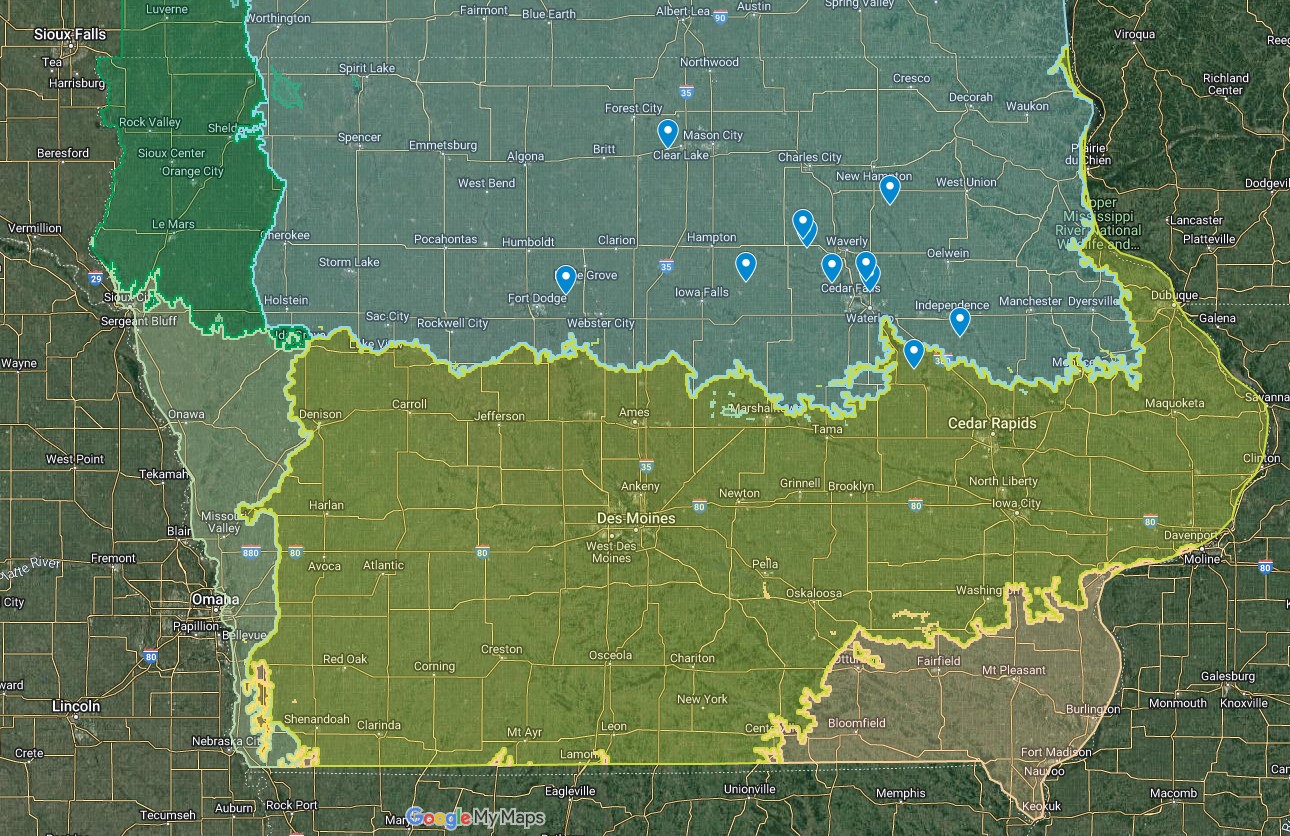
- References
Belt, S. (2009). Plant fact sheet for common boneset (Eupatorium perfoliatum L.). USDA-Natural Resources Conservation Service, Norman A. Berg National Plant Materials Center, Beltsville, MD 20705.
Chayka, K. (n.d.). Eupatorium perfoliatum (common boneset). Minnesota Wildflowers. https://www.minnesotawildflowers.info/flower/common-boneset
Cochrane, T. S., Elliot, K., & Lipke, C. S. (2014). Boneset. In Prairie plants of the University of Wisconsin-Madison Arboretum (3rd ed., p. 79). University of Wisconsin-Madison Arboretum.
Eupatorium perfoliatum. (n.d.). Prairie Moon Nursery. https://www.prairiemoon.com/eupatorium-perfoliatum-boneset-prairie-moon-nursery.html
Hilty, J. (2019). Common boneset - Eupatorium perfoliatum. Illinois Wildflowers. https://www.illinoiswildflowers.info/prairie/plantx/cm_boneset.htm
Kartesz, J.T., The Biota of North America Program (BONAP). 2023. North American Plant Atlas. (http://bonap.net/napa). Chapel Hill, N.C. [maps generated from Kartesz, J.T. 2023. Floristic Synthesis of North America, Version 1.0. Biota of North America Program (BONAP). (in press)]
NatureServe. 2024. NatureServe Network Biodiversity Location Data accessed through NatureServe Explorer [web application]. NatureServe, Arlington, Virginia. Available https://explorer.natureserve.org/. (Accessed: February 28, 2024).
SER, INSR, RBGK, Seed Information Database (SID). (2023). Eupatorium perfoliatum. https://ser-sid.org/species/e29e87df-3177-43f1-bfcd-bc052339de84
USDA NRCS National Plant Data Team. (n.d.). Eupatorium perfoliatum L. USDA plants database. https://plants.usda.gov/plant-profile/EUPE3
Siripun, K. C., & Schilling, E. E. (2020, November 6). Eupatorium perfoliatum Linnaeus. Flora of North America. http://floranorthamerica.org/Eupatorium_perfoliatum
Species Guide Updated 12/18/2024
narrowleaf mountainmint
narrowleaf mountainmint dickeye
Pycnanthemum tenuifolium Schrad.
Alternate Common Name: slender mountain mint
Scientific Synonyms: Koellia flexuosa auct. non (Walter) MacMill., Pycnanthemum flexuosum auct. non (Walter) Britton, Sterns & Poggenb., Pycnanthemum linifolium
Family: mint family (Lamiaceae)
Functional Group: forbs (wildflowers)
Description
- Life cycle and growth form
Rhizomatous perennial that forms vegetative colonies.
Height: 1-3 ft
- Leaves and stem
Very narrow (1/8 in or less), opposite leaves with a strong mint/citrus odor when crushed; stems are slender, 4-sided, branched above, and entirely hairless, helping to distinguish this species from our other mountain mints.
- Flower, fruit and seedhead
Flower: Small (1/4 in long) two-lipped, white flowers with scattered purple dots, in clusters at stem tips.
Fruit/seed head: Seedheads are light brown when mature in contrast to the grey color of P. virginianum and P. pilosum seed heads.
Pollination: Insects such as bees, butterflies, wasps, and beetles
- Seed
Seed characteristics
Seeds per ounce: 378,000 (IA NRCS)
1000 seed weight: 0.08 g (Seed Information Database)
Description: Seed units are tiny nutlets (nearly 1 mm long), developing within each tube-like calyx of the inflorescence.
Typical seed test
PLS: 90% (n = 13)
Purity: 94% (n = 13)
Germination: 36% (n = 9)
Dormant: 45% (n = 10)
(averages obtained from n tests of purchased seed lots)
- Habitat and range
Habitat: Mesic to dry-mesic soils in upland prairies; full sun; prairies, moist meadows, limestone glades, thickets, woodland openings, abandoned fields; Wetland Indicator Status is Facultative (FAC) for the Midwest.
Conservation status: Global- G5, secure; Nebraska- S1, critically imperiled (NatureServe)
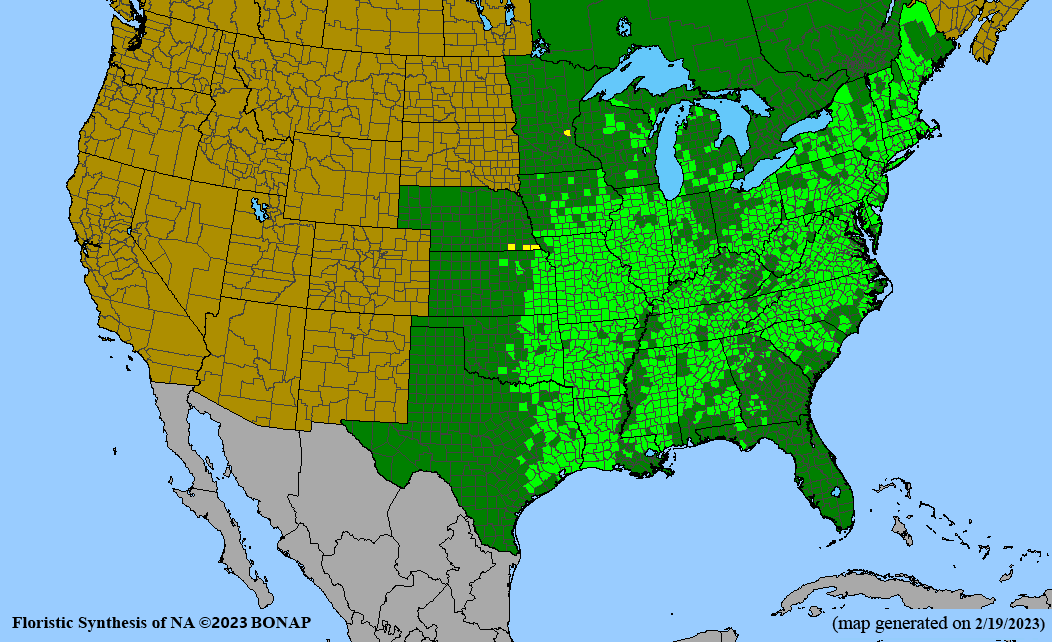
General Comments
Narrowleaf mountainmint, like other members of the genus Pycnanthemum, is visited by numerous and diverse pollinators including native bees, wasps, and flies. This species can be distinguished from the other members of the genus in Iowa by its hairless stems, narrower leaves (not exceeding 1/4 in), brown seed heads (not gray), and somewhat later flowering time. Plants are relatively easy to grow, yield heavily for a few years, and produce seed that stores well under refrigeration.
Recommendations for Seed Production
- Establishment for seed production
Direct seeding
Not recommended for this species.
Greenhouse
Seed pre-treatment: Dry/cold stratify 12 weeks at 40° F.
Sowing: Surface sow seed in greenhouse two months before last frost free date. Water carefully (fine mist) to prevent seed from splattering out of containers.
Transplanting: Transplant into a weed barrier at 8-12 in intervals. Plants spread clonally, so the weed barrier can be removed by the third season, but seed production typically declines by the fourth season.
- Stand management
Weeds: Plastic mulch or weed barrier suppresses many weeds during the first year or two. Hand rogue weeds, being careful not to uproot seedlings or disturb roots and rhizomes of the mountainmint. An anecdotal report from a commercial native seed grower suggests that cultivation within mountainmint rows weakens plants and can cause loss of the crop.
Pests: None noted.
Diseases: None noted.
- Seed production
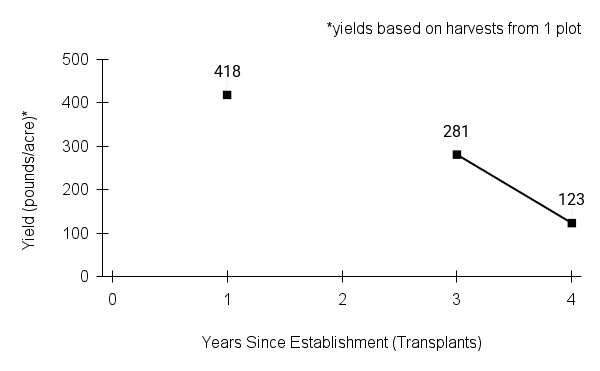 First harvest: Some flowering and seed production first year from greenhouse grown transplants.
First harvest: Some flowering and seed production first year from greenhouse grown transplants.Yield: 10-80 bulk pounds/acre
Stand life: Peak harvests second-third year. Stand persists but seed production may decline significantly fourth year and after.
Flowering date: Flowering occurs mid-July into August.
Seed maturity/Harvest date: Mid September to early October.
Seed retention: Holds seed well, shattering occurs mid to late October.
Harvest date range at TPC (2004-2007): Sept 21 - Oct 18
Recommended harvest method: Combine, no air.
- Seed cleaning and storage
Cleaning process: Pre-clean by scalping thru 1/2 in and 1/4 in mesh to remove large particles and make flowable, then air-screen. (No awns or appendages to remove).
Seed storage: cool/dry (33-50° F, 30-50% RH)
Released Germplasm
Source Identified material: Natural Selections/Iowa Ecotype Zone 3 (southern Iowa)
- References
Gleason, H. A., & Cronquist, A. (1991). Lamiaceae. In Manual of Vascular Plants of Northeastern United States and Adjacent Canada (2nd ed., p. 443). The New York Botanical Garden.
Hilty, J. (2019). Slender mountain mint - Pycnanthemum tenuifolium. Illinois Wildflowers. https://www.illinoiswildflowers.info/prairie/plantx/slm_mintx.htm
Houseal, G. A. (2007). Forbs Wildflowers. In G. A. Houseal (Eds.), Tallgrass Prairie Center’s native seed production manual (pp. 44–45). Tallgrass Prairie Center - University of Northern Iowa.
Kartesz, J.T., The Biota of North America Program (BONAP). 2023. North American Plant Atlas. (http://bonap.net/napa). Chapel Hill, N.C. [maps generated from Kartesz, J.T. 2023. Floristic Synthesis of North America, Version 1.0. Biota of North America Program (BONAP). (in press)]
NatureServe. 2024. NatureServe Network Biodiversity Location Data accessed through NatureServe Explorer [web application]. NatureServe, Arlington, Virginia. Available https://explorer.natureserve.org/. (Accessed: February 29, 2024).
USDA NRCS National Plant Data Team. (n.d.). Pycnanthemum tenuifolium Schrad. USDA plants database. https://plants.usda.gov/home/plantProfile?symbol=PYTE
Species Guide Updated 12/5/2025
pale purple coneflower
pale purple coneflower dickeye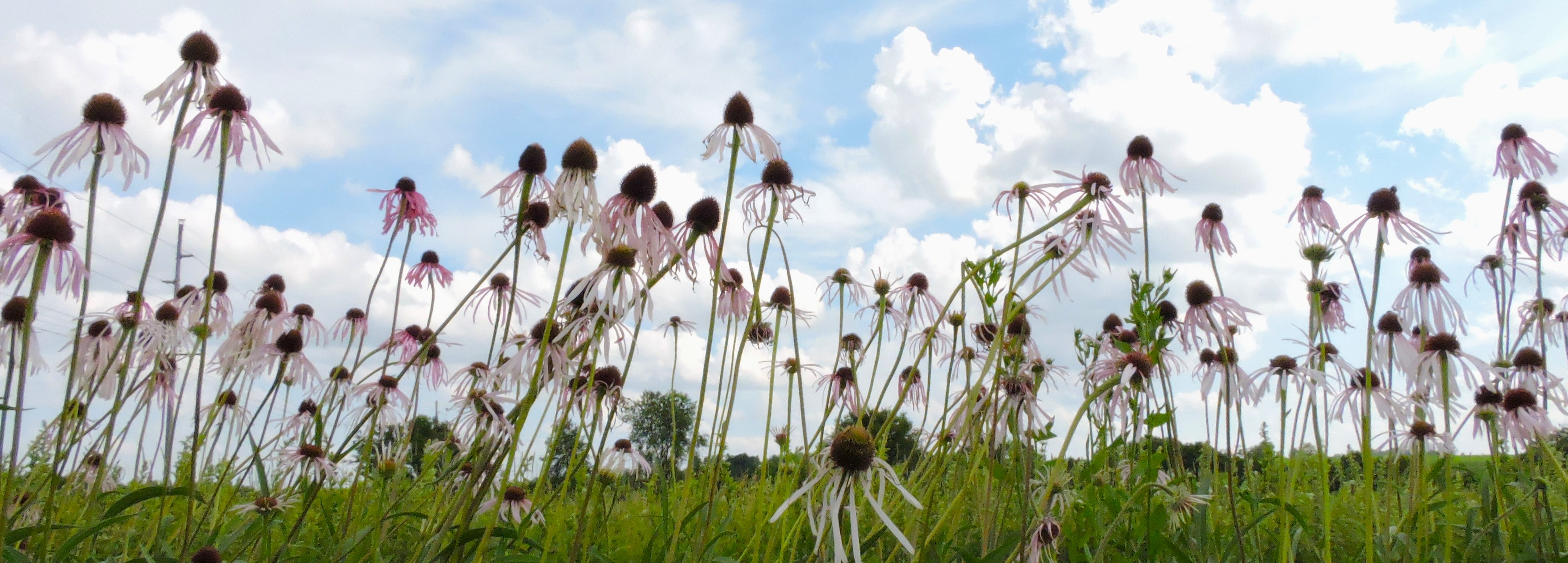
Echinacea pallida (Nutt.) Nutt.
Alternate Common Names: prairie coneflower, pale echinacea
Scientific Synonyms: Brauneria pallida (Nutt.) Britton, Rudbeckia pallida Nutt.
Family: aster family (Asteraceae)
Functional Group: forbs (wildflowers)
Description
- Life cycle and growth form
Perennial from a stout taproot.
Height: 2-3 ft
- Leaves and stem
Leaves mostly basal, long tapered, coarsely hairy with three prominent parallel veins; stems grayish to reddish green, covered in coarse hairs, unbranched.
- Flower, fruit and seedhead
Flower: Single composite flower head at top of stem with 7 or more pink-purple (sometimes white), slender, drooping ray florets and a prominent central cone. Pollen is white.
Fruit/seedhead: Seed head is a dark brown-black cone, about 1 inch in diameter. Seeds (achenes) develop from disk flowers, which bloom from the outer ring of the cone inwards.
Pollination: Insects, primarily bees and butterflies.
- Seed
Seed characteristics
Seed weight:
Seeds per ounce: 5,200 (IA NRCS)
Seeds per pound: 83,200 (IA NRCS)
1000 seed weight: 5.66 g (Seed Information Database)
Description: The “seed unit” is a dry fruit called an achene, about 1/8 in long, with a dark brown band at the square end and pale gray from there to the pointed end. No awns or appendages to remove.
Typical seed test
PLS: 96% (n = 10)
Purity: 99% (n = 10)
Germination: 44% (n = 9)
Dormant: 52% (n = 9)
(averages obtained from n tests of purchased seed lots)
- Habitat and range
Habitat: Dry-mesic to mesic soil; prefers sites with well-drained upland soils and full sun; prairies, oak savannas, abandoned fields, dry woodland openings, along railroads. Avoid wet or poorly drained soils for seed production.
Conservation status: Global- G4, apparently secure; Georgia, Nebraska, North Carolina, and Tennessee- S1, critically imperiled; Alabama- S2, imperiled; Wisconsin- S3, vulnerable (NatureServe)
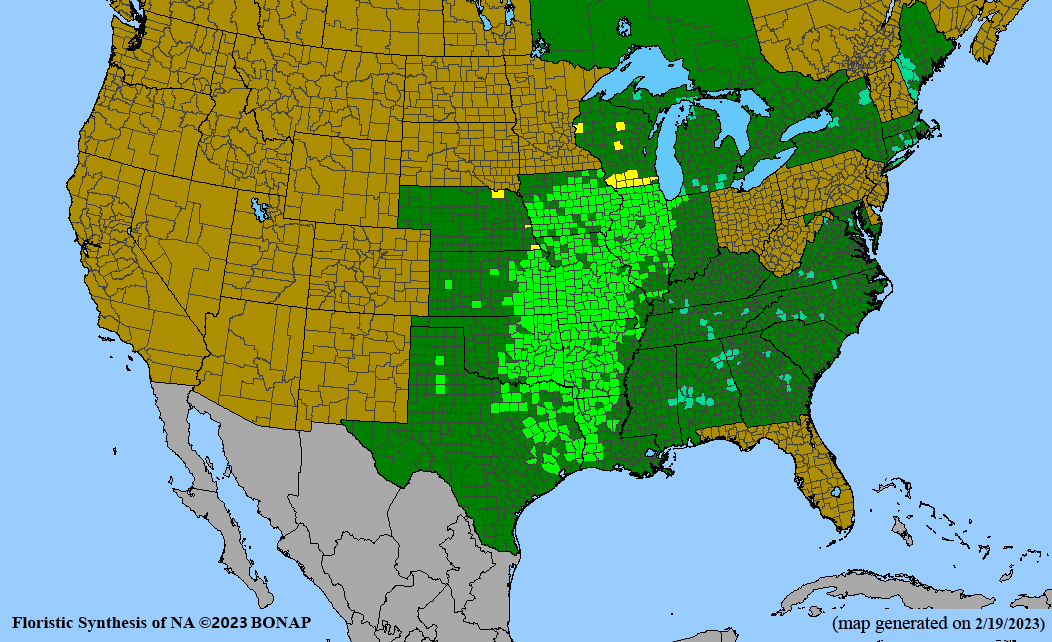
General Comments
This species is best propagated in the greenhouse and transplanted into a weed barrier or bare soil. Weed suppression is essential for good establishment and seed production. Combine harvest is fairly straightforward, since it retains seed well in the heads. All Echinacea species are known to hybridize, so proper isolation should be maintained between related species to prevent hybrid seed production (McGregor 1968).
Recommendations for Seed Production
- Establishment for seed production
Direct seeding
Row spacing: 30-36 in rows
PLS pounds/acre: 3.0-5.0
Seeds per linear foot: 40
Seeding depth: 1/8 in
Seeding method: native seed drill
Seeding time: dormant season
Weed control: Prepare clean, firm, weed free seedbed prior to seeding.
Greenhouse
Seed pre-treatment: Wet stratify 12 weeks at 40° F.
Sowing: Sow seed surface to 1/8 in deep in the greenhouse two months before last frost free date. Literature suggests this species needs light to germinate, but covering seed lightly to 1/8 in does not inhibit germination.
Transplanting: When root growth is sufficient to produce a sturdy plug, harden off, then transplant into bare soil in rows or weed barrier at 8-12 in intervals after all danger of frost.
- Stand management
Weeds: Planting into a weed barrier or plastic mulch suppresses weeds in the first growing season; hand rogue weeds, being careful not to uproot seedlings.
Pests: None noted.
Diseases: None noted.
Hybridization risk: Echinacea angustifolia, E. purpurea
- Seed production
 First harvest: Second year plants.
First harvest: Second year plants.Yield: 55-210 bulk pounds/acre (yields extrapolated from harvests of 6 plots)
Stand life: Peak harvests second year. Good harvest third year. Stand persists, but seed production declines significantly fourth year and after.
Flowering date: mid-June to mid-July in northern Iowa
Seed maturity/Harvest date: September in northern Iowa
Seed retention: Generally holds seed well, some shattering may begin in late September and extend throughout the winter months.
Harvest date range at TPC (2003-2021): Aug 5 - Oct 25
Recommended harvest method: Combine before significant shattering occurs.
- Seed cleaning and storage
Cleaning process: Combine does a superb job of threshing seedheads. Pre-clean combined material by scalping through 1/2 in and 1/4 in mesh to remove large particles and make flowable, then air-screen. If hand harvested, seedheads need to be threshed using a hammermill or brush machine, using care not to overclean and damage the hulls of the achenes.
Seed storage: Cool/dry (33-50° F, 30-50% RH).
Released Germplasm
Source Identified material: Natural Selections/Iowa Ecotype Project Zones 1, 2, and 3; Northern Missouri Germplasm, Western Missouri Germplasm
- References
Chayka, K. (n.d.). Echinacea pallida (pale purple coneflower). Minnesota Wildflowers. https://www.minnesotawildflowers.info/flower/pale-purple-coneflower
Cochrane, T. S., Elliot, K., & Lipke, C. S. (2014). Purple coneflowers. In Prairie plants of the University of Wisconsin-Madison Arboretum (3rd ed., p. 74–75). University of Wisconsin-Madison Arboretum.
Hilty, J. (2019). Pale purple coneflower - Echinacea pallida. Illinois Wildflowers. https://www.illinoiswildflowers.info/prairie/plantx/pale_coneflowerx.ht…;
Houseal, G. A. (2007). Forbs wildflowers. In G. A. Houseal (Eds.), Tallgrass Prairie Center’s native seed production manual (pp. 32–33). Tallgrass Prairie Center - University of Northern Iowa.
Kartesz, J.T., The Biota of North America Program (BONAP). 2023. North American Plant Atlas. (http://bonap.net/napa). Chapel Hill, N.C. [maps generated from Kartesz, J.T. 2023. Floristic Synthesis of North America, Version 1.0. Biota of North America Program (BONAP). (in press)]
NatureServe. 2024. NatureServe Network Biodiversity Location Data accessed through NatureServe Explorer [web application]. NatureServe, Arlington, Virginia. Available https://explorer.natureserve.org/. (Accessed: February 29, 2024).
USDA NRCS National Plant Data Team. (n.d.). Echinacea pallida (Nutt.) Nutt. USDA plants database. https://plants.usda.gov/home/plantProfile?symbol=ECPA
Species Guide Updated 12/3/2024
parasol whitetop
parasol whitetop sagem
Doellingeria umbellata (Mill.) Nees
Alternate Common Names: flat-top aster, parasol aster, tall flat-topped white aster
Scientific Synonyms: Aster umbellatus Miller, Diplopappus umbellatus (Miller) Hooker, Diplostephium umbellatum (Miller) Cassini
Family: aster or sunflower family (Asteraceae)
Functional Group: forbs (wildflowers)
Description
- Life cycle and growth form
Long-lived perennial, spreads by short rhizomes to form small colonies.
Height: 1-5 ft

- Leaves and stem

Lance-shaped, 3-5 in long and 1/2-1 in wide, leaf margins toothless, leaf surfaces usually hairless or with short hairs, alternate arrangement; stems are erect and unbranched except within the flower head, with few to no hairs, generally light yellowish-green but sometimes purple.
- Flower, fruit and seedhead
Flower: Individual heads are daisy-like, about 1/2 in wide, with yellow to tan centers and usually 5-10 (up to 15) white “petals” (rays) irregularly arranged around the central disc; dozens to hundreds of heads in a branched, flattened cluster up to 10 or 12 in wide.
Fruit/seedhead: Seed head appears fuzzy due to creamy-white fluff (pappus) on seeds.
Pollination: Insects, including bees, butterflies, and moths

- Seed
Seed characteristics
Seeds per ounce: 67,000 (IA NRCS)
1000 seed weight: 0.7 g (Seed Information Database)
Description: Seed (achene) is light brown, 2.5-3 mm long, approximately 1 mm wide near the top, tapered to a point on the lower end, and bears a “parachute” of creamy white fluff (pappus).
Typical seed test
PLS: 85% (n = 5)
Purity: 90% (n = 5)
Germination: 22% (n = 4)
Dormant: 71% (n = 4)
(averages obtained from n tests of purchased seed lots)
- Habitat and range
Habitat: Moist to wet soils, preferably with some sand; partial to full sun; wet prairies, sedge meadows, seasonally wet ditches, and fens; benefits from irrigation in production systems. The USDA classifies it as a Facultative Wetland species in the Midwest region.
Conservation status: Global- G5, secure; Delaware, Iowa, and North Carolina- S3, vulnerable (NatureServe)
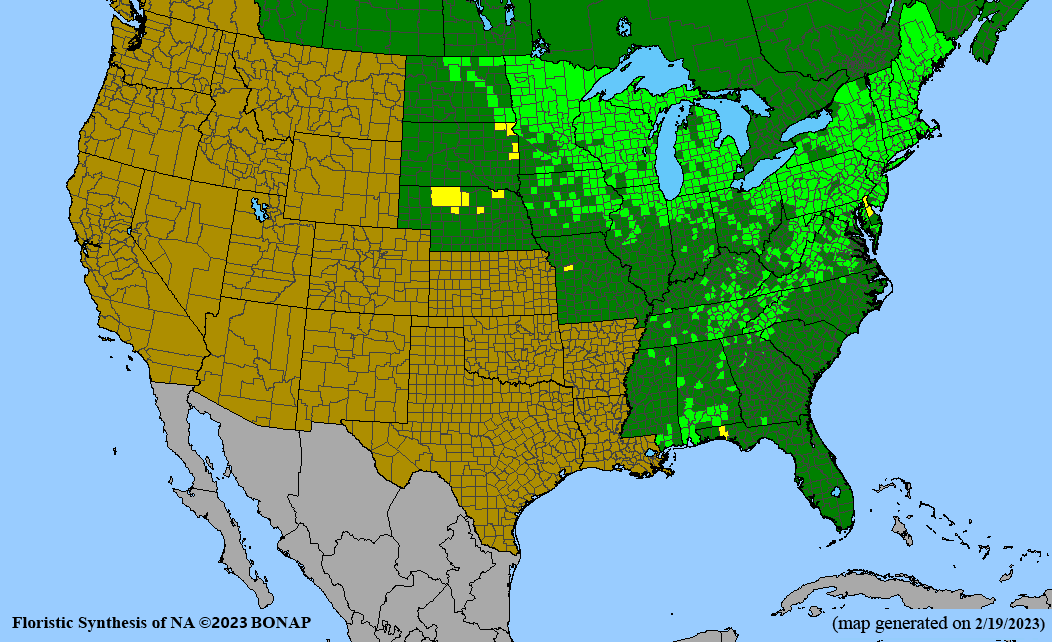
General Comments
Parasol whitetop is a late season nectar and pollen source for diverse species of bees (including specialist bees), wasps, beetles, flower flies, and skipper butterflies. It is a larval host to some species of checkerspot and crescent butterflies. It can grow and flower for many years in mesic soils but benefits from irrigation in production systems.
Recommendations for Seed Production
- Establishment for seed production
Direct seeding
We do not have experience with direct seeding this species for seed production.
Greenhouse
Seed pre-treatment: 60 days cold-moist stratification results in uniform and high rates of germination.
Sowing: Seed is small and should be only lightly covered with growing media. If started in germination flats, transplant to individual plugs when seedlings have their first pair of true leaves, about 2 weeks after seeding.
Transplanting: Seedlings are ready to transplant to the field about 6-8 weeks after transferring them to plugs, when their roots are well-branched and numerous root tips are visible at hole(s) in the base of the plug. Pop out a few plugs to check for adequate root development that will provide sturdy plugs for planting. Seedlings are fast growing and may need to be clipped back before transplanting to improve the shoot:root ratio. A week or two before transplanting, move flats outside to ‘harden off.’ (See Propagation chapter in General Information for more details).
- Stand management
Weeds: In the first season after transplanting, weeds are suppressed by a plastic weed barrier. Plants spread slowly by short rhizomes; in second and subsequent years, holes in plastic may need to be expanded or plastic removed to make room for new stems.
Pests: None noted.
Diseases: None noted.
Soil moisture: This species benefits from drip irrigation when planted in mesic soils.
- Seed production
 First harvest: Plants will flower and produce a small amount of seed in the planting year when started from transplants.
First harvest: Plants will flower and produce a small amount of seed in the planting year when started from transplants.Yield: 28-74 pounds/acre (based on 1 plot)
Stand life: unknown
Flowering date: August - September
Seed maturity/Harvest date: late September - late October
Seed retention: Seeds are wind dispersed soon after maturity, when fluff (pappus) expands in late September through October.
Harvest date range at TPC (2022-2023): Sept 15 - Oct 20
Recommended harvest method: Seed is released from heads within days of the fluffy “parachutes” expanding. Watch for the centers of seed clusters to begin shattering, and pick early maturing seed heads (clip stalks below seed clusters). If some heads in a cluster are still closed (not fluffy), pull apart a few heads to see if the seeds are dark colored and separate easily from the base (receptacle). Combine the rest of the plot at peak maturity. Turn off air or combine will disperse the fluffy seeds.
- Seed cleaning and storage
Cleaning process: If hand clipped, run dried material through a 1/4 in mesh to thresh seed from stalks. Use a brush machine (medium bristles, low vacuum) to remove pappus. May need two rounds of brushing. Winnow with a box fan to separate seed from most of the pappus and chaff. Airscreen 2-3 times, then indent to remove broken bits of stems. See Appendix C for specific settings.
Seed storage: cool/dry (33-50° F, 30-50% RH)
Released Germplasm
Source Identified material: Natural Selections/Iowa Ecotype Zone NI

- References
Chayka, K. (n.d.). Doellingeria umbellata (flat-topped white aster). Minnesota Wildflowers. https://www.minnesotawildflowers.info/flower/flat-topped-white-aster
Cochrane, T. S., Elliot, K., & Lipke, C. S. (2014). Flat-top aster. In Prairie plants of the University of Wisconsin-Madison Arboretum (3rd ed., p. 133). University of Wisconsin-Madison Arboretum.
Hilty, J. (2019). Flat-topped aster - Doellingeria umbellata. Illinois Wildflowers. https://www.illinoiswildflowers.info/wetland/plants/fltp_aster.html
Kartesz, J.T., The Biota of North America Program (BONAP). 2023. North American Plant Atlas. (http://bonap.net/napa). Chapel Hill, N.C. [maps generated from Kartesz, J.T. 2023. Floristic Synthesis of North America, Version 1.0. Biota of North America Program (BONAP). (in press)]
NatureServe. 2024. NatureServe Network Biodiversity Location Data accessed through NatureServe Explorer [web application]. NatureServe, Arlington, Virginia. Available https://explorer.natureserve.org/. (Accessed: February 28, 2024).
Society for Ecological Restoration, International Network for Seed Based Restoration and Royal Botanic Gardens Kew. (2023) Seed Information Database (SID). Available from: https://ser-sid.org/ (February 2023)
USDA NRCS National Plant Data Team. (n.d.). Doellingeria umbellata (Mill.) Nees. USDA plants database. https://plants.usda.gov/plant-profile/DOUM2
Van Der Grinten, Martin. (2001). Propagation protocol for production of Container (plug) Aster umbellatus P. Mill. plants USDA NRCS - Big Flats Plant Materials Center Corning, New York. In: Native Plant Network. URL: https://NativePlantNetwork.org (accessed 2024/02/02). US Department of Agriculture, Forest Service, National Center for Reforestation, Nurseries, and Genetic Resources.
Semple, J. C., & Chmielewski, J. G. (2020, November 6). Doellingeria umbellata (Miller) Nees. Flora of North America. http://floranorthamerica.org/Doellingeria_umbellata
Species Guide Updated 12/20/2024
pinnate prairie coneflower
pinnate prairie coneflower dickeye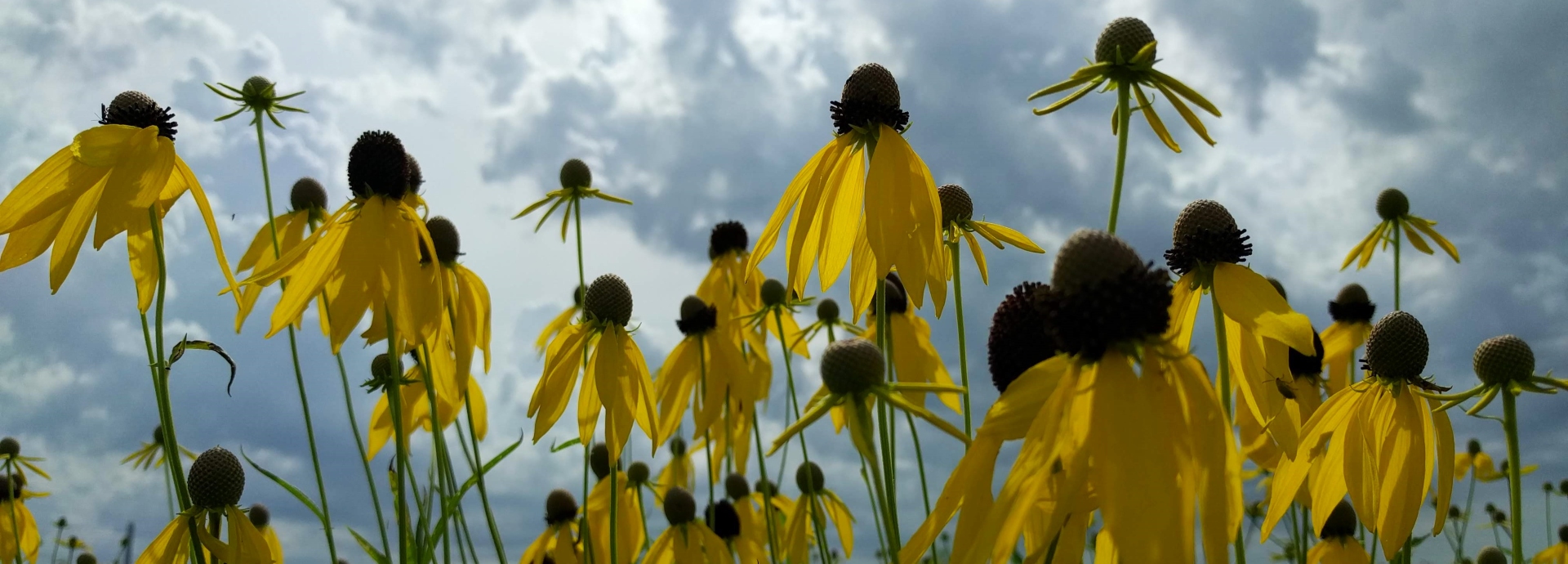
Ratibida pinnata (Vent.) Barnhart
Alternate Common Names: gray-headed coneflower, yellow coneflower, globular coneflower, drooping coneflower, gray coneflower, prairie coneflower, weary susan, grayhead coneflower, drooping yellow coneflower
Scientific Synonyms: Lepachys pinnata (Vent.) Torr. & A. Gray, Rudbeckia pinnata Vent.
Family: aster family (Asteraceae)
Functional Group: forbs (wildflowers)
Description
- Life cycle and growth form
Perennial that forms tight clumps or colonies.
Height: 3-7 ft
- Leaves and stem
Leaves are alternate, irregular in shape and pinnately divided into 3-7 lobes, with short, rough hairs; stems are long, stiff, and slender, unbranched except near the top.
- Flower, fruit and seedhead
Flower: Composite flower heads borne singly at the tips of long stalks with drooping 1 in long yellow petals (rays) surrounding the egg-shaped dome of disk flowers.
Fruit/seed head: Firm, dense seedheads often hold some seed into late fall and winter and release an anise or citrus scent when crushed.
Pollination: Insects including bees, butterflies, flies, wasps, and beetles.
- Seed
Seed characteristics
Seed weight:
Seeds per ounce: 30,000 (IA NRCS)
1000 seed weight: 0.87 g (Seed Information Database)
Description: Seeds (achenes) develop from fertile disc flowers. Achenes are brown to black and about 1/16 in long.
Typical seed test
PLS: 93%
Purity: 99%
Germination: 76%
Dormant: 8%
(averages obtained from 11 tests of purchased seed lots)
- Habitat and range
Habitat: Wet-mesic to dry-mesic loamy soils; full sun; usually common on medium to high quality prairies; remnant prairies, thickets, woodland edges, prairies, limestone glades.
Conservation status: Global- G5, secure; West Virginia- SH, possibly extirpated; Pennsylvania and South Carolina- S1, critically imperiled; Florida and Louisiana- S2, imperiled (NatureServe)
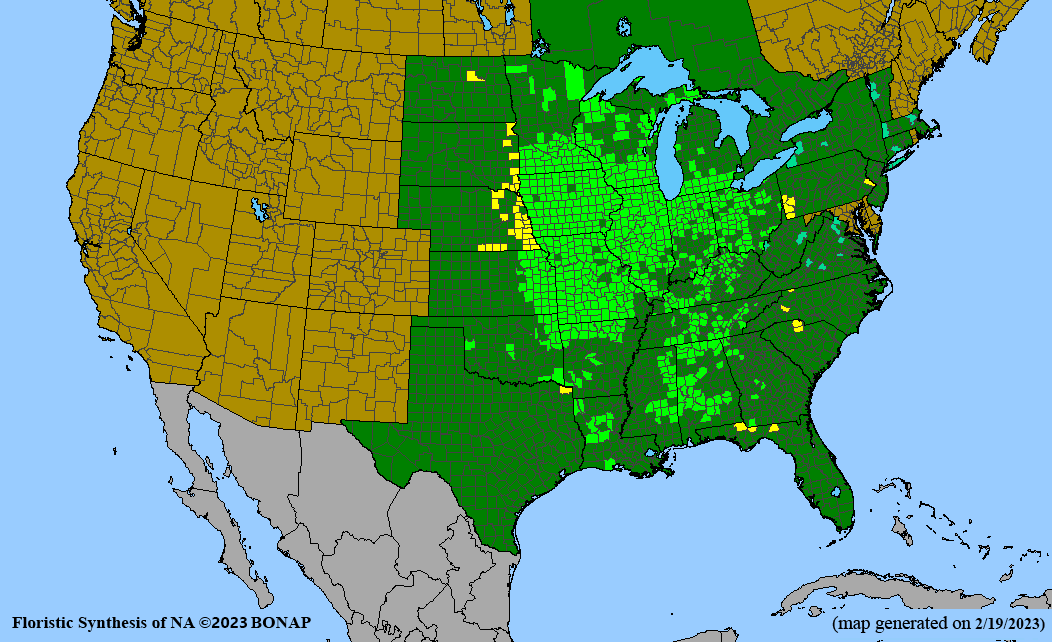
General Comments
Pinnate prairie coneflower is typically common on Midwestern prairies and establishes readily from seed in reconstructed prairies. Some seeds generally stay in the seedheads through fall and into winter are eaten by songbirds. Seed harvesting and cleaning are relatively straightforward if good weed control is maintained.
Recommendations for Seed Production
- Establishment for seed production
Direct seeding
Row spacing: 30-36 in rows
PLS pounds/acre: 3.6-5.0
Seeds per linear foot: 40
Seeding depth: 1/4 in
Seeding method: native seed drill
Seeding time: dormant season
Weed control: Prepare clean, firm, weed free seedbed prior to seeding.
Greenhouse
Seed pre-treatment: Wet stratify 8-12 weeks at 40° F.
Sowing: Sow seed in greenhouse two months before last frost free date.
Transplanting: Harden-off, transplant into bare soil in rows or weed barrier at 8-12 in intervals after all danger of frost.
- Stand management
Weeds: Mow/cultivate between rows. Post emergence grass herbicide, tillage, roguing.
Pests: None noted.
Diseases: None noted.
- Seed production
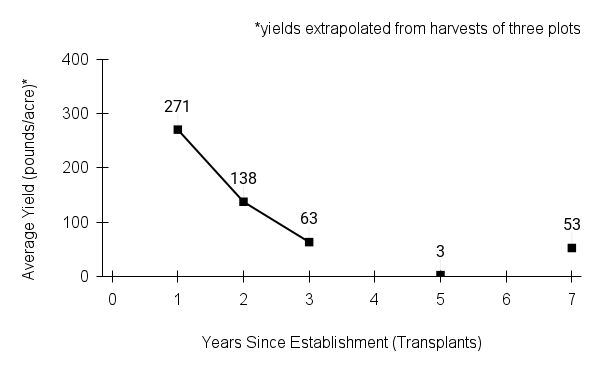 First harvest: Remain vegetative the first year, abundant flowering and seed production second year.
First harvest: Remain vegetative the first year, abundant flowering and seed production second year.Yield: 100-250 bulk pounds/acre
Stand life: Peak harvests second year. Good harvest third year. Stand persists but seed production may decline significantly fourth year and after.
Flowering date: Flowering occurs early July to mid-August.
Seed maturity/Harvest date: Late September
Seed retention: Shattering occurs mid to late October.
Harvest date range at TPC (2004-2010): Sept 3 - Oct 27
Recommended harvest method: combine
- Seed cleaning and storage
Cleaning process: Pre-clean by scalping through 1/2 in and 1/4 in mesh to remove large particles and make flowable, then air-screen. Foxtail can be removed from most of the seed with scalping screens, followed by a final cleaning with a belt-sorter or velvet roller of scalped material. (Brushing is not needed as there are no awns or appendages to remove).
Seed storage: cool/dry (33-50° F, 30-50% RH)
Released Germplasm
Source Identified material: Natural Selections/Iowa Ecotype Project Zones 1 (northern Iowa), 2 (central Iowa), and 3 (southern Iowa); Northern Missouri Germplasm
Cultivated variety (cultivars): Sunglow (KS)
- References
Chayka, K. (n.d.). Ratibida pinnata (gray-headed coneflower). Minnesota Wildflowers. https://www.minnesotawildflowers.info/flower/gray-headed-coneflower
Cochrane, T. S., Elliot, K., & Lipke, C. S. (2014). Yellow coneflower. In Prairie plants of the University of Wisconsin-Madison Arboretum (3rd ed., p. 105). University of Wisconsin-Madison Arboretum.
Hilty, J. (2019). Yellow coneflower - Ratibida pinnata. Illinois Wildflowers. https://www.illinoiswildflowers.info/prairie/plantx/yl_coneflowerx.htm
Houseal, G. A. (2007). Forbs wildflowers. In G. A. Houseal (Eds.), Tallgrass Prairie Center’s native seed production manual (pp. 48–49). Tallgrass Prairie Center - University of Northern Iowa.
Kartesz, J.T., The Biota of North America Program (BONAP). 2023. North American Plant Atlas. (http://bonap.net/napa). Chapel Hill, N.C. [maps generated from Kartesz, J.T. 2023. Floristic Synthesis of North America, Version 1.0. Biota of North America Program (BONAP). (in press)]
NatureServe. 2024. NatureServe Network Biodiversity Location Data accessed through NatureServe Explorer [web application]. NatureServe, Arlington, Virginia. Available https://explorer.natureserve.org/. (Accessed: February 29, 2024).
Runkel, S. T., & Roosa, D. M. (2009). Yellow coneflower. In Wildflowers of the tallgrass prairie: The upper Midwest (2nd ed., pp. 154–155). University of Iowa Press.
USDA NRCS National Plant Data Team. (n.d.). Ratibida pinnata (Vent.) Barnhart. USDA plants database. https://plants.usda.gov/home/plantProfile?symbol=RAPI
Species Guide Updated 12/5/2025
smooth oxeye
smooth oxeye sagem
Heliopsis helianthoides (L.) Sweet
Alternate Common Names: common ox-eye, false sunflower, sunflower heliopsis, ox-eye, sunflower-everlasting
Scientific Synonym: Buphthalmum helianthoides L.
Family: aster family (Asteraceae)
Functional Group: forbs (wildflowers)
Description
- Life cycle and growth form
Perennial, fibrous rooted, producing clumps or colonies from rhizomes.
Height: 2-6 ft
- Leaves and stem
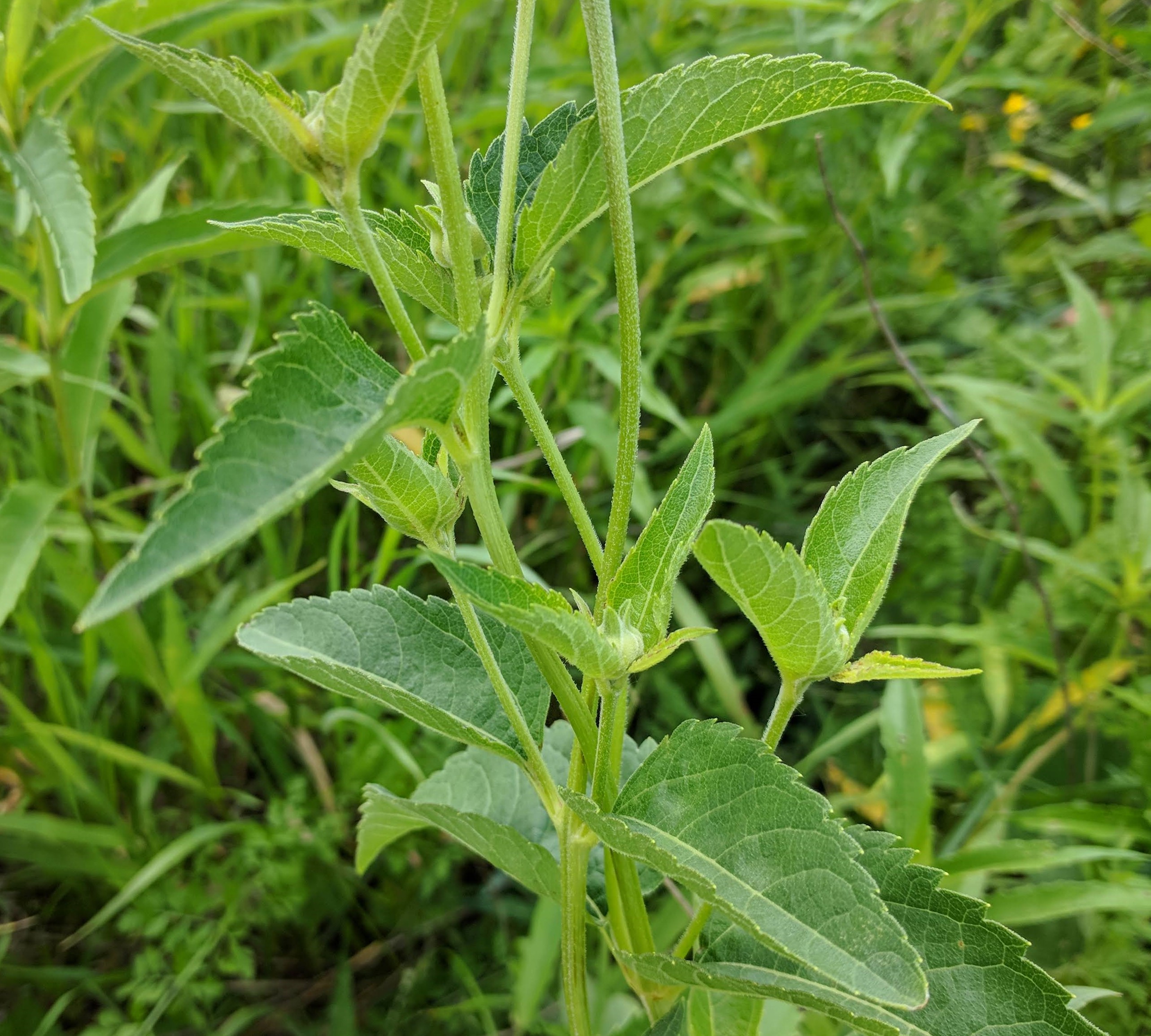
Leaves opposite, egg-shaped with pointed tips, saw-tooth margins, rough texture, up to 5 in long and 3.5 in wide; stem is erect, rough with short hairs, branched.
- Flower, fruit and seedhead
Flower: One to 15 sunflower-like yellow flower heads, 1.5-3 in (4-7.5 cm) in diameter, at ends of long stalks from stem tip and upper leaf axils; ray florets are yellow-orange color, center disk usually golden yellow; underside of the flower head with alternating short and long bracts (phyllaries).
Fruit/seedhead: Flower head matures to a head of “seed” (achenes); achenes are dark, 3-4 angled, 4-5 mm long, and lack pappus; both disk and ray florets are fertile and produce achenes.
Pollination: Insects such as bees, wasps, beetles, flies, and butterflies.
- Seed
Seed characteristics
Seeds per ounce: 6,300 (IA NRCS)
Seeds per pound: 100,800 (IA NRCS)
1000 seed weight: 4.15 g (Seed Information Database)
Description: Seed unit is a smooth, dark achene about 3/16 in (4-5 mm) long.
Typical seed test
PLS: 95% (n = 10)
Purity: 100% (n = 10)
Germination: 65% (n = 9)
Dormant: 31% (n = 9)
(averages obtained from n tests of purchased seed lots)
- Habitat and range
Habitat: Dry-mesic to wet-mesic soil; full sun; low to high quality remnant prairies, disturbed areas, roadsides, railroads, woodland openings and edges, thickets, streambanks, limestone glades. Wetland Indicator Status is Facultative Upland (FACU) for the Midwest.
Conservation status: Global- G5, secure; Delaware- S1, critically imperiled; Louisiana- S3, vulnerable (NatureServe)
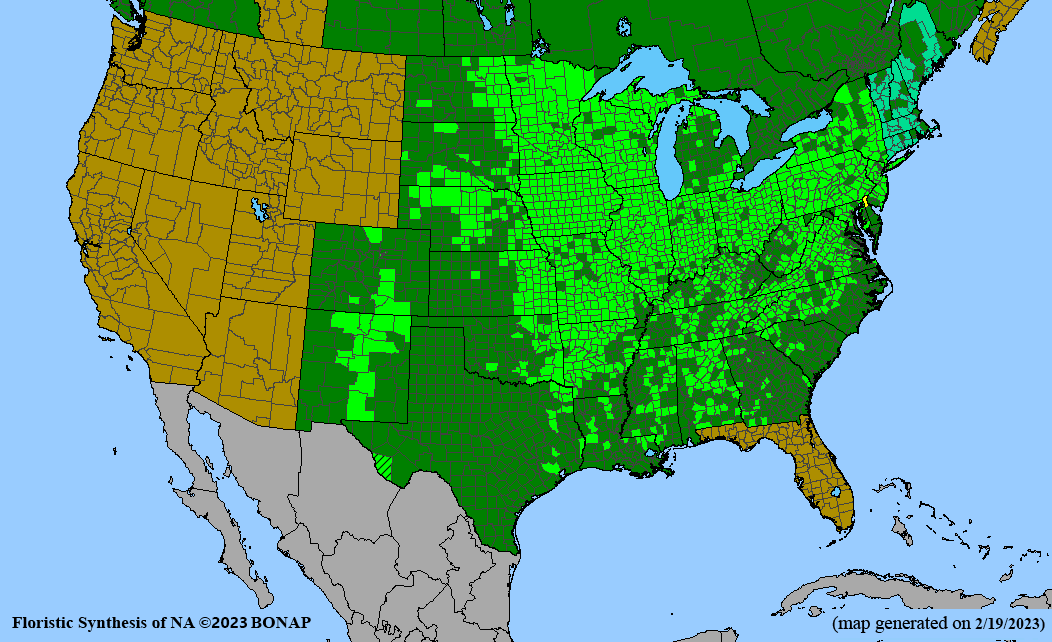
General Comments
Smooth oxeye is a component of most tallgrass prairies with medium to dry soils where it grows in association with tall, warm-season grasses. The long flowering time and abundant nectar and pollen make this an important pollinator resource, and the nutritious seeds are eaten by birds and mammals. This species is fairly easy to establish by direct seeding, if good seedbed preparation and weed suppression are achieved. Extended flowering and seed-ripening period makes determining optimal combine harvesting time difficult. Seed cleaning is accomplished with air-screen cleaning.
Recommendations for Seed Production
- Establishment for seed production
Direct seeding
Row spacing: 30-36 in rows
PLS pounds/acre: 4.0
Seeds per linear foot: 40
Seeding depth: 1/4 in
Seeding method: native seed drill
Seeding time: dormant season
Weed control: Prepare clean, firm, weed free seedbed prior to seeding.
Greenhouse
Seed pre-treatment: Wet stratify 8-12 weeks at 40° F.
Sowing: Sow seed at 1/4 in depth about two months before the last frost-free date.
Transplanting: Harden off, transplant into bare soil in rows or weed barrier at 8 in intervals after all danger of frost. Since this species spreads by rhizomes to form clumps, remove weed barrier after establishment year or use biodegradable barrier.
- Stand management
Weeds: Mow/cultivate between rows. Post emergence grass herbicide, tillage, roguing.
Pests: Plants may be affected by red aphids (Uroleucon) though these infestations are often cleared by parasitic wasps and aphid predators, and it is not clear that they cause much harm to the plants.
Diseases: Powdery mildew.
- Seed production
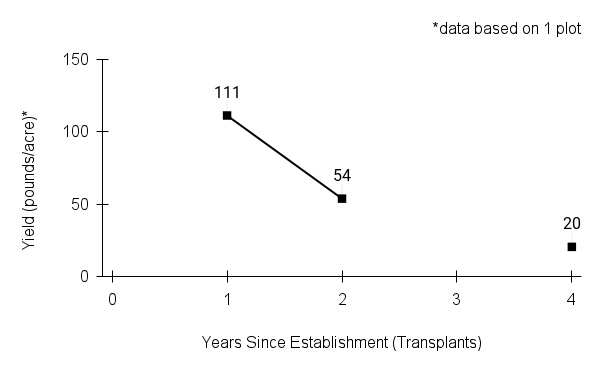
First harvest: Some flowering and seed production in first growing season from transplants and in well-managed direct seeded stands.
Yield: 20-115 pounds/acre (per acre yield extrapolated based on production from 1 plot)
Stand life: Peak harvest second-fourth year with declining yields in subsequent years.
Flowering date: early June - late July in northern Iowa
Seed maturity/Harvest date: mid-August to late September in northern Iowa; complicated by long flowering and seed ripening period.
Seed retention: Shattering occurs mid to late October.
Harvest date range at TPC (2005-2008): Sept 15 - 21
Recommended harvest method: Combine
- Seed cleaning and storage
Cleaning process: Pre-clean by scalping through 1/2 in and 1/4 in mesh to remove large plant matter and make flowable, then air-screen. (No awns or appendages to remove.)
Seed storage: cool/dry (33-50° F, 30-50% RH)
Released Germplasm
Source Identified material: Central Iowa Germplasm (IA Zone 2), Northern Iowa Germplasm (IA Zone 1), Southern Iowa Germplasm (IA Zone 3)
Cultivated variety (cultivar): Midas (KS)
- References
Chayka, K. (n.d.). Heliopsis helianthoides (smooth oxeye). Minnesota Wildflowers. https://minnesotawildflowers.info/flower/smooth-oxeye
Cochrane, T. S., Elliot, K., & Lipke, C. S. (2014). Ox-eye. In Prairie plants of the University of Wisconsin-Madison Arboretum (3rd ed., p. 88). University of Wisconsin-Madison Arboretum.
Hilty, J. (2019). False sunflower - Heliopsis helianthoides. Illinois Wildflowers. https://www.illinoiswildflowers.info/prairie/plantx/fs_sunflowerx.htm
Houseal, G. A. (2007). Forbs wildflowers. In G. A. Houseal (Eds.), Tallgrass Prairie Center’s native seed production manual (pp. 36–37). Tallgrass Prairie Center - University of Northern Iowa.
Kartesz, J.T., The Biota of North America Program (BONAP). 2023. North American Plant Atlas. (http://bonap.net/napa). Chapel Hill, N.C. [maps generated from Kartesz, J.T. 2023. Floristic Synthesis of North America, Version 1.0. Biota of North America Program (BONAP). (in press)]
NatureServe. 2024. NatureServe Network Biodiversity Location Data accessed through NatureServe Explorer [web application]. NatureServe, Arlington, Virginia. Available https://explorer.natureserve.org/. (Accessed: February 29, 2024).
Runkel, S. T., & Roosa, D. M. (2009). Ox-eye. In Wildflowers of the tallgrass prairie: The upper Midwest (2nd ed., pp. 162–163). University of Iowa Press.
Smith, A. R. (2020, November 6). Heliopsis helianthoides (Linnaeus) Sweet. Flora of North America. http://floranorthamerica.org/Heliopsis_helianthoides
USDA NRCS National Plant Data Team. (n.d.). Heliopsis helianthoides (L.) Sweet. USDA plants database. https://plants.usda.gov/home/plantProfile?symbol=HEHE5
Species Guide Updated 12/11/2024
spotted joe pye weed
spotted joe pye weed sagem
Eutrochium maculatum (L.) E. E. Lamont
Alternate Common Names: purple boneset, spotted trumpetweed
Scientific Synonyms: Eupatoriadelphus maculatus (L.) R. M. King & H. Rob., Eupatorium maculatum L., Eupatorium purpureum L. var. maculatum (L.) Darl., Eupatorium purpureum subsp. maculatum (L.) Á. Löve & D. Löve, Eupatorium trifoliatum var. maculatum (L.) Farwell
Family: aster or sunflower family (Asteraceae)
Functional Group: forbs (wildflowers)
Description
- Life cycle and growth form
Perennial, spreads slowly by rhizomes to form clumps.
Height: 2-10 ft (mostly 3-6 ft)

- Leaves and stem

Lance-shaped, up to 9 in long with serrated margins, whorled in groups of 4-5 (usually) at each node; unbranched stems purple to purple-spotted (the name ‘maculatum’ means spotted and refers to this trait).
- Flower, fruit and seedhead
Flower: 3-5 small, indistinct florets per head, in flat-topped to domed inflorescences with dozens to hundreds of pink to purplish heads (rarely white); inflorescences appear fuzzy due to the long styles that stick out of the florets.
Fruit/seedhead: Seed clusters ripen from the center outward, becoming tan and fluffy as seed matures; seed is wind-dispersed and susceptible to shattering in windy weather.
Pollination: Insects, particularly bees and butterflies.

- Seed
Seed characteristics
Seeds per ounce: 95,000 (IA NRCS)
1000 seed weight: 0.28 g (Seed Information Database)
Description: Slender, charcoal-gray seeds about 3 mm long with a tuft of tan pappus.
Typical seed test
PLS: 74% (n = 5)
Purity: 86% (n = 5)
Germination: 17% (n = 4)
Dormant: 72% (n = 4)
(averages obtained from n tests of purchased seed lots)
- Habitat and range
Habitat: Moist to wet soil; full sun; wet prairies, sedge meadows, fens, ditches, and other wet places. The USDA classifies it as an Obligate Wetland species in the Midwest region. It benefits from irrigation in production systems.
Conservation status: Global- G5, secure; Idaho and West Virginia- S1, critically imperiled; Montana- S1/S2, critically imperiled to imperiled; Arizona, Virginia, and Georgia- S2, imperiled; Wyoming- S3, vulnerable (NatureServe)
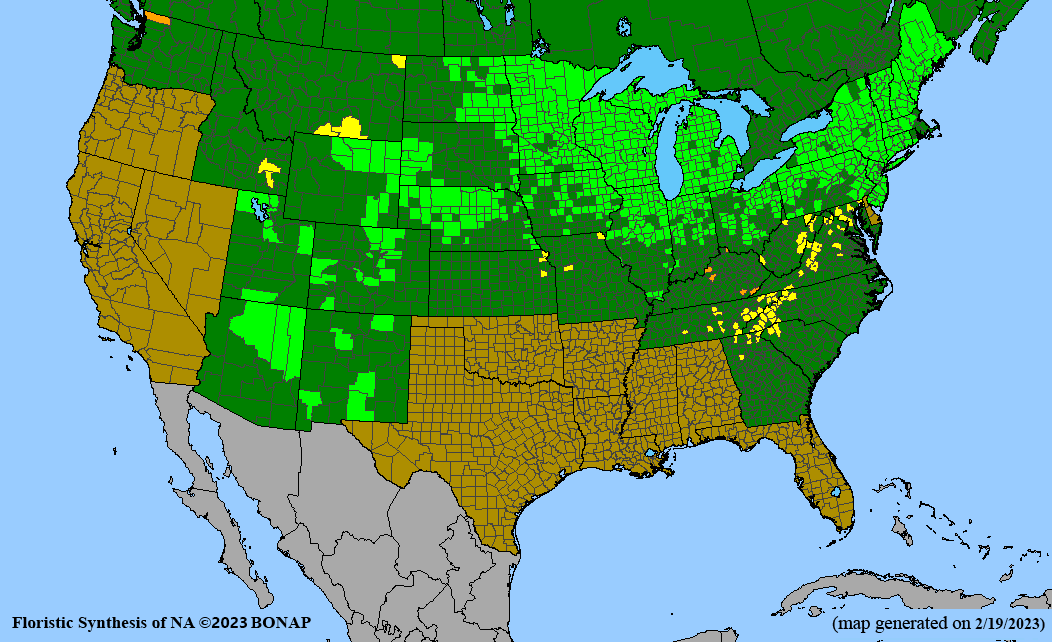
General Comments
The sweet-scented flowerheads attract numerous and diverse pollinators including the endangered rusty patched bumble bee. We once identified seven species of butterflies along a 150 foot row of flowering spotted joe pye weed in one 15-minute observation. Traditional uses of this species by Native tribes include treatments for digestive, urinary, kidney, and women’s complaints and using the hollow stems as straws. The clumped stems and whorled leaves produce dense shade that excludes most weeds from a well-established plot. Irrigation is important for seed production.
Recommendations for Seed Production
- Establishment for seed production
Direct seeding
We do not have experience direct seeding this species for seed production.
Greenhouse
Seed pre-treatment: 60 days cold-moist stratification.
Sowing: Seed is small and should be surface sown or very lightly covered or seedlings will not have enough energy to emerge. If started in germination flats, transplant to individual plugs when seedlings have their first pair of true leaves.
Transplanting: Seedlings are ready to transplant to the field about 8-12 weeks after starting in plugs, when their roots are well-branched and numerous root tips are visible at hole(s) in the base of the plug. Pop out a few plugs to check for adequate root development that will provide sturdy plugs for planting. A week or two before transplanting, move flats outside to ‘harden off.’ (See Propagation chapter in General Information for more details).
- Stand management
Weeds: In the first season after transplanting, weeds are suppressed by a plastic weed barrier. Plants spread by short rhizomes; in second and subsequent years, holes in plastic must be expanded or plastic removed to make room for new stems. Well-established plots shade out most weeds.
Pests: None noted.
Diseases: None noted.
Soil moisture: Irrigation is necessary in most soils to obtain maximum seed yield.
- Seed production
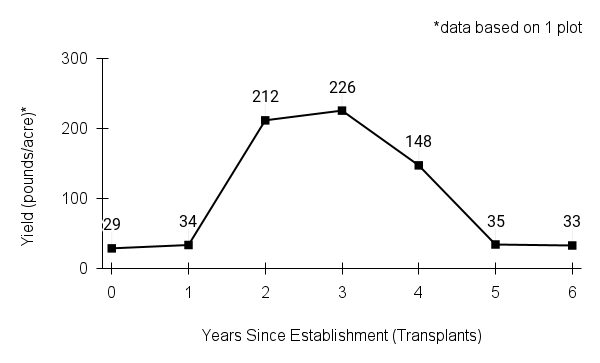 First harvest: Plants flower and set a little seed the first year when transplanted in spring.
First harvest: Plants flower and set a little seed the first year when transplanted in spring.Yield: 29-226 pounds/acre (based on 1 plot)
Stand life: Peak seed production in years 3-5, but plants are long-lived and vigorous for many years.
Flowering date: late July - early September in northeast Iowa
Seed maturity/Harvest date: second to third week of September
Seed retention: Seeds are wind dispersed soon after maturity, when fluff (pappus) expands in late August through September.
Harvest date range at TPC (2016-2022): Aug 26 - Oct 3
Recommended harvest method: Watch for the centers of seed clusters to begin shattering, and pick early maturing seed heads (clip stalks below seed clusters). If some heads in a cluster are still closed (not fluffy), pull apart a few heads to see if the seeds are dark colored and separate easily from the base (receptacle). Combine the rest of the plot at peak maturity. Turn off air or combine will disperse the fluffy seeds.
- Seed cleaning and storage
Cleaning process: If hand clipped, run dried material through a 1/4 in mesh to thresh seed from stalks. Use a brush machine (medium bristles, minimum vacuum) to remove pappus. Winnow with a box fan to separate seed from most of the pappus and chaff. Airscreen 2-3 times to finish cleaning. See Appendix C for specific settings.
Seed storage: cool/dry (33-50° F, 30-50% RH)
Released Germplasm
Source Identified material: Natural Selections/Iowa Ecotype Zone 1
Cultivated variety (cultivar): ‘Gateway’ is a compact cultivar used in landscaping.
- References
Chayka, K. (n.d.). Eutrochium maculatum (spotted joe-pye weed). Minnesota Wildflowers. https://www.minnesotawildflowers.info/flower/spotted-joe-pye-weed
Eutrochium maculatum. (2024). Prairie Moon Nursery. https://www.prairiemoon.com/eutrochium-maculatum-joe-pye-weed-prairie-moon-nursery.html
Hilty, J. (n.d.). Spotted joe-pye weed - Eutrochium maculatum. Illinois Wildflowers. https://www.illinoiswildflowers.info/wetland/plants/sp_joepye.htm
Kartesz, J.T., The Biota of North America Program (BONAP). 2023. North American Plant Atlas. (http://bonap.net/napa). Chapel Hill, N.C. [maps generated from Kartesz, J.T. 2023. Floristic Synthesis of North America, Version 1.0. Biota of North America Program (BONAP). (in press)]
Lamont, Eric E. (2020, November 6). Eutrochium maculatum (Linnaeus) E. E. Lamont. Flora of North America. http://floranorthamerica.org/Eutrochium_maculatum
Missouri Botanical Garden. (n.d.). Eutrochium maculatum “Gateway.” Plant Finder. https://www.missouribotanicalgarden.org/PlantFinder/PlantFinderDetails.aspx?taxonid=302488&is
Moerman, D. (2003). Native American ethnobotany database. BRIT. http://naeb.brit.org/
NatureServe. 2024. NatureServe Network Biodiversity Location Data accessed through NatureServe Explorer [web application]. NatureServe, Arlington, Virginia. Available https://explorer.natureserve.org/. (Accessed: February 28, 2024).
North Carolina State Extension (n.d.) Eutrochium maculatum. North Carolina Extension Gardener Plant Toolbox. https://plants.ces.ncsu.edu/plants/eutrochium-maculatum/
SER, INSR, RBGK, Seed Information Database (SID). (2023). Eupatorium maculatum. https://ser-sid.org/species/567dc915-c79f-4608-a9d6-e1351ee9a2cb
USDA NRCS National Plant Data Team. (n.d.). Eutrochium maculatum (L.) E.E. Lamont. USDA plants database. https://plants.usda.gov/plant-profile/EUMA9
Species Guide Updated 12/19/2024
stiff goldenrod
stiff goldenrod dickeye
Oligoneuron rigidum (L.) Small
Alternate Common Names: rigid goldenrod, hard-leaved goldenrod, prairie goldenrod, stiff-leaved goldenrod
Scientific Synonyms: Aster rigidus (L.) Kuntze, Solidago rigida* L.
*Solidago rigida is the accepted name in Minnesota and in the Flora of North America. The USDA Plants Database places this species in the genus Oligoneuron.
Family: aster family (Asteraceae)
Functional Group: forbs (wildflowers)
Description
- Life cycle and growth form
Perennial from fibrous roots; several stems arise in a clump.
Height: 1-5 ft
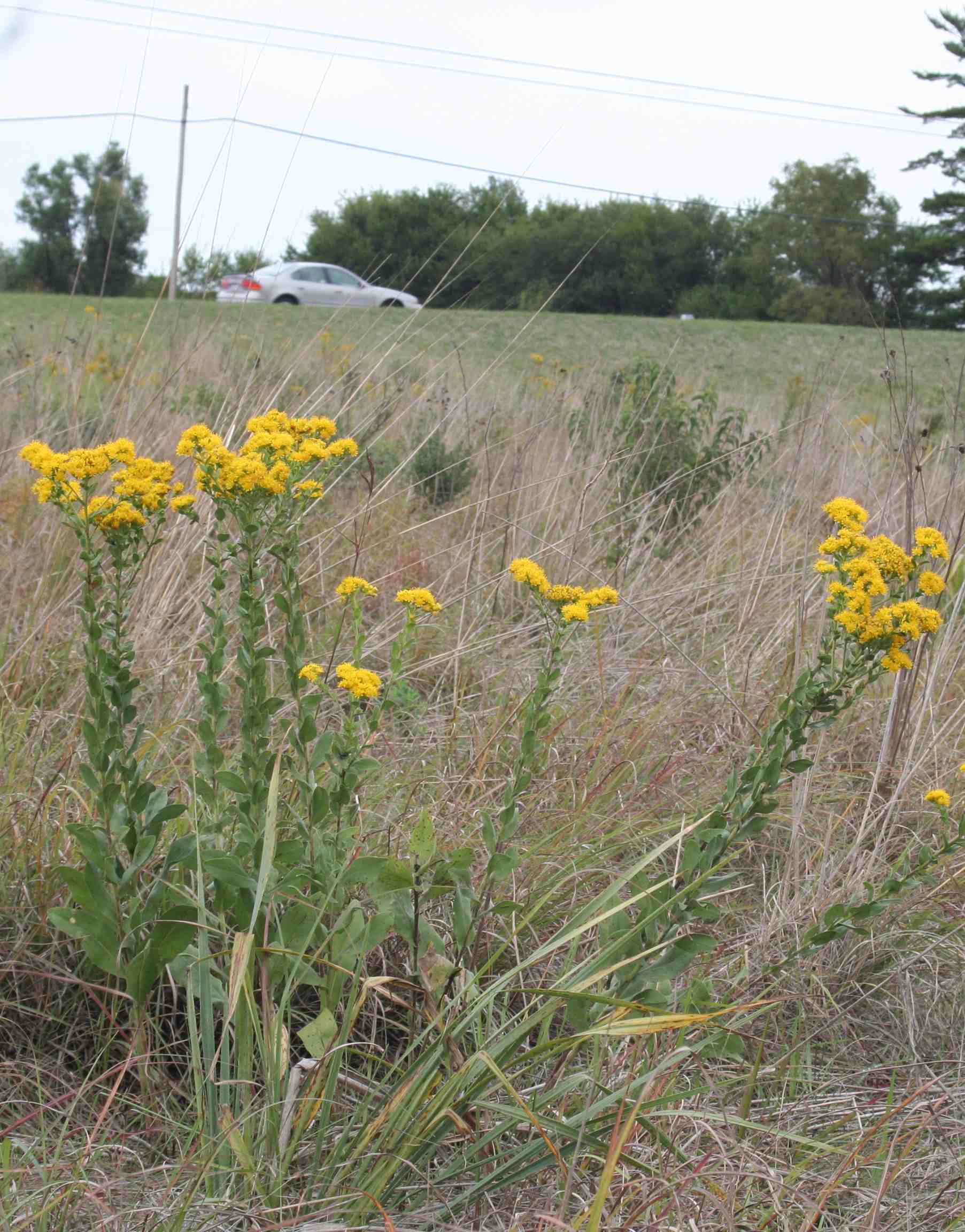
- Leaves and stem
Leaves alternate, lower leaves long-stalked, upper leaves nearly clasping the stem, grayish green with short soft hairs; stem is finely hairy, unbranched.
- Flower, fruit and seedhead
Flower: Yellow flower heads, larger than typical for goldenrods, borne in a branched flat-domed cluster at top of stem.
Fruit/seedhead: Seed heads are fluffy due to a tuft of white pappus on each achene, seeds dispersed by wind.
Pollination: Insects including bees, butterflies, wasps, and beetles.
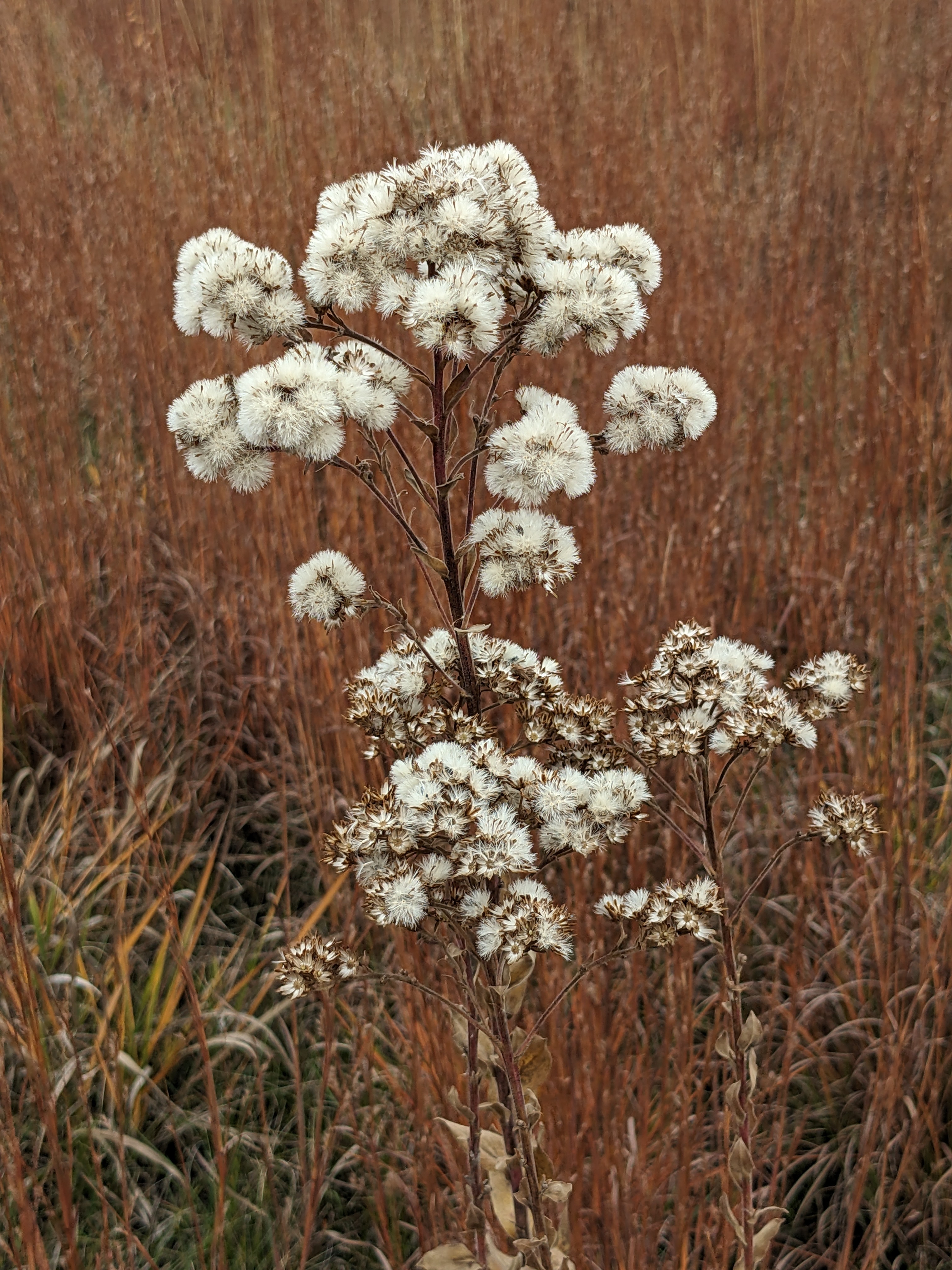
- Seed
Seed characteristics
Seed weight:
Seeds per ounce: 41,000 (IA NRCS)
1000 seed weight: 0.94 g (Seed Information Database)
Description: Seeds are technically achenes, glabrous, bone-white, about 1/16 in long with long white plumes (pappus).
Typical seed test
PLS: 79% (n = 10)
Purity: 96% (n = 10)
Germination: 34% (n = 8)
Dormancy: 45% (n = 8)
(averages obtained from n tests of purchased seed lots)
- Habitat and range
Habitat: Dry-mesic to wet-mesic soil; full sun; prairies, savannas, thickets, limestone glades, roadsides, railroads. Well-drained, loamy soils are preferred for seed production.
Conservation status: Global- G5, secure; District of Columbia- SX, presumably extirpated; Massachusetts- SH, possibly extirpated; Connecticut, Maryland, Pennsylvania, South Carolina, and West Virginia- S1, critically imperiled; New York and Virginia- S2, imperiled; Georgia and Wyoming- S3, vulnerable (NatureServe)
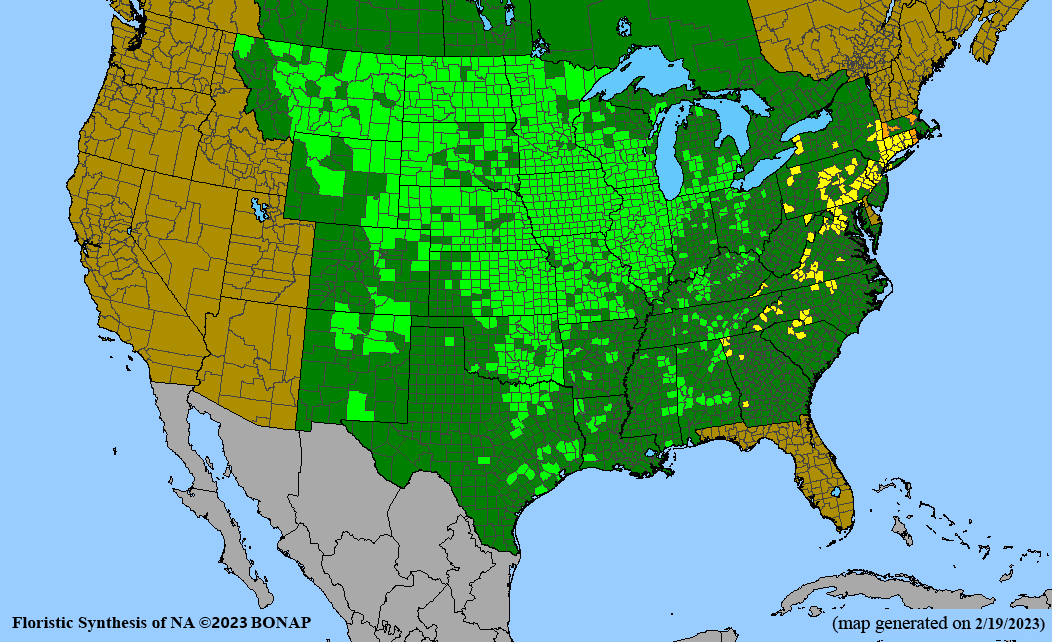
General Comments
Stiff goldenrod establishes readily from direct seed or transplants, and will spread from short rhizomes to form clumps. The flowers of this species are highly attractive to bees and other pollinators, including migrating monarch butterflies. The seeds are eaten by songbirds and gamebirds. Fields of this species can be combined but it is critical to harvest before plumes are dry and fluffy.
Recommendations for Seed Production
- Establishment for seed production
Direct seeding
Row spacing: 30-36 in rows
PLS pounds/acre: 1.0
Seeds per linear foot: 40
Seeding depth: 1/4 in
Seeding method: native seed drill
Seeding time: dormant season
Weed control: Prepare clean, firm, weed free seedbed prior to seeding.
Greenhouse
Seed pre-treatment: Wet stratify 8-12 weeks at 40˚ F.
Sowing: Sow seed in greenhouse two months before last frost free date.
Transplanting: Transplant into bare soil in rows convenient for tillage equipment, or into weed barrier at 8-12 in intervals after all danger of frost is past.
- Stand management
Weeds: Post emergence grass herbicide, tillage, hand roguing. If transplanted into weed barrier or plastic mulch, this provides some weed suppression.
Pests: None noted.
Diseases: Foliage may be affected by rust.
- Seed production
First harvest: Flowering and seed set at end of second growing season from either greenhouse grown transplants or direct seeded, well-managed stand.
Yield: 100-250 bulk pounds/acre
Stand life: Peak harvests in second to fifth growing season. Seed production declines in subsequent years.
Flowering date: mid-August - mid-September in northern Iowa
Seed maturity/Harvest date: October in northern Iowa
Seed retention: Seed is wind dispersed soon after drying of plumes (pappus).
Harvest date range at TPC (2003-2011): Oct 9 - 25
Recommended harvest method: Combine after seed maturity but before more than 10% of the seedheads have turned white and fluffy. Otherwise, combining will simply contribute to dispersal of the seed crop. Harvested material will have to be forced-air dried and turned carefully to prevent mold and decay.
- Seed cleaning and storage
Cleaning process: Pre-clean air-dried material by scalping thru 1/2 in and 1/4 in mesh to remove large particles. Remove plumes (pappus) with a debearder or brush machine, then air-screen.
Seed storage: cool/dry (33-50° F, 30-50% RH)
Released Germplasm
Source Identified material: Natural Selections/Iowa Ecotype Project Zone 1 (Northern Iowa), Zone 2 (Central Iowa),and Zone 3 (Southern Iowa)
- References
Chayka, K. (n.d.). Solidago rigida (stiff goldenrod). Minnesota Wildflowers. https://www.minnesotawildflowers.info/flower/stiff-goldenrod
Cochrane, T. S., Elliot, K., & Lipke, C. S. (2014). Stiff goldenrod. In Prairie plants of the University of Wisconsin-Madison Arboretum (3rd ed., p. 118). University of Wisconsin-Madison Arboretum.
Flora of North America. Solidago rigida Linnaeus. (n.d.). http://www.efloras.org/florataxon.aspx?flora_id=1&taxon_id=242417297 .
Hilty, J. (2019). Stiff goldenrod - Oligoneuron rigidum. Illinois Wildflowers. https://www.illinoiswildflowers.info/prairie/plantx/stf_goldenrodx.htm
Houseal, G. A. (2007). Forbs wildflowers. In G. A. Houseal (Eds.), Tallgrass Prairie Center’s native seed production manual (pp. 42–43). Tallgrass Prairie Center - University of Northern Iowa.
Kartesz, J.T., The Biota of North America Program (BONAP). 2023. North American Plant Atlas. (http://bonap.net/napa). Chapel Hill, N.C. [maps generated from Kartesz, J.T. 2023. Floristic Synthesis of North America, Version 1.0. Biota of North America Program (BONAP). (in press)]
NatureServe. 2024. NatureServe Network Biodiversity Location Data accessed through NatureServe Explorer [web application]. NatureServe, Arlington, Virginia. Available https://explorer.natureserve.org/. (Accessed: February 29, 2024).
Runkel, S. T., & Roosa, D. M. (2009). Stiff goldenrod. In Wildflowers of the tallgrass prairie: The upper Midwest (2nd ed., pp. 242–243). University of Iowa Press.
Semple, J. C., & Cook, R. E. (2020, November 6). Solidago rigida Linnaeus. Flora of North America. http://floranorthamerica.org/Solidago_rigida
USDA NRCS National Plant Data Team. (n.d.). Oligoneurin rigidum (L.) Small. USDA plants database. https://plants.usda.gov/home/plantProfile?symbol=OLRI
Species Guide Updated 12/4/2024
swamp lousewort
swamp lousewort dickeye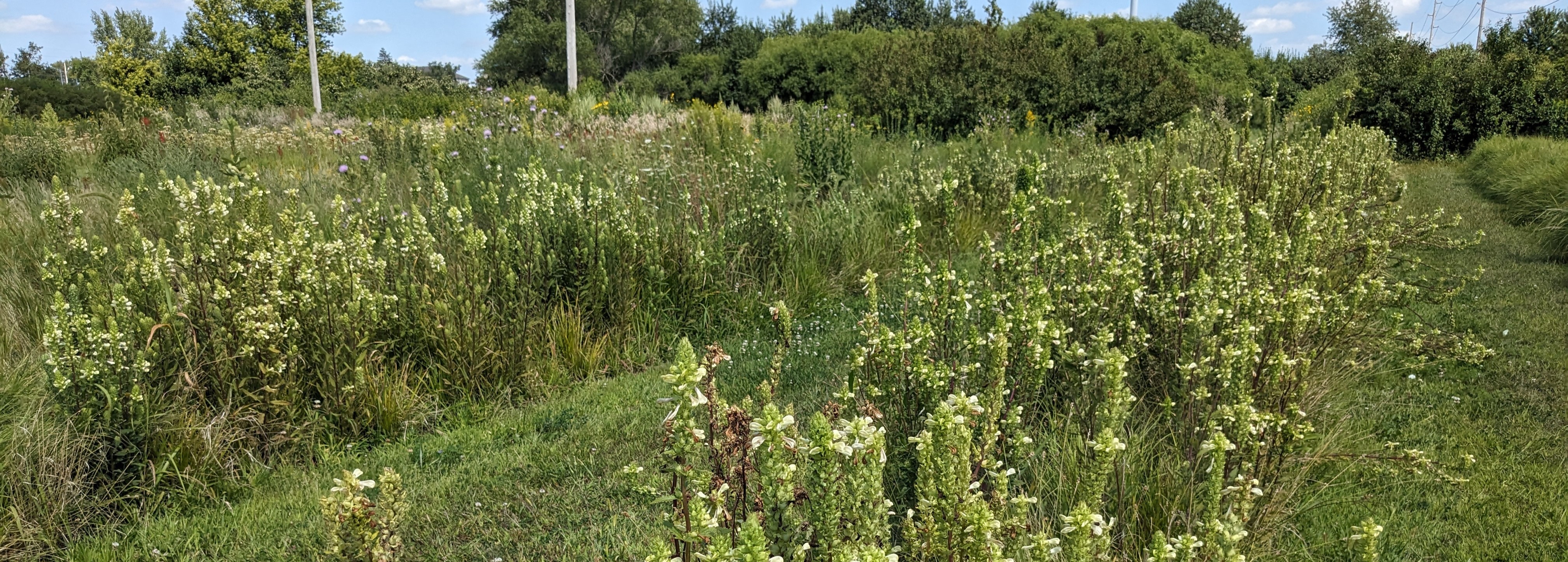
Pedicularis lanceolata Michx.
Alternate Common Name: swamp betony
Scientific Synonyms: Pedicularis auriculata Sm., Pedicularis pallida Nutt., Pedicularis virginica Poir.
Family: broomrape family (Orobanchaceae)
Functional Group: forbs (wildflowers), hemiparasites
Description
- Life cycle and growth form
Fibrous-rooted perennial, hemiparasitic, connects to the root systems of neighboring plants through structures called haustoria to obtain mineral nutrients.
Height: 1 - 3 ft
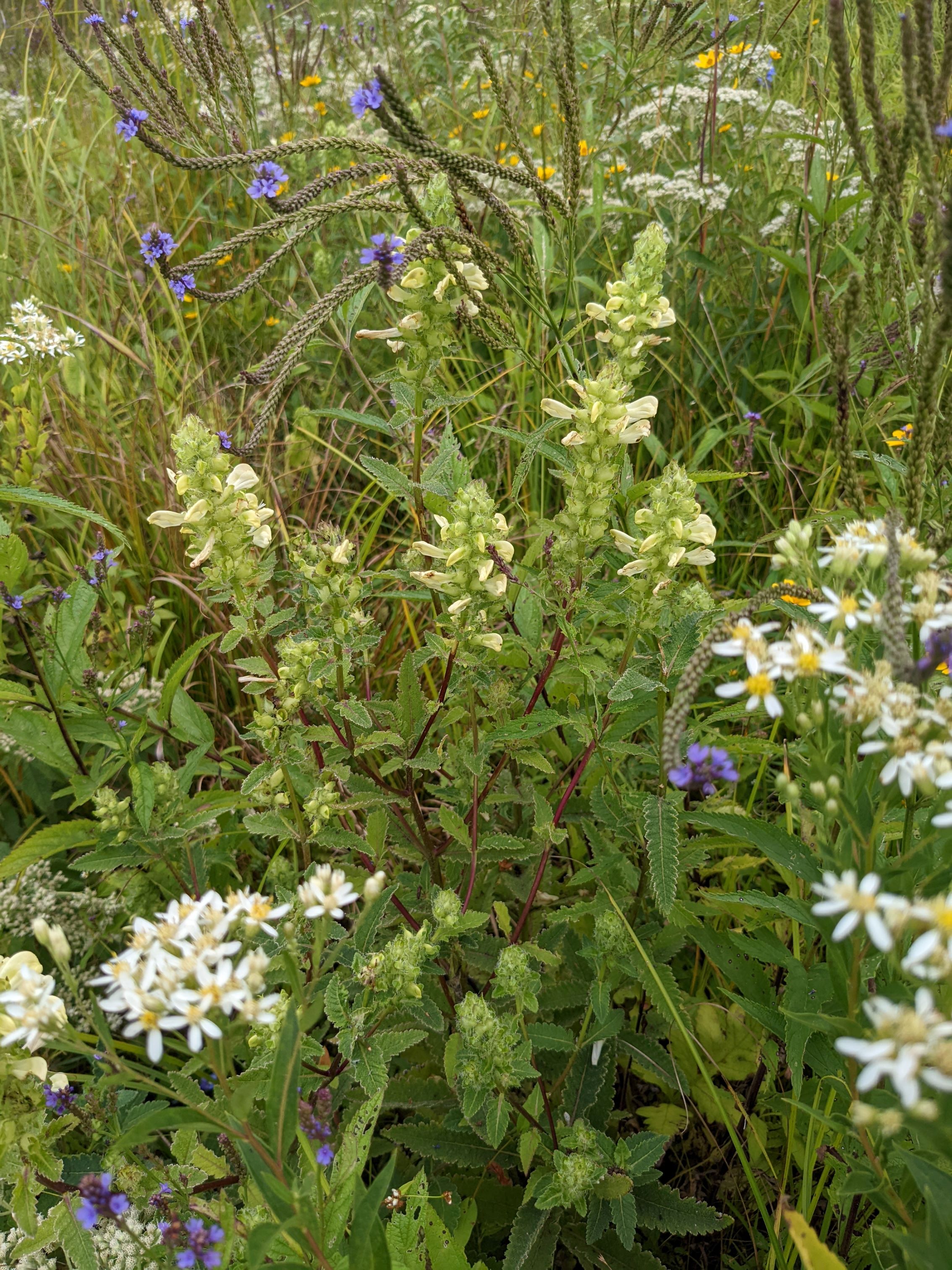
- Leaves and stem
Leaves up to 4 in long with coarsely textured surface, “fernlike” margins, opposite arrangement; sturdy stems are short-hairy to hairless and sparingly branched.
- Flower, fruit and seedhead
Flower: Cream colored flowers, about 1 in long, tubular and 2-lipped, with top lip that overhangs and curves over lower lip; arranged in dense spikes up to 4 in long.
Fruit/seedhead: A many-seeded capsule that splits open at maturity to release seeds.
Pollination: Primarily bumblebees; the flowers are twisted, and only larger-bodied bees that can learn to open the flowers are capable of accessing the pollen.
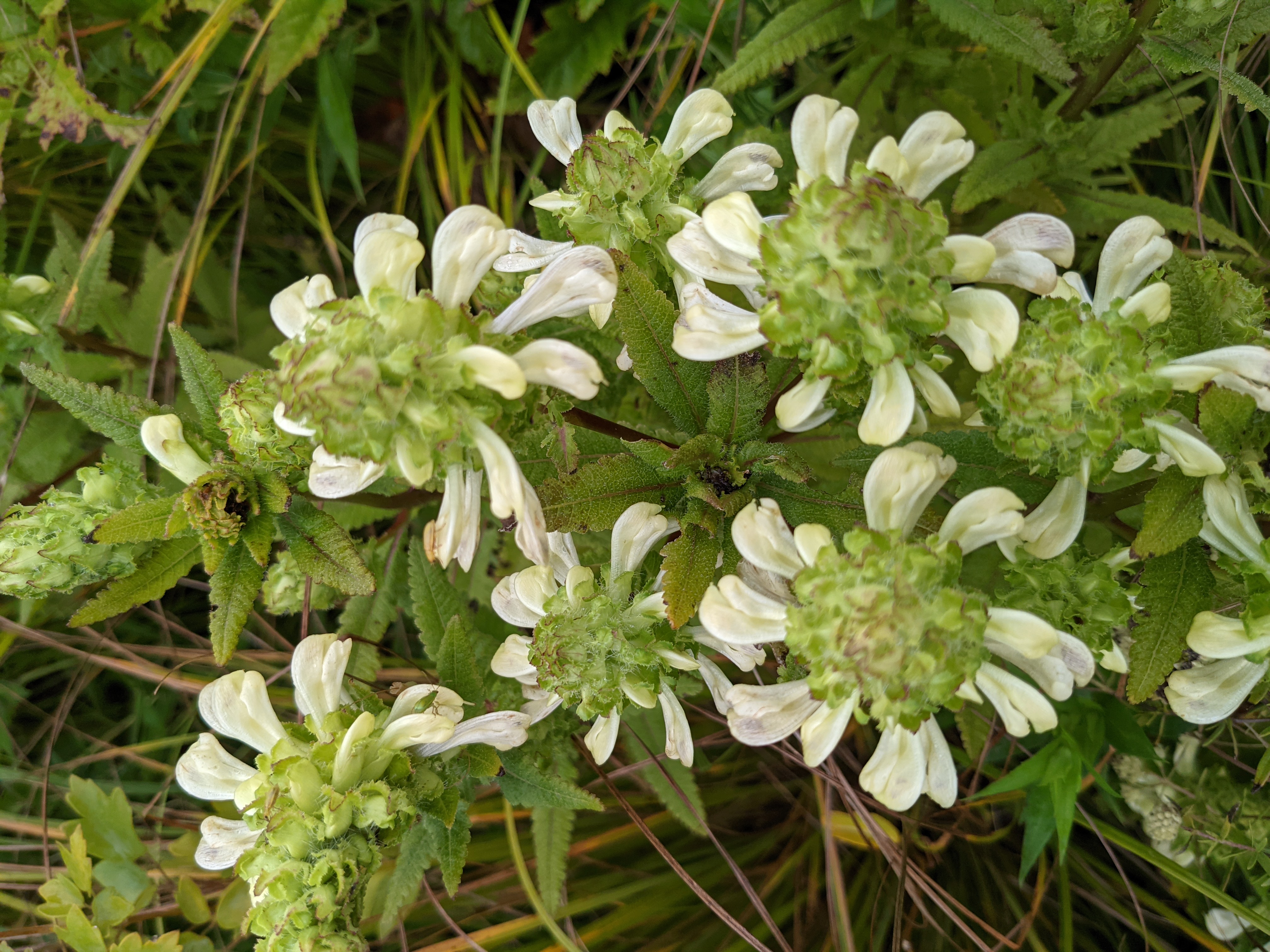
- Seed
Seed characteristics
Seeds per ounce: 44,000 (IA NRCS)
1000 seed weight: 0.57 g (measured at TPC using seed harvested from plots)
Description: Wrinkled, oval, brown seeds are winged along one side, approx. 1.5 by 2.5 mm with the wing; the shape is reminiscent of Chinese dumplings (pot stickers)
Typical seed test
PLS: 87.5%
Purity: 94.3%
Germination: 2%
Dormant: 90.8%
(averages obtained from 6 tests)
- Habitat and range
Habitat: Moist to wet soil; partial to full sun; wet sand prairies, fens, swamps, sandy ditches, shorelines; Wetland Indicator Status is Obligate Wetland (OBL) for the Midwest.
Conservation status: Global- G5, secure; Kentucky- SX, presumably extirpated; Delaware- SH, possibly extirpated; Arkansas, Georgia, Maryland, Massachusetts, and North Carolina- S1, critically imperiled; Pennsylvania and Tennessee- S1/S2, critically imperiled to imperiled; Connecticut and West Virginia- S2, imperiled; New York- S2/S3, imperiled to vulnerable; Nebraska, New Jersey, and Virginia- S3, vulnerable (NatureServe)
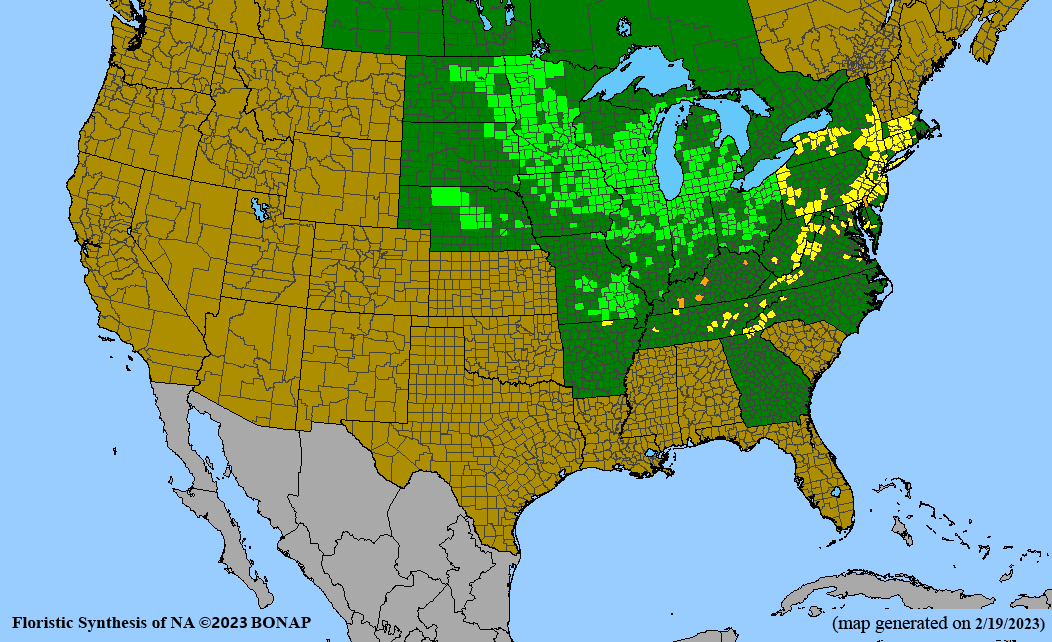
General Comments
Swamp lousewort is a hemiparasitic plant. This species is capable of photosynthesis but taps into the root systems of neighboring plants to obtain some of the mineral nutrients it needs for growth. Hemiparasitic plants may reduce the competitive dominance of their hosts, thereby promoting greater diversity in their plant communities. Swamp lousewort likely uses sedges, grasses, and composites as hosts in its wetland or wet prairie habitats. To establish plugs for seed production, we seeded stratified seed of swamp lousewort into plugs of two sedge species that could co-occur with it in nature. The seedlings transplanted well into irrigated production rows and produced abundant seed in the second year. The flowers are visited by worker bumble bees that can learn to twist open the flowers to access the pollen.
Recommendations for Seed Production
- Establishment for seed production
Direct seeding
Not recommended for this species.
Greenhouse
Seed pre-treatment: Benefits from 60-day cold/moist stratification. Check seed frequently in later weeks of stratification period as some seeds may germinate in the cold.
Sowing: Start sedge host plants about one month before the lousewort stratification period is over. Sow two-three lousewort seeds into a shallow slit or divot made near the base of a host sedge in a plug. For this species we used trays of 50-cell plugs that are 4 in deep. As sedge host plants grow, trim them as often as necessary to keep light available to the lousewort seedlings. We found that trimming was needed more often with Carex bebbii hosts than with C. hystericina.
Transplanting: Transplant into prepared plasticulture beds with drip tape irrigation after danger of frost is past and plugs are sturdy with well-developed root systems. Move trays outside to “harden off” a week or more before transplanting.
- Stand management
Weeds: Plastic mulch suppresses weeds in the planting year, and dense growth of host sedges is competitive with many weeds. We mow between rows to further suppress weeds. Small seeded weeds such as amaranth and lambsquarters would be a concern for seed cleaning.
Pests: None noted.
Diseases: None noted.
Soil moisture: Irrigation is recommended. Drip tape can be installed at the same time the plastic mulch is laid.
- Seed production
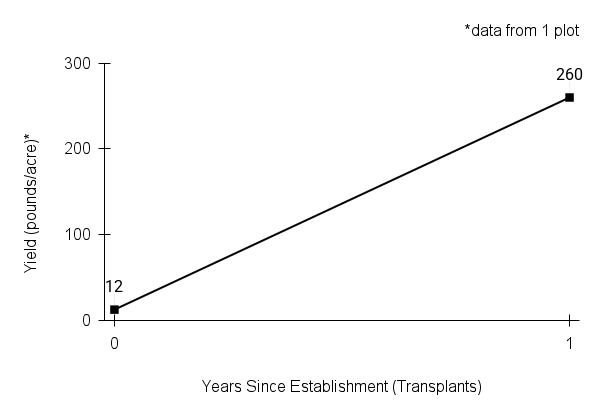
First harvest: A few plants flower and set seed in the planting year, but the first sizable harvest is in the year after transplanting.
Yield/acre: 260 lbs/acre (extrapolated from yield of one TPC production plot in the year after transplanting)
Stand life: Unknown at this time.
Flowering date: August - September in northeast Iowa
Seed maturity/Harvest date: mid-September to mid-October
Seed retention: Some seed is lost from open capsules, especially in high wind.
Harvest date range at TPC (2023-2024): September 7 - October 26
Recommended harvest method: We harvested the stems as the capsules matured, dried them, and passed them through the stationary combine. Combining in the field should also be effective, though some shattering may occur once capsules open.
- Seed cleaning and storage
Cleaning process: Seed that has been threshed through a combine may be passed through a coarse screen (1/4 in mesh) to remove remaining stemmy material, then airscreened. Hand collected material may need to be run through a brush machine to break up capsules and release seed.
Seed storage: cool/dry (33-50° F, 30-50% RH)
Released Germplasm
Source Identified material: Natural Selections/Iowa Ecotype Zone NI
Collection locations used in generating this ecotype are shown in the map below, overlaid on the Generalized Provisional Seed Transfer Zones of the US Forest Service.
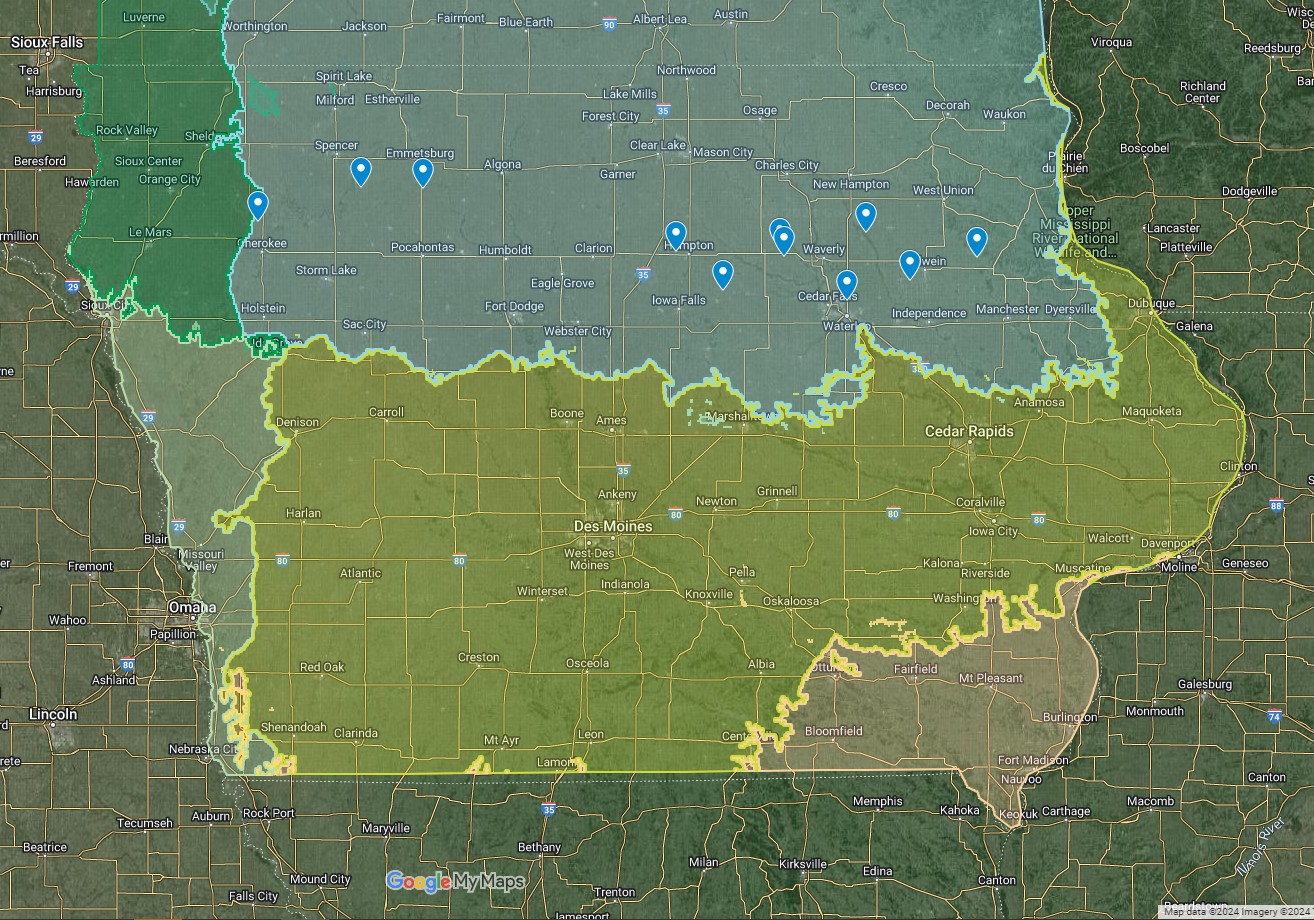
- References
Chayka, K. (n.d.). Pedicularis lanceolata (swamp lousewort). Minnesota Wildflowers. https://www.minnesotawildflowers.info/flower/swamp-lousewort
Dahlberg, L. (2022, February 3). Propagating Swamp Betony by Luke Dahlberg. Grassland Restoration Network. https://grasslandrestorationnetwork.org/2022/02/03/propagating-swamp-betony-by-luke-dahlberg/
Hilty, J. (2019). Swamp lousewort - Pedicularis lanceolata. Illinois Wildflowers. https://www.illinoiswildflowers.info/wetland/plants/sw_lousewort.htm
Kartesz, J.T., The Biota of North America Program (BONAP). 2023. North American Plant Atlas. (http://bonap.net/napa). Chapel Hill, N.C. [maps generated from Kartesz, J.T. 2023. Floristic Synthesis of North America, Version 1.0. Biota of North America Program (BONAP). (in press)]
NatureServe. 2024. NatureServe Network Biodiversity Location Data accessed through NatureServe Explorer [web application]. NatureServe, Arlington, Virginia. Available https://explorer.natureserve.org/. (Accessed: February 29, 2024).
USDA-NRCS. (2022). Conservation cover native seeding calculator [Excel File]. Retrieved from https://bit.ly/IA_OTH_Conservation_Cover-Native_Seeding_Calculator_2022
USDA NRCS National Plant Data Team. (n.d.). Pedicularis lanceolata Michx. USDA plants database. https://plants.usda.gov/home/plantProfile?symbol=PELA2
Species Guide Updated 2/14/2025
swamp milkweed
swamp milkweed sagem
Asclepias incarnata L.
Alternate Common Names: rose milkweed, silkweed, water nerve root, white Indian hemp, swamp silkweed
Family: dogbane family (Apocynaceae), formerly assigned to the milkweed family (Asclepiadaceae)
Functional Group: forbs (wildflowers)
Description
- Life cycle and growth form
Perennial, weakly rhizomatous, forming small clones of several stems; root systems are more fibrous than other commonly cultivated milkweeds such as butterfly milkweed (e.g., A. tuberosa).
Height: 2-5 ft

- Leaves and stem

Leaves 3-6 in long, usually narrowly lanceolate with smooth, untoothed edges and sessile on the stem or short-stalked, opposite arrangement; stems mostly hairless, usually unbranched (occasionally branched above).
- Flower, fruit and seedhead
Flower: Numerous, various shades of rose-pink with a pronounced fragrance similar to bubblegum, in domed clusters 2-3 in across; individual flowers five-parted, radially symmetrical, with a crown of five tubular hoods surrounding a central column, petals and sepals curved downward (typical milkweed flowers).
Fruit/seedhead: Pods (follicles) are 2-4 in long, smooth/waxy, and teardrop-shaped; follicles open along one side at maturity, revealing many shiny brown seeds each of which bears a flattened wing and a plume of soft, white floss.
Pollination: Pollination: Insects, particularly butterflies and bees.

- Seed
Seed characteristics
Seeds per ounce: 4,800 (IA NRCS)
1000 seed weight: 3.65 g (Seed Information Database)
Description: Dark brown, oval, surrounded by flattened ‘wing’ and tuft of soft hairs.
Typical seed test
PLS: 89% (n = 11)
Purity: 98% (n = 11)
Germination: 7% (n = 7)
Dormant: 58% (n = 7)
(averages obtained from n tests of purchased seed lots)
- Habitat and range
Habitat: Moist to wet, neutral to slightly acidic soil; partial to full sun open floodplains, lakeshores, ditches, wet prairies. Wetland Indicator Status is Obligate Wetland (OBL) for the Midwest. Benefits from irrigation in production systems.
Conservation status: Global- G5, secure; Arizona, Mississippi, Montana, and Nevada- S1, critically imperiled; Arkansas, Idaho, and Louisiana- S2, imperiled; Wyoming- S2/S3 imperiled to vulnerable; Georgia- S3, vulnerable (NatureServe)
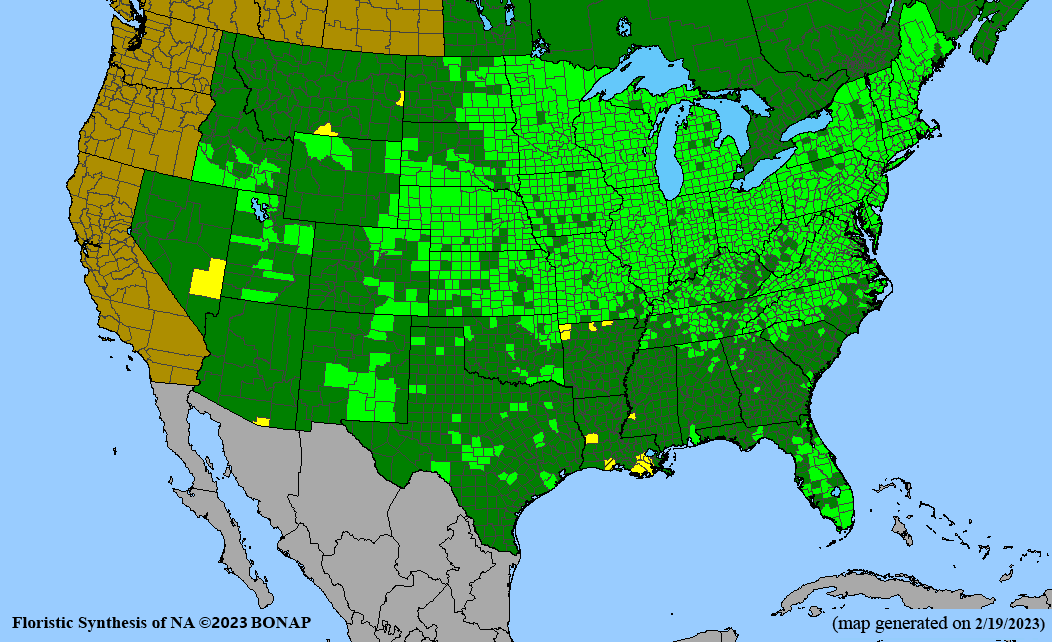
General Comments
Swamp milkweed is a valuable addition to pollinator habitat plantings on wetter soils and a showy, mannerly milkweed for home landscaping. This species is an important host for caterpillars of the monarch butterfly which feed upon its leaves. The fragrant flowers attract and provide nectar for numerous pollinators including various species of butterflies, bees, wasps, and flies. The strong, silky stem fibers are used as nesting material by songbirds and have traditionally been used for spinning and weaving by Native peoples, giving rise to some of the alternate common names such as silkweed and white Indian hemp. Establishment from plugs is rapid, and seed can be harvested the first fall, but production stands are short-lived (2-3 years).
Recommendations for Seed Production
- Establishment for seed production
Direct seeding
We do not have experience with direct seeding this species for seed production.
Greenhouse
Seed pre-treatment: To break dormancy, use 30-60 days cold stratification (check frequently for early germination) or a 24-hour soak in 250 ppm gibberellic acid (GA-3).
Sowing: Seed directly into plugs (2-3 seeds per cell) or on germination flat and lightly cover with potting mix, or germinate between sheets of moistened paper toweling and move to individual plugs as radicles (seed roots) emerge from seeds; start seeds 8-10 weeks before the average frost-free date.
Transplanting: Move plug flats outdoors 1-2 weeks before transplanting to allow seedlings to adjust to ambient conditions; plant with 1 ft spacing in plastic mulch with drip irrigation.
- Stand management
Weeds: Field preparation through repeated tillage and application of plastic mulch reduces weed issues; hand harvesting of pods as they mature results in very pure seed.
Pests: Non-native oleander aphids (Aphis nerii) can form dense infestations, reducing plant vigor and causing abortion of flowers or pods or, in extreme cases, death of the plant. Scout for these golden yellow aphids when plants are in bud, as it is easier to control small aphid infestations. Aphid predators (e.g., ladybug larvae, hoverfly larvae, and lacewing larvae) and aphid mummy wasps help reduce damage. Use the least toxic treatment possible (e.g., horticultural oils or insecticidal soaps) to avoid harming aphid enemies and pollinators, as aphids often occur at the time plants are in flower. Native seed-feeding milkweed bug species (Oncopeltus fasciatus and Lygaeus kalmii) pierce pods and feed on seeds. Manually remove clusters of red-orange milkweed bug nymphs from pods. A small proportion of pods is ruined by larvae of native milkweed stem weevils (Rhyssomatus lineaticollis or R. annectans). These appear as grubs or pupae inside the cluster of seeds. Affected pods have a small entry hole on the side and often mature prematurely. Earlier in the growing season, red milkweed longhorn beetles (Tetraopes spp.) feed on the tips of milkweed leaves. Their larvae feed within milkweed roots and rhizomes and may weaken plants over time. Monarch butterflies (Danaus plexippus) are attracted to lay eggs on swamp milkweed. In smaller-scale production systems, caterpillars can be hand-picked from production rows and transferred to nearby wild milkweeds before applying treatments for problem insects.
Diseases: Milkweeds are susceptible to a variety of fungal, bacterial, and viral diseases. Cultural methods such as reducing stand size or density, intercropping, and crop rotations may reduce disease spread and severity.
Hybridization risk: This species is known to hybridize with related species Asclepias hirtella, A. purpurascens, A. sullivantii, A, syriaca, A. tuberose, A. verticillata.
Soil moisture: Plant in naturally wet soils and/or supply irrigation, especially in dry weather.
Note: Refer to Milkweeds: A Conservation Practitioner’s Guide, published by the Xerces Society, for more detailed information on milkweed insects and diseases and their control.
- Seed production
 First harvest: Fall of planting year, when started from transplanted plugs.
First harvest: Fall of planting year, when started from transplanted plugs.Yield: 200-300 pounds/acre, with largest harvest in the first year (based on 4 plots)
Stand life: Two years from transplanting. Plants are reported to be longer lived in natural populations.
Flowering date: July in northern Iowa
Seed maturity/Harvest date: Early September - mid-October in northern Iowa
Seed retention: Seed is released as individual pods ripen and split open in early September through the beginning of October.
Harvest date range at TPC (2009-2020): Aug 31 - Oct 17
Recommended harvest method: Harvest by hand as pods (follicles) mature; collect pods that are changing color from green to yellowish and split when subjected to gentle pressure on the suture (seam), revealing dark brown seeds.
- Seed cleaning and storage
Cleaning process: Dry pods in cloth bags for two weeks with fan-forced air. Pass pods through a debearder or stationary combine to release seeds and detach fluff. Follow up by fan winnowing (outside on a relatively calm day) to remove most of the fluff. Air-screen the remaining material. Indent cylinder removes broken bits of pods and stems from seed.
Seed storage: cool/dry (33-50° F, 30-50% RH)
Released Germplasm
Source identified material: Natural Selections/Iowa Ecotype Zones 1, 2, IA
Cultivated variety (cultivar): ‘Ice Ballet,’ ‘Cinderella,’ and ‘Milkmaid’
- References
Borders, B. and E. Lee-Mäder. 2014. Milkweeds: A Conservation Practitioner’s Guide. 143 pp. Portland, OR. The Xerces Society for Invertebrate Conservation. https://www.xerces.org/sites/default/files/2018-05/17-031_02_XercesSoc_Milkweeds-Conservation-Guide_web.pdf
Chayka, K. (2010). Asclepias incarnata (swamp milkweed). Minnesota Wildflowers. https://www.minnesotawildflowers.info/flower/swamp-milkweed
Cochrane, T. S., Elliot, K., & Lipke, C. S. (2014). Swamp milkweed. In Prairie plants of the University of Wisconsin, Madison Arboretum (3rd ed., p. 55). University of Wisconsin-Madison Arboretum.
Hilty, J. (2020). Swamp milkweed - Asclepias incarnata. Illinois Wildflowers. https://www.illinoiswildflowers.info/wetland/plants/sw_milkweed.htm
Kartesz, J.T., The Biota of North America Program (BONAP). 2023. North American Plant Atlas. (http://bonap.net/napa). Chapel Hill, N.C. [maps generated from Kartesz, J.T. 2023. Floristic Synthesis of North America, Version 1.0. Biota of North America Program (BONAP). (in press)]
Kirk, S. and Belt, S. (2011). Plant fact sheet for swamp milkweed (Asclepias incarnata). USDA-Natural Resources Conservation Service, Norman A. Berg National Plant Materials Center. Beltsville, MD 20705. https://plants.usda.gov/DocumentLibrary/factsheet/pdf/fs_asin.pdf
Native Plant Trust (2024). Asclepias incarnata. https://plantfinder.nativeplanttrust.org/plant/Asclepias-incarnata
NatureServe. 2024. NatureServe Network Biodiversity Location Data accessed through NatureServe Explorer [web application]. NatureServe, Arlington, Virginia. Available https://explorer.natureserve.org/. (Accessed: February 28, 2024).
Runkel, S. T., & Roosa, D. M. (2009). Swamp milkweed. In Wildflowers of the tallgrass prairie: The upper Midwest (Second, p. 179). University of Iowa Press.
Schultz, Jan; Beyer, Patty; Williams, Julie. (2001). Propagation protocol for production of Container (plug) Asclepias incarnata L. plants USDA FS - Hiawatha National Forest Marquette, Michigan. In: Native Plant Network. US Department of Agriculture, Forest Service, National Center for Reforestation, Nurseries, and Genetic Resources. https://NativePlantNetwork.org (accessed 2024/01/09).
Society for Ecological Restoration and Royal Botanic Gardens Kew. (2024). Asclepias incarnata L. SWAMP MILKWEED. Seed Information Database. https://ser-sid.org/species/62fbef4e-ed33-4c71-a18f-f78f9018fda7
University of Wisconsin. (2024). Common milkweed insects. Wisconsin Horticulture, Division of Extension. https://hort.extension.wisc.edu/articles/common-milkweed-insects/
Species Guide Updated 12/19/2024
swamp verbena
swamp verbena sagem
Verbena hastata L.
Alternate Common Names: blue vervain, simpler’s joy, American blue vervain, American simpler’s joy, wild hyssop
Family: verbena family (Verbenaceae)
Functional Group: forbs (wildflowers)
Description
- Life cycle and growth form
Perennial, short-rhizomatous.
Height: 2-6 ft

- Leaves and stem

Leaves are opposite, lance-shaped (up to 6 in long and 1 in wide), coarsely toothed, strongly veined above, and usually short-hairy beneath; stems square, grooved, and green to purple, with flattened hairs, often branched in the upper half of the plant.
- Flower, fruit and seedhead
Flower: Individual flowers are blue-purple, 1/4 in across, with five expanded lobes (petals) attached to a short tube; flowers are arranged in a branched “candelabra” (panicle) of spikes; spikes elongate through the flowering season as new flowers emerge in whorls (rings) near the tops while seeds (nutlets) mature near their bases.
Fruit/seedhead: Each calyx of fused sepals contains four developing seeds (nutlets); spikes ripen from the bottom up.
Pollination: Insects, particularly bees.

- Seed
Seed characteristics
Seeds per ounce: 93,000 (IA NRCS)
1000 seed weight: 0.23 g (Seed Information Database)
Description: Seed unit is technically a type of dry fruit called a nutlet. Rust-brown nutlets are 2 mm long and approximately 0.5 mm wide.
Typical seed test
PLS: 97%
Purity: 100%
Germination: 13%
Dormant: 84%
(averages obtained from 5 tests of purchased seed lots)
- Habitat and range
Habitat: Swamp verbena grows best in full sun and moist to wet, organic-rich soils. Plants are typically found in wet places such as wet prairies, sedge meadows, fens, and ditches. Wetland Indicator Status is Facultative Wetland (FACW) for the Midwest. Production fields benefit from irrigation.
Conservation status: Global- G5, secure; North Carolina- S2/S3, imperiled to vulnerable; Wyoming- S3, vulnerable (NatureServe)

General Comments
Swamp verbena is well suited for planting in moist soils or seasonally wet sites such as roadside ditches. It grows quickly and flowers in the planting year, producing abundant seed that is relatively easy to harvest and clean. Most mammalian herbivores avoid the bitter foliage, hence this species has persisted even in heavily grazed, wet prairie pastures. Swamp verbena has a long flowering period and is visited by diverse species of bees and small butterflies. The seeds are eaten by native sparrows and juncos. Swamp verbena has numerous uses in traditional Native medicine, including as a treatment for digestive and obstetric complaints. Caution: Extracts of this species are known to interfere with prescription medication and can cause vomiting and diarrhea in high doses.
Recommendations for Seed Production
- Establishment for seed production
Direct seeding
We do not have experience direct seeding this species for seed production.
Greenhouse
Seed pre-treatment: Cold/moist stratification is recommended. Different sources suggest a minimum of 30 days (RNGR) up to 3 months (NRCS Plant Guide). Most northern Iowa accessions showed high rates of germination after 30 day stratification, but a few accessions appeared to have a higher degree of dormancy. In these cases, we saw a second flush of germination after a week of very high temperatures in the greenhouse, more than 2 months after sowing.
Sowing: Sow seed on surface of germination mix (light needed for germination).
Transplanting: Seedlings grow rapidly with fibrous root systems that form firm plugs for transplanting. Plan on sowing seed in greenhouse containers 8-10 weeks before transplanting. If seedlings grow too tall in plug trays, they should be pinched back to adjust the shoot:root ratio.
- Stand management
Weeds: Plastic mulch prevents weed competition in the first year, and tall fast-growing verbena plants are fairly competitive. Holes in the plastic may need to be widened to accommodate rhizomatous spread in the second and subsequent years. Focus weeding or roguing efforts on weeds that could contaminate the seed (i.e., species with small, elongated seed).
Pests: None noted. Bitter foliage deters mammalian herbivores.
Diseases: None noted, though plants appear to be short-lived (2-4 years) in production rows.
Hybridization risk: Maintain separation between fields of swamp verbena and other species in the genus Verbena (e.g., hoary vervain, Verbena stricta) as hybrids readily form.
Soil moisture: Irrigation is recommended.
- Seed production
 First harvest: In planting year, when grown from transplants.
First harvest: In planting year, when grown from transplants.Yield: 440-610 pounds/acre (based on 2 plots)
Stand life: Estimated 3-4 years, with peak harvest in year one.
Flowering date: late June - September
Seed maturity/Harvest date: mid-September - mid-October
Seed retention: Shattering begins as seedheads turn from purple to brown in mid-September through mid-October.
Harvest date range at TPC (2021-2023): Sept 16 - Oct 19
Recommended harvest method: Seed heads turn from green to purple to brown as they mature. Harvest when all, or nearly all, parts of the spikes have turned brown. Some seeds will shatter from lower parts of spikes as the seeds in the upper parts mature, but most seed is retained on the plant. Hand harvest early maturing individuals to preserve genetic diversity, then combine the rest of the plot at peak maturity.
- Seed cleaning and storage
Cleaning process
Hand-collected material: Dry on tarp or in a cloth bag for 2 weeks. Thresh by passing through a stationary combine or by stomping/beating material on the tarp or in a plastic tub. Pass through a ¼ in and ⅛ in mesh to remove sticks before airscreening.
Combined material: Hand-collected material: Dry on tarp or in a cloth bag for 2 weeks. Thresh by passing through a stationary combine or by stomping/beating material on the tarp or in a plastic tub. Pass through a 1/4 in and 1/8 in mesh to remove sticks before airscreening.
Note: Airscreening one-two times results in a very pure product.
Seed storage
cool/dry (33-50° F, 30-50% RH)
Released Germplasm
Source Identified material: Natural Selections/Iowa Ecotype Zone NI

- References
Chayka, K. (n.d.). Verbena hastata (blue vervain). Minnesota Wildflowers. https://www.minnesotawildflowers.info/flower/blue-vervain
Hilty, J. (2019). Blue vervain - Verbena hastata. Illinois Wildflowers. https://www.illinoiswildflowers.info/wetland/plants/bl_vervain.htm
Kartesz, J.T., The Biota of North America Program (BONAP). 2023. North American Plant Atlas. (http://bonap.net/napa). Chapel Hill, N.C. [maps generated from Kartesz, J.T. 2023. Floristic Synthesis of North America, Version 1.0. Biota of North America Program (BONAP). (in press)]
Kirk, S. and S.Belt. (2010). Plant fact sheet for blue vervain (Verbena hastata). USDA-Natural Resources Conservation Service, Norman A. Berg National Plant Materials Center. Beltsville, MD 20705.
Moerman, D. (2003). Native American ethnobotany database. BRIT. http://naeb.brit.org/
NatureServe. 2024. NatureServe Network Biodiversity Location Data accessed through NatureServe Explorer [web application]. NatureServe, Arlington, Virginia. Available https://explorer.natureserve.org/. (Accessed: February 28, 2024).
North Carolina State Extension (n.d.) Verbena hastata. North Carolina Extension Gardener Plant Toolbox. https://plants.ces.ncsu.edu/plants/verbena-hastata/
Society for Ecological Restoration, International Network for Seed Based Restoration and Royal Botanic Gardens Kew. (2023) Seed Information Database (SID). Available from: https://ser-sid.org/ (February 2023)
USDA-NRCS. (2022). Conservation cover native seeding calculator [Excel File]. Retrieved from https://bit.ly/IA_OTH_Conservation_Cover-Native_Seeding_Calculator_2022
USDA NRCS National Plant Data Team. (n.d.). Verbena hastata L. USDA plants database. https://plants.usda.gov/plant-profile/VEHA2
Species Guide Updated 12/18/2024
tall blazing star
tall blazing star dickeye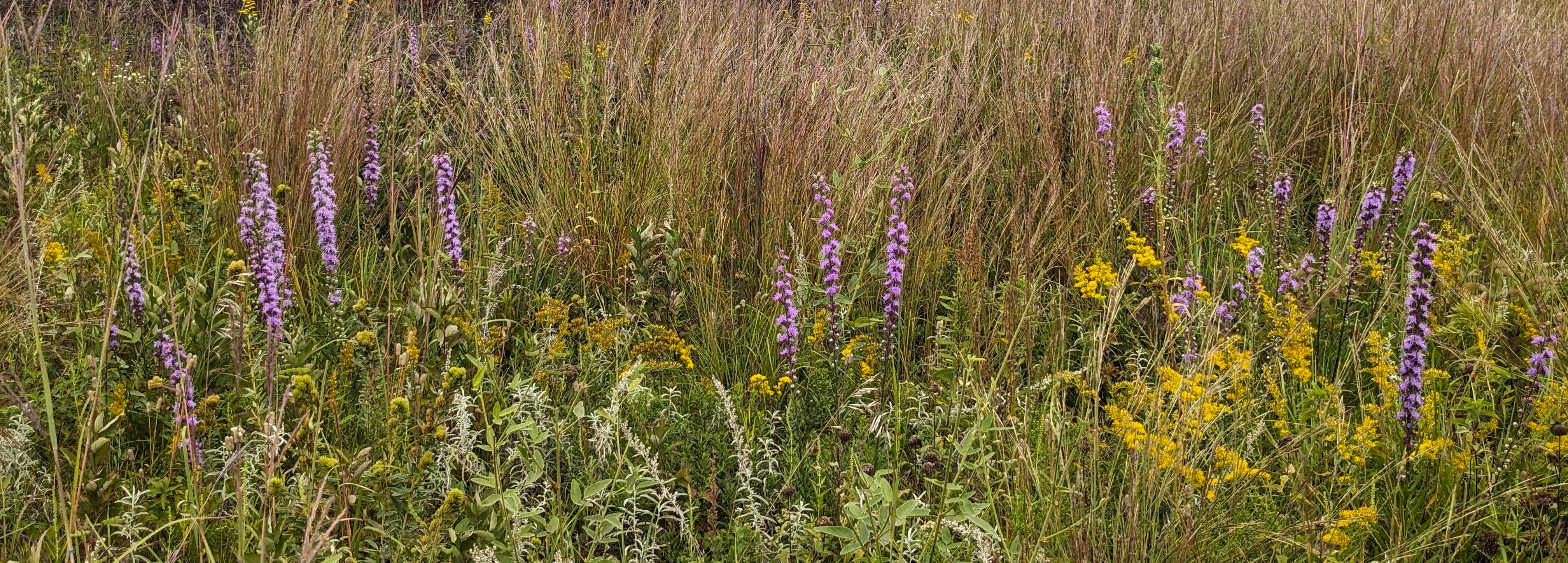
Liatris aspera Michx.
Alternate Common Names: rough blazing star, rough blazingstar, rough blazing-star, tall gay-feather, gayfeather, button snakeroot, rough gayfeather
Scientific Synonyms: Lacinaria scariosa var. intermedia Lunell, Liatris aspera var. intermedia (Lunell) Gaiser, Liatris aspera var. salutans (Lunell) Shinners, Liatris spheroidea var. salutans (Lunell) Shinners
Family: aster family (Asteraceae)
Functional Group: forbs (wildflowers)
Description
- Life cycle and growth form
Perennial with a woody corm that can be divided.
Height: 1-4 ft
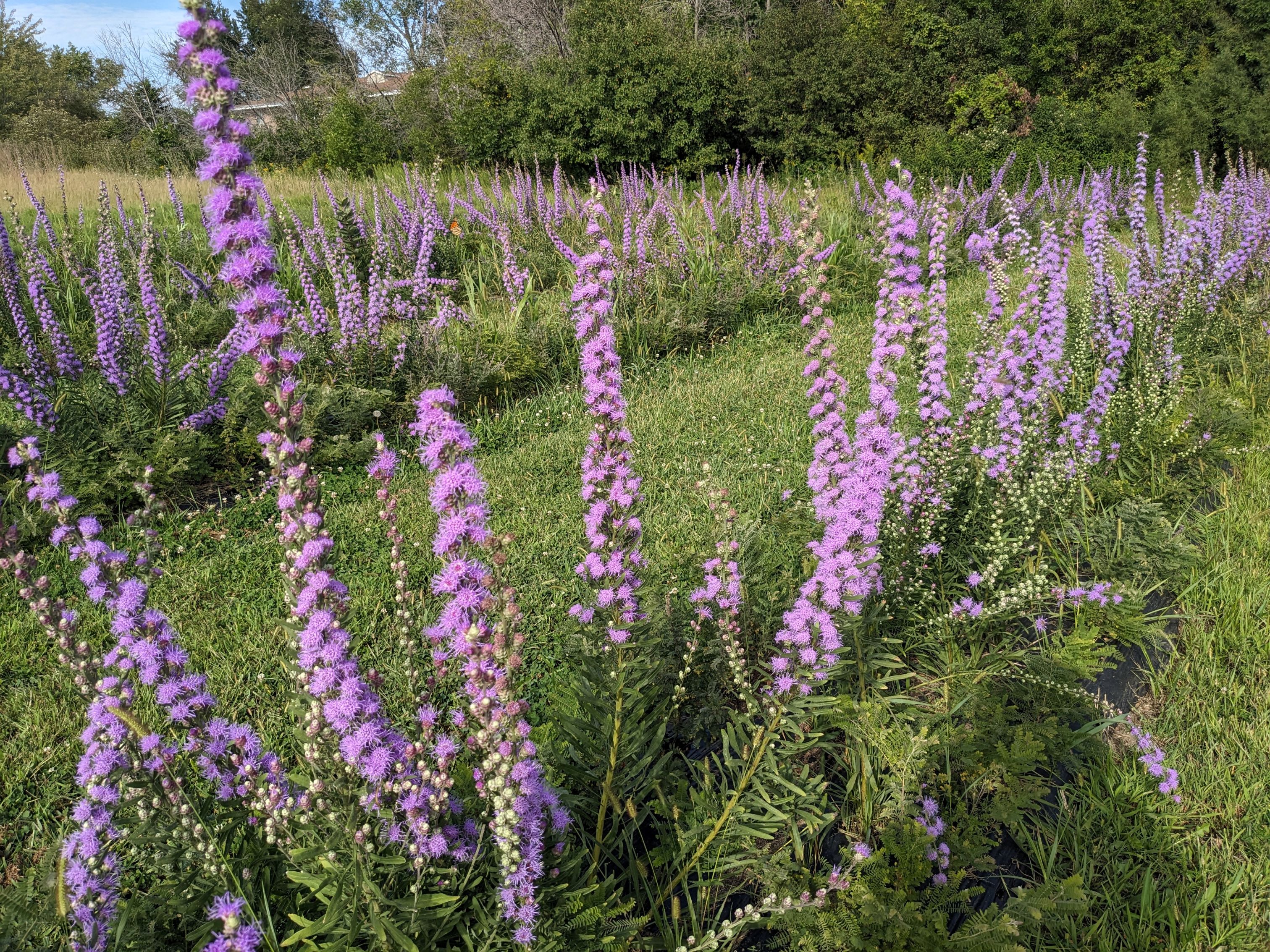
- Leaves and stem
Leaves narrowly lanceolate, alternate, with a prominent central vein and short stiff hairs; stem is rigid and rough with short hairs, green or purple in color, usually unbranched.
- Flower, fruit and seedhead
Flower: Pinkish purple heads, 1 in across, are spaced along the stalk, button-like, in a 6-18 in long spike; plants in production plots may be taller and produce robust, branched inflorescences. Heads of Liatris aspera are usually sessile or very short-stalked, compared with the stalked (pedunculate) heads of Liatris ligulistylis, Rocky Mountain blazing star, which is otherwise quite similar. Bracts on the underside of L. aspera heads are strongly cupped, while L. ligulistylis bracts tend to be flattened toward the top.
Fruit/seedhead: Dark brown seeds are 1/4 in long, ribbed, with a light brown pappus (fluff) that is finely barbed but not feathery; wind dispersed.
Pollination: Insects such as bees, butterflies, moths, and flies
- Seed
Seed characteristics
Seeds per ounce: 16,000 (IA NRCS)
1000 seed weight: 2.11 g (Seed Information Database)
Description: “Seeds” are achenes, nearly black, about 1/8 in to nearly 1/4 in long, with tufts of light brown hairs (pappus).
Typical seed test
PLS: 93% (n = 10)
Purity: 96% (n = 10)
Germination: 27% (n = 8)
Dormancy: 66% (n = 10)
(averages obtained from n tests of purchased seed lots)
- Habitat and range
Habitat: Dry to dry-mesic, even sandy or rocky soil; full sun; prairies, savannas, prairie remnants along railroads, upland forests, limestone glades. Upland, very well-drained, loamy soils are preferred for seed production. If soils are too dry or poor, seed production will be curtailed.
Conservation status: Global- G4, apparently secure; North Carolina- S1, critically imperiled; South Carolina- S2, imperiled; Georgia and Virginia- S3, vulnerable (NatureServe)
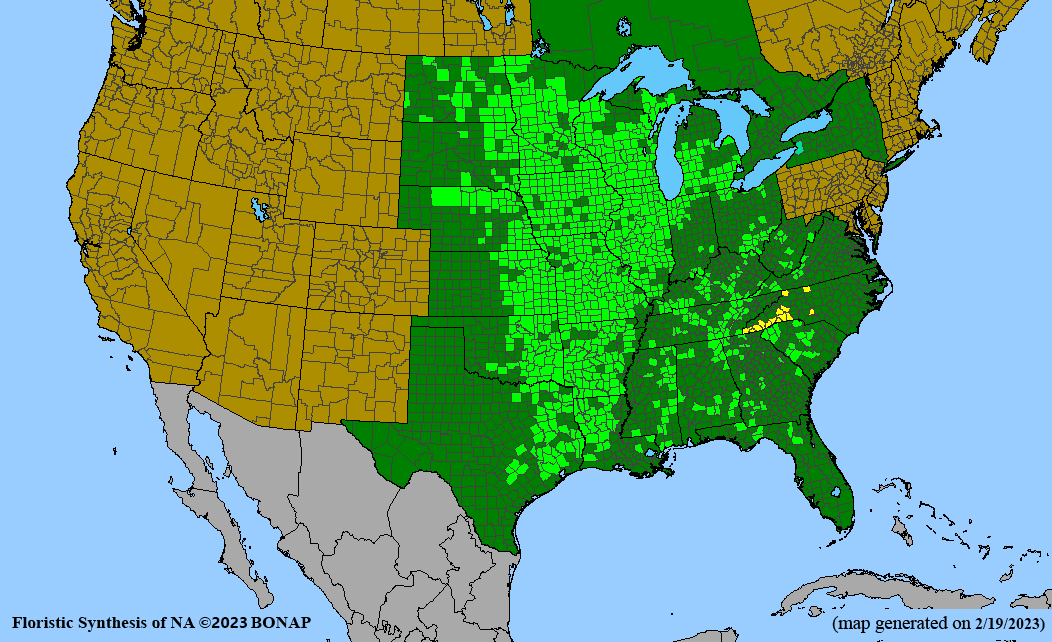
General Comments
This species is best propagated in the greenhouse, and transplanted in spring into a weed-free planting bed or weed barrier. Seedlings develop pea-size corms after two months in the greenhouse. Sometimes first year corms are exposed by frost-heaving over the winter, and may be eaten by voles. Species in the genus Liatris are known to hybridize, therefore proper isolation should be maintained between related species to avoid hybrid seed production (Levin 1968, Menhusen 1972). Liatris species are also produced commercially for the cut-flower industry and some species and cultivars have become popular in gardening and landscaping.
Recommendations for Seed Production
- Establishment for seed production
Direct seeding
Not recommended for this species
Greenhouse
Seed pre-treatment: Wet stratify 8-12 weeks at 40˚ F. Seed sometimes becomes moldy in stratification, and some growers add fungicide to the stratification media.
Sowing: Sow seed 1/4 in deep in the greenhouse two months before the last frost free date.
Transplanting: Harden off, transplant into bare soil in rows and mulch or transplant into a weed barrier at 8 in intervals after all danger of frost is past.
- Stand management
Weeds: Mow/cultivate between rows, mulch within rows. Post emergence grass herbicide, tillage, hoeing, hand roguing. Very sensitive to soil disturbance during bolting/flowering, so clip weeds rather than pulling or hoeing once flower stalks are apparent.
Pests: Voles will eat and/or cache corms, rabbits and deer eat young shoots, goldfinches consume seed as it ripens.
Diseases: Powdery mildew, root-knot nematodes, stem rot, verticillium wilt.
Hybridization risk: This species has been known to hybridize with related species Liatris acidota, L. ligulistylis, L. punctata, L. pycnostachya, and L. squarrosa.
- Seed production
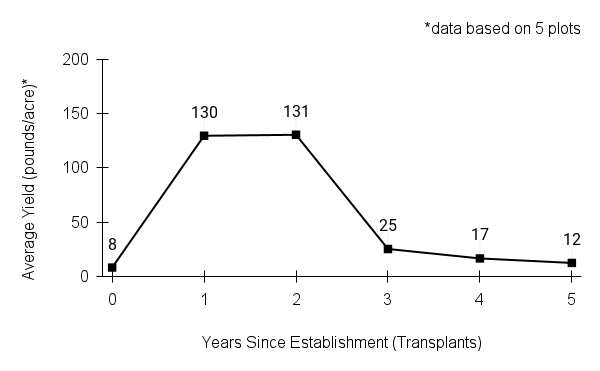
First harvest: Remains vegetative first year (seedlings), abundant flowering/seed production occurs second year. Fall corm division/transplanting results in abundant flowering the following growing season.
Yield: 8-130 bulk pounds/acre (extrapolated from harvests of 5 plots)
Stand life: Peak harvests second year. Good harvest third year if proper soils. Stand declines significantly fourth year and after. Plants tend to lodge second year when flowering.
Flowering date: early August - early September in northern Iowa
Seed maturity/Harvest date: late September - mid-October in northern Iowa
Seed retention: wind dispersed soon after maturity
Harvest date range at TPC (2003-2023): Sept 29 - Nov 6
Recommended harvest method: Combine at maturity, but before pappus is dry and fluffy. Seedheads mature from the top down along a stalk. When the topmost heads are fluffy, break open a few of the lower heads and observe for signs of maturity: dark-colored seeds that separate easily from the base of the head. Small plots may be hand harvested by clipping stalks as the seed matures, then drying the cut material in a building. Dry seed threshes easily from stalks.
- Seed cleaning and storage
Cleaning process: Pre-clean by scalping thru 1/2 in mesh to remove large particles and make the material flowable, brush gently with soft-bristles to remove ‘plumes’ (pappus), using care not to damage seed coat, then air screen.
Seed storage: cool/dry (33-50° F, 30-50% RH); stores well for a few years if seed is not damaged during cleaning.
Released Germplasm
Source Identified material: Northern Iowa Germplasm (IA Zone 1), Central Iowa Germplasm (IA Zone 2), Southern Iowa Germplasm (IA Zone 3)
- References
Chayka, K. (n.d.). Liatris aspera (rough blazing star). Minnesota Wildflowers. https://www.minnesotawildflowers.info/flower/rough-blazing-star
Cochrane, T. S., Elliot, K., & Lipke, C. S. (2014). Rough blazing-star. In Prairie plants of the University of Wisconsin-Madison Arboretum (3rd ed., p. 95). University of Wisconsin-Madison Arboretum.
Hilty, J. (2019). Rough blazingstar - Liatris aspera. Illinois Wildflowers. https://www.illinoiswildflowers.info/prairie/plantx/rgh_blazingstarx.htm
Houseal, G. A. (2007). Forbs wildflowers. In G. A. Houseal (Eds.), Tallgrass Prairie Center’s native seed production manual (pp. 38–39). Tallgrass Prairie Center - University of Northern Iowa.
Kartesz, J.T., The Biota of North America Program (BONAP). 2023. North American Plant Atlas. (http://bonap.net/napa). Chapel Hill, N.C. [maps generated from Kartesz, J.T. 2023. Floristic Synthesis of North America, Version 1.0. Biota of North America Program (BONAP). (in press)]
Levin, D.A. (1968). The Structure of a Polyspecies Hybrid Swarm in Liatris. Evolution, 22(2), 352-372. https://doi.org/10.1111/j.1558-5646.1968.tb05903.x
Menhusen, B.R. (1972). Ecology of the Prairie Species of the Genus Liatris. Third Midwest Prairie Conference Proceedings. Manhattan, Kan.: Division of Biology, Kansas State University. https://search.library.wisc.edu/digital/AL7JMUVRYYXDZO8S/pages/A56MVY3FXXELEL8L
NatureServe. 2024. NatureServe Network Biodiversity Location Data accessed through NatureServe Explorer [web application]. NatureServe, Arlington, Virginia. Available https://explorer.natureserve.org/. (Accessed: February 29, 2024).
Nesom, G. L. (2020, November 5). Liatris aspera Michaux. Flora of North America. http://floranorthamerica.org/Liatris_aspera
Runkel, S. T., & Roosa, D. M. (2009). Rough blazing star. In Wildflowers of the tallgrass prairie: The upper Midwest (2nd ed., pp. 220–221). University of Iowa Press.
USDA NRCS National Plant Data Team. (n.d.). Liatris aspera Michx. USDA plants database. https://plants.usda.gov/home/plantProfile?symbol=LIAS
Species Guide Updated 2/14/2024
white sagebrush
white sagebrush parkecag
Artemisia ludoviciana Nutt.
Alternate Common Names: white sage, prairie sage, western mugwort, Louisiana sage, prairie wormwood, cudweed, mugwort, dark-leaved mugwort, sagewort, western sage, sailor’s tobacco, sagebrush
Scientific Synonym: Artemisia vulgaris var. ludoviciana (Nuttall) Kuntze
Functional Group: forbs (wildflowers)
Family: aster or sunflower family (Asteraceae)
Description
- Life cycle and growth form
Perennial, spreading by rhizomes to form large colonies that exclude some other plants.
Height: 1-3 ft

- Leaves and stem

Alternate leaves, aromatic when crushed, of variable shape but mostly narrow, elongated ellipses up to 1 in wide and 3.5 (occasionally up to 5) in long, short-stalked or sessile, with silvery-white hairs on leaves and stems giving them a felt-like texture; stems may be branched or unbranched.
- Flower, fruit and seedhead
Flower: Individual florets are inconspicuous within silvery, barrel-shaped, 1/8 in heads arranged in clusters in upper leaf axils or in spike-like to open, branched arrays up to 17 in in length; at full flowering, yellow stamens and minute, yellow to reddish corollas may be visible; wind-pollinated.
Fruit/seedhead: Roughly cylindrical in shape, approximately 1/8 in long, pappus is absent, heads open to release seed (achenes) when mature.

- Seed
Seed characteristics
Seeds per ounce: 250,000 (IA NRCS)
1000 seed weight: 0.11 g (Seed Information Database)
Description: Cypsela (achene), elliptical in outline, about 0.5 mm long, light grayish-brown, without hairs or attached fluff (pappus).
Typical seed test
PLS: 84% (n = 11)
Purity: 92% (n = 11)
Germination: 30% (n = 10)
Dormant: 57% (n = 11)
(averages obtained from n tests of purchased seed lots)
- Habitat and range
Habitat: Dry to mesic soil; full sun; sandy or rocky prairies, roadsides. Wetland Indicator Status is Obligate Upland (UPL) for the Midwest.
Conservation status: Global- G5, secure; Michigan- S1, critically imperiled (NatureServe)

General Comments
All above ground parts of the plant have a distinctive sage-like fragrance when rubbed or crushed. This species has traditional medicinal and ceremonial uses among numerous Native American tribes. Because it is wind-pollinated, white sagebrush is not considered a resource for pollinators, though it is a larval host for at least one species of moth caterpillar, Phaneta argenticostana. Its mode of vegetative spread produces a dense network of rhizomes and roots that function in erosion control.
Recommendations for Seed Production
- Establishment for seed production
Direct seeding
We do not have experience direct-seeding this species for seed production.
Greenhouse
Seed pre-treatment: 60 days cold-moist stratification (fine silica sand)
Sowing: Surface (seed is small and must not be buried too deeply); seed directly onto plug flats or start seedlings in germination trays and dibble into plugs when seedlings have first true leaves; start in greenhouse about 8-10 weeks prior to transplanting.
Transplanting: Harden off seedlings 1-2 weeks prior to transplanting; transplant with 12 in plant spacing in plasticulture plots or into bare soil in 36 in rows, after danger of frost; cut or remove plastic after the first full growing season to allow plants to spread by rhizomes.
Note: Also readily propagated through division or rhizome cuttings (see NRCS Plant Guide referenced below).
- Stand management
Weeds: Few issues as dense, young colonies tend to exclude weeds; other small-seeded members of the aster family (e.g., frost aster, Symphyotrichum pilosum, and marestail, Erigeron canadensis) could contaminate seed and should be rogued out before harvest.
Pests: None noted.
Diseases: None noted.
- Seed production
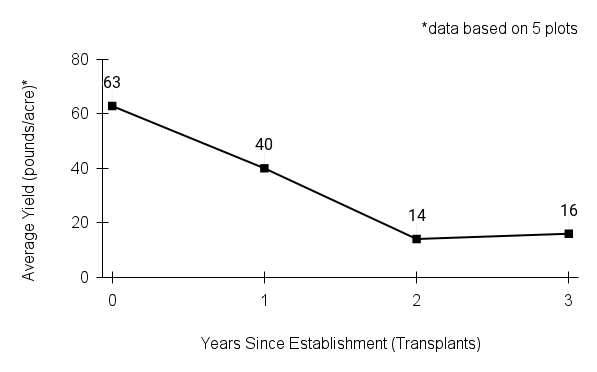 First harvest: In fall of first year when started from greenhouse transplants.
First harvest: In fall of first year when started from greenhouse transplants.Yield: 15-60 pounds/acre (based on 5 plots)
Stand life: Peak seed production in the first two years, then declining.
Flowering date: late August - September
Seed maturity/Harvest date: Mid-October in northeast Iowa; gauge maturity by sampling heads from several plants and crushing to reveal developing seeds (a hand lens is helpful); mature seed will have a grayish-brown color and separate easily from the receptacle; watch for heads to open and release seed when mature; seed shatters easily and will be lost if harvest delayed.
Seed retention: Shattering begins once seedheads open in mid to late October.
Harvest date range at TPC (2003-2023): July 17 - Oct 28
Recommended harvest method: Combine at maturity or cut/swath stems when about 10% of plants in the plot have open seed heads and lay to dry in shed, then run through stationary combine.
- Seed cleaning and storage
Cleaning process: Brush (Westrup LA-H) with stiff bristles and #14 screen mantle to release seed from heads, use minimal vacuum; airscreen several times.
Seed storage: cool/dry (33-50° F, 30-50% RH)
Released Germplasm
Source identified material: Natural Selections/Iowa Ecotype Project Zones 1, 2, and 3
Cultivated variety (cultivar): Summit (LA); horticultural varieties may also exist.
- References
Chayka, K. (n.d.). Artemisia ludoviciana (white sage). Minnesota Wildflowers. https://www.minnesotawildflowers.info/flower/white-sage
Christiansen, P., & Muller, M. (1999). White sage - Artemisia ludoviciana Nutt. Prairie plants of Iowa - Artemisia ludoviciana Nutt. https://uipress.lib.uiowa.edu/ppi/display.php?record=Artemisia_ludoviciana
Cochrane, T. S., Elliot, K., & Lipke, C. S. (2014). White sage. In Prairie plants of the University of Wisconsin, Madison Arboretum (3rd ed., p. 68). University of Wisconsin-Madison Arboretum.
Flora of North America Editorial Committee. 2006a. Flora of North America North of Mexico. Vol. 19. Magnoliophyta: Asteridae, part 6: Asteraceae, part 1. Oxford University Press, New York. xxiv + 579 pp.
Hilty, J. (2020). White sage - Artemisia ludoviciana. Illinois Wildflowers. https://www.illinoiswildflowers.info/prairie/plantx/white_sagex.htm
Kartesz, J.T., The Biota of North America Program (BONAP). 2023. North American Plant Atlas. (http://bonap.net/napa). Chapel Hill, N.C. [maps generated from Kartesz, J.T. 2023. Floristic Synthesis of North America, Version 1.0. Biota of North America Program (BONAP). (in press)]
NatureServe. 2024. NatureServe Network Biodiversity Location Data accessed through NatureServe Explorer [web application]. NatureServe, Arlington, Virginia. Available https://explorer.natureserve.org/. (Accessed: February 16, 2024).
Runkel, S. T., & Roosa, D. M. (2009). Prairie sage. In Wildflowers of the tallgrass prairie: The upper Midwest (Second, p. 237). University of Iowa Press.
Shultz, Leila M. (2020, November 6). Artemisia ludoviciana Nuttall. Flora of North America. http://floranorthamerica.org/Artemisia_ludoviciana
Society for Ecological Restoration, International Network for Seed Based Restoration and Royal Botanic Gardens Kew. (2023) Seed Information Database (SID). Available from: https://ser-sid.org/ (February 2023)
Stevens, M., & Roberts, W. (2000). Plant guide - USDA Plants Database - White sage, Artemisia ludoviciana Nutt. https://plants.usda.gov/DocumentLibrary/plantguide/pdf/cs_arlu.pdf
Species Guide Updated 12/19/2024
Legumes
Legumes sagemThe Species Production Guides for legumes provide specific information about growing each of these species for seed production.
Scroll the list (alphabetized by scientific name) or press ctrl-f (or command-f) to search for any name in this page.
A printable file (pdf) is also provided on each species page for those needing a print version.
This section is a work in progress. We will continue to add new species guides as they are completed.
Amorpha canescens / leadplant
Baptisia bracteata / longbract wild indigo
Desmodium illinoense / Illinois ticktrefoil
Glycyrrhiza lepidota / American licorice
- Lespedeza capitata / roundhead lespedeza
Canadian milkvetch
Canadian milkvetch dickeye
Astragalus canadensis L.
Alternate Common Names: Canada milkvetch, Canada milk-vetch, milk-vetch, little rattlepod
Family: legume and pea family (Fabaceae (Leguminosae))
Functional Group: legumes
Description
- Life cycle and growth form
Perennial with a taproot, spreading by rhizomes.
Height: 1.5-3.5 ft
- Leaves and stem
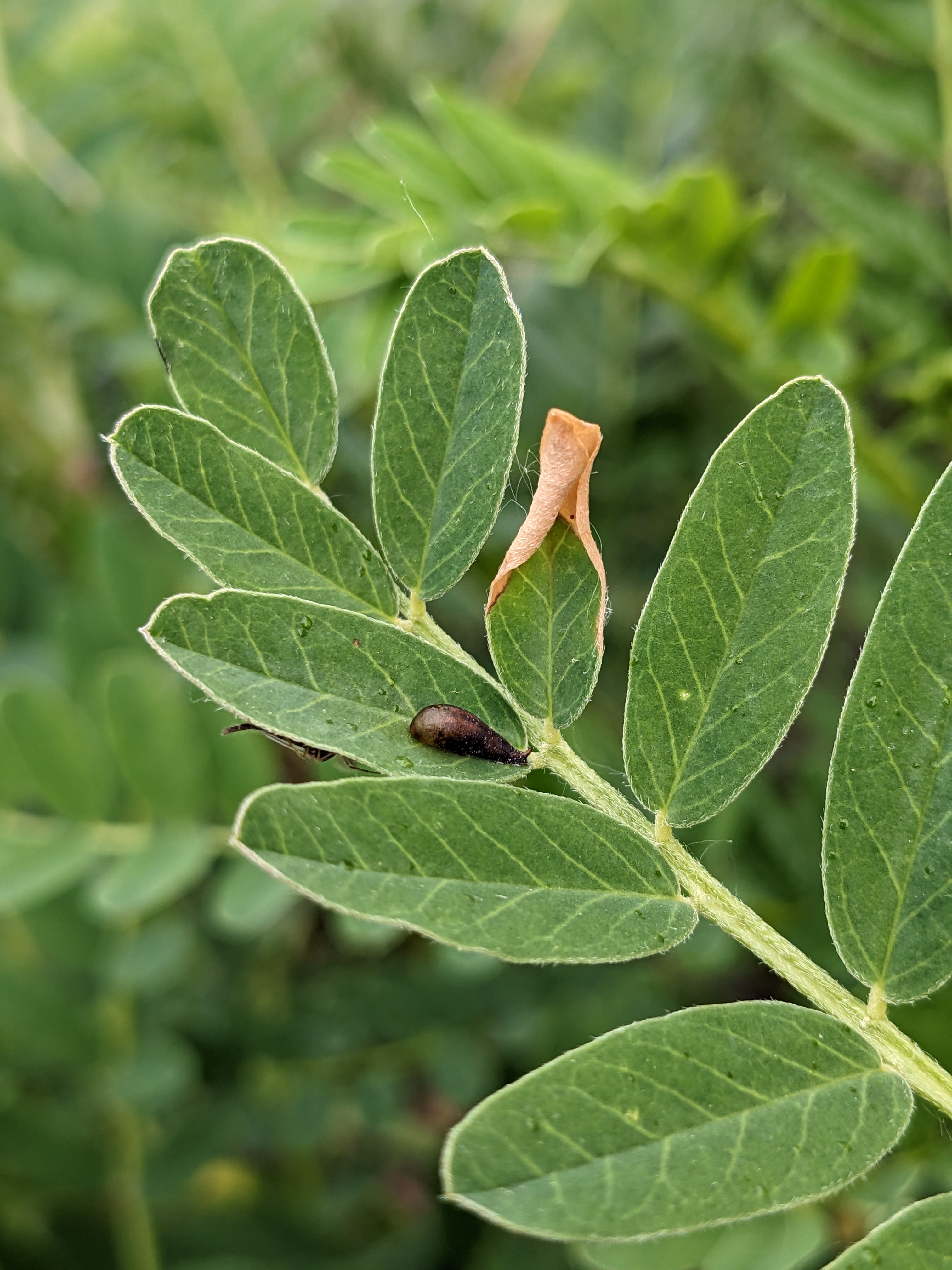
Leaves alternate, odd-pinnately compound with 15 to 31 elliptical leaflets; stems are stiff, branched above, with some hairs, reddish when exposed to high sunlight.
- Flower, fruit and seedhead
Flower: Creamy greenish-white, narrow, elongated pea-like flowers, crowded in spikelike racemes 1.5 to 7 in long at tips of leafless stalks arising from leaf axils on upper portion of plant.
Fruit/seedhead: Spikelike clusters of erect, tough, dark brown pods, each 1/2 in long, with a sharp tip; pods split open from tips when mature to release seeds.
Pollination: Bumble bees and other long-tongued bees.
- Seed
Seed characteristics
Seeds per ounce: 17,000 (IA NRCS)
Seeds per pound: 275,000 (IA NRCS)
1000 seed weight: 1.97 g (Seed Information Database)
Description: Fruits are small pods containing several loose seeds. Pods are about 1 cm long (1/2 in), green at first, turning dark brown to black at maturity, splitting partially open. Seeds are a small, flat bean, about 2 mm (1/16 in) in diameter.
Typical seed test
PLS: 96% (n = 9)
Purity: 100% (n = 9)
Germination: 12% (n = 8)
Hard: 85% (n = 8)
(average of n tests of purchased seed lots)
- Habitat and range
Habitat: Mesic to wet-mesic soil; full sun; prairies, woodland edges, savannas, shorelines, abandoned fields. Wetland Indicator Status is Facultative (FAC) for the Midwest. Moist, fertile, loamy soils are preferred for seed production.
Conservation status: Global- G5, secure; District of Columbia- SX, presumed extirpated; Alabama, Georgia, Maryland, Pennsylvania- S1, critically imperiled; Michigan- S1/S2, critically imperiled to imperiled; Mississippi, Ohio, Utah, and Vermont- S2, imperiled; Colorado, North Carolina, Louisiana, and Nevada- S3, vulnerable (NatureServe)
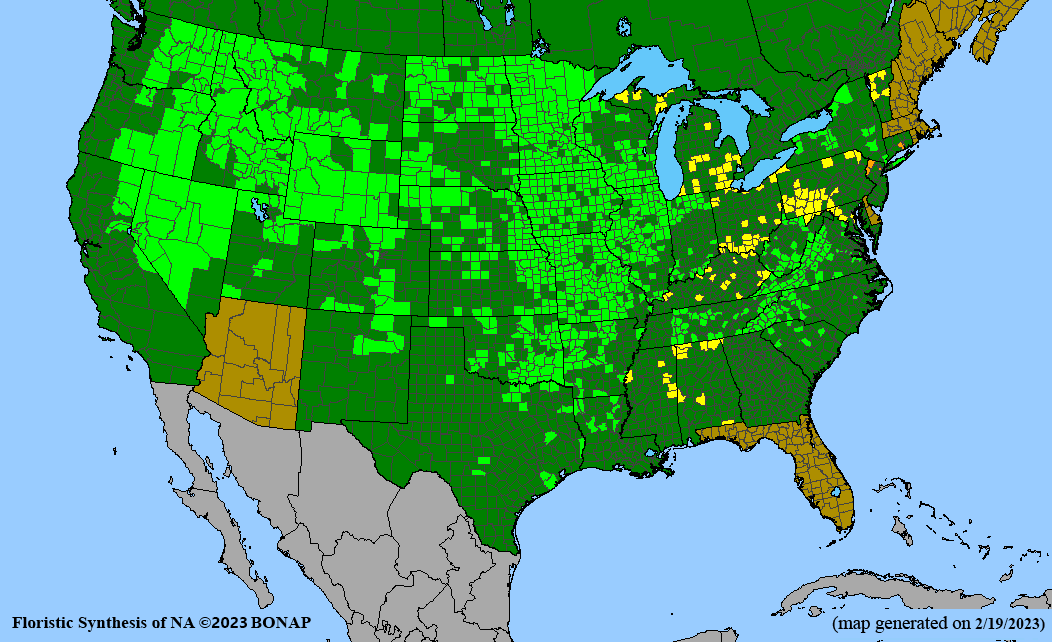
General Comments
Canadian milkvetch is a short-lived species in seed production plots, usually dying out after a few years. It spreads prolifically from rhizomes the second year after establishment. It is usually found as small, somewhat stable colonies in prairies in disturbed areas, over a few years at least. Grazing or clipping prolongs the life-span of the plant, but of course this precludes seed production.
Recommendations for Seed Production
- Establishment for seed production
Direct seeding
Row spacing: 30-36 in 7 in rows and solid stands PLS lbs/acre: 2.1 6.3 Seeds/linear foot: 40
Seeding depth: 1/4-1/2 in
Seeding method: native seed drill
Seeding time: Dormant fall seeding of unscarified seed. Scarify and inoculate seed with Astragalus (Spec 1) inoculum for early spring planting.
Weed control: Prepare clean, firm, weed free seedbed prior to seeding.
Greenhouse
Seed pre-treatment: Scarify seed (see Seed Treatments) and wet stratify 10-14 days at 40° F.
Sowing: Sow seed in greenhouse 2 months before last frost free date.
Transplanting: Transplant mature seedlings into bare soil or weed barrier in rows convenient for tillage equipment after all danger of frost is past. Use a temporary weed barrier such as paper mulch or biodegradable plastic that breaks down or can be removed before the second growing season to accommodate plant spread from rhizomes.
- Stand management
Weeds: Mow stands above seedling height during establishment year. Use tillage and hand-roguing to control weeds.
Pests: Plots may need protection from rabbits and/or deer. Plants infested with black aphids become stunted and produce fewer flowers. Insect seed predators may become a problem.
Diseases: None noted.
- Seed production
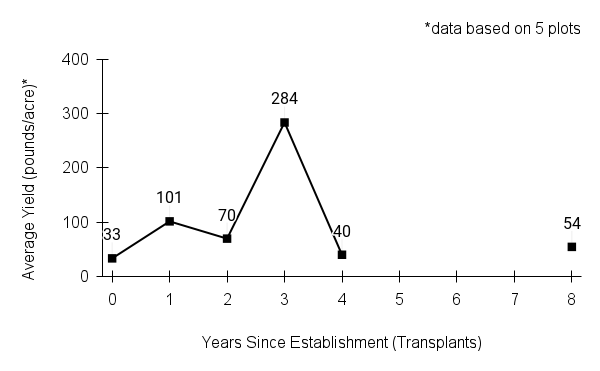
First harvest: Abundant flowering and seed set at end of second growing season from greenhouse grown transplants and well-managed direct seeded stands.
Yield: 30-280 bulk pounds/acre (averages based on 5 plots)
Stand life: Peak harvests in second to third years. Many stems die after flowering and setting seed, usually the second or third year after planting.
Flowering date: mid-July - early August in northern Iowa
Seed maturity/Harvest date: mid-August - early September in northern Iowa
Seed retention: Pods split partially open at maturity, and seeds will shake out of pods if disturbed by strong wind or passing animals.
Harvest date range at TPC (2003-2023): Aug 7 - Sept 25
Recommended harvest method: combine
- Seed cleaning and storage
Cleaning process: Pre-clean air-dried material by scalping thru 1/2 ft and 1/4 in mesh to remove large particles. If hand clipped, break up pods with beater bars in a brush machine. If combined then simply air-screen to clean (see appendix for settings).
Seed storage: cool/dry (33-50° F, 30-50% RH).
Released Germplasm
Source Identified material: Natural Selections/Iowa Ecotype Zones 1, 2, and 3
- References
Chayka, K. (n.d.). Astragalus canadensis (Canada milkvetch). Minnesota Wildflowers. https://www.minnesotawildflowers.info/flower/canada-milkvetch
Hilty, J. (2019). Canada milkvetch - Astragalus canadensis. Illinois Wildflowers. https://www.illinoiswildflowers.info/prairie/plantx/can_milkvetchx.htm
Houseal, G. A. (2007). Forbs legumes. In Tallgrass Prairie Center’s native seed production manual (pp. 56–57). Tallgrass Prairie Center - University of Northern Iowa.
Kartesz, J.T., The Biota of North America Program (BONAP). 2023. North American Plant Atlas. (http://bonap.net/napa). Chapel Hill, N.C. [maps generated from Kartesz, J.T. 2023. Floristic Synthesis of North America, Version 1.0. Biota of North America Program (BONAP). (in press)]
NatureServe. 2024. NatureServe Network Biodiversity Location Data accessed through NatureServe Explorer [web application]. NatureServe, Arlington, Virginia. Available https://explorer.natureserve.org/. (Accessed: February 29, 2024).
USDA NRCS National Plant Data Team. (n.d.). Astragalus canadensis L.. USDA plants database. https://plants.usda.gov/home/plantProfile?symbol=ASCA11
Species Guide Updated 02/13/2025
longbract wild indigo
longbract wild indigo dickeye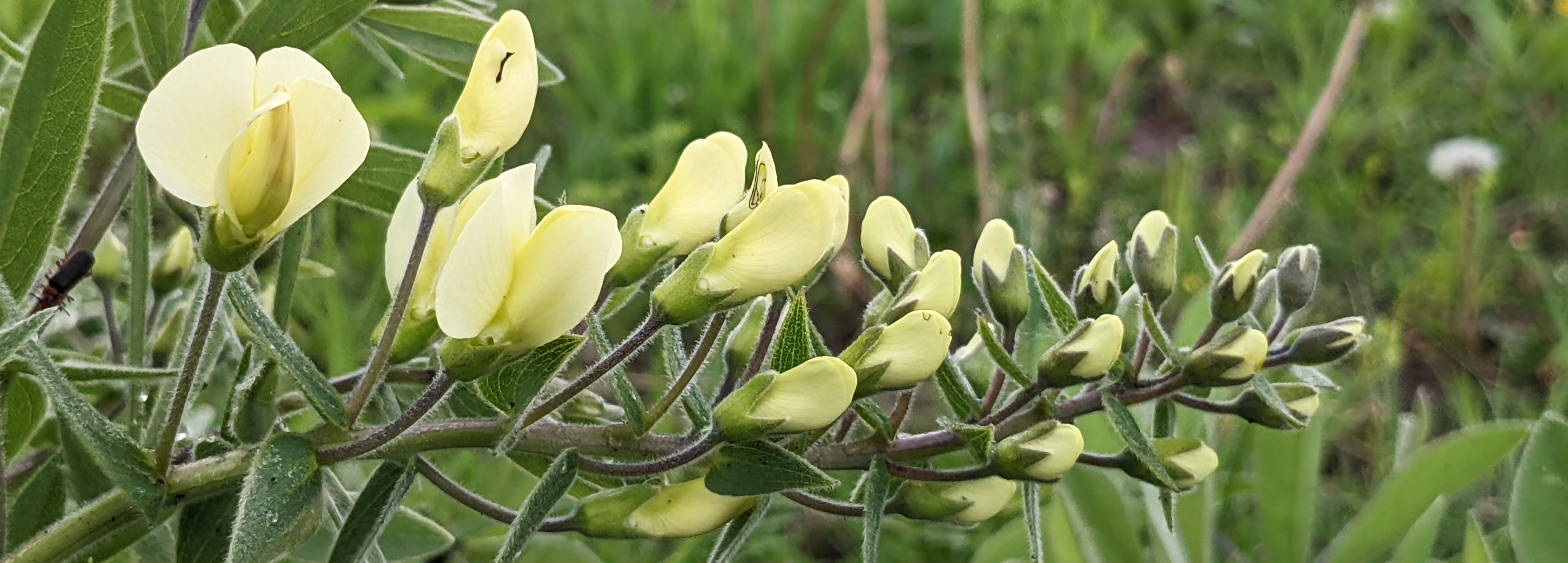
Baptisia bracteata, Muhl. ex Elliott var. leucophaea (Nutt.) Kartesz & Gandhi
Alternate Common Names: Cream-colored false indigo, plains wild indigo, large-bracted wild indigo, long-bracted wild indigo, yellowish false indigo, cream wild indigo
Scientific Synonyms: Baptisia bracteata Muhl. ex Elliott var. glabrescens (Larisey) Isely, Baptisia leucophaea Nutt., Baptisia leucophaea Nutt. var. glabrescens Larisey
Family: legume and pea family (Fabaceae (Leguminosae))
Functional Group: legumes
Description
- Life cycle and growth form
Perennial growing from a taproot; spring shoots resemble asparagus but are fuzzy; in late fall, the plant breaks off near the ground and tumbles to disperse the seeds.
Height: 1-3 ft
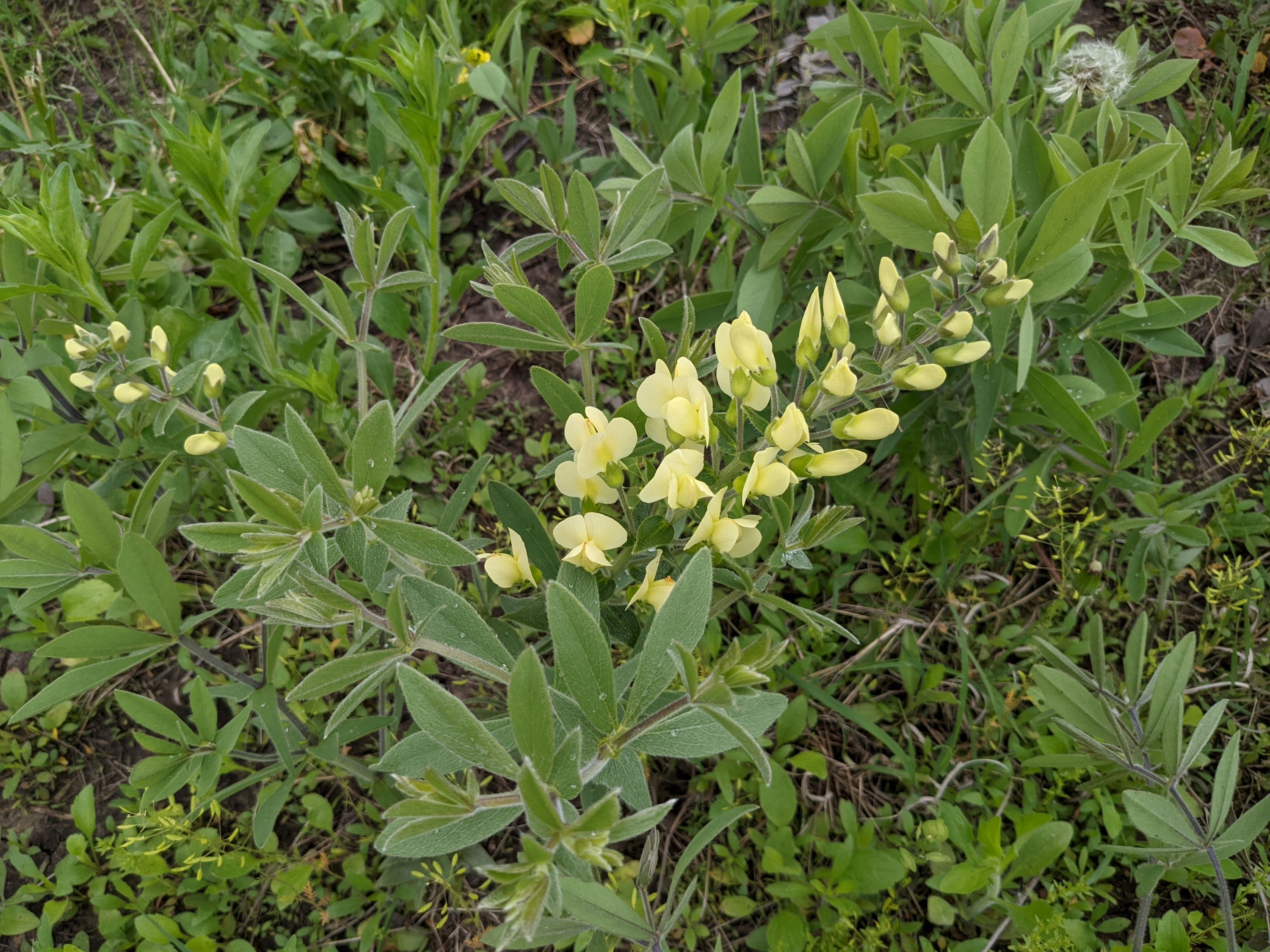
- Leaves and stem
Leaves alternate, hairy, short-stalked or sessile on the stem, compound with 3 leaflets and two large, prominent stipules at the base of each leaf; stems hairy with wide-spreading branches.
- Flower, fruit and seedhead
Flower: Large, pale, creamy-yellow pea-shaped flowers in dense racemes that extend parallel to the ground or droop downward.
Fruit/seed head: Pods are inflated and green, turning black at maturity, 1-2 in long with pointed tips; seeds are small beans, golden-brown to olive in color
Pollination: Bumble bees and other large bodied bees.
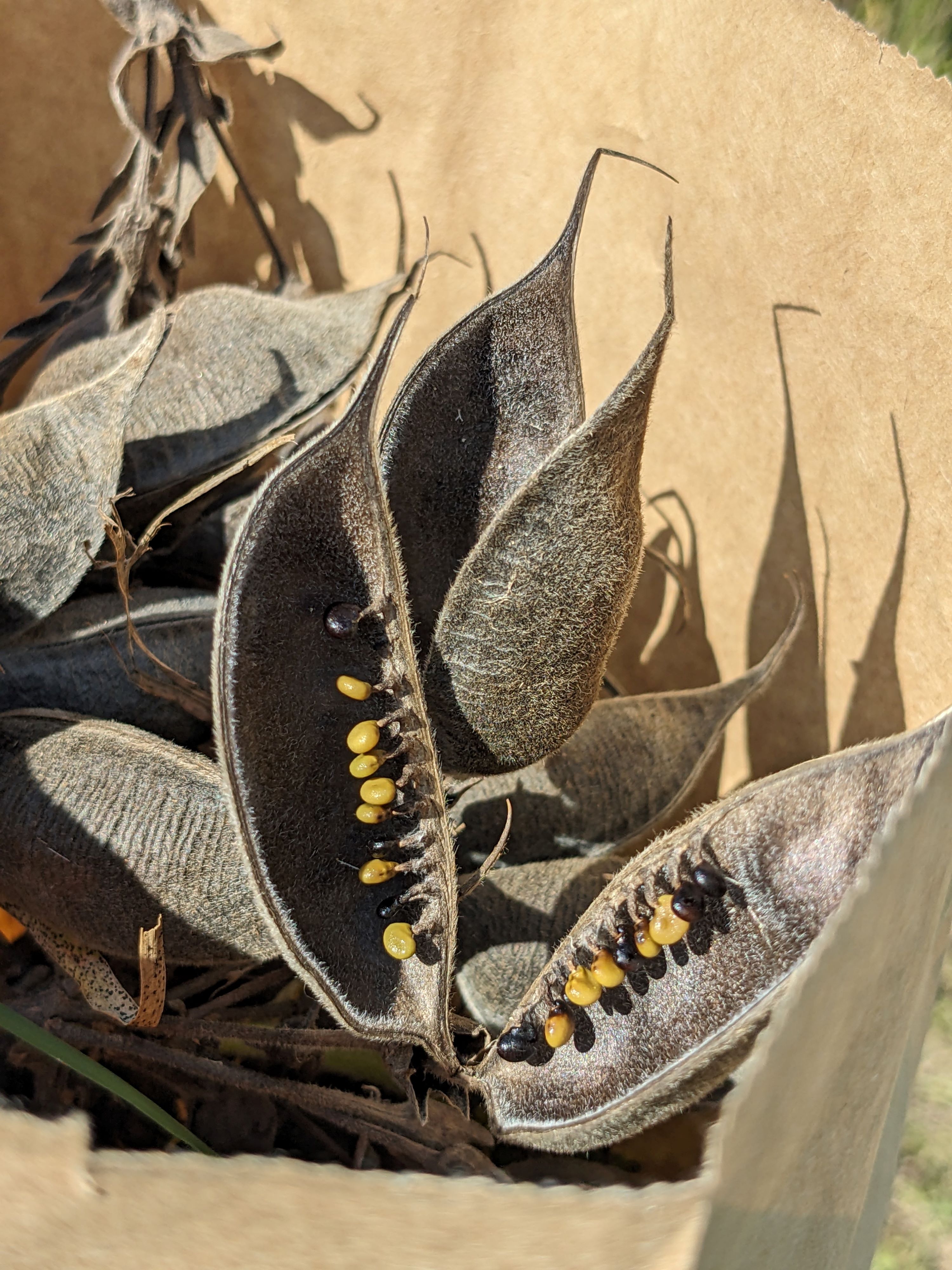
- Seed
Seed characteristics
Seed weight:
Seeds per ounce: 1,400 seeds/oz (IA NRCS)
1000 seed weight: 11.51g (Seed Information Database)
Description: Seed is a small, plump bean about 5 mm in length, golden-brown and coated with a powdery, sticky resin.
Typical seed test
PLS: 93% (n = 6)
Purity: 100% (n = 6)
Germination: 7% (n = 4)
Dormancy: 68% (n = 4)
(averages obtained from n tests of purchased seed lots)
- Habitat and range
Habitat: Dry to mesic soil; full sun; prairies, savannas, woodland openings; well drained soils preferable for seed production.
Conservation status: Global- G4, apparently secure; Minnesota- S3, vulnerable; (NatureServe)
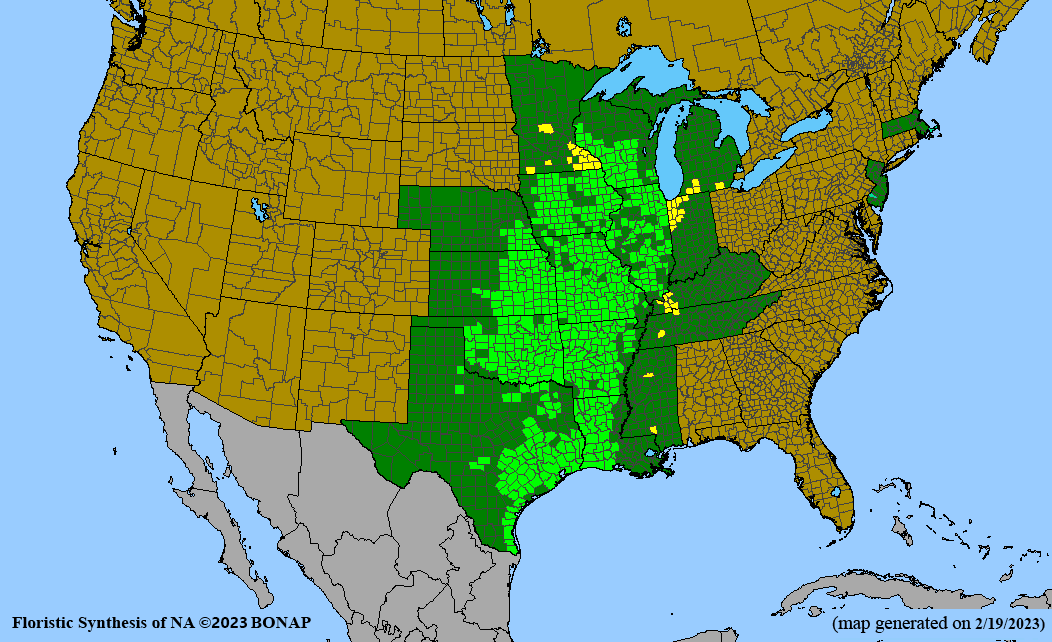
General Comments
The spring shoots of mature cream wild indigo plants come up quickly, resembling hairy asparagus, in late April in northeast Iowa. Blooms appear in May, making this large-flowered species an important source of food for new bumble bee queens. The pods blacken at maturity, and the entire plant turns charcoal-gray in fall. Pods eventually split open, revealing orderly rows of attached seeds, if they have not been devoured by the larvae of a host specific insect: the baptisia seed pod weevil. Seed yields are highly variable due to fluctuations in weevil populations. In natural populations, the stem breaks off at ground level in late fall and plants tumble with the wind, shaking out any seed remaining in the pods, aiding seed dispersal.
Recommendations for Seed Production
- Establishment for seed production
Direct seeding
We do not have experience with direct seeding this species for seed production.
Greenhouse
Seed pre-treatment: Scarify and stratify for 10-14 days in the refrigerator. Inoculate with Baptisia rhizobia if desired.
Sowing: Sow seed 1/4 in deep in plugs two months before average final frost. Damping off (fungal pathogen) can be a problem on seedlings if soil is kept too moist, or seedlings are planted too thickly. Add additional perlite to sterile potting mix to improve drainage. Avoid excess moisture on the soil surface by applying a thin layer of chick grit over the top of the soil, improving air circulation with fans, thinning seedlings, and/or watering from the bottom of the containers only. Seedlings form a fleshy taproot with few lateral roots, unless allowed to grow until taproot is air-pruned as it reaches the bottom drainage holes of the container. Plugs with vertical grooves and large bottom openings encourage air-pruning and branching of roots.
Transplanting: When seedlings are well-rooted plugs, transplant at 12 in spacing in rows mulched with plastic or other weed barrier.
- Stand management
Weeds: Adding a short, warm-season grass to production rows helps suppress weeds and provides fuel for prescribed fires.
Pests: A native, host-specific insect, the baptisia seed pod weevil, consumes nearly all seed in some years, making harvests of this species highly variable. Insecticide (permethrin) treatment may increase seed production slightly (15 more seeds per plant) (Horn and Hanula, 2004), but this must be weighed against potential damage to pollinators.
Diseases: None noted.
- Seed production
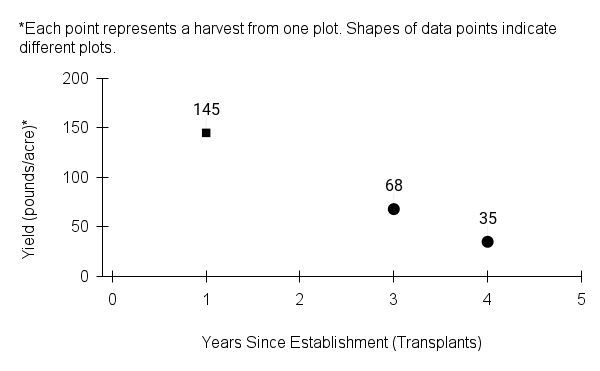 First harvest: Seed may be produced in the year following transplanting, however, yields are extremely variable depending on weevil populations. First measurable harvest in one field at TPC was in year 3.
First harvest: Seed may be produced in the year following transplanting, however, yields are extremely variable depending on weevil populations. First measurable harvest in one field at TPC was in year 3.Yield/acre: 35-145 pounds per acre (extrapolated based on harvest records of 2 plots. Note that each point on the yield graph represents a harvest from one plot. Plots were harvested only in years when weevil damage was light).
Stand life: Plants are very long-lived, persisting within a grassy matrix for 20 years or more, though they do not produce seed every year due to seed predation by weevils.
Flowering date: May in northeast Iowa
Seed maturity/harvest date: Aug - Sept
Seed retention: Not prone to shattering until late fall (October)
Harvest date range at TPC (2005-2024): Aug 4 - Oct 7
Recommended harvest method: Hand pick or combine
- Seed cleaning and storage
Cleaning process: Hand collected material may be stomped to break up pods. This step is not needed for combined material. Pre-clean air-dried material by scalping through 1/2 in mesh to remove large particles. Air-screen to clean (see Appendix C). Most black-colored seeds are non-viable and usually less dense than light-colored seeds, and most should be removed by increasing aspiration.
Seed storage: Cool/dry (33-50° F, 30-50% RH); seed may remain viable for 10 or more years
Released Germplasm
Source Identified material: Natural Selections/Iowa Ecotype Zones 1, 2, 3
- References
Chayka, K. (n.d.). Baptisia bracteata (plains wild indigo). Minnesota Wildflowers. https://www.minnesotawildflowers.info/flower/plains-wild-indigo
Cochrane, T. S., Elliot, K., & Lipke, C. S. (2014). Cream wild indigo. In Prairie plants of the University of Wisconsin-Madison Arboretum (3rd ed., p. 181). University of Wisconsin-Madison Arboretum.
Hilty, J. (n.d.). Cream wild indigo - Baptisia bracteata. Illinois Wildflowers. https://www.illinoiswildflowers.info/prairie/plantx/cr_indigox.htm
Kartesz, J.T., The Biota of North America Program (BONAP). 2023. North American Plant Atlas. (http://bonap.net/napa). Chapel Hill, N.C. [maps generated from Kartesz, J.T. 2023. Floristic Synthesis of North America, Version 1.0. Biota of North America Program (BONAP). (in press)]
NatureServe. 2024. NatureServe Network Biodiversity Location Data accessed through NatureServe Explorer [web application]. NatureServe, Arlington, Virginia. Available https://explorer.natureserve.org/. (Accessed: February 28, 2024).
Runkel, S. T., & Roosa, D. M. (2009). Cream-colored false indigo. In Wildflowers of the tallgrass prairie: The upper Midwest (2nd ed., pp. 46–47). University of Iowa Press.
USDA NRCS National Plant Data Team. (n.d.). Baptisia bracteata Muhl. ex Elliott. USDA plants database. https://plants.usda.gov/home/plantProfile?symbol=BABR2
Species Guide Updated 12/5/2025
purple prairie clover
purple prairie clover dickeye
Dalea purpurea Vent.
Alternate Common Names: violet prairie clover, thimbleweed, red tassel flower, purple prairie-clover
Scientific Synonym: Petalostemum purpureum (Vent.) Rybd.
Family: legume and pea family (Fabaceae (Leguminosae))
Functional Group: legumes
Description
- Life cycle and growth form
Perennial, with woody, branched taproot.
Height: 1-3 ft
- Leaves and stem
Leaves 1.5-3 in long, alternate, odd-pinnately compound with 3-7 very narrow leaflets, smooth but with black dots on lower leaf surface and a strong citrus odor when crushed; stems hairless to hairy and slightly ribbed when dry.
- Flower, fruit and seedhead
Flower: Individual flowers densely packed into a cylindrical spike about 1/2-3 in long; flowers open in whorls from the bottom to the top; tiny, 5-part flowers have purple petals and prominent, golden stamens.
Fruit/seedhead: Seed head is an elongate, compact head at the stem tip, composed of numerous dry, hairless pods which stay attached to the calyx until dislodged; strong scent when crushed.
Pollination: Insects, particularly bees, wasps, small butterflies, skippers, and beetles.
- Seed
Seed characteristics
Seed weight:
Seeds per ounce: 18,000 (IA NRCS)
Seeds per pound: 288,000 (IA NRCS)
1000 seed weight: 3.19 g (Seed Information Database)
Description: Fruits are a 1-2 seeded legume. Seeds are small beans, about 2 mm (1/16 in) long, olive green to tan or brown.
Typical seed test
PLS: 97% (n = 11)
Purity: 100% (n = 11)
Germination: 83% (n = 10)
Hard: 14% (n = 10)
(averages obtained from n tests of purchased seed lots)
- Habitat and range
Habitat: Dry to mesic, rocky or sandy soil; full sun; prairies, dunes, savannas. Very well-drained, loamy soils are preferred for seed production.
Conservation status: Global- G5, secure; Michigan and Ohio- SX, presumed extirpated; Georgia and Tennessee- S1, critically imperiled; Kentucky- S2, imperiled; Indiana- S3, vulnerable (NatureServe)
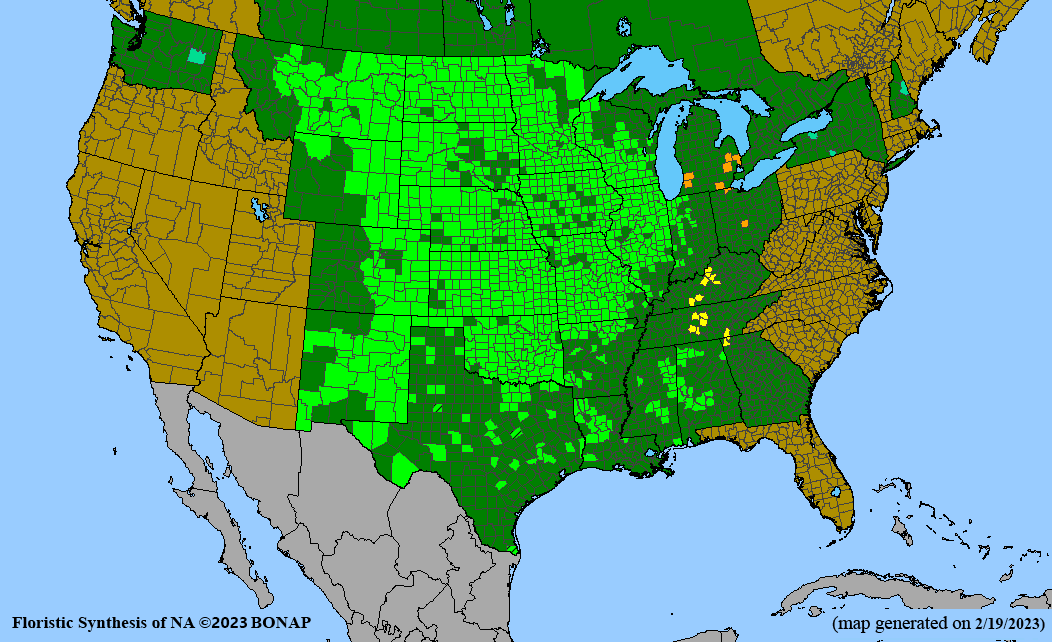
General Comments
Purple prairie clover is an important component of mesic to dry upland prairies. It tends to increase following spring burning (Bidwell 1990), though burning production fields is usually not an option because of a lack of continuous grass fuels to carry fire. Purple prairie clover seed should be dehulled when cleaned for the commercial market. Seed tests are more accurate on a dehulled seed, and seed count per pound is higher.
Recommendations for Seed Production
- Establishment for seed production
Direct seeding
Row spacing: 30-36 in 7 in rows or solid stand PLS lbs/acre: 2 6 Seeding depth: 1/4 in
Seeding method: native seed drill
Seeding time: Dormant fall seeding of unscarified seed. Scarify and inoculate seed (Dalea, F inoculum) for spring planting.
Weed control: Prepare clean, firm, weed free seedbed prior to seeding.
Greenhouse
Seed pre-treatment: Scarify seed (see General Information: Propagation of Native Species). Moist stratification is not required, but seed should be stored in cold, dry conditions until planting time. A short stratification of 10-14 days may result in faster, more uniform germination.
Sowing: Sow seed 1/4 in deep in the greenhouse 2 months before the last frost free date. Damping off (fungal pathogen) can be a problem for seedlings if soil is kept too moist, or seedlings are planted too thickly. Avoid excess moisture on the soil surface by adding additional perlite to the sterile soil medium, applying a thin layer of chick grit (crushed quartzite or granite) over the top of the soil, improving air circulation with fans, thinning seedlings, and/or watering from the bottom of the containers only.
Transplanting: When root growth is sufficient to produce sturdy plugs, transplant seedlings into bare soil in rows convenient for tillage equipment or into a weed barrier at 8-12 in intervals after all danger of frost is past.
- Stand management
Weeds: Mow stands above prairie clover seedling height during establishment year. Poast (sethoxydim) or Prowl (pendimethalin) herbicide after establishment can be used to control weedy grasses. Plateau is labeled for pre- and post-emergence application. Note: These herbicides may not be labeled for this species in your state, always check the label and follow recommendations.
Pests: Herbivory by rabbits or deer may be a problem. Voles can kill many plants within a plot by feeding on the roots. Weevils may infest seed heads, reducing seed yield.
Diseases: None noted under field conditions. Damping off can be serious in a greenhouse environment (see above).
- Seed production
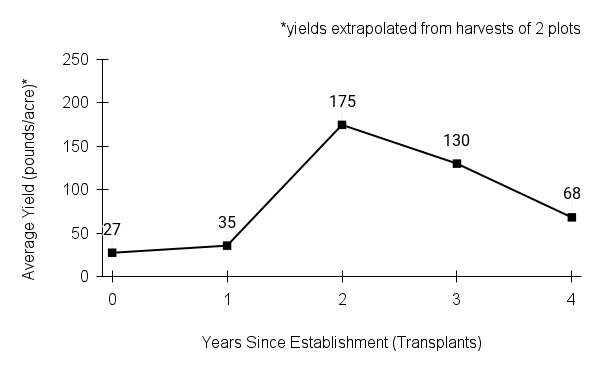 First harvest: Flowering and seed set occur at end of second growing season from greenhouse grown transplants and well-managed direct seeded stand.
First harvest: Flowering and seed set occur at end of second growing season from greenhouse grown transplants and well-managed direct seeded stand. Yield: 27-175 bulk pounds/acre (extrapolated from harvests of 2 plots)
Stand life: 5-10 years. Peak harvest third year.
Flowering date: July - early August in northern Iowa
Seed maturity/Harvest date: September in northern Iowa
Seed retention: Shattering potential is low. Seed heads hold seed into October.
Harvest date range at TPC (2004-2023): Sept 5 - Nov 5
Recommended harvest method: Combine. If plants still retain green leaves, do not cut any lower than necessary to harvest seed heads.
- Seed cleaning and storage
Cleaning process: Pre-clean air-dried material by scalping through 1/2 in and 1/4 in mesh to remove large particles. Use a brush machine with stiff bristles to remove hulls, then air-screen. Re-brush any seed still in the hull, if necessary, and air-screen.
Seed storage: cool/dry (33-50° F, 30-50% RH)
Released Germplasm
Source Identified material: Natural Selections/Iowa Ecotype Project Zones 1, 2, and 3
Selected Germplasm: Bismarck Germplasm (SD), Cuero Germplasm (TX).
Cultivated variety (cultivars): Kaneb (KS)
- References
Chayka, K. (n.d.). Dalea purpurea (purple prairie clover). Minnesota Wildflowers. https://www.minnesotawildflowers.info/flower/purple-prairie-clove
Cochrane, T. S., Elliot, K., & Lipke, C. S. (2014). Purple prairie-clover. In Prairie plants of the University of Wisconsin-Madison Arboretum (3rd ed., p. 183). University of Wisconsin-Madison Arboretum.
Hilty, J. (2019). Purple prairie clover - Dalea purpurea. Illinois Wildflowers. https://www.illinoiswildflowers.info/prairie/plantx/ppr_cloverx.htm
Houseal, G. A. (2007). Forbs wildflowers. In G. A. Houseal (Eds.), Tallgrass Prairie Center’s native seed production manual (pp. 60–61). Tallgrass Prairie Center - University of Northern Iowa.
Kartesz, J.T., The Biota of North America Program (BONAP). 2023. North American Plant Atlas. (http://bonap.net/napa). Chapel Hill, N.C. [maps generated from Kartesz, J.T. 2023. Floristic Synthesis of North America, Version 1.0. Biota of North America Program (BONAP). (in press)]
NatureServe. 2024. NatureServe Network Biodiversity Location Data accessed through NatureServe Explorer [web application]. NatureServe, Arlington, Virginia. Available https://explorer.natureserve.org/. (Accessed: February 29, 2024).
Runkel, S. T., & Roosa, D. M. (2009). Purple prairie clover - White prairie clover. In Wildflowers of the tallgrass prairie: The upper Midwest (2nd ed., pp. 176–177). University of Iowa Press.
USDA-NRCS. (n.d.). Conservation plant releases. Natural Resources Conservation Service. https://www.nrcs.usda.gov/plant-materials/cp/releases
USDA NRCS National Plant Data Team. (n.d.). Dalea purpurea Vent. USDA plants database. https://plants.usda.gov/home/plantProfile?symbol=DAPU5
Species Guide Updated 12/3/2024
roundheaded lespedeza
roundheaded lespedeza dickeye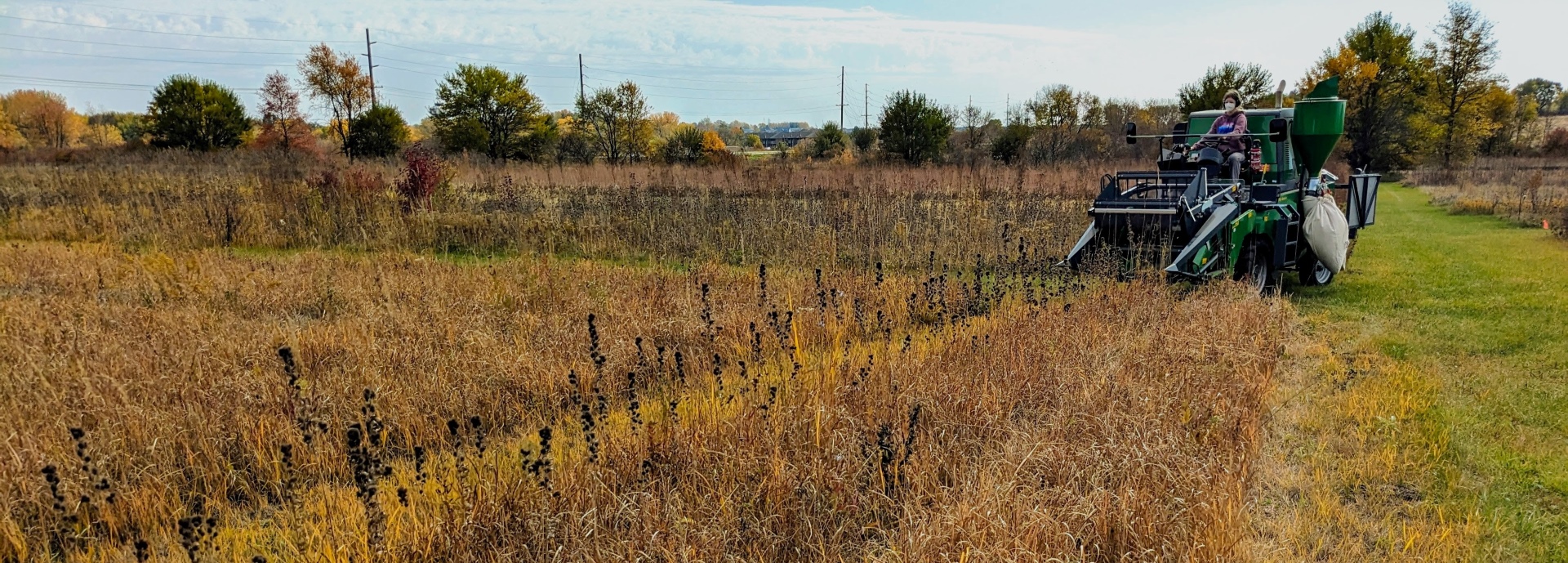
Lespedeza capitata Michx.
Alternate Common Names: rabbit foot, round-headed bush clover, round-headed bush-clover, dusty clover
Scientific Synonyms: Lespedeza bicknellii House, Lespedeza capitata Michx var. stenophylla Bissell & Fernald, Lespedeza capitata Michx. var. velutina (E.P. Bicknell) Fernald, Lespedeza capitata Michx. var. Vulgaris Torr. & A. Gray
Family: legume and pea family (Fabaceae (Leguminosae))
Functional Group: legumes
Description
- Life cycle and growth form
Perennial from a central taproot.
Height: 2-5 ft
- Leaves and stem
Leaves alternate and compound, divided into three leaflets with prominent mid-veins and silky hairs; stem is erect, densely covered in stiff white hairs, usually unbranched; may be multiple stems from the base.
- Flower, fruit and seedhead
Flower: Small cream to white petals with purple spots at the throat, clustered into greenish, rounded heads at stem tip and in upper leaf axils.
Fruit/seedhead: Brown seed heads last through winter though seed is shed in fall; fruit is a fuzzy one-seeded pod.
Pollination: bees
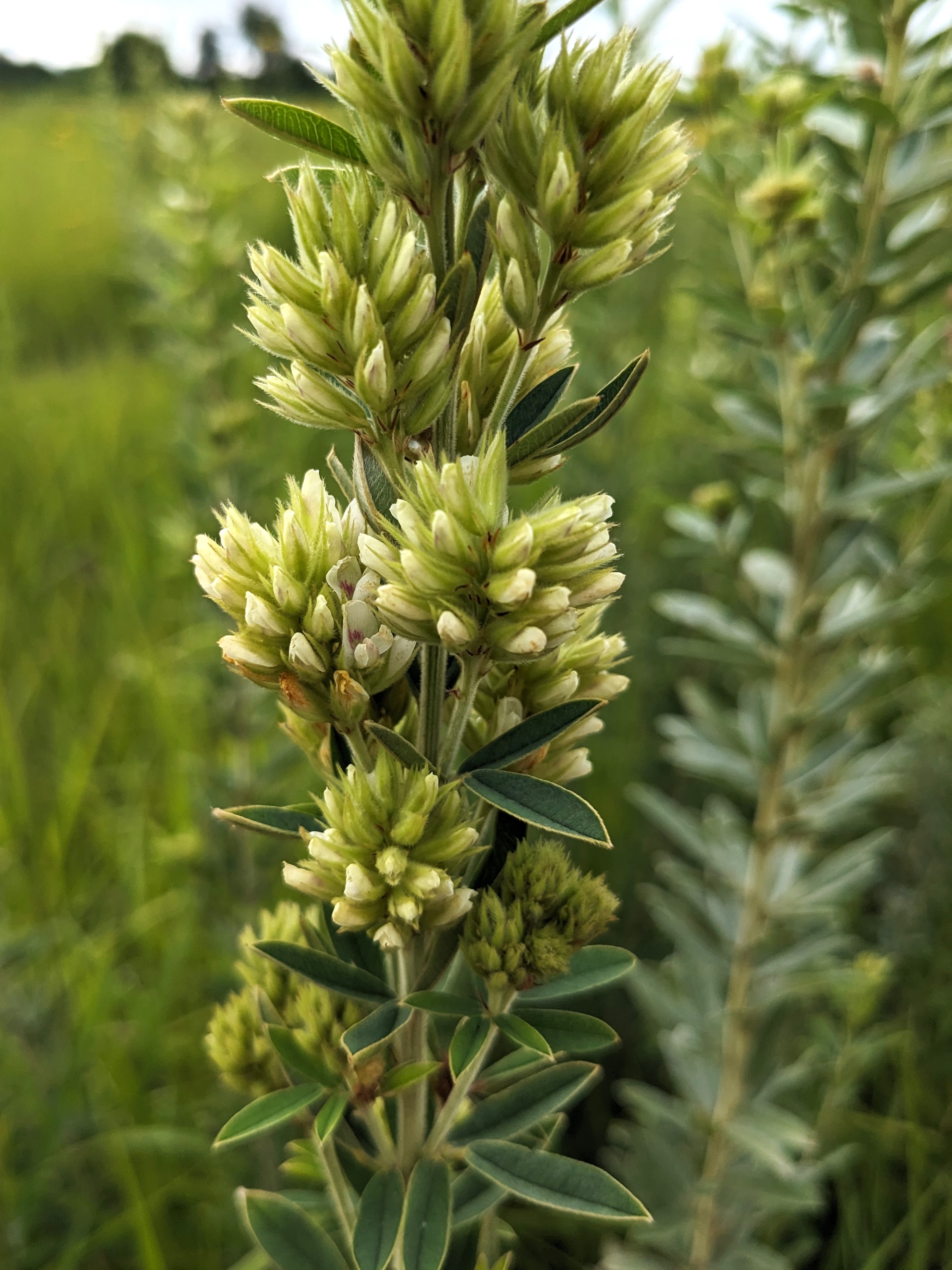
- Seed
Seed characteristics
Seed weight:
Seeds per ounce: 8,000 (IA NRCS)
1000 seed weight: 2.87 g (Seed Information Database)
Description: Fruits are a one-seeded legume, seeds are a small bean, 4-5 mm (about 3/16 in) long.
Typical seed test
PLS: 95% (n = 11)
Purity: 99% (n = 11)
Germination: 79% (n = 10)
Dormancy: 7% (n = 10)
(averages obtained from n tests of purchased seed lots)
- Habitat and range
Habitat: Dry to mesic, sandy soil; full sun; prairies, loamy or sandy savannas, dunes, roadsides, along railroads. Wetland Indicator Status is Facultative Upland (FACU) for the Midwest. Very well-drained loamy soils are preferred for seed production.
Conservation status: Global- G5, secure; West Virginia- SH, possibly extirpated; South Dakota- S2, imperiled; Kentucky and Vermont- S3, vulnerable (NatureServe)
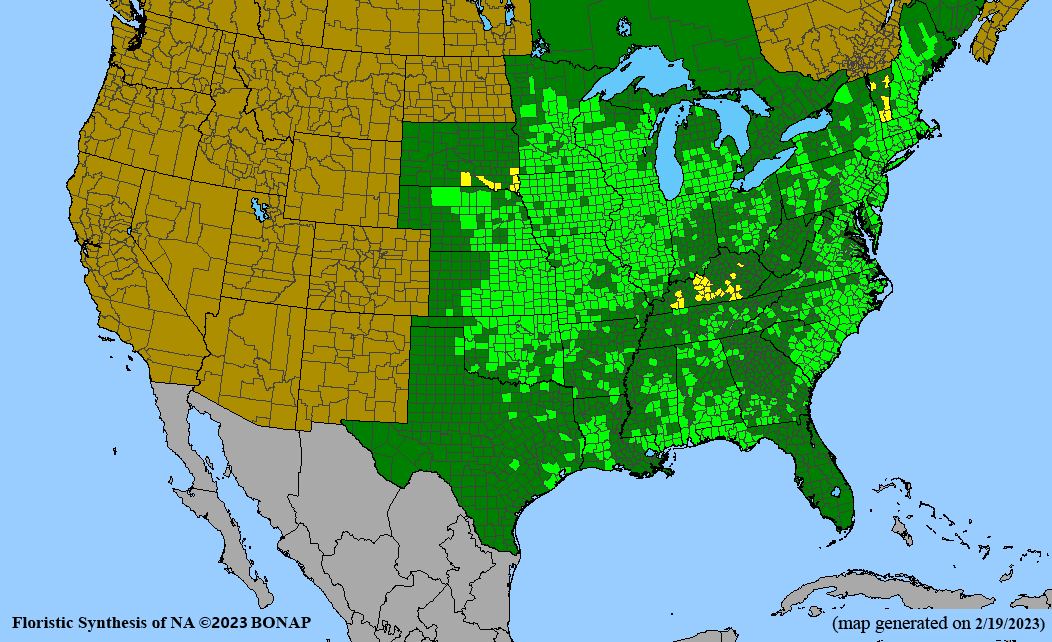
General Comments
Roundhead lespedeza is commonly encountered in remnant prairies and establishes reliably in prairie plantings. It has high wildlife value, providing forage for mammalian herbivores, seed for songbirds and gamebirds, and floral resources for pollinators.
Recommendations for Seed Production
- Establishment for seed production
Direct seeding
Row spacing: 30-36 in rows
PLS pounds/acre: 4.0
Seeding depth: 1/4-1/2 in
Seeding method: native seed drill
Seeding time: Dormant fall seeding of unscarified seed. Scarify and inoculate seed (EL inoculum) for early spring planting.
Weed control: Prepare clean, firm, weed free seedbed prior to seeding.
Greenhouse
Seed pre-treatment: Scarify seed (see Propagation of Native Species: Seed Treatments) and wet stratify 10 days to 2 weeks at 40˚ F.
Sowing: Sow inoculated seed in the greenhouse two months before the last frost free date. Damping off (fungal pathogen) can be a problem on seedlings if soil is kept too moist, or seedlings are planted too thickly. Avoid excess moisture on the soil surface by amending the sterile potting mix with additional perlite, applying a thin layer of chick grit over the top of the soil, improving air circulation with fans, thinning seedlings, and/or watering from the bottom of the containers only. Seedlings form a fleshy taproot with few lateral roots, unless allowed to grow until taproot is air-pruned as it reaches the bottom drainage holes of the container. Plug trays with vertical grooves and wide drainage holes encourage root pruning and plug development.
Transplanting: When seedlings have sufficient root growth to form robust plugs and danger of frost is past, transplant into bare soil in rows convenient for tillage equipment or into a weed barrier at 8-12 in intervals. We have also had success transplanting seedlings into an existing Indiangrass stand that was weakened by mowing.
- Stand management
Weeds: Mow stands above seedling height during establishment year. Poast (sethoxydim) herbicide can be used to control weedy grasses. Prowl (pendimethalin) after establishment for grass control. Plateau should NOT be used on this species. Always read and follow label directions. Roundhead lespedeza can be planted with a warm-season grass such as Indiangrass for weed suppression and to support prescribed fire.
Pests: Herbivory may be a problem.
Diseases: Damping off can be serious in a greenhouse environment (see above).
- Seed production
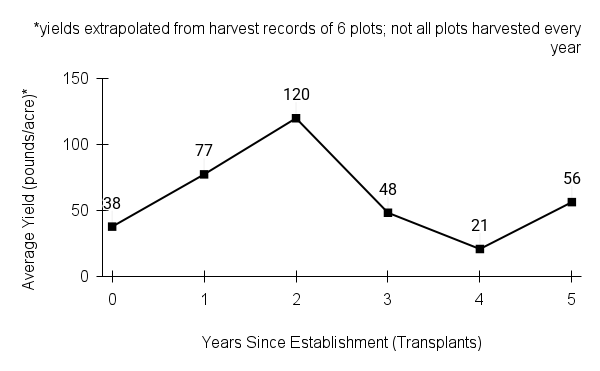 First harvest: Though some plants may flower the first year, two growing seasons are required for stand establishment and seed production. Peak production at TPC has been in the second and third years after planting.
First harvest: Though some plants may flower the first year, two growing seasons are required for stand establishment and seed production. Peak production at TPC has been in the second and third years after planting.Yield: 20-120 bulk pounds/acre (yields extrapolated from harvest records of 6 plots)
Stand life: 5-10 years; seed production typically decreases after 5 years.
Flowering date: mid-August - early September in northern Iowa
Seed maturity/Harvest date: October in northern Iowa
Seed retention: Shattering begins in late October into November
Harvest date range at TPC (2005-2023): Sept 26 - Oct 27
Recommended harvest method: combine
- Seed cleaning and storage
Cleaning process: Use brush machine/huller-scarifier to remove hulls, then air-screen (see Appendix C for settings).
Seed storage: cool/dry (33-50° F, 30-50% RH)
Released Germplasm
Source Identified material: Natural Selections/Iowa Ecotype Project Zone 1 (Northern Iowa), Zone 2 (Central Iowa), and Zone 3 (Southern Iowa)
Cultivated variety (cultivars): Kanoka (KS)
- References
Chayka, K. (n.d.). Lespedeza capitata (round-headed bush clover). Minnesota Wildflowers. https://www.minnesotawildflowers.info/flower/round-headed-bush-clover
Cochrane, T. S., Elliot, K., & Lipke, C. S. (2014).Round-headed bush-clover. In Prairie plants of the University of Wisconsin-Madison Arboretum (3rd ed., p. 188). University of Wisconsin-Madison Arboretum.
Hilty, J. (2019). Round-headed bush clover - Lespedeza capitata. Illinois Wildflowers. https://www.illinoiswildflowers.info/prairie/plantx/rh_bushcloverx.htm
Houseal, G. A. (2007). Forbs legumes. In G. A. Houseal (Eds.), Tallgrass Prairie Center’s native seed production manual (pp. 64–65). Tallgrass Prairie Center - University of Northern Iowa.
Kartesz, J.T., The Biota of North America Program (BONAP). 2023. North American Plant Atlas. (http://bonap.net/napa). Chapel Hill, N.C. [maps generated from Kartesz, J.T. 2023. Floristic Synthesis of North America, Version 1.0. Biota of North America Program (BONAP). (in press)]
NatureServe. 2024. NatureServe Network Biodiversity Location Data accessed through NatureServe Explorer [web application]. NatureServe, Arlington, Virginia. Available https://explorer.natureserve.org/. (Accessed: February 29, 2024).
Runkel, S. T., & Roosa, D. M. (2009). Roundhead lespedeza. In Wildflowers of the tallgrass prairie: The upper Midwest (2nd ed., pp. 228–229). University of Iowa Press.
USDA NRCS National Plant Data Team. (n.d.). Lespedeza capitata Michx. USDA plants database. https://plants.usda.gov/home/plantProfile?symbol=LECA8
Species Guide Updated 12/4/2025
showy ticktrefoil
showy ticktrefoil dickeye
Desmodium canadense (L.) DC.
Alternate Common Names: tick clover, Canadian tick trefoil, showy tick-trefoil, Canadian tick-trefoil, Canada ticklover
Scientific Synonym: Meibomia canadensis (L.) Kuntze
Family: legume and pea family (Fabaceae (Leguminosae))
Functional Group: legumes
Description
- Life cycle and growth form
Perennial from a woody taproot.
Height: 2-6 ft
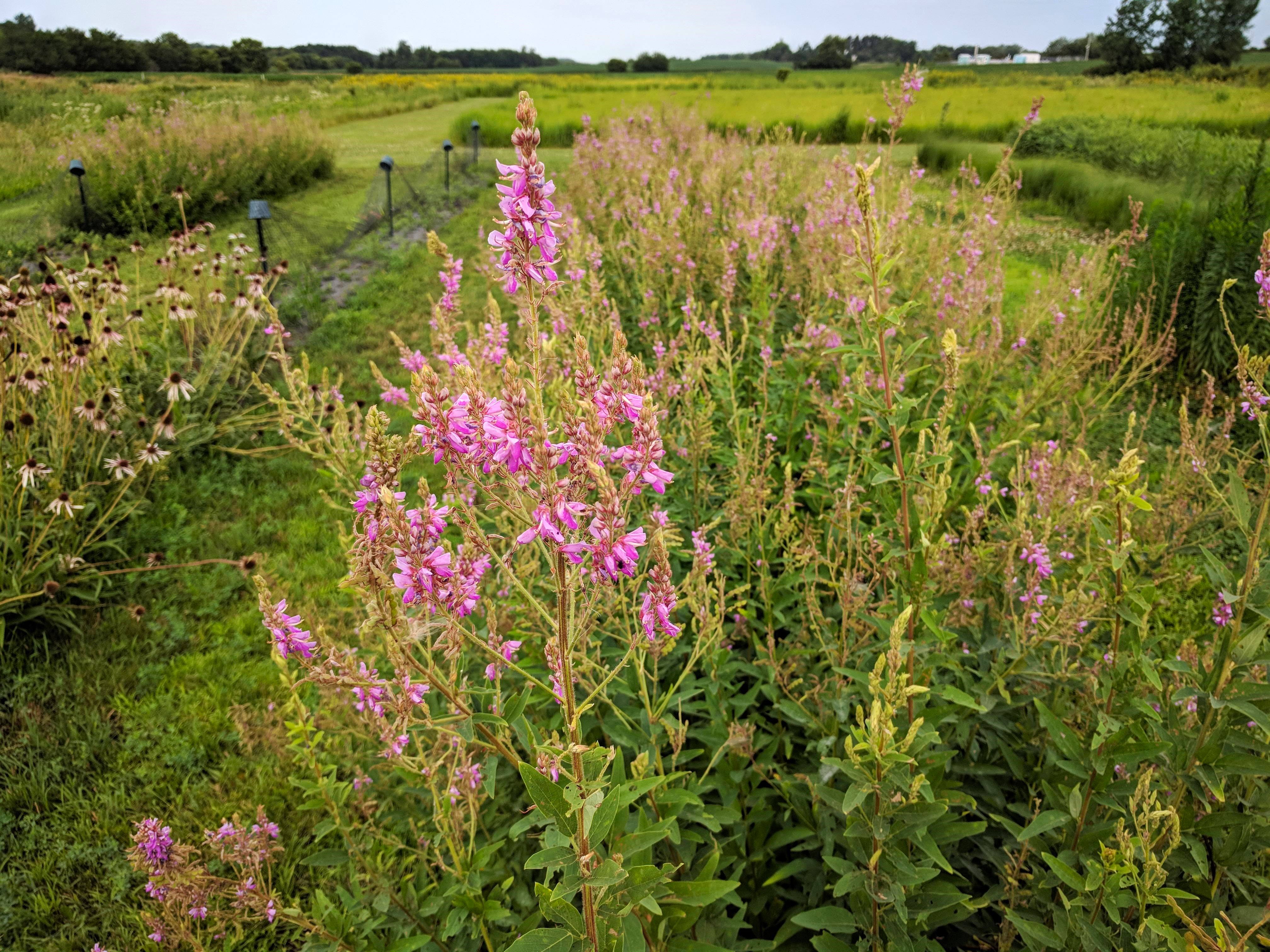
- Leaves and stem
Leaves alternate, divided into three leaflets with rounded base and pointed tips, with sticky (hooked) hairs on undersides and narrow pointed bracts (stipules) on either side of the leaf petiole. Petiole is shorter than the stalk of the terminal leaflet (in contrast to Illinois ticktrefoil). Stem is usually unbranched, hairy.
- Flower, fruit and seedhead
Flower: Irregular, pea-shaped, 1/2 in long flowers, pink-purple with 2 yellow spots near the base of the upper lobe, arranged in spike-like racemes from stem tip and upper leaf axils.
Fruit/seedhead: Fruits are jointed pods called loments, 1-2.5 in long, covered in tiny hooked hairs to latch onto passing mammals, with 3-5 sections each containing one bean-like seed.
Pollination: bees
- Seed
Seed characteristics
Seed weight:
Seeds per ounce: 5,500 (IA NRCS)
Seeds per pound: 88,000 (IA NRCS)
1000 seed weight: 5.11 g (Seed Information Database)
Description: Seeds are small beans, about 2.5-3 mm (about 1/8 in), olive green to tan.
Typical seed test
PLS: 95% (n = 11)
Purity: 100% (n = 11)
Germination: 76% (n = 10)
Hard: 10% (n = 10)
(averages obtained from n tests of purchased seed lots)
- Habitat and range
Habitat: Dry-mesic to wet-mesic soil; full sun; prairies, shorelines, woodland openings, roadsides, prairie remnants. Wetland Indicator Status is Facultative Upland (FACU) for the Midwest. Moist, fertile, well-drained loamy soils are preferred for seed production.
Conservation status: Global- G5, secure; Delaware and Maryland- SH, possibly extirpated; Virginia- S1, critically imperiled; Kansas- S3, vulnerable (NatureServe)
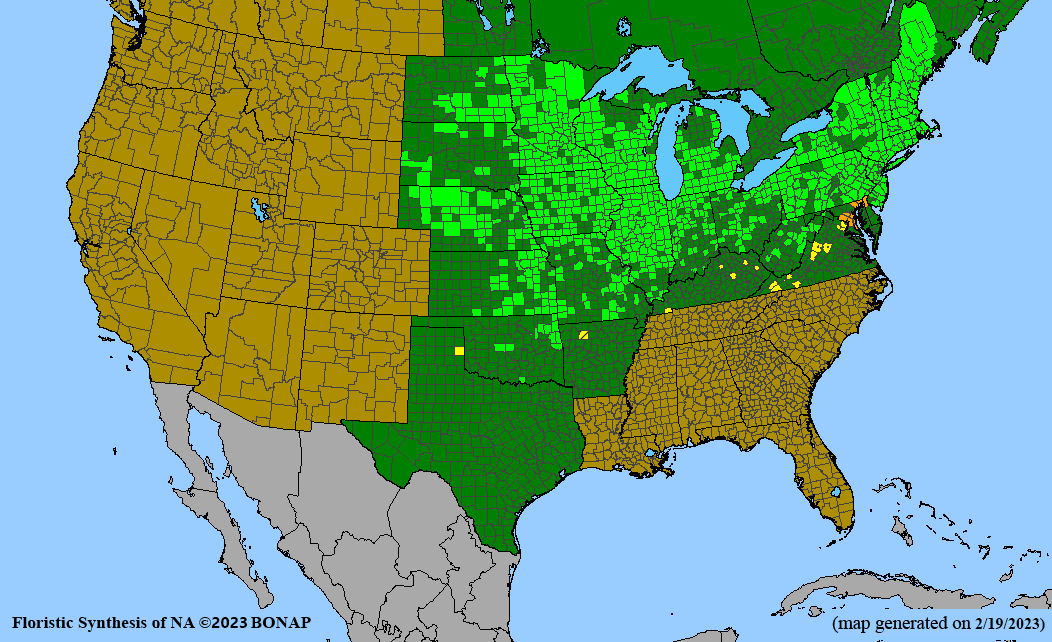
General Comments
Showy ticktrefoil is an important component of black soil prairies, increasing with spring burning. Its seeds are an important food source for upland game birds.
Recommendations for Seed Production
- Establishment for seed production
Direct seeding
Row spacing: 30-36 in 7 in and solid stand PLS lbs/acre: 2.0 6.0 Seeding depth: 1/4 in
Seeding method: native seed drill
Seeding time: Dormant fall seeding of unscarified seed. Scarify and inoculate seed for spring planting (Desmodium EL inoculum).
Weed Control: Prepare clean, firm, weed free seedbed prior to seeding.
Greenhouse
Seed pre-treatment: Scarify seed (see Propagation of Native Species: Seed Treatments). Moist stratification generally isn’t required, but seed should be stored in dry, cold conditions until sowing.
Sowing: Sow seed in greenhouse two months before last frost free date. Inoculate seed with appropriate rhizobium at time of sowing, if desired. Seedlings form a fleshy taproot with few lateral roots unless allowed to grow until taproot is air-pruned as it reaches the bottom drainage holes of the container. Plug flats with vertical grooves and wide drainage holes facilitate air-pruning.
Transplanting: When plants have sufficient root development to form sturdy plugs and danger of frost is past, transplant into bare soil in rows convenient for tillage equipment or into a weed barrier at 8-12 in intervals. Use care when transplanting to keep soil intact around the root system.
- Stand management
Weeds: For direct seedings, mow stand above showy ticktrefoil seedling height during establishment year to reduce weed competition and increase light to seedlings. Poast (sethoxydim) herbicide can be used for annual grass control, post emergence. Pursuit (imazethapry) can be used post-seeding for broadleaf weed control. Note: These herbicides may not be labeled for this species in your state, always check the label and follow recommendations.
Pests: Invasive Japanese beetles form feeding clusters on the inflorescences and in bad years can decimate flowering and seed production. For small scale production systems, a perimeter of beetle traps spaced about 5 m apart surrounding the plot can reduce damage. Traps are constructed of pheromone lures in funnels mounted atop 5-gallon buckets of soapy water. Seed weevils may infest and seriously curtail seed production. Aphids cause distortion of shoot tip growth and may inhibit flowering. Herbivory by deer, rabbits, and groundhogs may be an issue on young plants.
Diseases: Powdery mildew may affect foliage.
- Seed production
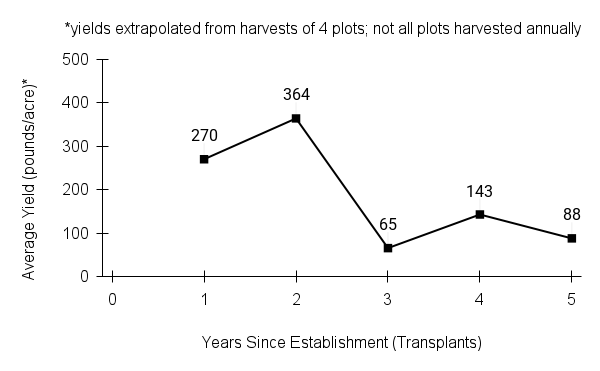 First harvest: Seedling growth is vigorous, and flowering and seed set may occur at end of first growing season from greenhouse grown transplants and well managed direct seeded stands.
First harvest: Seedling growth is vigorous, and flowering and seed set may occur at end of first growing season from greenhouse grown transplants and well managed direct seeded stands.Yield: 60-360 bulk pounds/acre (extrapolated from harvests of 4 plots; not all plots harvested annually)
Stand life: Stand may persist for 5 -10 years.
Flowering date: mid-July - mid-August in northern Iowa
Seed maturity/Harvest date: September in northern Iowa
Seed retention: Low risk of shattering; most seed loss begins late September into October
Harvest date range at TPC (2003-2021): Sept 1 - Oct 10
Recommended harvest method: Combine. Devise a system for collecting clumps of the sticky pods that don’t pass through the sieves and are ejected out the back of the combine.
- Seed cleaning and storage
Cleaning process: Use a brush machine to remove hulls (loments). Re-brush any seed still in the hull, if necessary. Airscreen to clean (see Appendix C for settings).
Seed storage: Cool/dry (33-50° F, 30-50% RH)
Released Germplasm
Source Identified material: Natural Selections/Iowa Ecotype Project Zone 1 (northern Iowa), Zone 2 (central Iowa), and Zone 3 (southern Iowa)
Selected germplasm: Alexander Germplasm (IL).
- References
Chayka, K. (n.d.). Desmodium canadense (showy tick-trefoil). Minnesota Wildflowers. https://minnesotawildflowers.info/flower/showy-tick-trefoil
Cochrane, T. S., Elliot, K., & Lipke, C. S. (2014). Canadian tick-trefoil. In Prairie plants of the University of Wisconsin-Madison Arboretum (3rd ed., p. 184). University of Wisconsin-Madison Arboretum.
Great Plains Flora Association. (1991). Bean family. In T. M. Barkley, R. E. Brooks, & E. K. Schofield (Eds.), Flora of the Great Plains (2nd ed., p. 446). University Press of Kansas.
Hilty, J. (2019). Showy tick trefoil - Desmodium canadense. Illinois Wildflowers. https://www.illinoiswildflowers.info/prairie/plantx/shw_trefoilx.htm
Houseal, G. A. (2007). Forbs legumes. In G. A. Houseal (Eds.), Tallgrass Prairie Center’s native seed production manual (pp. 62–63). Tallgrass Prairie Center - University of Northern Iowa.
Kartesz, J.T., The Biota of North America Program (BONAP). 2023. North American Plant Atlas. (http://bonap.net/napa). Chapel Hill, N.C. [maps generated from Kartesz, J.T. 2023. Floristic Synthesis of North America, Version 1.0. Biota of North America Program (BONAP). (in press)]
NatureServe. 2024. NatureServe Network Biodiversity Location Data accessed through NatureServe Explorer [web application]. NatureServe, Arlington, Virginia. Available https://explorer.natureserve.org/. (Accessed: February 29, 2024).
USDA NRCS National Plant Data Team. (n.d.). Desmodium canadense (L.) DC. USDA plants database. https://plants.usda.gov/home/plantProfile?symbol=DECA7
Species Guide Updated 12/4/2025
white wild indigo
white wild indigo dickeye
Baptisia alba (L.) Vent.
Alternate Common Names: white false indigo, large leaf wild indigo, large-leaved wild indigo, milky wild indigo, prairie false indigo
Scientific Synonyms: Baptisia lactea (Raf.) Thieret, Baptisia leucantha Torr. & A. Gray, Baptisia pendula Larisey var. macrophylla
Family: legume and pea family (Fabaceae (Leguminosae))
Functional Group: legumes
Description
- Life cycle and growth form
Perennial with a thick, deep taproot.
Height: 2-4 ft
- Leaves and stem
Leaves are alternate and compound with three smooth leaflets; stems are waxy and erect, multi-branched, and purplish; leaves and stems turn black after first frost.
- Flower, fruit and seedhead
Flower: Large, white, pea-like blossoms on erect racemes up to 2 ft long. Secondary racemes may also be present. Petals drop after pollination.
Fruit/seedhead: Inflated, cylindrical seed pods start out green but turn black when ripe, seeds are golden.
Pollination: Bumblebees
- Seed
Seed characteristics
Seed weight:
Seeds per ounce: 1,700 (IA NRCS)
Seeds per pound: 27,200 (IA NRCS)
1000 seed weight: 16.42 g (Seed Information Database)
Description: Seeds are a bean about 4-5 mm long (1/4 in), covered with a sticky resin when freshly mature.
Typical seed test
PLS: 95% (n = 11)
Purity: 100% (n = 11)
Germination: 9% (n = 9)
Hard: 88% (n = 10)
(averages obtained from n tests of purchased seed lots)
- Habitat and range
Habitat: Dry to wet-mesic soil; full sun; black soil or sand prairies, marsh and lake edges, thickets, limestone glades. Wetland Indicator Status is Facultative Upland (FACU) for the Midwest. Moist, well-drained soils are preferred for seed production.
Conservation status: Global- G5, secure; North Carolina- S2, imperiled (NatureServe)
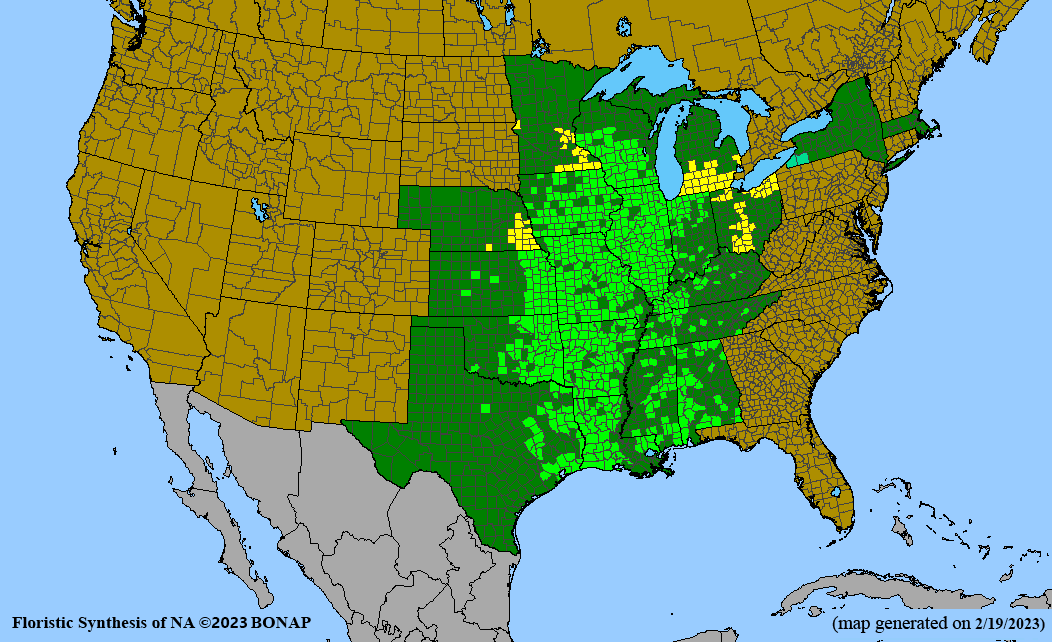
General Comments
The spring shoots of mature white wild indigo plants come up quickly, resembling asparagus, in late spring when soil temperatures warm. The tissues expand quickly, becoming shrub-like in form and blooming by early to mid June. Tissues turn black if bruised, as do seed pods at maturity. The entire plant blackens with fall dormancy. Pods eventually split open, revealing orderly rows of attached seeds, if they have not been devoured by the larvae of a host specific insect: the baptisia seed pod weevil. Seeds are somewhat sticky, initially. Stem breaks off at ground level in late fall and plants will tumble with the wind, shaking out any seed remaining in the pods, aiding seed dispersal.
Recommendations for Seed Production
- Establishment for seed production
Direct seeding
Not recommended for this species
Greenhouse
Seed pre-treatment: Scarify seed (see General Information: Propagation of Native Plants) and wet stratify 10 days to 2 weeks at 40° F. Inoculate seed with a Baptisia inoculum, if desired.
Sowing: Sow seed in greenhouse two months before last frost free date. Damping off (fungal pathogen) can be a problem on seedlings if soil is kept too moist, or seedlings are planted too thickly. Add additional perlite to sterile potting mix. Avoid excess moisture on the soil surface by applying a thin layer of chick grit over the top of the soil, improving air circulation with fans, thinning seedlings, and/or watering from the bottom of the containers only. Seedlings form a fleshy taproot with few lateral roots, unless allowed to grow until taproot is air-pruned as it reaches the bottom drainage holes of the container. Plugs with vertical grooves and large bottom openings encourage air-pruning and branching of roots.
Transplanting: Use care when transplanting to keep soil intact around the root system. Transplant healthy, well-rooted seedlings into bare soil in rows convenient for tillage equipment or into a weed barrier at 12 in intervals after all danger of frost is past.
- Stand management
Weeds: Mow stands above seedling height during establishment year. Control weeds with tillage and hand roguing. It may be desirable to overseed with a shorter growing warm season grass as a companion crop to reduce competition from weeds and to provide a fuel matrix for annual burning, which enhances seed production and seems to reduce seed predation by weevils.
Pests: Seed production can be curtailed or even eliminated in some years by a seed-eating weevil (Apion rostrum). The weevil oviposits eggs in the developing fruit, and the larvae emerge a few days later inside the sealed pods and feed on the developing seeds. Plants may also selectively abort pods containing fewer seeds due to seed predation. It may take a few years for weevils to find and colonize a new production field. Deer are known to eat the entire inflorescence while in bud.
Diseases: None noted.
Hybridization risk: Maintain separation between plots of Baptisia alba and other species in the genus: B. australis, B. bracteata.
- Seed production
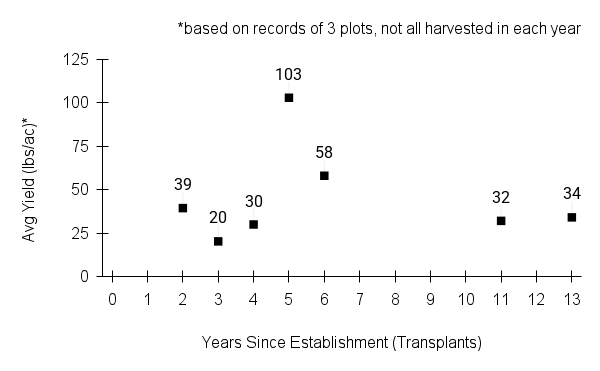 First Harvest: Plants are slow to reach reproductive maturity. Some flowering and seed set may occur in the third growing season under optimal conditions, but it may require 4 to 5 years for a full harvest.
First Harvest: Plants are slow to reach reproductive maturity. Some flowering and seed set may occur in the third growing season under optimal conditions, but it may require 4 to 5 years for a full harvest.Yield: 20-100 bulk pounds/acre (yields extrapolated based on harvest records from 3 plots)
Stand life: Plants appear to be long-lived, estimated stand life of at least 10 years.
Flowering date: mid-June - mid-July in northern Iowa
Seed maturity/Harvest date: September in northern Iowa.
Seed retention: Shattering occurs gradually through September into October.
Harvest date range at TPC (2004-2015): Aug 13 - Oct 21
Recommended harvest method: Combine or hand strip pods at maturity.
- Seed cleaning and storage
Cleaning process: Hand collected material may be stomped to break up pods. This step is not needed for combined material. Pre-clean air-dried material by scalping through 1/2 in mesh to remove large particles. Air-screen to clean (see Appendix C). Most black-colored seeds are non-viable and usually less dense than yellowish-colored seeds, and most should be removed by increasing aspiration.
Seed storage: Cool/dry (33-50° F, 30-50% RH)
Released Germplasm
Source identified material: Natural Selections/Iowa Ecotype Project Zones 1 (northern Iowa), 2 (central Iowa), and 3 (southern Iowa)
Cultivated variety (cultivars): Horticultural varieties may also exist.
- References
Chayka, K. (n.d.). Baptisia lactea (white wild indigo). Minnesota Wildflowers. https://www.minnesotawildflowers.info/flower/white-wild-indigo
Cochrane, T. S., Elliot, K., & Lipke, C. S. (2014). White wild indigo. In Prairie plants of the University of Wisconsin-Madison Arboretum (3rd ed., p. 180). University of Wisconsin-Madison Arboretum.
Hilty, J. (2019). White wild indigo - Baptisia alba macrophylla. Illinois Wildflowers. https://www.illinoiswildflowers.info/prairie/plantx/ww_indigox.htm
Houseal, G. A. (2007). Forbs legumes. In G. A. Houseal (Eds.), Tallgrass Prairie Center’s native seed production manual (pp. 58–59). Tallgrass Prairie Center - University of Northern Iowa.
Kartesz, J.T., The Biota of North America Program (BONAP). 2023. North American Plant Atlas. (http://bonap.net/napa). Chapel Hill, N.C. [maps generated from Kartesz, J.T. 2023. Floristic Synthesis of North America, Version 1.0. Biota of North America Program (BONAP). (in press)]
NatureServe. 2024. NatureServe Network Biodiversity Location Data accessed through NatureServe Explorer [web application]. NatureServe, Arlington, Virginia. Available https://explorer.natureserve.org/. (Accessed: February 29, 2024).
USDA NRCS National Plant Data Team. (n.d.). Baptisia alba (L.) Vent.. USDA plants database. https://plants.usda.gov/home/plantProfile?symbol=BAAL
Species Guide Updated 12/2/2024
Warm Season Grasses
Warm Season Grasses sagemThe Species Production Guides for warm season grasses provide specific information about growing each of these species for seed production.
Scroll the list (alphabetized by scientific name) or press ctrl-f (or command-f) to search for any name in this page.
A printable file (pdf) is also provided on each species page for those needing a print version.
This section is a work in progress. We will continue to add new species guides as they are completed.
Muhlenbergia racemosa / marsh muhly
Sorghastrum nutans / Indiangrass
Spartina pectinata / prairie cordgrass
Sporobolus compositus / composite dropseed
Sporobolus heterolepis / prairie dropseed
big bluestem
big bluestem sagem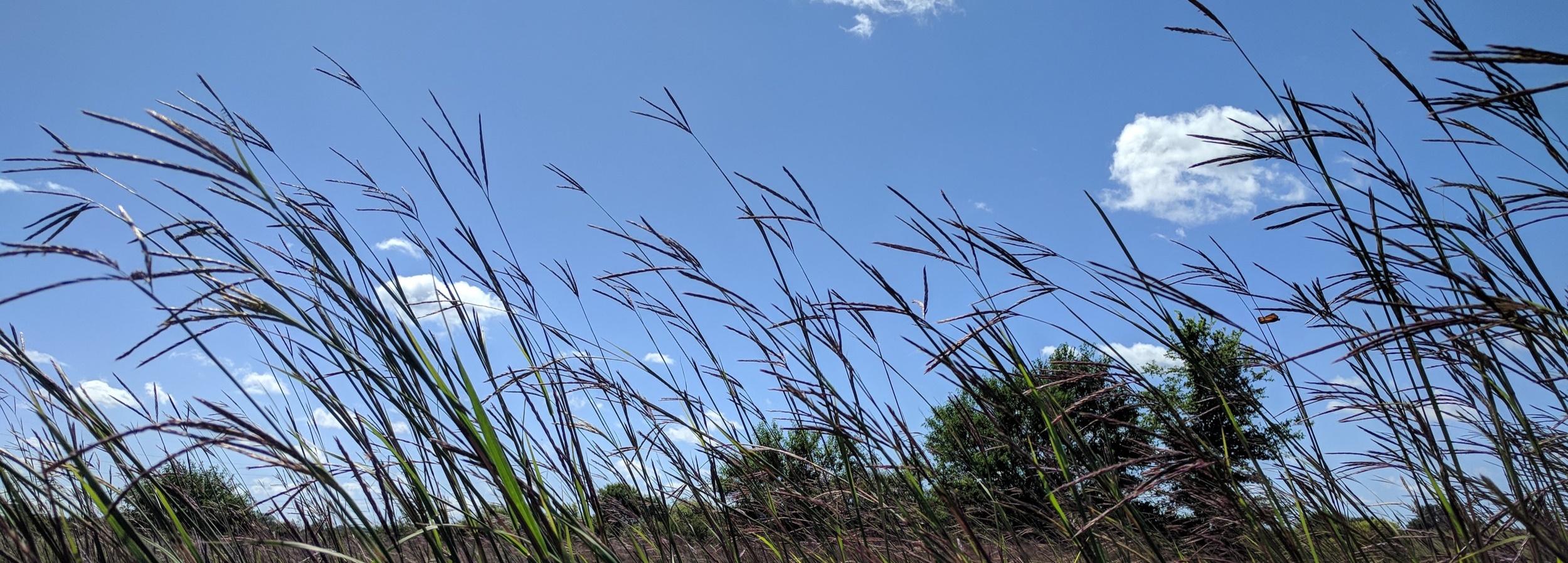
Andropogon gerardii Vitman
Alternate Common Names: turkey foot, turkeyfoot
Scientific Synonyms: Andropogon chrysocomus Nash, Andropogon furcatus Muhl. ex Willd., Andropogon provincialis Lam., Andropogon gerardii Vitman var. chrysocomus (Nash) Fernald
Family: grass family (Poaceae)
Functional Group: warm season grasses
Description
- Life cycle and growth form
Perennial with short rhizomes and fibrous roots that forms large clumps, a bunchgrass.
Height: 2-8 ft
- Leaves and stem
Leaves flat with a prominent midrib, 1-2 ft long and 1/4 in wide, often with long, unkempt, white hairs near leaf base and on lower sheath, ligule is a short, fringed membrane; flowering culms (stems) are erect and hairless, solid, often reddish to bluish purple in color with a waxy bloom, usually with a few branches near the top.
- Flower, fruit and seedhead
Fruit/seedhead: Seed heads (panicles) consist of 2-6 spikelike racemes 1.5-4 in long at the tips of branches, containing both seed-bearing and sterile flowers; seed heads appear bristly when mature and shatter from the tops especially on dry, windy days.
Pollination: wind
- Seed
Seed characteristics
Seeds per ounce: 10,000 (IA NRCS)
Seeds per pound: 160,000 (IA NRCS)
1000 seed weight: 2.14 g (Seed Information Database)
Description: Fertile spikelet with awn, 1-2 cm long (1/2-3/4 in), attached stalk(s) are covered with hairs prior to debearding. Caryopsis smooth, brown, 3-5 mm long.
Typical seed test
PLS: 85%
Purity: 89%
Germination: 39%
Dormant: 56%
(averages obtained from 11 tests of purchased seed lots)
- Habitat and range
Habitat: Mesic to wet-mesic soil; full sun; prairies, savannas, roadsides, fens, glades. Wetland Indicator Status is Facultative (FAC) for the Midwest. Moist, loamy, deep, well-drained soils are preferred for seed production.
Conservation status: Global- G5, secure; Wyoming- S3, vulnerable (NatureServe)
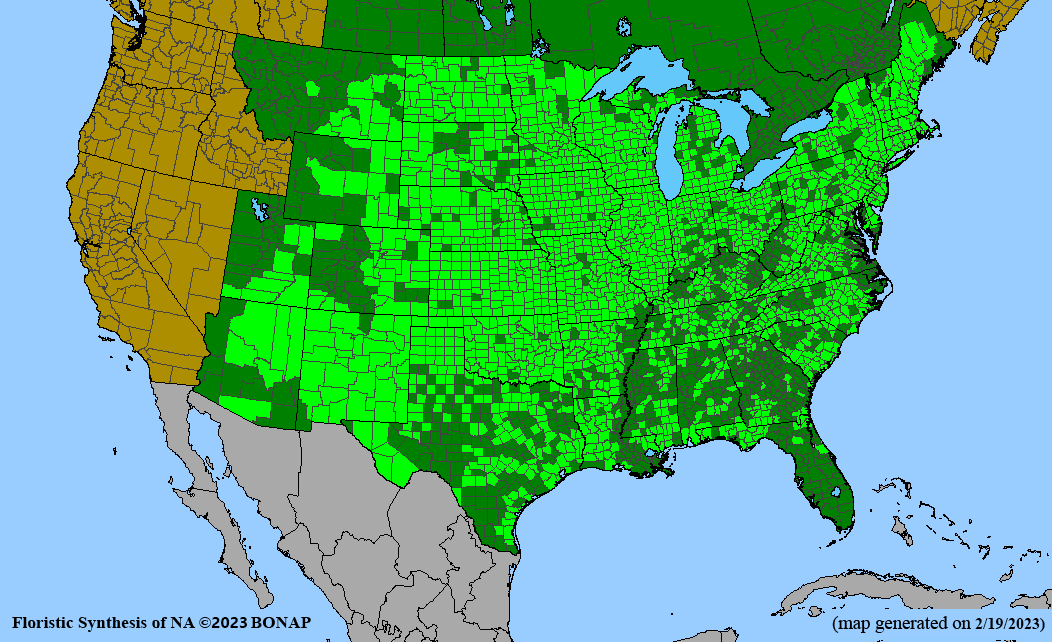
General Comments
Big bluestem is a dominant component of the tallgrass prairie ecosystem. This species establishes readily from direct seeding, particularly if seeded into crop ground where good weed control has been achieved (i.e. following a glyphosate-resistant crop, for example). It takes two to three years for the stand to develop, with good management and weed control.
Recommendations for Seed Production
- Establishment for seed production
Direct seeding
Row spacing: 36 in 24 in 12 in solid stand PLS lbs/acre: 3.6 4.8 9.7 10-12 Seeding depth:1/4-1/2 in
Seeding method: native seed drill
Seeding time: mid to late spring
Weed control: Prepare clean, firm, weed free seedbed prior to seeding.
Greenhouse
Seed pre-treatment: No stratification necessary. Germination of grass seed usually improves with proper storage (cool, dry conditions) throughout the first year after harvest.
Sowing: Sow seed in greenhouse 2 months before last frost free date at 1/4 in depth.
Transplanting: Transplant after all danger of frost.
- Stand management
Weeds: During establishment - mow the stand 6-12 in high during first growing season to prevent weed canopy from shading seedlings. Established stand – Atrazine, 2,4-D, Plateau (imazapic), Outlook (Dimethenamid-P).
Pests: Yellow midges may infest florets, reducing seed yields.
Diseases: Smut fungus affects florets.
- Seed production
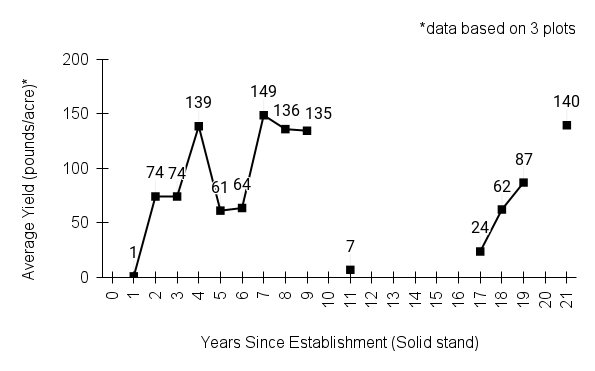
First harvest: Flowering and seed set end of second growing season from direct seeding, 3 years for stand to fill out.
Yield: 60-150 bulk pounds/acre (based on 3 solid stands with no supplemental nitrogen or irrigation; plots were not harvested every year)
Stand life: Peak harvests third year and after. If seed yields decline because stands are sod-bound, they can be chisel plowed to reinvigorate. Annual spring fire when green shoots are 2 in tall helps control weeds and increase flowering and seed production. (Note: This recommendation is strictly for production fields, not remnant prairies). Some producers use nitrogen application in spring to increase seed yield (60-100 pounds lb N/ac). Productive stand life 20 years or more.
Flowering date: early August - mid-September in northern Iowa
Seed maturity/Harvest date: October in northern Iowa
Seed retention: Shattering begins mid to late October.
Harvest date range at TPC (2003-2022): Sept 12 - Nov 2
Recommended harvest method: Combine at medium to hard dough stage, when some shattering is beginning to occur on the top of the main panicles.
- Seed cleaning and storage
Cleaning process: Air-dry material, scalp through 1/2 in mesh, remove awns with debearder or brush machine, then air-screen. Indent cylinder can help remove foxtail or similar weed seeds, if present.
Seed storage: cool/dry (33-50° F, 30-50% RH)
Released Germplasm
Source Identified material: Central (Zone 2), Northern (Zone 1), and Southern (Zone 3) Natural Selections/Iowa Ecotype Germplasm (IA), Northern Missouri Germplasm (MO), OH 370 Germplasm (OH), Southlow Michigan Germplasm (MI), Suther Germplasm (NC)
Selected germplasm: Bounty Germplasm (MN,SD), Hampton Germplasm (MO), OZ-70 Germplasm (AR, IL, MO, OK), Prairie View Indiana Germplasm (IN), Refuge Germplasm (AR, IL, MO, OK)
Cultivated variety (cultivar): Bison (ND), Bonilla (SD), Earl (TX), Kaw (KS), Niagara (NY), Rountree (IA), Sunnyview (SD)
- References
Chayka, K. (n.d.). Andropogon gerardii (big bluestem). Minnesota Wildflowers. https://www.minnesotawildflowers.info/grass-sedge-rush/big-bluestem
Hilty, J. (2019). Big bluestem - Andropogan gerardii. Illinois Wildflowers.https://www.illinoiswildflowers.info/grasses/plants/bigblue.htm
Houseal, G. A. (2007). Grasses warm season. In G. A. Houseal (Eds.), Tallgrass Prairie Center’s native seed production manual (pp. 66–67). Tallgrass Prairie Center - University of Northern Iowa.
Kartesz, J.T., The Biota of North America Program (BONAP). 2023. North American Plant Atlas. (http://bonap.net/napa). Chapel Hill, N.C. [maps generated from Kartesz, J.T. 2023. Floristic Synthesis of North America, Version 1.0. Biota of North America Program (BONAP). (in press)]
NatureServe. 2024. NatureServe Network Biodiversity Location Data accessed through NatureServe Explorer [web application]. NatureServe, Arlington, Virginia. Available https://explorer.natureserve.org/. (Accessed: February 29, 2024).
USDA-NRCS. (n.d.). Conservation plant releases. Natural Resources Conservation Service. https://www.nrcs.usda.gov/plant-materials/cp/releases
USDA NRCS National Plant Data Team. (n.d.). Andropogon gerardii Vitman. USDA plants database. https://plants.usda.gov/home/plantProfile?symbol=ANGE
Species Guide Updated 12/17/2024
little bluestem
little bluestem dickeye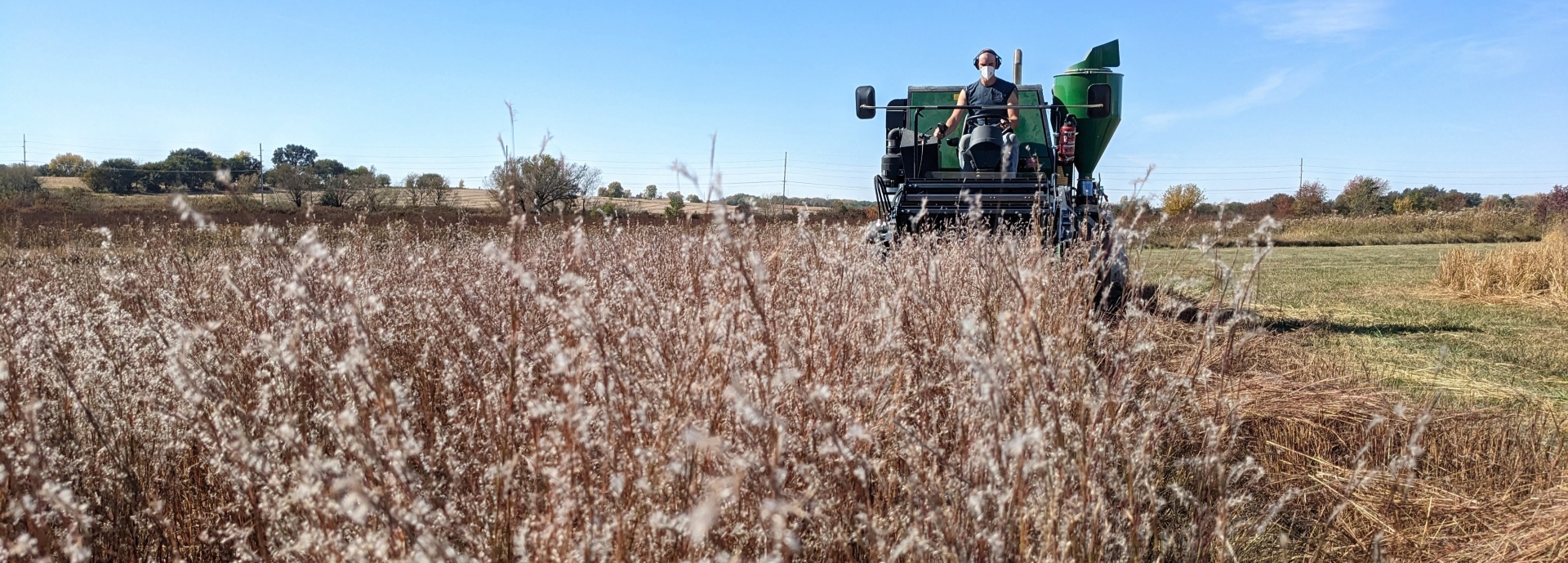
Schizachyrium scoparium (Michx.) Nash
Alternate Common Names: prairie beardgrass, broom beardgrass
Scientific Synonym: Andropogon scoparius, Michx.
Family: grass family (Poaceae)
Functional Group: warm season grass
Description
- Life cycle and growth form
Perennial, short rhizomes, fibrous roots, grows in dense clumps.
Height: 1-3 ft
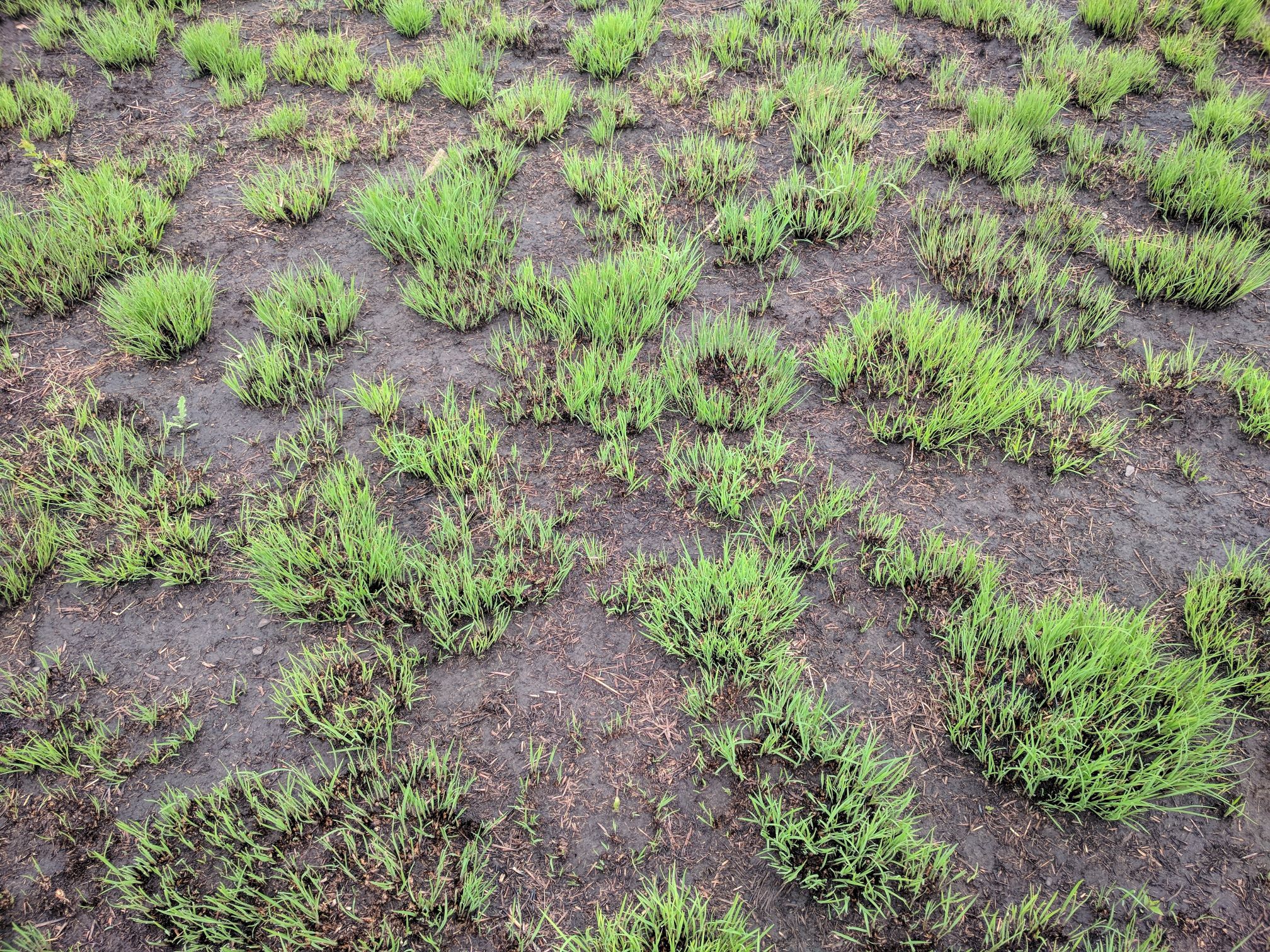
- Leaves and stem
Leaf blades narrow, up to 8 in long, flat or folded lengthwise, green to blue-green in color, usually hairless; sheaths strongly flattened and often hairless; ligule is a fringed (ciliate) membrane; nodes are hairless and purple; flowering stem is hairless and erect with many short branches, bluish to reddish-purple in color.
- Flower, fruit and seedhead
Fruit/seedhead: Single spikes, about 1 in long, arise from upper leaf axils, spikelets spread out as they mature, appearing as white, feathery appendages that arch; entire spikelets fall off at maturity and are weakly dispersed by the wind up to several feet from the parent plant.
Pollination: wind

- Seed
Seed characteristics
Seeds per ounce: 15,000 (IA NRCS)
1000 seed weight: 1.50 g (Seed Information Database)
Description: [shape, length, color, attached structures]
Typical seed test
PLS: 68% (n = 12)
Purity: 71% (n = 12)
Germination: 35% (n = 11)
Dormant: 59% (n = 11)
(averages obtained from n tests of purchased seed lots)
- Habitat and range
Habitat: Dry to dry-mesic soil; full sun; prairies, glades, dunes, roadsides, along railroads, woodland openings, scrubby barrens, abandoned fields; Wetland Indicator Status is Facultative Upland (FACU) for the Midwest; well-drained, moderately moist soils are preferred for seed production.
Conservation status: Global- G5, secure (NatureServe)
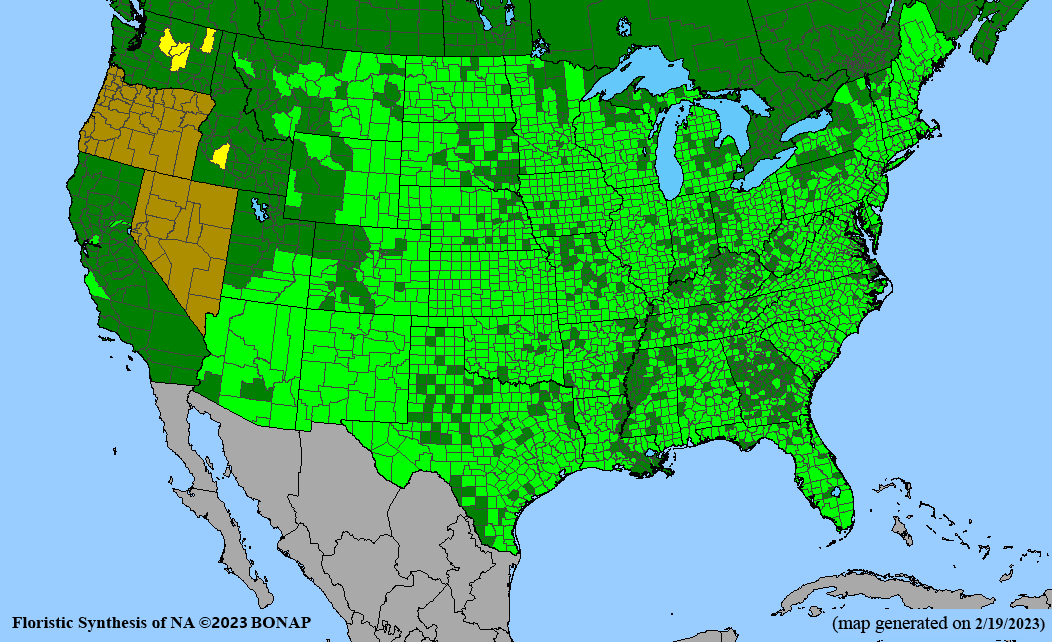
General Comments
Little bluestem is a dominant component on dry or well-drained soils within the tallgrass prairie region. Careful site selection, seedbed preparation, and weed control are critical to successful establishment from seed. No-till drilling with a native seed drill into cropland following a glyphosate-resistant crop, soybeans for example, is an excellent method. It takes two to three years for a stand to develop and reach peak yields.
Recommendations for Seed Production
- Establishment for seed production
Direct seeding
Row spacing: 36 in 24 in 12 in solid stand PLS lbs/acre: 2.4 3.2 6.4 8.0 Seeding depth: 1/4 in
Seeding method: native seed drill
Seeding time: late spring to early summer.
Weed control: Prepare clean, very firm, weed free seedbed prior to seeding.
Greenhouse
Seed pre-treatment: No stratification necessary. Germination of grass seed usually improves with proper storage (cool, dry conditions) throughout the first year after harvest.
Sowing: Sow seed in greenhouse two months before last frost free date at 1/4 in depth.
Transplanting: Transplant after all danger of frost.
- Stand management
Weeds: Mow stands high (6–12 in) in the first growing season to prevent weed canopy from shading seedlings. Imazepic can be used to control grass and broadleaf weeds in established stands. Pre-emergent grass and broadleaf herbicides can be used for weed control. Always check chemical labels.
Pests: None noted.
Diseases: No significant issues noted in TPC production plots, however, a leaf spot fungus is known to infect little bluestem and related grass species.
- Seed production
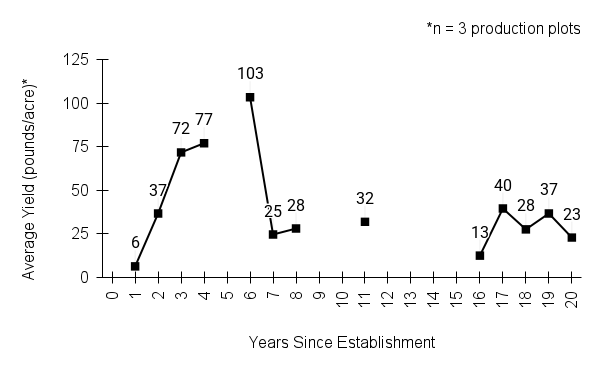 First harvest: Flowering and seed set end of second growing season from direct seeding, three years for stand to fill out.
First harvest: Flowering and seed set end of second growing season from direct seeding, three years for stand to fill out.Yield: 30-100 bulk pounds/acre
Stand life: Peak harvests third year and after. If seed yields decline, stands can be chiseled to reinvigorate. We do not apply fertilizer to TPC plots, but this may improve seed yield. Annual late spring fire helps control weeds and increase flowering and seed production. (Note: These recommendations are strictly for production fields, NOT REMNANT PRAIRIES). Productive stand life 10-20 years or more.
Flowering date: Late July to late August.
Seed maturity/Harvest date: Late September to October.
Seed retention: Shattering is moderate, beginning in late September. Much of the variation in seed yield at TPC appears to be due to harvest timing, particularly waiting too long.
Harvest date range at TPC (2003-2022): Sept 5 - Oct 29
Recommended harvest method: Stripper or combine at hard dough to maturity, when most spikes are fluffed out and shattering is just beginning to occur.
- Seed cleaning and storage
Cleaning process: Air-dry material, remove awns with a debearder or brush machine, then air-screen. Like other fluffy-seeded warm season grasses, this species may not flow particularly well through the air-screen cleaner.
Seed storage: cool/dry (33-50° F, 30-50% RH)
Released Germplasm
Source Identified material: Northern Iowa Germplasm (IA Zone 1), Central Iowa Germplasm (IA Zone 2), Southern Iowa Germplasm (IA Zone 3), Northern Missouri Germplasm, Southern Missouri Germplasm, Southlow Michigan Germplasm, Suther Germplasm
Selected germplasm: Badlands Ecotype (ND, SD), Coastal Plains Germplasm (TX, LA), Itasca Germplasm (ND), OK Select Germplasm (OK), Ozark Germplasm (MO, IL), Prairie View Indiana Germplasm (IN), STN-176 Germplasm (TX), STN-461 Germplasm (TX)
Cultivated varieties (cultivars): Ahring (Great Plains), Aldous (KS), Cimarron (OK, KS), Pastura (NM), Sims (Great Plains)
- References
Chayka, K. (n.d.). Schizachyrium scoparium (little bluestem). Minnesota Wildflowers. https://www.minnesotawildflowers.info/grass-sedge-rush/little-bluestem
Hilty, J. (2019). Little bluestem - Schizachyrium scoparium. Illinois Wildflowers. https://www.illinoiswildflowers.info/grasses/plants/little_bluestem.htm
Houseal, G. A. (2007). Grasses warm season. In G. A. Houseal (Eds.), Tallgrass Prairie Center’s native seed production manual (pp. 72–73). Tallgrass Prairie Center - University of Northern Iowa.
Kartesz, J.T., The Biota of North America Program (BONAP). 2023. North American Plant Atlas. (http://bonap.net/napa). Chapel Hill, N.C. [maps generated from Kartesz, J.T. 2023. Floristic Synthesis of North America, Version 1.0. Biota of North America Program (BONAP). (in press)]
NatureServe. 2024. NatureServe Network Biodiversity Location Data accessed through NatureServe Explorer [web application]. NatureServe, Arlington, Virginia. Available https://explorer.natureserve.org/. (Accessed: February 29, 2024).
USDA NRCS National Plant Data Team. (n.d.). Schizachyrium scoparium (Michx.) Nash. USDA plants database. https://plants.usda.gov/home/plantProfile?symbol=SCSC
USDA NRCS. Prairie View Indiana Germplasm Little Bluestem [Infographic] Retrieved February 20, 2025 from https://efotg.sc.egov.usda.gov/references/public/IN/Revised_Prairie_View_Little_bluestem.pdf
Wipff, J. K. (2021, May 11). Schizachyrium scoparium (Michx.) Nash. Flora of North America. http://floranorthamerica.org/Schizachyrium_scoparium
Species Guide Updated 11/17/2025
sideoats grama
sideoats grama dickeye
Bouteloua curtipendula (Michx.) Torr.
Alternate Common Names: sideoats, side oats grama, side-oats grama
Scientific Synonym: Atheropogon curtipendula
Family: grass family (Poaceae)
Functional Group: warm season grasses
Description
- Life cycle and growth form
Perennial, warm-season bunchgrass, spreading slowly by short rhizomes to form loose colonies.
Height: 1-3 ft
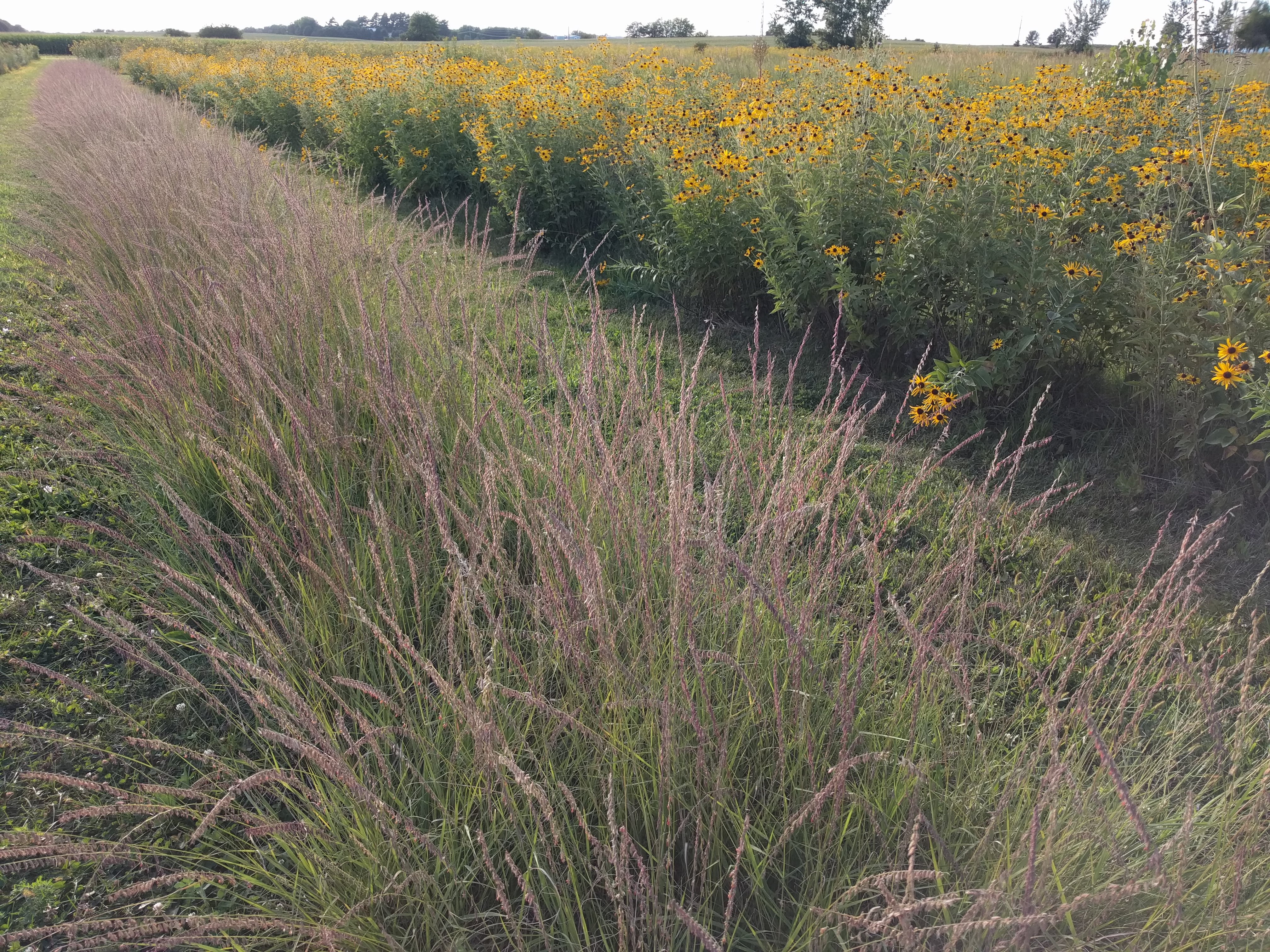
- Leaves and stem
Leaves mostly basal with leaf blades 6-8 in long and tapered to a sharp point; stiff hairs with glandular bases evenly spaced along the leaf margins, sticking out at a right-angle from the main axis of the blade; lower leaves curl and turn a light, tawny color when dry; ligule a very short fringe of hair; nodes hairless and green to purple; flowering stem is smooth and erect.
- Flower, fruit and seedhead
Fruit/seedhead: Seed head 4-12 in long consisting of many short oat-like spikes (0.5-1.25 in long), each with 3-7 spikelets all turned to one side of the main stem, giving rise to the common name “sideoats;” entire spike falls when mature, leaving a naked stalk with visible nodes.
Pollination: Wind
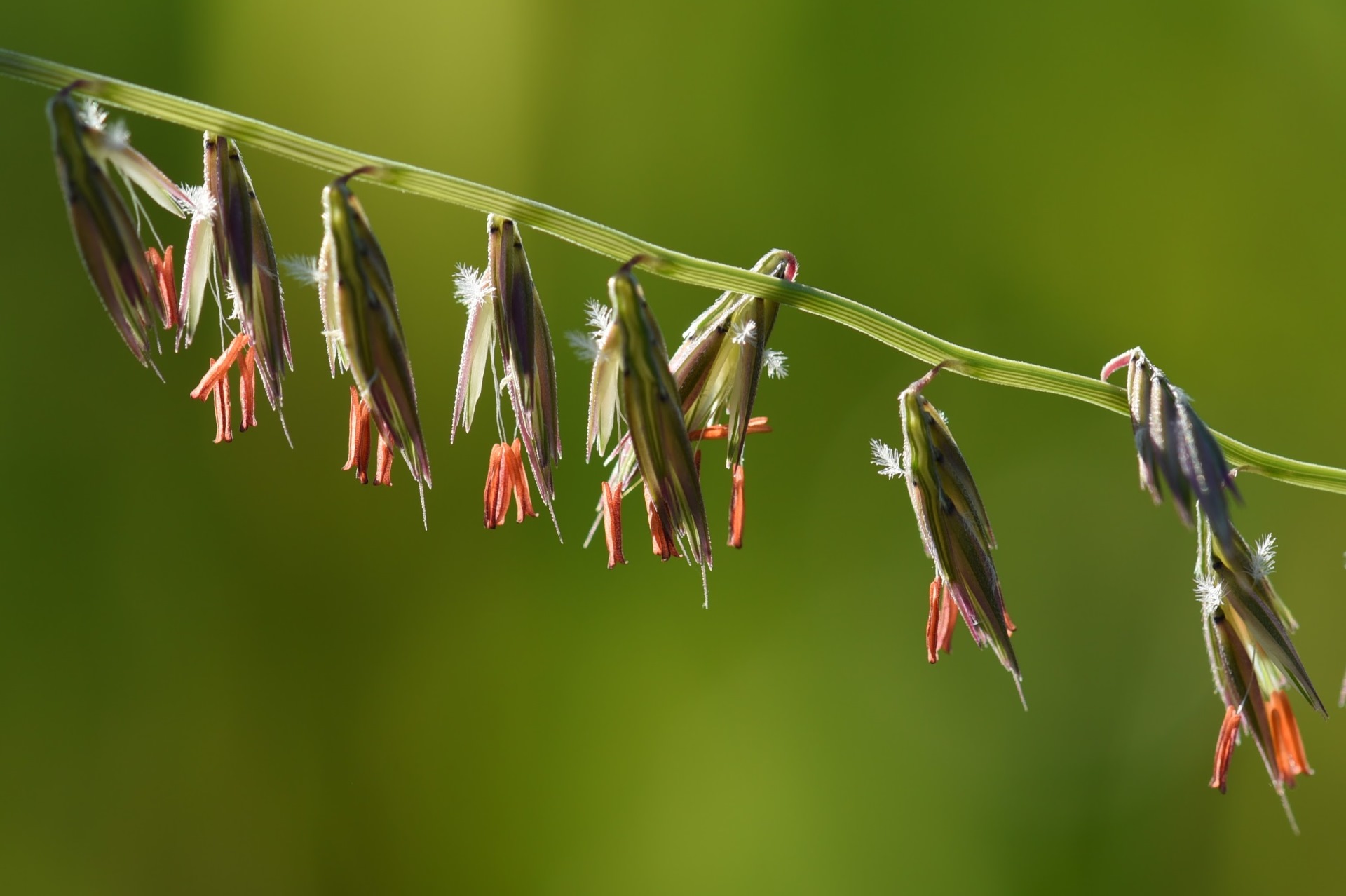
- Seed
Seed characteristics
Seeds per ounce: 6,000 (IA NRCS)
Seeds per pound: 96,000 (IA NRCS)
1000 seed weight: 1.30 g (Seed Information Database)
Description: Seed unit is a whole spike, fragment of spike, or floret. Although a seed unit may contain more than one germinable seed, it is counted as a single live seed in the calculation of pure live seed. Caryopsis (grain) 3-4 mm long, smooth brown.
Typical seed test
PLS: 89% (n = 12)
Purity: 96% (n = 12)
Germination: 59% (n = 11)
Dormant: 34% (n = 11)
(average of n tests of purchased seed lots)
- Habitat and range
Habitat: Dry to mesic, fine textured, calcium-rich soil; full sun; prairies, bluffs, along railroads, woodland openings. Well-drained soils are preferred for seed production.
Conservation status: Global- G5, secure; District of Columbia- SH, possibly extirpated; Connecticut, Louisiana, Florida, and Michigan- S1, critically imperiled; Georgia, Maryland, Nevada, New York, and Pennsylvania- S2, imperiled; Indiana and West Virginia- S3, vulnerable (NatureServe)
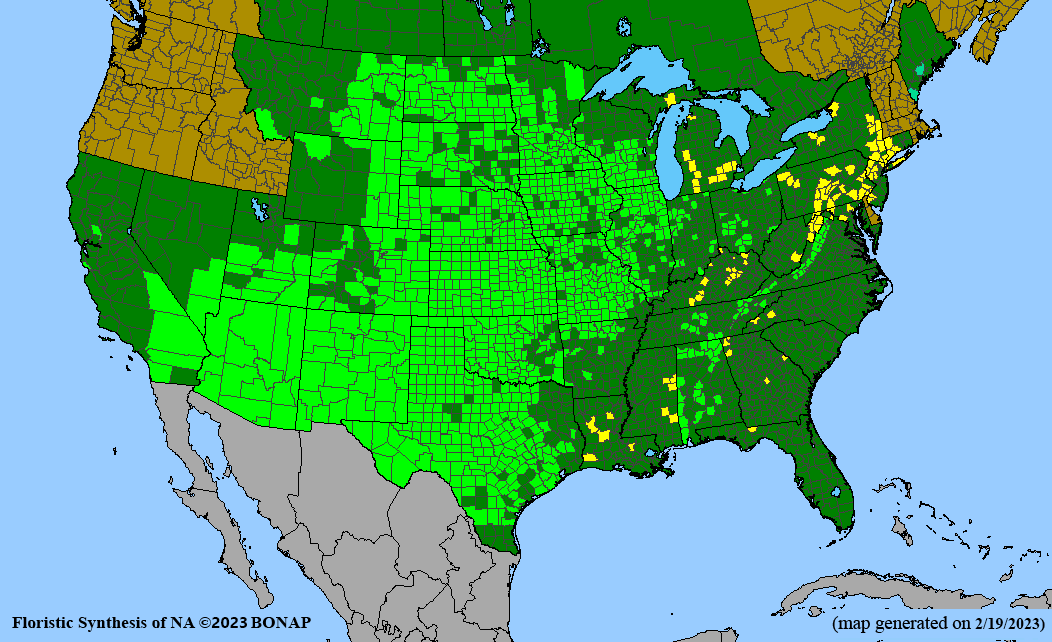
General Comments
Sideoats grama is an important component of tall and mixed-grass prairies, occurring on well-drained, dry, rocky, alkaline soils. This species establishes readily from direct seeding, particularly if seeded into crop ground where good weed control has been achieved (following a glyphosate-resistant crop, for example). The foliage provides forage for mammalian herbivores as well as specialist and generalist insects, and grassland birds feed on the seeds.
Recommendations for Seed Production
- Establishment for seed production
Direct seeding
Row spacing: 36 in 24 in 12 in solid stand PLS lbs/acre: 3 4 8 9 Seeding depth: 1/4-1/2 in
Seeding method: native seed drill
Seeding time: Late spring when soil temperature reaches 55° F.
Weed control: Prepare clean, firm, weed free seedbed prior to seeding.
Greenhouse
Seed pre-treatment: No stratification necessary. Germination of grass seed usually improves with proper storage (cool, dry conditions) throughout the first year after harvest.
Sowing: Sow seed in greenhouse two months before last frost free date at 1/4 in depth.
Transplanting: Transplant into prepared beds at 12 in spacing after all danger of frost.
- Stand management
Weeds: Mow stands high (6-12 in) in first growing season to prevent weed canopy from shading seedlings. Do not use atrazine the year of establishment. On established stands, Plateau (imazapic); Outlook (dimethenamid-P), and 2,4-D have been used. Hand roguing removes weeds that could contaminate seed, cultivation or mowing can be used between rows, and burning in late spring helps control cool season weeds and may prevent buildup of disease inoculum.
Pests: Gall midge larvae have been observed within spikelets.
Diseases: Stem and leaf rust and other fungi are known to occur.
- Seed production
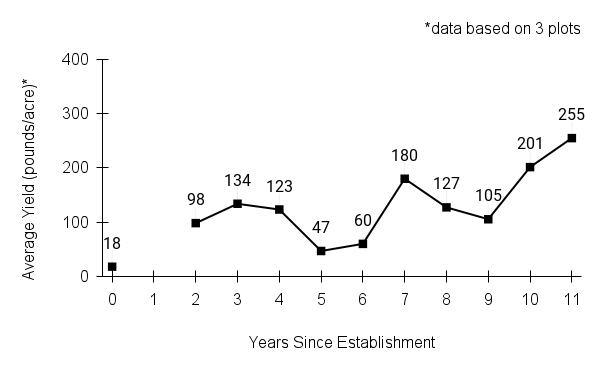
First harvest: Flowering and seed set end of second growing season from greenhouse grown transplants.
Yield: 20-255 bulk pounds/acre (per acre yields extrapolated based on production from 3 plots)
Stand life: Peak harvests third year and after. Annual late spring fire when shoots are 1 in tall helps control weeds and increase flowering and seed production. (Note: This recommendation is strictly for production fields, not remnant prairies.) Stand should persist 10 years or more if properly matched to soils and well managed.
Flowering date: mid-June - early July in northern Iowa
Seed maturity/Harvest date: September in northern Iowa
Seed retention: Holds seed fairly well, shattering occurs in October. Monitor fields fairly often as they mature and consider harvest when about 10% of stems have lost some spikelets from the top.
Harvest date range at TPC (2003-2023): Sept 1 - Oct 30
Recommended harvest method: Combine at hard dough stage.
- Seed cleaning and storage
Cleaning process: Combine-harvested sideoats grama can be air screened initially to sort spikelets from plant fragments. Larger intact spikes can be run quickly through a debearder or hammer mill to break up spikes, and re-air screen. Indent to remove foxtail or other short-seeded weeds.
Seed storage: cool/dry (33-50° F, 30-50% RH)
Released Germplasm
Source Identified material: Central Iowa Germplasm (IA Zone 2), Northern Iowa Germplasm (IA Zone 1), Southern Iowa Germplasm (IA Zone 3), Northern Missouri Germplasm
Selected Germplasm: South Texas Germplasm (TX)
Cultivated variety (cultivar): Midwest adapted cultivars include El Reno (KS), Haskell (TX), Niner (NM), Pierre (ND), Premier (TX), Vaughn (NM).
Informal Variety: Killdeer (ND)
- References
Chayka, K. (n.d.). Bouteloua curtipendula (side-oats grama). Minnesota Wildflowers. https://www.minnesotawildflowers.info/grass-sedge-rush/side-oats-grama
Gleason, H. A., & Cronquist, A. (1991). Poaceae. In Manual of Vascular Plants of Northeastern United States and Adjacent Canada (2nd ed., pp. 795-796). The New York Botanical Garden.
Hilty, J. (2019). Side oats grama - Bouteloua curtipendula. Illinois Wildflowers. https://www.illinoiswildflowers.info/grasses/plants/so_grama.htm
Houseal, G. A. (2007). Grasses warm season. In G. A. Houseal (Eds.), Tallgrass Prairie Center’s native seed production manual (pp. 68–69). Tallgrass Prairie Center - University of Northern Iowa.
Kartesz, J.T., The Biota of North America Program (BONAP). 2023. North American Plant Atlas. (http://bonap.net/napa). Chapel Hill, N.C. [maps generated from Kartesz, J.T. 2023. Floristic Synthesis of North America, Version 1.0. Biota of North America Program (BONAP). (in press)]
NatureServe. 2024. NatureServe Network Biodiversity Location Data accessed through NatureServe Explorer [web application]. NatureServe, Arlington, Virginia. Available https://explorer.natureserve.org/. (Accessed: February 29, 2024).
USDA NRCS National Plant Data Team. (n.d.). Bouteloua curtipendula (Michx.) Torr. USDA plants database. https://plants.usda.gov/home/plantProfile?symbol=BOCU
Species Guide Updated 12/13/2024
switchgrass
switchgrass dickeye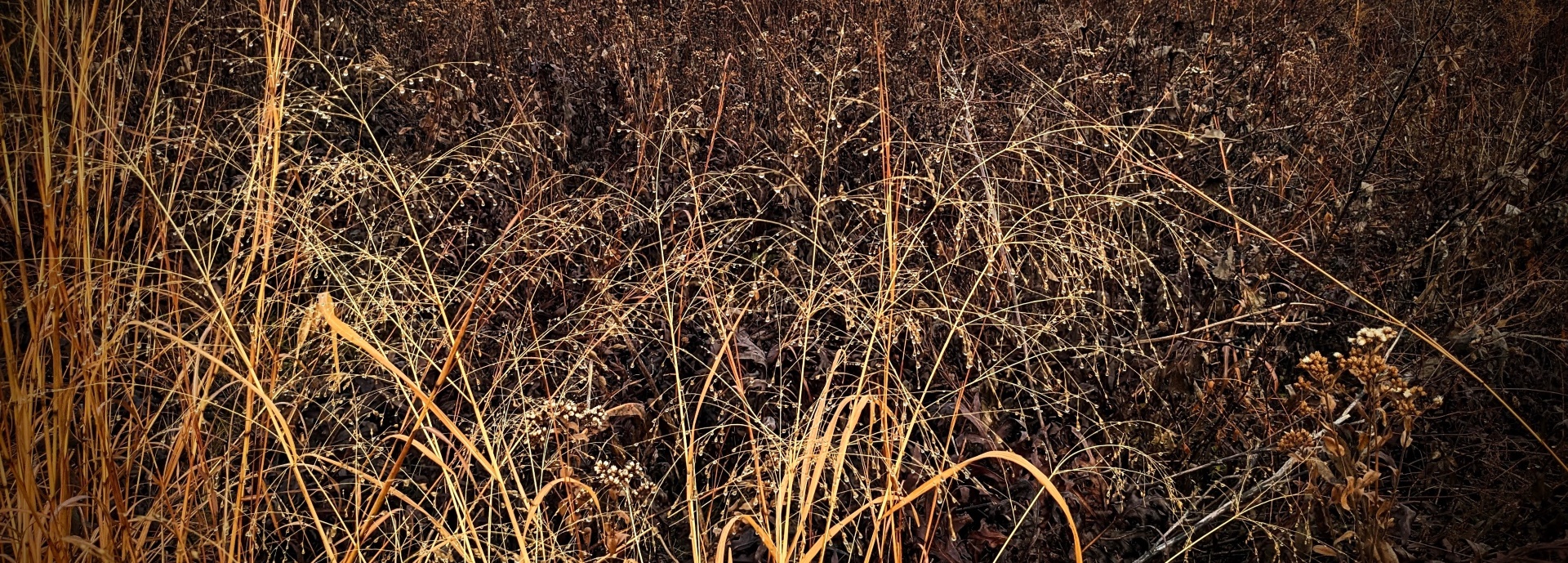
Panicum virgatum, (L.)
Alternate Common Names: thatchgrass, Wobsqua grass, blackbent, tall panic grass, old switch panicgrass
Scientific Synonyms: Panicum virgatum var. spissum, Panicum virgatum var. cubense, Panicum bavardii
Family: grass family (Poaceae)
Functional Group: warm season grass
Description
- Life cycle and growth form
Warm season perennial, rhizomatous, forms clonal patches with many stems that expand over time.
Height: 3-6 ft
- Leaves and stem
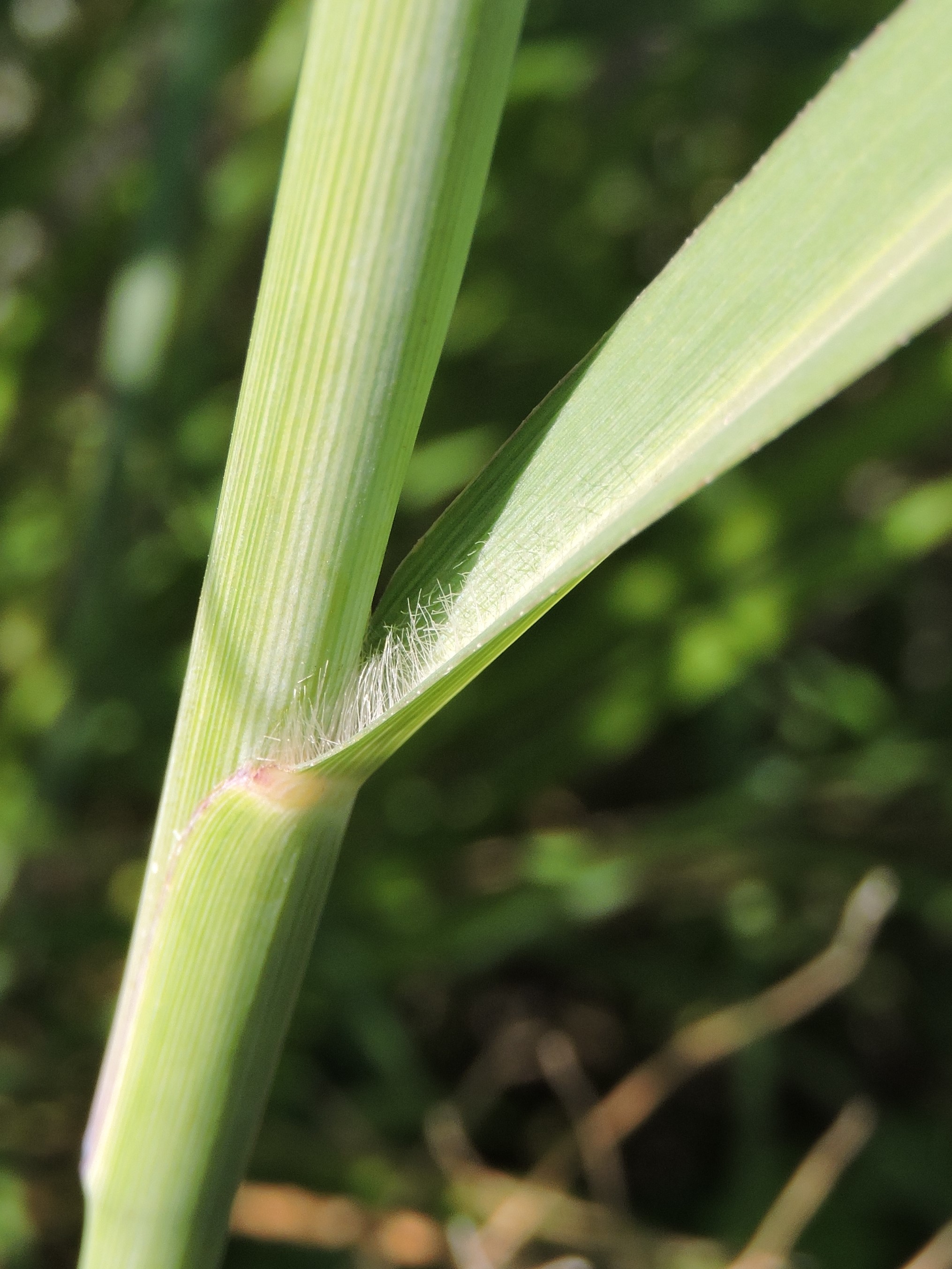
Leaf blades 5/16 in wide and 6-22 in long, often hairy on the upper surface, especially near the ligule, ligule is fringe of dense hairs about 1/8 in tall; stem erect and hairless.
- Flower, fruit and seedhead
Fruit/seed head: Seedhead is an openly branched, airy panicle 8-16 in long with green to purple spikelets near the ends of the branches.
Pollination: wind
- Seed
Seed characteristics
Seed weight:
Seeds per ounce: 14,000 (IA NRCS)
Seeds per pound: 259,000 (IA NRCS)
1000 seed weight: 1.30 g (Seed Information Database)
Description: Spikelet is two-flowered with the fertile floret uppermost, smooth, awnless. Grain is shiny, smooth, 3-4 mm (about 1/8 in) long.
Typical seed test
PLS: 91% (n = 9)
Purity: 97% (n = 9)
Germination: 49% (n = 7)
Dormancy: 44% (n = 7)
(averages obtained from n tests of purchased seed lots)
- Habitat and range
Habitat: Mesic to wet-mesic soil; full sun; prairies, savannas, streambanks, shorelines, dunes, woodland openings, roadsides, along railroads, ditches; may become abundant in disturbed prairies, much less common in high quality prairies. Wetland Indicator Status is Facultative (FAC) for the Midwest. Fertile, well-drained soils are preferred for seed production.
Conservation status: Global- G5, secure; Nevada- S2, imperiled; Vermont and Wyoming- S3, vulnerable (NatureServe)
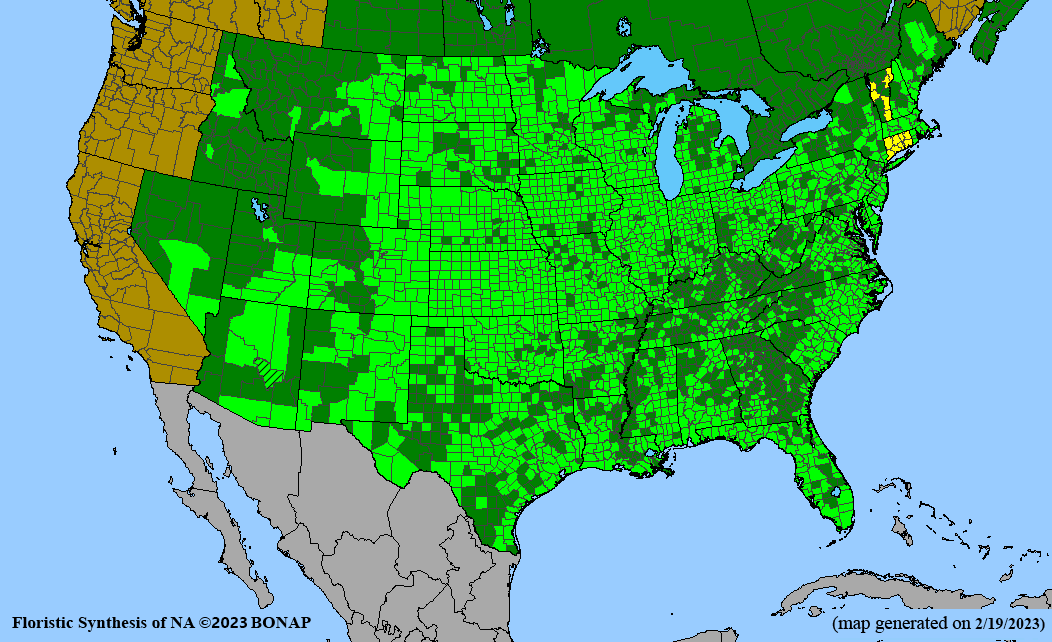
General Comments
A number of cultivars of switchgrass have been developed for forage and seed production, winter hardiness, and grazing tolerance by the USDA-NRCS Plant Materials program. These cultivars have been planted widely as monocultures and in early prairie reconstructions. Because seed has been commercially available at affordable prices for decades, it was usually seeded heavily and tended to dominate stands. For these reasons it has been considered aggressive. Switchgrass can form dense colonies on lowland prairies, but is usually uncommon on high-quality remnant upland prairies and tends to occur in isolated patches near disturbance activities such as gopher mounds (Weaver 1954). Switchgrass establishes readily from seed, and is relatively easy to harvest and clean.
Recommendations for Seed Production
- Establishment for seed production
Direct seeding
Row spacing: 36 in 24 in 12 in Solid Stand PLS lbs/acre: 2.6 3.5 6.0 6.0 Seeding depth: 1/4 in
Seeding method: Native seed drill or broadcast seed and cultipack for solid stand.
Seeding time: Spring
Weed control: Prepare clean, firm, weed free seedbed prior to seeding.
Greenhouse
Seed pre-treatment: Moist stratify seed for 4 weeks to improve germination.
Sowing: Sow seed in greenhouse two months before the last frost free date at 1/4 in depth.
Transplanting: Transplant after all danger of frost into rows convenient for tillage equipment.
- Stand management
Weeds: Mow stands high (6-12 in) first growing season to prevent weed canopy from shading seedlings. Broadleaf herbicides can be used to control broadleaf weeds in established stands. Switchgrass is atrazine resistant, and can be applied at the label rate at planting time. Read and follow label instructions.
Pests: None noted.
Diseases: Seed smut, if left unchecked, can seriously decrease seed yields on switchgrass. The smut is caused by a fungus, Tilletia maclaganii. Glumes may exhibit an uncharacteristic purple coloration, and seeds are replaced by fungal spores that are red-orange when immature turning dark brown at maturity. Fields may need to be destroyed or relocated if diseased (NRCS 2003).
- Seed production
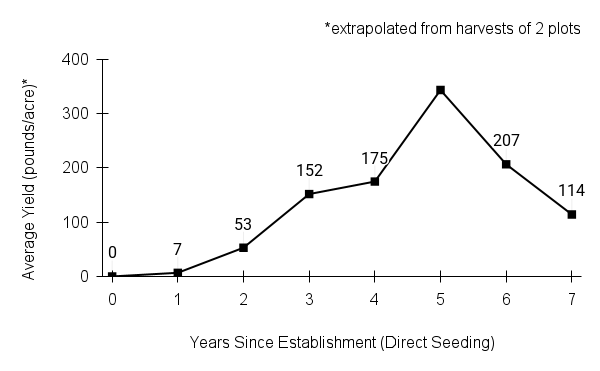 First harvest: Flowering and seed set end of first growing season from greenhouse grown transplants, second growing season from direct seeding.
First harvest: Flowering and seed set end of first growing season from greenhouse grown transplants, second growing season from direct seeding.Yield: 150-350 bulk pounds/acre (per acre yields extrapolated based on harvests of 2 plots)
Stand life: Stands should persist 10-15 years or more. Good seed production second year and after.
Flowering date: late July - early September in northern Iowa
Seed maturity/Harvest date: September in northern Iowa
Seed retention: Shattering begins in late September to early October
Harvest date range at TPC (2003-2010): Sept 16 - Nov 2
Recommended harvest method: Combine at hard dough stage before significant shattering has occurred.
- Seed cleaning and storage
Cleaning process: Pre-clean air-dried material by scalping thru 1/2 in and 1/4 in mesh to remove large particles. Brush to remove all floral parts from the grain, air-screen to clean.
Seed storage: cool/dry (33-50° F, 30-50% RH)
Released Germplasm
Source Identified material: Natural Selections/Iowa Ecotype Projects Zones 1 (northern Iowa), 2 (central Iowa), and 3 (southern Iowa)
Cultivated varieties (cultivars): Mid-west adapted include Blackwell (KS), Cave-In-Rock (IL), Dacotah, Forestburg (ND), Nebraska 28 (NE), Shawnee (MO)
- References
Chayka, K. (n.d.). Panicum virgatum (switchgrass). Minnesota Wildflowers. https://www.minnesotawildflowers.info/grass-sedge-rush/switchgrass
Freckmann, R. W. & Lelong, M. G. (2021, May 11). Panicum virgatum L. Flora of North America. http://floranorthamerica.org/Panicum_virgatum
Hilty, J. (2019). Switch grass - Panicum virgatum. Illinois Wildflowers. https://www.illinoiswildflowers.info/grasses/plants/switchgrass.htm
Houseal, G. A. (2007). Grasses warm season. In G. A. Houseal (Eds.), Tallgrass Prairie Center’s native seed production manual (pp. 70–71). Tallgrass Prairie Center - University of Northern Iowa.
Kartesz, J.T., The Biota of North America Program (BONAP). 2023. North American Plant Atlas. (http://bonap.net/napa). Chapel Hill, N.C. [maps generated from Kartesz, J.T. 2023. Floristic Synthesis of North America, Version 1.0. Biota of North America Program (BONAP). (in press)]
NatureServe. 2024. NatureServe Network Biodiversity Location Data accessed through NatureServe Explorer [web application]. NatureServe, Arlington, Virginia. Available https://explorer.natureserve.org/. (Accessed: February 29, 2024).
USDA NRCS National Plant Data Team. (n.d.). Panicum virgatum L. USDA plants database. https://plants.usda.gov/home/plantProfile?symbol=PAVI2
Species Guide Updated 12/5/2025
Cool Season Grasses
Cool Season Grasses sagemThe Species Production Guides for cool season grasses provide specific information about growing each of these species for seed production.
A printable file (pdf) is also provided on each species page for those needing a print version.
This section is a work in progress. We will continue to add new species guides as they are completed.
Bromus kalmii / arctic brome
Elymus villosus / hairy wildrye
Festuca paradoxa / clustered fescue
Glyceria striata / fowl mannagrass
Hesperostipa spartea / porcupinegrass
Canada wildrye
Canada wildrye dickeye
Elymus canadensis L.
Alternate Common Name(s): nodding wildrye, western wildrye, great plains wildrye
Scientific Synonym(s): Elymus brachystachys Scribn. & C.R. Ball, Elymus canadensis L. var. brachystachys (Scribn. & C.R. Ball) Farw., Elymus canadensis L. var. hirsutus (Farw.) Dorn, Elymus canadensis L. var. robustus (Scribn. & J.G. Sm.) Mack. & Bush, Elymus crescendus L.C. Wheeler, Elymus philadelphicus L., Elymus philadelphicus L. var. hirsutus Farw., Elymus robustus Scribn. & J.G. Sm.
Family: grass family (Poaceae)
Functional Group: cool season grasses
Printable PDF Elymus canadensis
PDF will be added soon
Description
- Life cycle and growth form
Perennial, cool-season bunchgrass, weak to no rhizomes.
Height: 1-5 ft
- Leaves and stem
Leaf blades up to 16 in long, 1/4-3/4 in wide, ligule a short (up to 1 mm) membrane, sheaths usually smooth with two small, purplish to brown lobes (auricles) clasping stem where the sheath meets the blade, nodes hairless and hidden under the sheaths; stems smooth, erect, unbranched.
- Flower, fruit and seedhead
Fruit/seedhead: Seedhead a thick, bristly spike, 3-10 inches long, usually nodding, light tan when mature, each spikelet with a pair of awned glumes (up to 1.5 in including the awn) and 3-5 florets, lemmas (chaffy parts around the grain) also awned (up to 2.5 in including the awn), awns twist and curve outward when dry, florets drop when mature, leaving glumes on the stalk.
Pollination: wind
- Seed
Seed characteristics
Seeds per ounce: 5,200 (IA NRCS)
Seeds per pound: 83,200 (IA NRCS)
1000 seed weight: 4.50 g (Seed Information Database)
Description: The long, barbed awns make this species difficult to clean. Curved awns on lemmas are up to 5 cm (2 in). Glumes taper to awns 1-3 cm (1/2-1.25 in) long. Caryopsis dark brown at maturity, 5-8 mm long.
Typical seed test
PLS: 88%
Purity: 96%
Germination: 66%
Dormant: 19%
(averages obtained from 12 tests of purchased seed lots)
- Habitat and range
Habitat: Broadly adapted to a range of conditions: dry to moist soil; partial to full sun; prairies, savannas, woodland edges, bluffs, dunes, riverbanks, upland and lowland, open areas, disturbed areas. Wetland Indicator Status is Facultative Upland (FACU) for the Midwest. Well-drained, loamy soils are preferred for production.
Conservation status: Global- G5, secure; Maine- SH, possibly extirpated; Nevada and Virginia- S1, critically imperiled (NatureServe)
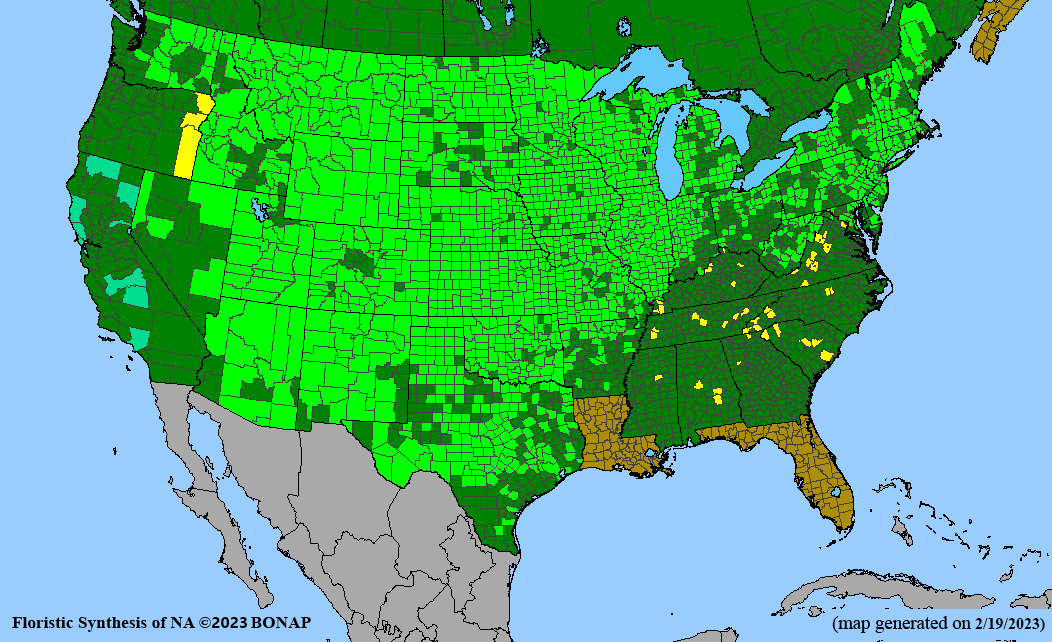
General Comments
Canada wildrye is a relatively short-lived perennial bunchgrass which establishes readily from seed in mixed plantings. These two traits make it ideally suited as a nurse crop for prairie restorations. It can also be direct-seeded as a seed production field into a well-prepared, weed-free seed bed (e.g., following a glyphosate-resistant crop).
Recommendations for Seed Production
- Establishment for seed production
Direct seeding
Row spacing: 36 in 24 in 12 in solid stand PLS lbs/acre: 7 10.5 21 21 Seeding depth: 1/4-1/2 in
Seeding method: native seed drill
Seeding time: Fall, or early spring preferred.
Weed control: Prepare clean, firm, weed free seedbed prior to seeding.
Greenhouse
Seed pre-treatment: No stratification necessary. Germination of grass seed usually improves with proper storage (cool, dry conditions) throughout the first year after harvest.
Sowing: Sow seed in greenhouse two months before last frost free date at 1/4 in depth.
Transplanting: Transplant at 12 in spacing in prepared beds after all danger of frost.
- Stand management
Weeds: Mow stands high (6–12 in) first growing season to prevent weed canopy from shading seedlings. Broadleaf herbicides can be used to control broadleaf weeds in established stands.
Pests: None noted.
Diseases: Susceptible to leaf and stem rust, also ergot.
Hybridization risk: This species is known to hybridize with related species Elymus hystrix, E. villosus, E. virginicus
- Seed production
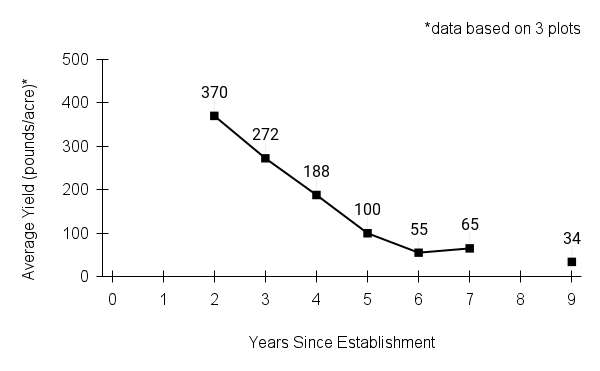
First harvest: Flowering and seed set will occur at the end of the first growing season from previous fall seeding or early spring seeding, or late spring transplants.
Yield: 35-370 bulk pounds/acre (per acre yield extrapolated from 3 plots)
Stand life: 4-6 years. Seed production declines significantly in the fifth year and after. Annual fall burning will prolong stand life and seed yield.
Flowering date: mid-July to mid-August in northern Iowa
Seed maturity/Harvest date: September in northern Iowa
Seed retention: shattering occurs early to mid-October
Harvest date range at TPC (2003-2010): Sept 7 - Nov 4
Recommended harvest method: Combine at maturity (hard dough stage). Long, barbed awns make harvesting a challenge, causing seed to ball up and not flow. Additional de-awning bars or other modifications to the combine may be required for successful harvest of this species.
- Seed cleaning and storage
Cleaning process: Debeard or brush to remove long awns and make the material flowable. Air-screen to clean (See Appendix C for settings).
Seed storage: cool/dry (33-50° F, 30-50% RH)
Released Germplasm
Source Identified material: Central Iowa Germplasm (IA Zone 2), Northern Iowa Germplasm (IA Zone 1), Southern Iowa Germplasm (IA Zone 3)
Selected Germplasm: Lavaca Germplasm (TX)
Cultivated variety (cultivar): Mandan (ND)
Tested: Icy Blue Germplasm (MI)
- References
Barkworth, M. E., Campbell, J. J.N., & Salomon, B. (2021, May 11). Elymus canadensis L. Flora of North America. http://floranorthamerica.org/Elymus_canadensis
Chayka, K. (n.d.). Elymus canadensis (Canada wild rye). Minnesota Wildflowers. https://www.minnesotawildflowers.info/grass-sedge-rush/canada-wild-rye
Cochrane, T. S., Elliot, K., & Lipke, C. S. (2014). Canada wild-rye. In Prairie plants of the University of Wisconsin-Madison Arboretum (3rd ed., p. 264). University of Wisconsin-Madison Arboretum.
Great Plains Flora Association. (1991). Grass family. In T. M. Barkley, R. E. Brooks, & E. K. Schofield (Eds.), Flora of the Great Plains (2nd ed., p. 1167). University Press of Kansas.
Houseal, G. A. (2007). Grasses cool season. In G. A. Houseal (Eds.), Tallgrass Prairie Center’s native seed production manual (pp. 84–85). Tallgrass Prairie Center - University of Northern Iowa.
Kartesz, J.T., The Biota of North America Program (BONAP). 2023. North American Plant Atlas. (http://bonap.net/napa). Chapel Hill, N.C. [maps generated from Kartesz, J.T. 2023. Floristic Synthesis of North America, Version 1.0. Biota of North America Program (BONAP). (in press)]
NatureServe. 2024. NatureServe Network Biodiversity Location Data accessed through NatureServe Explorer [web application]. NatureServe, Arlington, Virginia. Available https://explorer.natureserve.org/. (Accessed: February 29, 2024).
USDA NRCS National Plant Data Team. (n.d.). Elymus canadensis L. USDA plants database. https://plants.usda.gov/home/plantProfile?symbol=ELCA4
Species Guide Updated 01/31/2025
Virginia wild rye
Virginia wild rye dickeye
Elymus virginicus L.
Alternate Common Name: Terrell grass
Family: grass family (Poaceae)
Functional Group: cool season grasses
Description
- Life cycle and growth form
Perennial, cool season bunchgrass with fibrous roots.
Height: 1-4 ft
- Leaves and stem
Leaf blades mostly flat but sometimes with inrolled edges, rough textured, 12-35 cm (5-14 in) long and 5-15 mm (1/4-5/8 in) wide, sheath sometimes with fine hairs; ligule a short membrane bracketed by two small, often purplish projections (auricles) that may wrap partway around the stem. Stems unbranched, smooth and erect, multiple from the base making clumps.
- Flower, fruit and seedhead
Fruit/seedhead: Seed head is an erect spike 5-17 cm (2-7 in) long (distinguishing it from Canada wildrye which has drooping spikes), often partially enclosed in the uppermost, inflated leaf sheath, light straw-colored at maturity. Spikelets bear awns up to 1 in long. Spikelets eventually drop off, leaving a naked stalk with alternating nodes.
Pollination: wind
- Seed
Seed characteristics
Seed weight:
Seeds per ounce: 4,200 (IA NRCS)
Seeds per pound: 67,200 (IA NRCS)
1000 seed weight: 6.14 g (Seed Information Database)
Description: Typical seed unit is a spikelet with 2-3 florets, awned, 0.5-2 cm (1/4-7/8 in) long including awns. Empty scales (glumes) on either side of spikelet thickened, rigid, awned, up to 2.5 cm long (1 in) long including awn. Awn length is highly variable in this species.
Typical seed test
PLS: 96%
Purity: 98%
Germination: 48%
Dormant: 51%
(averages obtained from 9 tests of purchased seed lots)
- Habitat and range
Habitat: Mesic to wet-mesic soil with high fertility; light shade to full sun; deciduous forests, savannas, thickets, meadows near woodlands. Wetland Indicator Status is Facultative Wetland (FACW) for the Midwest. Well-drained loams are preferred for seed production.
Conservation status: Global- G5, secure (NatureServe)

General Comments
Virginia wildrye is commonly found in open forests, savannas, and along woodland edges, and can be particularly abundant in open forests along creeks and rivers. It readily establishes from seed, and holds promise as a nurse crop for prairie and savanna reconstructions. Because of its shade tolerance, it will spread in open woodlands, but eventually gives way to full-sun adapted prairie species in a prairie reconstruction.
Recommendations for Seed Production
- Establishment for seed production
Direct seeding
Row spacing: 36 in 24 in 12 in Solid Stand PLS lbs/acre: 8.6 11.5 23 20-35 Seeding depth: 1/4-1/2 in
Seeding method: native seed drill
Seeding time: Fall or early spring
Weed control: Prepare clean, firm, weed free seedbed prior to seeding (e.g., following a glyphosate-resistant crop, for example).
Greenhouse
Seed pre-treatment: No moist stratification is necessary. Germination of grass seed usually improves with proper storage (cool, dry conditions) throughout the first year after harvest.
Sowing: Sow seed in greenhouse two months before last frost free date at 1/4-1/2 in depth.
Transplanting: Transplant after all danger of frost into rows spaced convenient for tillage equipment or at 12 in spacing in a weed barrier.
- Stand management
Weeds: Mow stands high (6-12 in) first growing season to prevent weed canopy from shading seedlings. Broadleaf herbicides can be used to control broadleaf weeds in established stands. Cultivate or mow between rows.
Pests: Grubs are reportedly a problem in Texas.
Diseases: Ergot is known to occur on seedheads.
Hybridization risk: This species is known to hybridize with related species Elymus canadensis, E. hystrix, E. villosus. Maintain adequate separation between plots of these species.
- Seed production
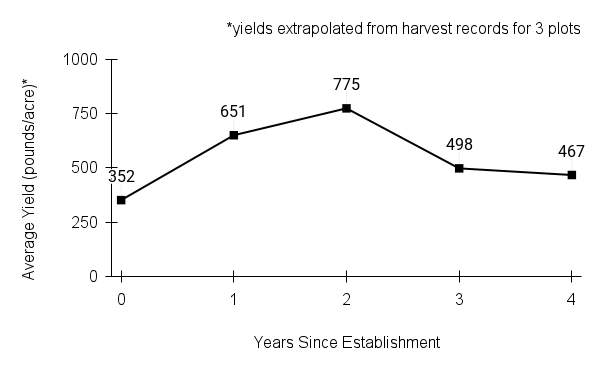 First harvest: Abundant flowering and seed set end of first growing season from greenhouse grown plugs transplanted into a weed barrier.
First harvest: Abundant flowering and seed set end of first growing season from greenhouse grown plugs transplanted into a weed barrier.Yield: 355-775 bulk pounds/acre (per acre yields extrapolated from production on 3 plots)
Stand life: Estimated stand life 5-8 years. Annual early spring burn will prolong the life of the stand.
Flowering date: mid-July to mid-August in northern Iowa
Seed maturity/Harvest date: late August to early September in northern Iowa
Seed retention: Shattering occurs mid to late October; fairly low risk of seed loss.
Harvest date range at TPC (2006-2025): Aug 14 - Nov 22
Harvest date range at Elsberry, MO: Aug 29 to Sept 12
Recommended harvest method: Combine at hard dough stage.
- Seed cleaning and storage
Cleaning process: Pre-clean air-dried material by scalping through 1/2 in mesh to remove large chopped stems and leaves. Debeard or brush gently to remove awns and break up seed heads, then airscreen to clean (see Appendix C for settings).
Seed storage: cool/dry (33-50° F, 30-50% RH).
Released Germplasm
Source Identified material: Natural Selections/Iowa Ecotype Project Zones 1, 2, and 3. Northern Missouri Germplasm
Selected Germplasm: Cuivre River Germplasm (MO), Kinchafoonee Germplasm (TX), Tober Germplasm (ND)
- References
Chayka, K. (n.d.). Elymus virginicus (Virginia wild rye). Minnesota Wildflowers. https://www.minnesotawildflowers.info/grass-sedge-rush/virginia-wild-rye
Hilty, J. (2019). Virginia wild rye - Elymus virginicus. Illinois Wildflowers. https://www.illinoiswildflowers.info/grasses/plants/va_rye.htm
Houseal, G. A. (2007). Grasses cool season. In G. A. Houseal (Eds.), Tallgrass Prairie Center’s native seed production manual (pp. 86–87). Tallgrass Prairie Center - University of Northern Iowa.
Kartesz, J.T., The Biota of North America Program (BONAP). 2023. North American Plant Atlas. (http://bonap.net/napa). Chapel Hill, N.C. [maps generated from Kartesz, J.T. 2023. Floristic Synthesis of North America, Version 1.0. Biota of North America Program (BONAP). (in press)]
NatureServe. 2024. NatureServe Network Biodiversity Location Data accessed through NatureServe Explorer [web application]. NatureServe, Arlington, Virginia. Available https://explorer.natureserve.org/. (Accessed: February 29, 2024).
USDA NRCS National Plant Data Team. (n.d.). Elymus virginicus L. USDA plants database. https://plants.usda.gov/home/plantProfile?symbol=ELVI3
Species Guide Updated 12/3/2025
bluejoint
bluejoint dickeye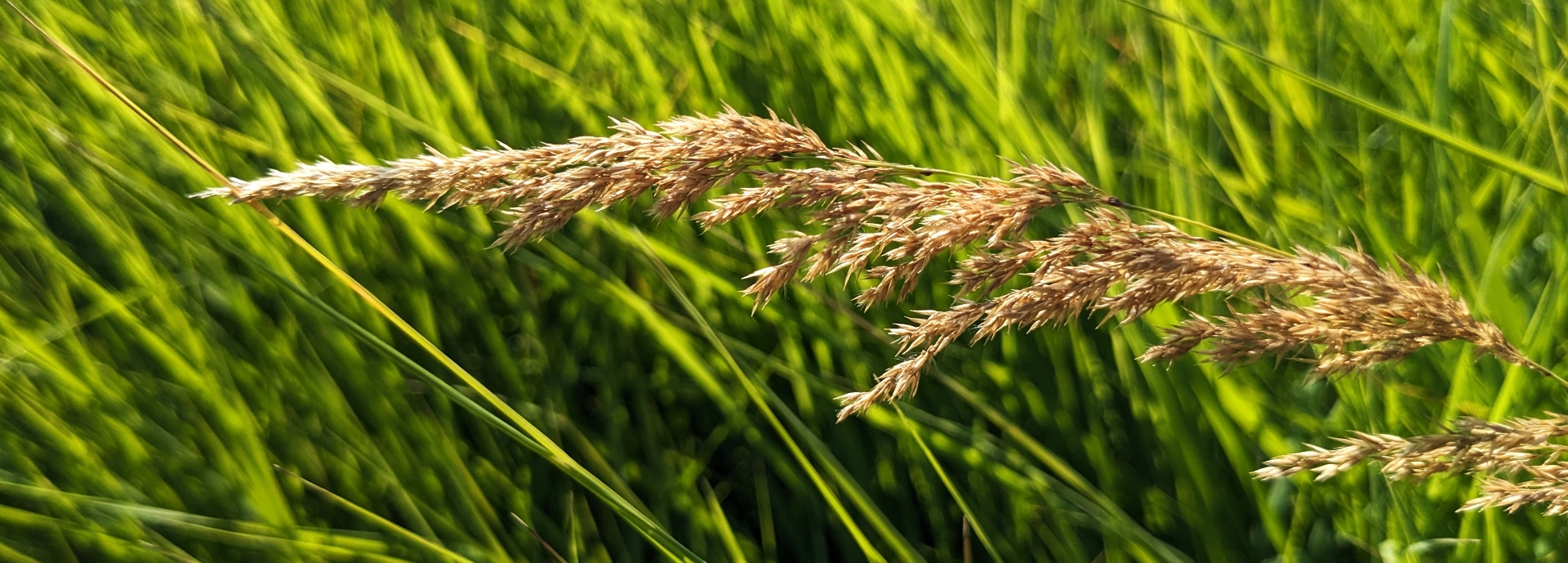
Calamagrostis canadensis (Michx) P. Beauv.
Alternate Common Names: bluejoint reedgrass, Canada bluejoint, Canada reedgrass, marsh reedgrass, meadow pinegrass
Scientific Synonym: Calamagrostis anomala
Family: grass family (Poaceae)
Functional Group: cool season grasses
Description
- Life cycle and growth form
Perennial, rhizomatous grass that forms spreading, hummocky colonies.
Height: Flowering culms 3-5 ft tall
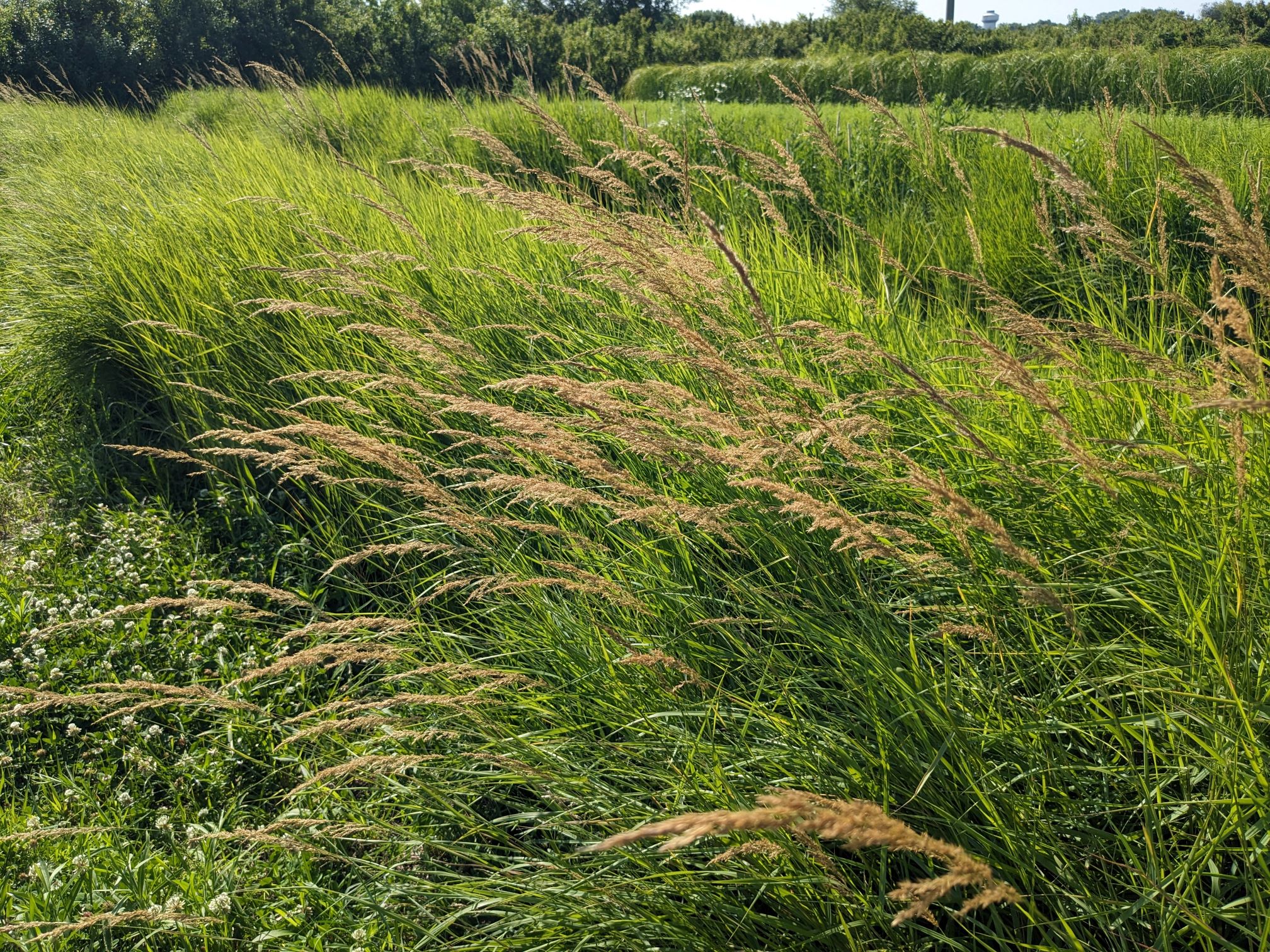
- Leaves and stem
Leaf blades up to 12 in (30 cm) long and 3/16-3/8 in (3-8 mm) wide, leaf sheaths smooth with prominent veins; ligule is membranous, about 1/8 in (3 mm) tall; stems and nodes are hairless; dead leaves and stems accumulate from year to year in absence of fire, forming tussocks.
- Flower, fruit and seedhead
Fruit/seedhead: Mature seed head is a pale gold, loosely branched, plume-like panicle 4-8 in long (10-20 cm), tending to nod to one side; short “flag leaf” just below panicle tends to stick out at a 90 degree angle from the stem; florets fall off when mature, leaving glumes on the stalks.
Pollination: Wind
- Seed
Seed characteristics
Seed weight:
Seeds per ounce: 280,000 (IA NRCS)
Seeds per pound: 4,480,000 (IA NRCS)
1000 seed weight: 0.32 g (Seed Information Database)
Description: Spikelets about 2 mm (3/32 in) long. Grain (caryopsis) about 1/32-1/16 in (1 mm) long, with tuft of hairs at the base slightly shorter than the grain.
Typical seed test
PLS: 90%
Purity: 95%
Germination: 73%
Dormant: 22%
(averages obtained from 4 tests of purchased seed lots)
- Habitat and range
Habitat: Wet-mesic to wet soil; full sun; bogs, marshes, wet swales, along rivers and streams. Tolerates acidic soils up to pH 8 conditions; can tolerate anaerobic (low oxygen) conditions; prefers nutrient-rich, seasonally-inundated soils; irrigation is essential for optimal seed production on upland sites. Wetland Indicator Status is Obligate Wetland (OBL) for the Midwest.
Conservation status: Global- G5, secure; North Carolina, Delaware, and Kansas- S1, critically imperiled; Illinois- S3, vulnerable (NatureServe)
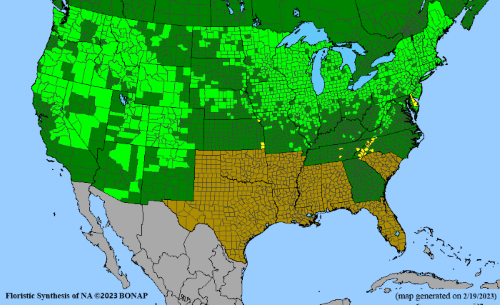
General Comments
Bluejoint is a highly rhizomatous species forming large colonies in preferred habitats, occupying sites even more wet than prairie cordgrass (Spartina pectinata) seems to prefer. Like prairie cordgrass, seed production occurs mostly on the outer edges of colonies, and is generally low. Bluejoint is best propagated in controlled conditions of the greenhouse, and transplanted into wide row spacings.
Recommendations for Seed Production
- Establishment for seed production
Direct seeding
Not recommended for this species
Greenhouse
Seed pre-treatment: No stratification necessary. Germination of grass seed usually improves with proper storage (cool, dry conditions) throughout the first year after harvest.
Sowing: Sow seed on surface of growing mix in greenhouse two months before last frost free date. Water carefully with a mist wand to avoid dislodging seed.
Transplanting: Transplant after all danger of frost. Greenhouse grown plugs can be transplanted into wide row spacing, 6-8 ft between rows, and plants should be 1-2 ft apart within the rows. This gives the newly established plants adequate root-space for rhizome spread, and promotes more flowering and seed set after establishment. Irrigate during establishment and as needed for flowering and seed production.
- Stand management
Weeds: Pre-emergent herbicides can be used after transplanting seedling plugs or pieces of rhizome. It’s critical to water-in transplants to seal soil around roots to prevent herbicide from coming into contact with and possibly damaging roots.
Pests: Nematode (Subanguina calamagrostis) invades leaf tissue and form galls, causing leaves to twist, and allowing subsequent infection by a fungus (Norton 1987).
Diseases: None noted.
- Seed production
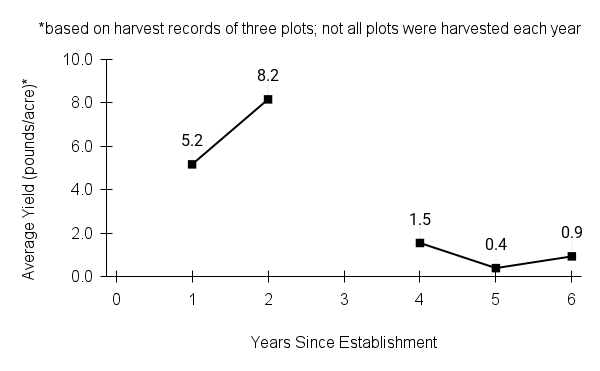 First harvest: Plants remain vegetative first growing season. Some flowering and seed set in the second growing season from greenhouse grown transplants.
First harvest: Plants remain vegetative first growing season. Some flowering and seed set in the second growing season from greenhouse grown transplants.Yield: 0.4-8.2 bulk pounds/acre (yields extrapolated based on production from 3 plots); commercial growers can achieve yields of 20-50 pounds per acre (USDA Plants Guide)
Stand life: Stands are long-lived in proper soils/hydrology. Seed production declines as stands become sod-bound in approximately 4-5 years. Flowering is patchy within a stand and may be higher on the edges of clones.
Flowering date: mid to late June in northern Iowa
Seed maturity: early July in northern Iowa
Seed retention: Shattering occurs soon after maturity, and seed is windblown. Monitor frequently for ripeness and be ready to harvest when inflorescences turn pale, fluffy, and open. The glumes stay on the plant when the seed drops, so seed heads can appear full even after they have shed much of their seed.
Harvest date range at TPC (2003-2008): June 29 - July 10
Recommended harvest method: Hand harvest or combine at maturity, but before dispersal. The seed is very light and wind-dispersed. Turn off air when combining.
- Seed cleaning and storage
Cleaning process: Thresh hand-collected material through 1/4 in screen. Brush seed to remove tuft of hairs at base of florets to improve flow of seed through airscreen (see settings in Appendix C).
Seed storage: Cool/dry (33-50° F, 30-50% RH).
Released Germplasm
Source Identified material: Natural Selections/Iowa Ecotype Zones 1, 2, and 3
Cultivated variety (cultivars): Sourdough (AK)
- References
Alaska DNR. (2007). ‘Sourdough’ Bluejoint Reedgrass Calamagrosis canadensis. [Infographic]. dnr.alaska.gov. https://dnr.alaska.gov/ag/akpmc/pdf/plant-flyers/SourdoughBluejoint.pdf
Chayka, K. (n.d.). Calamagrostis canadensis (Canada bluejoint). Minnesota Wildflowers. https://www.minnesotawildflowers.info/grass-sedge-rush/canada-bluejoint
Hilty, J. (2019). Bluejoint grass - Calamagrostis canadensis. Illinois Wildflowers. https://www.illinoiswildflowers.info/grasses/plants/bluejoint.html
Houseal, G. A. (2007). Grasses cool season. In G. A. Houseal (Eds.), Tallgrass Prairie Center’s native seed production manual (pp. 82–83). Tallgrass Prairie Center - University of Northern Iowa.
Kartesz, J.T., The Biota of North America Program (BONAP). 2023. North American Plant Atlas. (http://bonap.net/napa). Chapel Hill, N.C. [maps generated from Kartesz, J.T. 2023. Floristic Synthesis of North America, Version 1.0. Biota of North America Program (BONAP). (in press)]
Marr, K. L., Hebda, R. J., & Greenef, C. W. (2021). Calamagrostis canadensis (Michx.) P. Beauv. Flora of North America. http://floranorthamerica.org/Calamagrostis_canadensis
NatureServe. 2024. NatureServe Network Biodiversity Location Data accessed through NatureServe Explorer [web application]. NatureServe, Arlington, Virginia. Available https://explorer.natureserve.org/. (Accessed: February 29, 2024).
Norton, D.C., Cody, A.M., Gabel, A.W. (1987) Subanguina calamagrostis and Its Biology in Calamagrostis spp. in Iowa, Ohio, and Wisconsin. The Journal of Nematology, 19(2), 260-262. https://pmc.ncbi.nlm.nih.gov/articles/PMC2618621/
USDA NRCS National Plant Data Team. (n.d.). Calamagrostis canadensis (Michx.) P. Beauv. USDA plants database. https://plants.usda.gov/plant-profile/CACA4
Wynia, R.L. (2006, March 07) Bluejoint Reedgrass Calamagrostis canadensis (Michx.) Beaux. USDA NRCS Plant Guide. https://plants.usda.gov/DocumentLibrary/plantguide/pdf/pg_caca4.pdf
Species Guide Updated 12/1/2025
prairie Junegrass
prairie Junegrass dickeye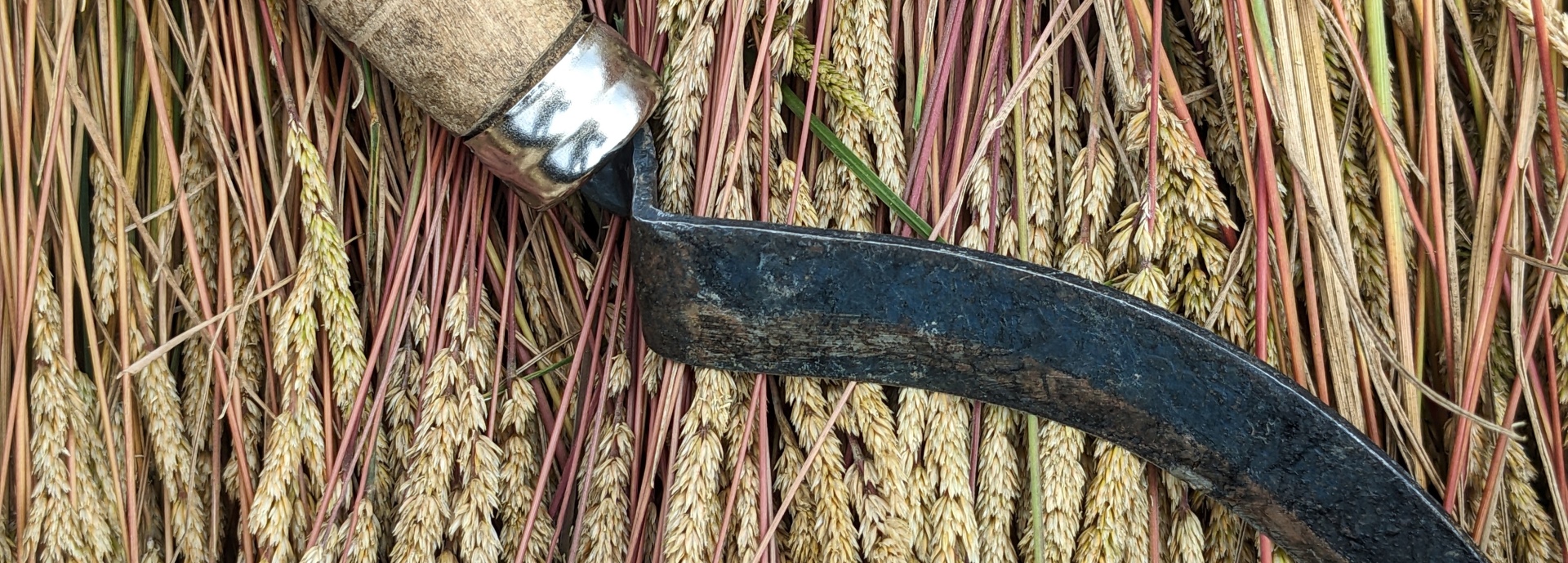
Koeleria macrantha (Ladeb.) Schult.
Alternate Common Names: June grass, Junegrass, crested hair grass, Koeler’s grass
Scientific Synonyms: Koeleria albescens auct., Koeleria cristata auct. non Pers. p.p., Koeleria cristata Pers. var. longifolia Vasey ex Burtt Davy, Koeleria cristata Pers. var. pinetorum Abrams, Koeleria gracilis Pers., Koeleria nitida Nutt., nom. utique rej., Koeleria pyramidata auct. non (Lam.) P. Beauv. p.p., Koeleria yukonensis Hultén, Koeleria nitita, Koeleria cristata Pers. var. pubescens, Koeleria cristata Pers. var. major
Family: grass family (Poaceae)
Functional Group: cool season grasses
Description
- Life cycle and growth form
Perennial, cool-season bunchgrass with fibrous roots.
Height: 0.5-2 ft
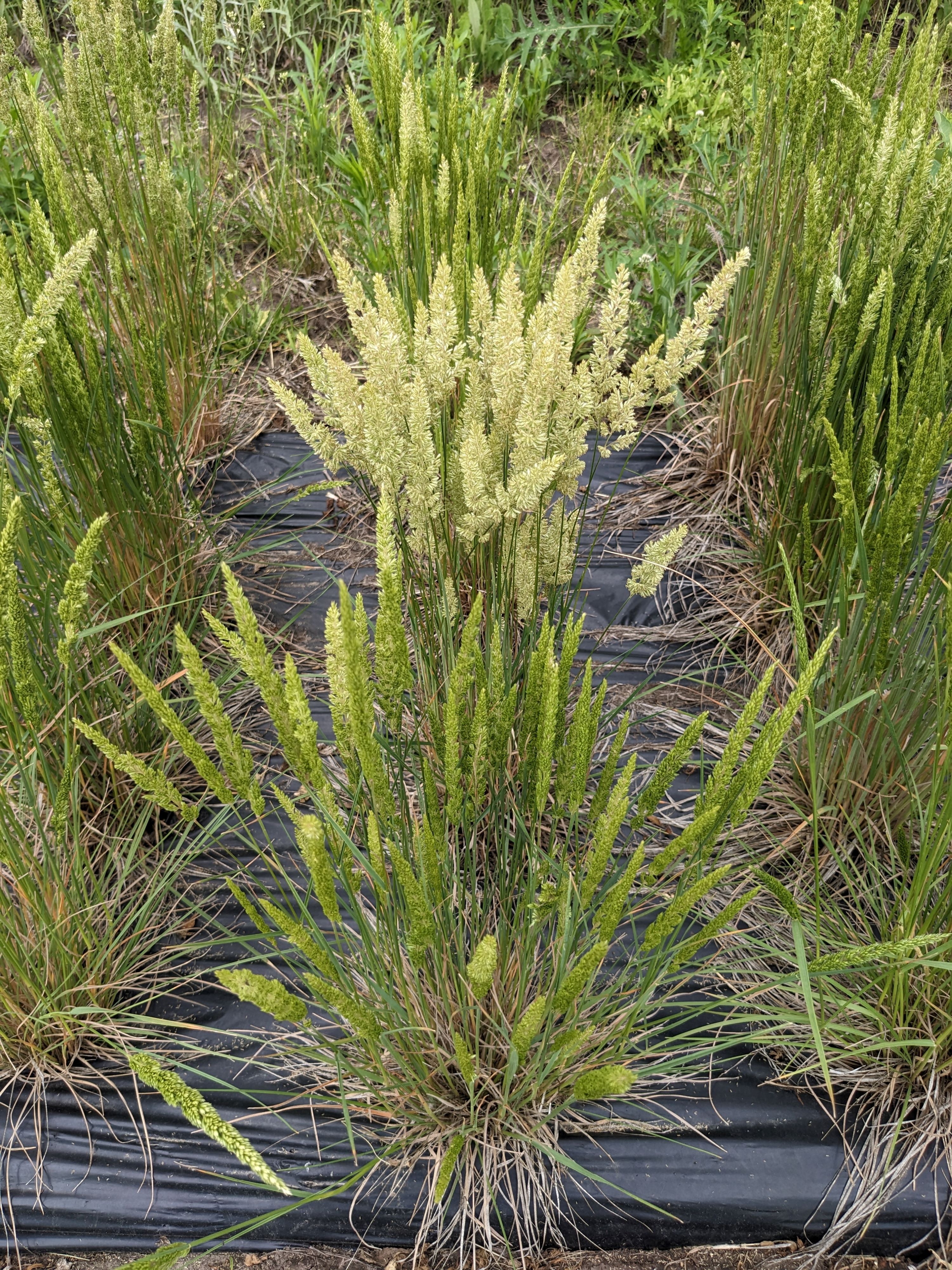
- Leaves and stem
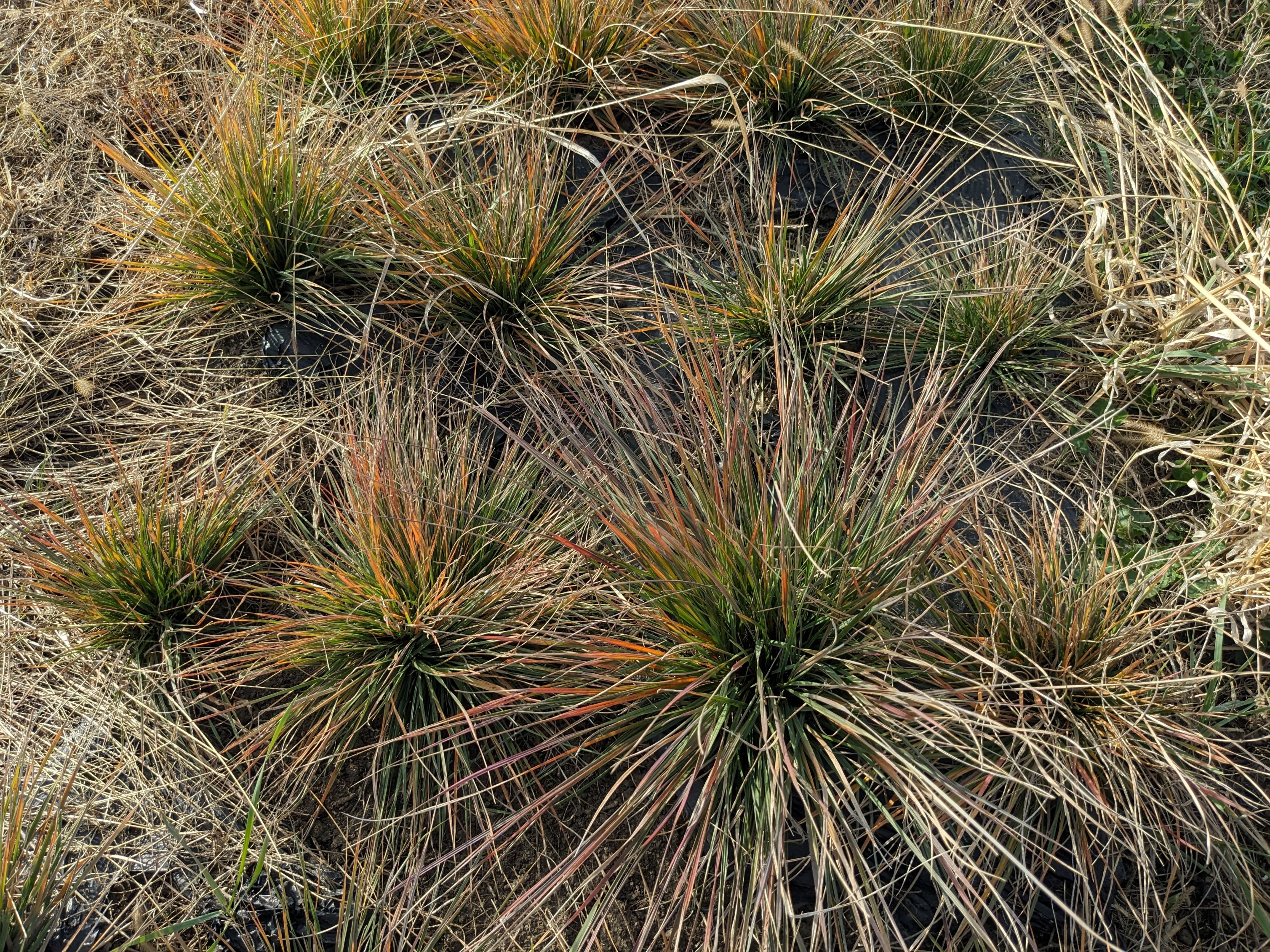
Leaves mostly basal in a distinct tuft, leaf blades 3-25 cm long (1.25-10 in) and 1-4 mm wide (up to 3/16 in), leaf sheaths short-hairy to smooth, with hairs on the margins of the collar, ligule a short (<1 mm), ragged membrane; stem with fine hairs at base of seedhead and at nodes.
- Flower, fruit and seedhead
Fruit/seedhead: Light tan spike-like panicle 3-18 cm long (1.25-7.25 in) and 1-3 cm wide (0.5-1.25 in), stem covered in fine hairs below the seed head. At maturity, seed drops off with surrounding chaffy parts (lemma and palea), but glumes (chaffy parts below the flowers) stay on the stalk.
Pollination: wind
- Seed
Seed characteristics
Seed weight:
Seeds per ounce: 200,000 (IA NRCS)
Seeds per pound: 3,200,000 (IA NRCS)
1000 seed weight: 0.30 g (Seed Information Database)
Description: Seed unit is a grain about 2-3 mm long (1/8 in), with or without surrounding chaffy parts (lemma and palea).
Typical seed test
PLS: 69% (n = 10)
Purity: 76% (n = 10)
Germination: 68% (n = 9)
Dormant: 1% (n = 9)
(averages obtained from n tests of purchased seed lots)
- Habitat and range
Habitat: Full sun. Found in dry, upland, rocky or sandy prairies, becoming more abundant on northern prairies. Very well-drained soils are preferred for seed production.
Conservation status: Global- G5, secure; Pennsylvania- SX, presumed extirpated; Alaska, Kentucky, and Louisiana- S1, critically imperiled; Arkansas and Ohio- S2, imperiled; Nevada- S3, vulnerable (NatureServe)

General Comments
Prairie Junegrass is an important cool-season grass component, particularly in prairies on dry, very well-drained sites. Plants are of medium longevity, poorly tolerant of competition, and may rely on reseeding to persist.
Recommendations for Seed Production
- Establishment for seed production
Direct seeding
Row spacing: 36 in 24 in 12 in Solid Stand PLS lbs/acre: 0.25 0.4 0.75 0.75-1.0 Seeding depth: 1/8 in (light needed for germination)
Seeding method: native seed drill
Seeding time: Late spring
Weed control: Good weed control before seeding is essential. Seedlings are small and slow growing and vulnerable to competition from weeds as well as to mechanical damage from equipment or foot traffic.
Greenhouse
Seed pre-treatment: No stratification necessary, although we have observed improved speed and uniformity of germination following 30-day cold/moist stratification. Germination of grass seed usually improves with proper storage (cool, dry conditions) throughout the first year after harvest.
Sowing: Sow seed on top of soil (or cover only very lightly, seeds require light to germinate) in a greenhouse 8-12 weeks before the last frost free date. Water (or mist) very gently to avoid splattering or floating seeds out of the potting medium.
Transplanting: Transplant into a weed barrier 8-12 in apart after all danger of frost.
- Stand management
Weeds: For plantings in weed barrier, hand rogue weeds while small, being careful not to uproot young seedlings. For direct seeded stands, mow stand high (6–12 inches) in first growing season to prevent weed canopy from shading seedlings. Cultivate or mow vegetation between rows. Broadleaf herbicides can be used to control broadleaf weeds in established stands. Non-native perennial cool-season grasses such as Kentucky bluegrass (Poa pratensis) and smooth brome (Bromus inermis) invade plantings and can outcompete Junegrass, causing declines in production.
Pests: Grubs are reportedly a problem in Texas.
Diseases: Ergot is known to occur on seedheads.
- Seed production
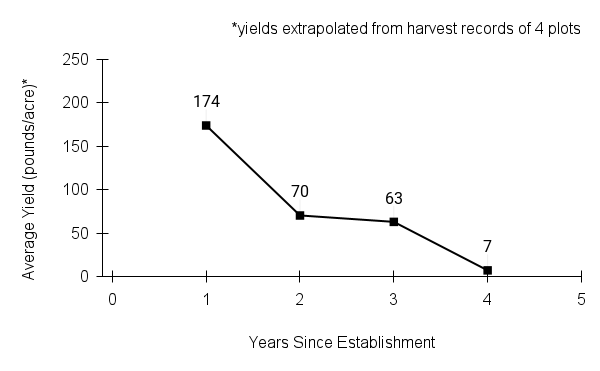 First Harvest: Flowering and seed set at end of second growing season from greenhouse grown transplants. Plants will remain vegetative the first growing season.
First Harvest: Flowering and seed set at end of second growing season from greenhouse grown transplants. Plants will remain vegetative the first growing season. Yield: 10-175 pounds/acre (averages extrapolated from 3 plots)
Stand life: Potentially 4-5 years. Peak harvests occur in second and third year, after which seed production declines significantly. Invasion by non-native cool-season grasses is one cause of yield decline.
Flowering Date: early to late June in northern Iowa
Seed maturity/Harvest date: late June - early July in northern Iowa. Regularly monitor plots for maturity as seed heads change from green to straw colored. Tap seed heads lightly on hand and observe for shattering.
Seed retention: Shattering occurs mid to late July
Harvest date range at TPC (2003-2023): June 22 - July 8
Recommended harvest method: Combine harvesting is practical for larger plots. Swathing/windrowing before combining may improve threshing, uniformity of seed maturation, and reduce shattering due to wind. A modified hedge-trimmer with an attached collection tray works for harvesting small plots.
- Seed cleaning and storage
Cleaning process: Pre-clean air-dried material by scalping thru 1/2 in and 1/4 in mesh to remove large pieces of stems and leaves. Run through a brush machine to break up seed heads, then air-screen to clean (see appendix for settings).
Seed storage: cool/dry (33-50° F, 30-50% RH)
Released Germplasm
Source Identified material: Natural Selections/Iowa Ecotype Project Zone 1 (northern Iowa) and Zone 2 (central Iowa)
- References
Chayka, K. (n.d.). Koeleria macrantha (Junegrass). Minnesota Wildflowers. https://www.minnesotawildflowers.info/grass-sedge-rush/junegrass
Hilty, J. (2019). June grass - Koeleria macrantha. Illinois Wildflowers. https://www.illinoiswildflowers.info/grasses/plants/june_grass.htm
Houseal, G. A. (2007). Grasses cool season. In G. A. Houseal (Eds.), Tallgrass Prairie Center’s native seed production manual (pp. 88–89). Tallgrass Prairie Center - University of Northern Iowa.
Kartesz, J.T., The Biota of North America Program (BONAP). 2023. North American Plant Atlas. (http://bonap.net/napa). Chapel Hill, N.C. [maps generated from Kartesz, J.T. 2023. Floristic Synthesis of North America, Version 1.0. Biota of North America Program (BONAP). (in press)]
NatureServe. 2024. NatureServe Network Biodiversity Location Data accessed through NatureServe Explorer [web application]. NatureServe, Arlington, Virginia. Available https://explorer.natureserve.org/. (Accessed: February 29, 2024).
Runkel, S. T., & Roosa, D. M. (2009). June grass. In Wildflowers of the tallgrass prairie: The upper Midwest (2nd ed., pp. 106–107). University of Iowa Press.
Standley, L. A. (2021, May 11). Koeleria macrantha (Ledeb.) Schult. Flora of North America. http://floranorthamerica.org/Koeleria_macrantha
USDA NRCS National Plant Data Team. (n.d.). Koeleria macrantha (Ledab.) Schult. USDA plants database. https://plants.usda.gov/home/plantProfile?symbol=KOMA
Species Guide Updated 12/04/2025
Woody Species
Woody Species sagemThe Species Production Guides for woody species (prairie shrubs) provide specific information about growing each of these species for seed production.
A printable file (pdf) is also provided on each species page for those needing a print version.
This section is a work in progress. We will continue to add new species guides as they are completed.
Rosa arkansana / prairie rose
- Spiraea alba / white meadowsweet
false indigo bush
false indigo bush sagem
Amorpha fruticosa L.
Alternate Common Names: false indigo, bastard indigo, river locust, wild indigo, indigo bush, desert false indigo
Scientific Synonyms: Amorpha angustifolia (Pursh) Boynt., Amorpha bushii Rydb., Amorpha croceolanata P.W. Watson, Amorpha curtissii Rydb., Amorpha dewinkeleri Small, Amorpha occidentalis Abrams, Amorpha tennesseensis Shuttlw. ex Kunze, Amorpha virgata Small
Family: legume or pea family (Fabaceae (Leguminosae))
Functional Group: woody species, shrubs
Description
- Life cycle and growth form
Fast-growing, long-lived perennial shrub, spreads by self seeding and suckering, flowers on second-year wood.
Height: 3 -12 ft

- Leaves and stem
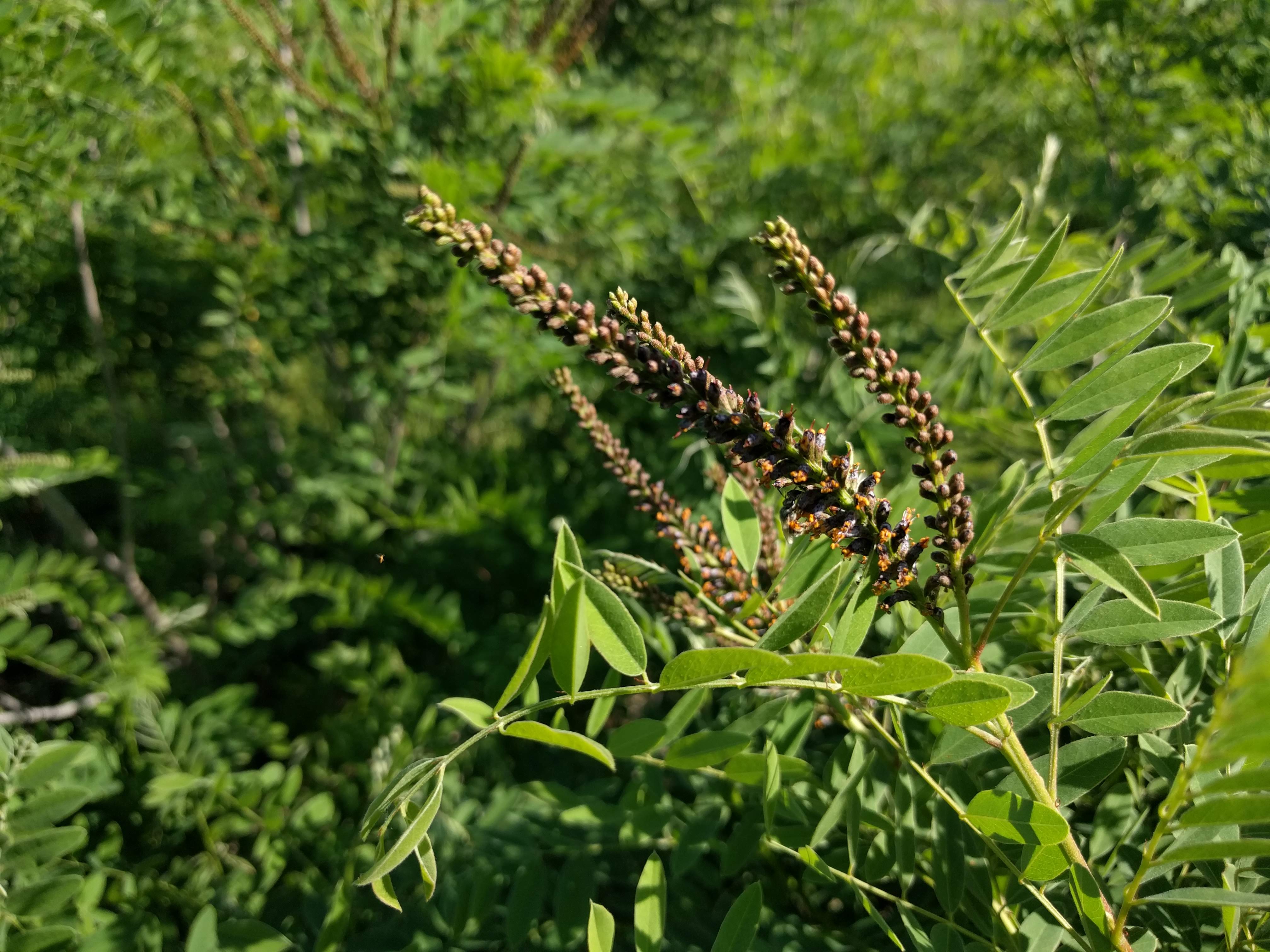
Leaves 4-8 in long, pinnately compound with 11-25 oblong leaflets, alternate arrangement; multi-stemmed shrubs with smooth, gray, woody stems, forming thickets of spreading, cane-like stems that begin sparsely branching at about 3-4 ft in height.
- Flower, fruit and seedhead
Flower: Irregular, with one slightly enlarged petal (unlike the typical legume flower), deep purple corolla 1/3 in long, with bright orange stamens that stick out prominently; flowers tightly packed in spikelike racemes 3-6 in long (each looking like a tapered bottle brush).
Fruit/seedhead: 1/4 in long, tough, leathery seed pods with prominent oil glands, each pod with one seed (sometimes two).
Pollination: Insects, primarily bees.

- Seed

Note: Seed produced from unirrigated rows at the TPC had much lower viability (PLS: 16-23%, not included in the typical seed test above).
Seed characteristics
Seeds per ounce: 3,700 (IA NRCS)
Seeds per pound: 77,000 (Woody Plant Seed Manual)
1000 seed weight: 7.76 g (Seed Information Database)
Description: Glossy, light-brown seed resembles a small bean, 4 mm long and 1.5 mm wide, with a slightly hooked end.
Typical seed test
PLS: 90-94%
Purity: 98%
Germination: 31-92%
Dormant: 0-65%
(based on tests of one lot of commercial seed and one lot produced at the TPC)
- Habitat and range
Habitat: Moist soil; partial to full sun; along river and stream banks, islands, ditches, wet prairies, and seeps. Wetland Indicator Status is Facultative Wetland (FACW) for the Midwest. Plants survive for many years in mesic soils without irrigation, but seed yield (and possibly viability) increases with irrigation.
Conservation status: Global- G5, secure; Wyoming- S2, imperiled; West Virginia- S2/S3, imperiled to vulnerable (NatureServe); Listed as a noxious weed or invasive plant in Maine, Rhode Island, New Jersey, New Hampshire, Oregon, and Washington.
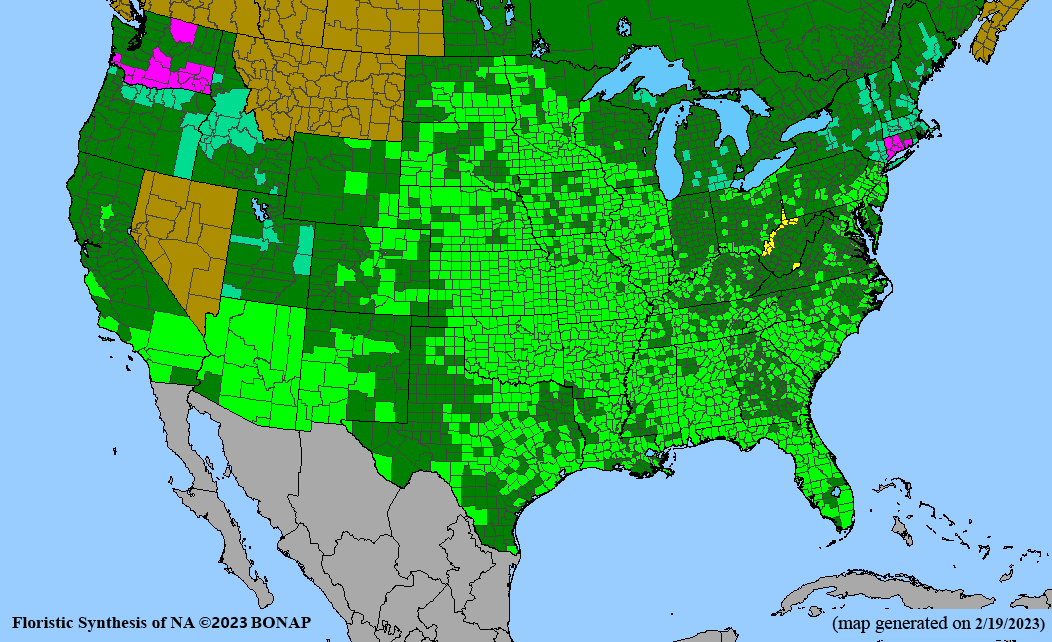
General Comments
The dark purple flower spikes with brilliant orange pollen-bearing stamens attract numerous species of native bees in great abundance, along with skippers, other butterflies, and moths. The foliage and pods, when crushed, have an unusual scent, reminiscent of cumin, citrus, and creosote. Aromatic compounds from this species have been investigated as medicines, natural insecticides and insect repellents. The foliage is eaten by larvae of silver-spotted skipper and southern dogface butterflies, larvae of amorpha borer beetles live within the stems and roots, and tiny bruchid beetles feed on the seeds. The long, weakly branched stems have been used in arrow-making and as a foundation for bedding materials by Native peoples. The functions this species provides in restoration include erosion control, streambank stabilization, wildlife cover, and windbreaks, and it shows potential for use in living snow fences.
Recommendations for Seed Production
- Establishment for seed production
Direct seeding
We do not have experience with direct seeding this species for seed production. Widely spaced rows (6 ft or more) are recommended.
Greenhouse
Seed pre-treatment: Start seed pretreatment about 3-4 months before outplanting. Mechanical or chemical scarification is recommended as these seeds have physical dormancy, followed by 10-14 days cold/moist stratification (40°F).
Sowing: Cover seed lightly (1/4 in depth) with potting mix; adding a layer of perlite or chick grit to the surface of the soil may help prevent damping off.
Transplanting: Seedlings are ready for transplanting when roots have reached the bottom of the plug and are well-branched, creating a firm plug. Harden off outdoors, then transplant into plasticulture rows with drip irrigation, 2-3 plants per linear foot.
- Stand management
Weeds: Plastic mulch controls weeds in year one. Shrubs grow vigorously and shade out most weeds.
Pests: In very snowy winters, rabbits feed on bark and may girdle stems. Shrubs will resprout but flowering and seed set will be delayed for a year. Deer occasionally browse the tops of plants. Some native insects feed on foliage or within stems/roots, but not at densities that cause production issues. Bruchid beetles feed on developing seeds within pods and can reach significant densities. However, seed yield is still high in “good years” and when rows are irrigated.
Diseases: An unidentified rust fungus causes leaves to appear distorted in some years.
Note: Rows can be cut back to the ground in the dormant season if plants have become too lanky for efficient harvesting. Note that this shrub species does not flower or set seed on first year growth.
- Seed production
 First harvest: Plants flower and set seed one year after transplanting.
First harvest: Plants flower and set seed one year after transplanting.Yield: 80-580 pounds/acre (based on 3 plots)
Stand life: More than 10 years (estimated) for these long-lived shrubs.
Flowering date: June
Seed maturity/Harvest date: October
Seed retention: Low risk of shattering; pods remain on plants through late October.
Harvest date range at TPC (2018-2021): Aug 30 - Oct 31
Recommended harvest method: Strip pods from stalks by hand (wear sturdy gloves). We have not attempted to combine this species due to the woody stems. A more efficient approach might be to cut the fruiting stems onto tarps using a hedge trimmer, then run the material through a stationary combine.
- Seed cleaning and storage
Cleaning process: Pass hand-collected pods through a coarse screen (1/4 to 1/2 inch hardware cloth) to remove sticks. Run through a brush machine with canvas beater bars. Seed pods have oil glands (visible under low magnification) and become very sticky when brushed. Spread oily material on a tarp and dry with a fan for a few days. Material may need to be brushed a second time after drying and before airscreening.
Seed storage: cool/dry (33-50° F, 30-50% RH) - seed retains viability for 3-5 years at room temperature (Woody Plant Seed Manual).
Released Germplasm
Source identified material: Natural Selections/Iowa Ecotype Zones 1, 2, 3
Selected germplasm: Iowa Covey Germplasm, Illinois Covey Germplasm, Missouri Covey Germplasm
Tested germplasm: Survivor Germplasm (ID)
- References
Bonner, F. T., Karrfalt, R. P., & Nisley, R. G. (Eds.). (2008). Woody plant seed manual. RNGR - Reforestation, Nurseries, and Genetic Resources. https://rngr.net/publications/wpsm
Hilty, J. (2019). False indigo - Amorpha fruticosa. Illinois Wildflowers. https://www.illinoiswildflowers.info/trees/plants/false_indigo.htm
Kartesz, J.T., The Biota of North America Program (BONAP). 2023. North American Plant Atlas. (http://bonap.net/napa). Chapel Hill, N.C. [maps generated from Kartesz, J.T. 2023. Floristic Synthesis of North America, Version 1.0. Biota of North America Program (BONAP). (in press)]
Lady Bird Johnson Wildflower Center - The University of Texas at Austin. (2022). Amorpha fruticosa. Plant Database. https://www.wildflower.org/plants/result.php?id_plant=amfr
Moore, L. M. (2006). Plant guide: Desert false indigo - Amorpha fruticosa L. USDA-NRCS National Plant Data Center. https://plants.usda.gov/DocumentLibrary/plantguide/pdf/pg_amfr.pdf
NatureServe. 2024. NatureServe Network Biodiversity Location Data accessed through NatureServe Explorer [web application]. NatureServe, Arlington, Virginia. Available https://explorer.natureserve.org/. (Accessed: February 22, 2024).
Newcomb, L. (1977). Shrubs / leaves divided. In Newcomb’s wildflower guide (pp. 106–107). Little, Brown and Company.
Runkel, S. T., & Roosa, D. M. (2009). Indigo bush. In Wildflowers of the tallgrass prairie: The upper Midwest (2nd ed., pp. 66–67). University of Iowa Press.
University of Georgia - Center for Invasive Species and Ecosystem Health. (n.d.). Indigobush (Amorpha fruticosa). EDDMapS. https://www.eddmaps.org/species/subject.cfm?sub=5086
USDA NRCS National Plant Data Team. (n.d.). Amorpha fruticosa L. USDA plants database. https://plants.usda.gov/plant-profile/AMFR
Species Guide Updated 12/18/2024
white meadowsweet
white meadowsweet sagem
Spiraea alba Du Roi
Alternate Common Names: meadow sweet, meadowsweet, narrow-leaved meadowsweet, American meadowsweet, pale bridewort, pipestem, queen of the meadows
Family: rose family (Rosaceae)
Functional Group: woody species, shrubs
Description
- Life cycle and growth form
Perennial shrub with woody root system, growing in colonies of slender stems.
Height: 2-4 ft

- Leaves and stem

Leaves are alternate, mostly hairless, narrowly elliptic, 2-3 in long and 3/4 in wide, with finely serrate margins and short petioles; stems are smooth, slender, and woody, with few branches, becoming brown with age, multiple stems produced from the same rootstock.
- Flower, fruit and seedhead
Flower: Radially symmetrical, 1/4 in wide flowers are five-parted with white petals, a pink, yellow, or orange center ring, and long stamens that stick out from the flowers; inflorescence is a branched cluster of spikes 2 - 6 in long, each with numerous flowers, blooming from the top down.
Fruit/seedhead: Each flower forms four to six (usually five) dry, reddish-brown fruits (follicles), arrayed in a star-like cluster; each follicle is tough, short-beaked, hairless, and contains 2-5 seeds; ripe follicles split open along one side to release the seeds.
Pollination: insects, particularly bees
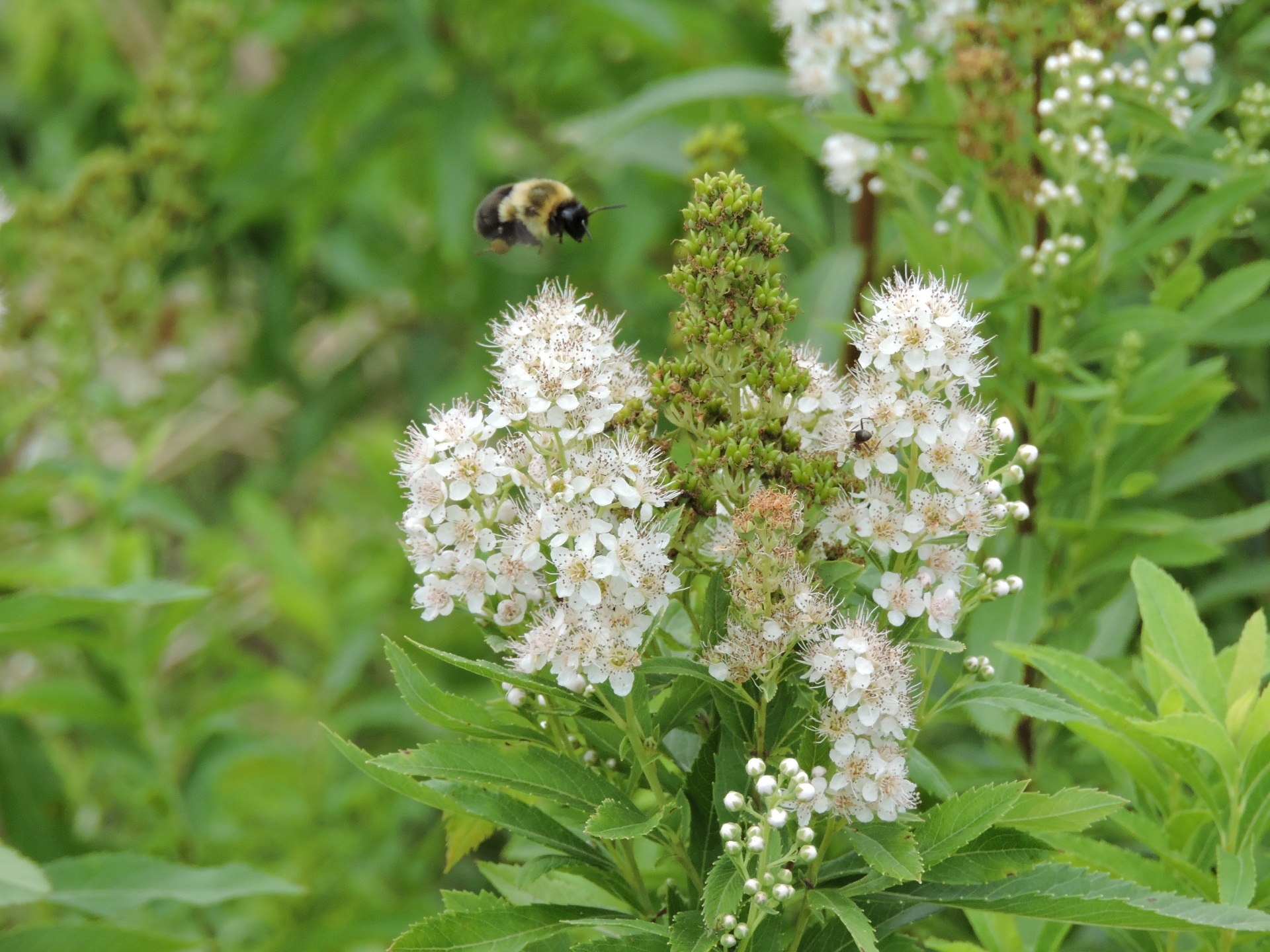
- Seed
Seed characteristics
Seeds per ounce: 300,000 (Prairie Moon)
1000 seed weight: 0.88 g (Seed Information Database)
Description: Slender, banana-shaped seeds are 2 mm long by less than 0.5 mm wide and a rusty orange color.
Typical seed test
TZ-PLS: 53%
Purity: 60%
TZ: 88%
(averages obtained from 3 seed lots produced at TPC)
- Habitat and range
Habitat: Grows in moist to wet soil in full sun; found in wet prairies, along streams, bogs, marsh edges, ditches; Facultative Wetland status in Midwest (USDA Plants Database); benefits from irrigation in seed production systems.
Conservation status: Global- G5, secure; Delaware and Tennessee- S1, critically imperiled; North Carolina- S2, imperiled; South Dakota- S3, vulnerable (NatureServe)
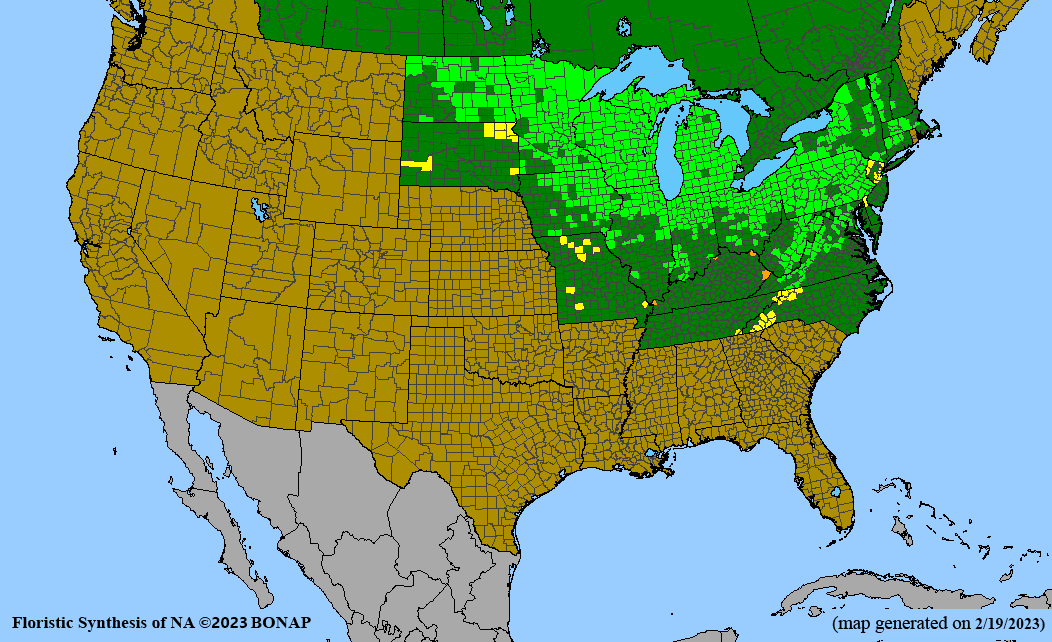
General Comments
The long flowering time and abundance of nectar and pollen make this an important food plant for many kinds of bees as well as small butterflies, wasps, beetles, and flies. We have observed the endangered Rusty Patched Bumble Bee visiting the flowers in white meadowsweet seed production plots. The dense colonies of stems provide shelter and nesting habitat for some bird species. The leaves, stems, and/or roots have uses in the traditional medicine and foodways of several Indigenous groups within the plant’s native range. Recommended for use as a low hedge, in perennial borders, wet prairie restorations, and roadside plantings.
Recommendations for Seed Production
- Establishment for seed production
Direct seeding
We do not have experience with direct seeding this species for seed production.
Greenhouse
Seed pre-treatment: 45 days cold-moist stratification.
Sowing: Seeds are small and must be surface-sown; stratified seed germinates quickly (starting 5 days from sowing).
Transplanting: Seedling plugs (2.5 in deep, 73-cell trays) are ready to transplant about 12 weeks from germination. After several weeks in plugs, seedlings benefit from fertilizer application such as a sprinkling of coated fertilizer pellets. Harden off outside, then dibble into a weed barrier in irrigated production rows.
- Stand management
Weeds: Few issues if weed barrier used in planting year; dense foliage shades out most weeds in subsequent years; mow and trim between rows.
Pests: A few stems are affected by dark colored aphids that cause distortion of leaves and growing shoot tips.
Diseases: None noted.
Note: Mow plots down to 4 in during the dormant season every other year to stimulate production of robust new stems.
- Seed production
 First harvest: second year
First harvest: second yearYield: 25-90 pounds/acre (based on 2 plots)
Stand life: at least 8 years
Flowering date: June - August
Seed maturity/Harvest date: late October - early November
Seed retention: Shattering of seed from open capsules begins in late October to early November.
Harvest date range at TPC (2017-2023): Oct 17 - Nov 1
Recommended harvest method: Check plots frequently from mid-October through early November; hand clip or combine when follicles (dry fruits) have split open on most stalks.
- Seed cleaning and storage
Cleaning process: Do NOT use a brush machine. Brushing pulverizes the dried leaves, making it very difficult to extract the fine seed. Hand-clipped material can be beaten in a cloth bag to release seed. Combined or hand collected material can then be treated in the same way: run through 1/4 in hardware cloth to remove sticks, then airscreen. If greater purity is desired, passing the cleaned seed through soil sieves can remove residual chopped leaf material.
Seed storage: cool/dry (33-50° F, 30-50% RH)
Released Germplasm
Source Identified material: Natural Selections/Iowa Ecotype Zones 1 and 2
- References
Chayka, K. (n.d.). Spiraea alba (white meadowsweet). Minnesota Wildflowers. https://www.minnesotawildflowers.info/flower/white-meadowsweet
Cochrane, T. S., Elliot, K., & Lipke, C. S. (2014). White meadowsweet. In Prairie plants of the University of Wisconsin-Madison Arboretum (3rd ed., p. 314). University of Wisconsin-Madison Arboretum.
Hilty, J. (2019). Meadowsweet - Spiraea alba. Illinois Wildflowers. https://www.illinoiswildflowers.info/wetland/plants/meadowsweet.htm
Kartesz, J.T., The Biota of North America Program (BONAP). 2023. North American Plant Atlas. (http://bonap.net/napa). Chapel Hill, N.C. [maps generated from Kartesz, J.T. 2023. Floristic Synthesis of North America, Version 1.0. Biota of North America Program (BONAP). (in press)]
NatureServe. 2024. NatureServe Network Biodiversity Location Data accessed through NatureServe Explorer [web application]. NatureServe, Arlington, Virginia. Available https://explorer.natureserve.org/. (Accessed: February 28, 2024).
Michigan State University Extension (n.d.) Meadowsweet. MSU Extension Native Plants and Ecosystem Services. https://www.canr.msu.edu/nativeplants/plant_facts/meadowsweet
Runkel, S. T., & Roosa, D. M. (2009). Meadow sweet. In Wildflowers of the tallgrass prairie: The upper Midwest (2nd ed., pp. 142–143). University of Iowa Press.
USDA NRCS National Plant Data Team. (n.d.). Spiraea alba Du Roi. USDA plants database. https://plants.usda.gov/plant-profile/SPAL2
Species Guide Updated 12/18/2024
Sedges
Sedges sagemThe Species Production Guides for sedges and rushes provide specific information about growing each of these species for seed production.
Scroll the list (alphabetized by scientific name) or press ctrl-f (or command-f) to search for any name in this page.
A printable file (pdf) is also provided on each completed species page for those needing a print version.
This section is a work in progress. We will continue to add new species guides as they are completed. At this time, one upland, one obligate wetland, and one facultative wetland species are complete. Propagation of other species in those categories is similar, except for the rhizomatous ones. The methods used for Carex bicknellii, for example, can be applied to other tufted, upland species such as C. brevior and C. molesta.
Carex annectens / yellowfruit sedge
Carex bebbii / Bebb's sedge
Carex brevior / shortbeak sedge
Carex cristatella / crested sedge
Carex gravida / heavy sedge
Carex interior / inland sedge
- Carex laeviconica / smoothcone sedge
Carex molesta / troublesome sedge
Carex pellita / woolly sedge
Carex sartwellii / Sartwell's sedge
Carex stricta / upright sedge
Carex suberecta / prairie straw sedge
Carex tribuloides / blunt broom sedge
Carex vulpinoidea / fox sedge
Scirpus atrovirens / green bulrush
Scirpus cyperinus / woolgrass
Bicknell's sedge
Bicknell's sedge dickeye
Carex bicknellii Britton
Alternate Common Names: Bicknell’s oval sedge, copper-shouldered oval sedge
Scientific Synonyms: Carex bicknellii Britton var. bicknellii, Carex brevior. (Dewey) Mack var. crawei (W. Boott) B. Boivin, Carex straminea var. crawei Boott, Carex straminea Willd. var. meadii Boott
Family: sedge family (Cyperaceae)
Functional Group: sedges and rushes
Description
- Life cycle and growth form
perennial, short black rhizomes, forms bunches
Height: 1-4 ft
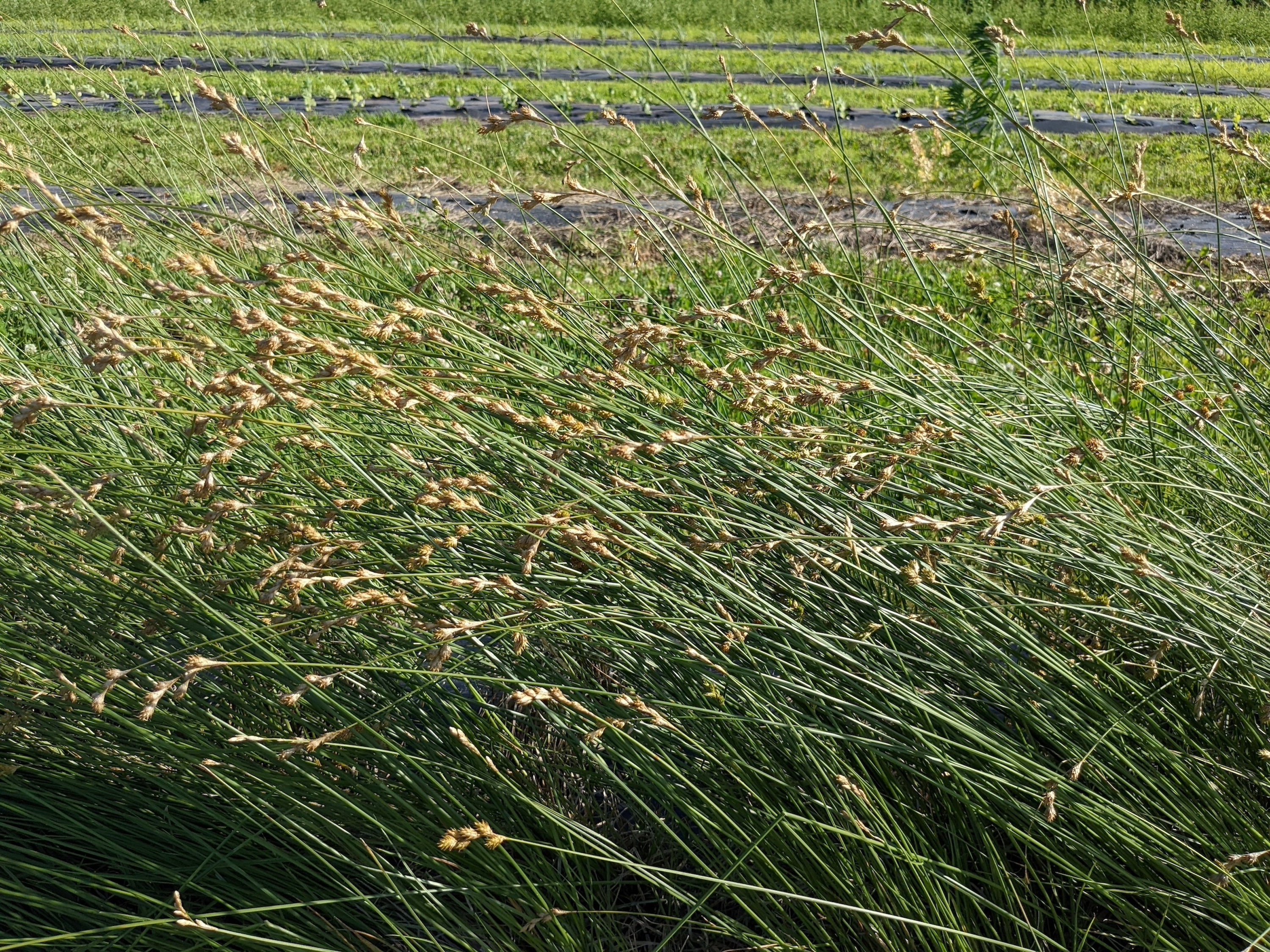
- Leaves and stem
3-4 leaves per stem, alternate, three-ranked, rough margins, pale green, flat and thin
- Flower, fruit and seedhead
Flower/fruit/seedhead: Erect to arching seed heads 2-6 cm long; 3-6 oval spikes with cone-shaped bases, each 10-18 mm long, per stem.
Pollination: wind
- Seed
Seed characteristics
Seed weight:
Seeds per ounce: 17,000 seeds/oz (IA NRCS)
1000 seed weight: 1.31g (Seed Information Database)
Description: Achene broadly elliptical, brown; mature perigynium (sac-like structure around the achene) flattened, with a translucent and membranous wing, distinct, parallel veins, and coppery-brown “shoulders,” the source of one alternate common name, “copper-shouldered oval sedge.”
Typical seed test
PLS: 84% (n = 11)
Purity: 98% (n = 10)
Germination: 30% (n = 7)
Dormancy: 61% (n = 7)
(averages obtained from n tests of purchased seed lots)
- Habitat and range
Habitat: Dry to moist soil; full sun; prairies, rock outcrops, savannas, along railroads; Wetland Indicator Status is Facultative Upland (FACU) for the Midwest.
Conservation status: Global- G5, secure; Delaware- SX, presumed extirpated; Vermont- SH, possibly extirpated; Arkansas, Maine, New Hampshire, Pennsylvania, and South Carolina- S1, critically imperiled; Massachusetts- S1/S2, critically imperiled to imperiled; New Jersey and Ohio- S2, imperiled (NatureServe)
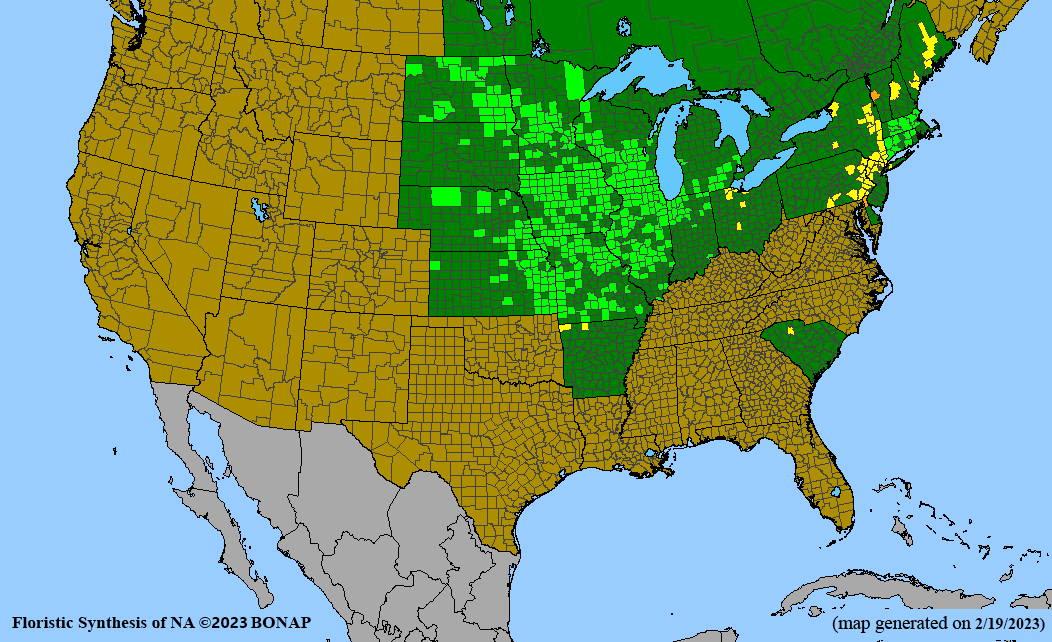
General Comments
Sedges are a large, diverse group of grass-like plants that are important components of prairies, wetlands, and woodlands across our region. In Iowa alone, there are about 120 species of sedges. Grasshoppers and the larvae of skipper butterflies, among other insects, feed on sedge foliage, and their seeds are eaten by grassland birds. They are notoriously difficult to identify to species, especially the oval sedges to which Bicknell’s sedge belongs. The development of stock seed by the Tallgrass Prairie Center in the early 2000s enabled broader access to reliably identified sedge species by native seed growers. The large, winged perigynia of Carex bicknellii, with their pearly color and translucence, make this species somewhat easier to identify than other oval sedges. This species is also one of a few oval sedges that are commonly found in upland prairie habitats. Seed production plots of Carex bicknellii in mesic to dry mesic soils do not require irrigation.
Recommendations for Seed Production
- Establishment for seed production
Direct seeding
Not recommended for this species.
Greenhouse
Seed pre-treatment: 30 days cold-moist stratification; removal of perigynia produces a similar effect as stratification on germination in this species.
Sowing: Sow in germination flats or directly into plugs (2-3 seeds per cell), covering seed lightly (light improves germination of many sedge species); maintain even moisture until germination. Daytime temperatures should be around 70-80°F (22-27°C) and allowed to drop at night to 50-60°F (10-15°C). We have had good success planting into 2.5 in deep, 73-cell plug flats that are ridged to direct root development downward and have 3/4 in bottom openings to encourage root pruning and the formation of firmly rooted plugs for transplanting.
Transplanting: Seedlings are ready to transplant to the field about 10 weeks after sowing. Pop out a few plugs to check for adequate root development that will provide sturdy plugs for planting. A week or two before transplanting, move flats outside to ‘harden off.’
- Stand management
Weeds: Plastic mulch reduces weed pressure in the first year or more. Holes in the plastic should be widened somewhat in subsequent years to allow the bunches to expand. The most significant weed issue can be the presence of other oval sedges such as Carex brevior and Carex molesta, since they are competitive and their seed is difficult to distinguish from Carex bicknellii in the field and practically impossible to clean out of harvested seed. Obtaining clean, reliably identified, certified stock seed helps to prevent this issue.
Pests: None noted.
Diseases: None noted.
- Seed production
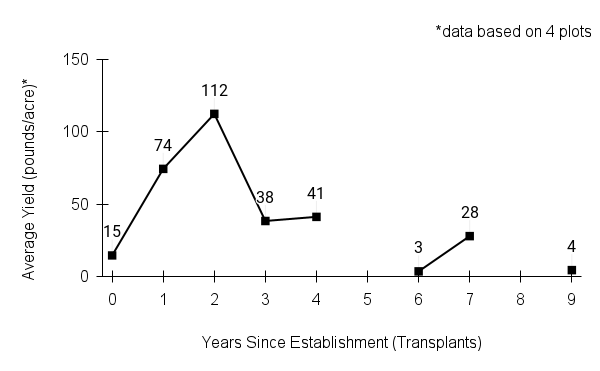
First harvest: There may be a small amount of seed in the first season, but most plants begin flowering and producing seed in their second growing season after transplanting.
Yield: Peak harvests are in the second through fourth years after transplanting, with yields from 40-112 pounds per acre, extrapolated from harvests of four plots grown at the Tallgrass Prairie Center.
Stand life: Plants may persist for up to ten years or more, but productive stand life is about five years, after which our yields have declined.
Flowering date: June in northeast Iowa
Seed maturity: Mid-late June to early July
Seed retention: Significant shattering occurs in high winds when perigynia are mature; lodging can also occur due to heavy rains/storms, complicating combine harvest.
Harvest date range at TPC (2007-2023): June 14 - July 31
Recommended harvest method: Combine when mature; a good rule of thumb is to wait until about 10% of seed heads have begun shattering.
- Seed cleaning and storage
Cleaning process: Air-dry seed for two weeks or more after harvest. Pass material through a coarse screen (1/2 in hardware cloth) to remove larger stemmy material, if needed, then air screen. If perigynia removal is desired, pass material through a brush machine with medium bristles before air screening. (Note: perigynia removal destroys several characteristics used in identification.)
Seed storage: cool/dry (33-50° F, 30-50% RH)
Released Germplasm
Source Identified material: Natural Selections/Iowa Ecotype Zone 1 (northern IA) and Zone 2 (central IA)
- References
Boeck Crew, C.M., Myers, M.C., Sherrard, M.E., Elgersma, K.J., Houseal, G.A., & Smith D.D. (2020). Stratification and perigynia removal improve total germination and germination speed in 3 upland prairie sedge species. Native Plants Journal, 21(2), 120-131. https://doi.org/10.3368/npj.21.2.120
Chayka, Katy. (n.d.). Carex bicknellii (Bicknell’s sedge). Minnesota Wildflowers. https://www.minnesotawildflowers.info/grass-sedge-rush/bicknells-sedge
Cochrane, T. S., Elliot, K., & Lipke, C. S. (2014). Bicknell’s Sedge. In Prairie Plants of the University of Wisconsin-Madison Arboretum (3rd ed., p. 160). University of Wisconsin-Madison Arboretum.
Hilty, J. (2019). Bicknell’s sedge - Carex bicknellii. Illinois Wildflowers. https://www.illinoiswildflowers.info/grasses/plants/bicknell_sedge.htm
Houseal, G. (2010). Plasticulture for seed production of wetland (Carex) species. Native Plants Journal, 11(1), 58-64. https://doi.org/10.2979/NPJ.2010.11.1.58
Mastrogiuseppe, J., Rothrock, P. E., Dibble, A. C., & Reznicek, A. A. (2020, November 5). Carex bicknellii Britton. Flora of North America. http://floranorthamerica.org/Carex_bicknellii
Mohlenbrock, R. H. (1999). Carex bicknellii. In Illustrated Flora of Illinois - Sedges: Carex (p. 139). Southern Illinois University Press.
Murphy, M. & Spyreas, G. & Marcum, P. (2025) Carex of Illinois & Surrounding States: The Oval Sedges. University of Illinois Press
NatureServe. 2024. NatureServe Network Biodiversity Location Data accessed through NatureServe Explorer [web application]. NatureServe, Arlington, Virginia. Available https://explorer.natureserve.org/. (Accessed: February 28, 2024).
Schütz, W. & Rave, G. (1999). The effect of cold stratification and light on the seed germination of temperate sedges (Carex) from various habitats and implications for regenerative strategies. Plant Ecology 144, 215–230. https://doi.org/10.1023/A:1009892004730
USDA NRCS National Plant Data Team. (n.d.). Carex bicknellii Britton. USDA plants database. https://plants.usda.gov/home/plantProfile?symbol=CABI3
Species Guide Updated 2/5/2025
Buxbaum's sedge
Buxbaum's sedge dickeye
Carex buxbaumii, Wahlenb.
Alternate Common Name: brown bog sedge
Scientific Synonym(s): Carex buxbaumii var. anticostensis Raymond, Carex holmiana, Carex polygama Mackenzie
Family: sedge family (Cyperaceae)
Functional Group: sedges and rushes
Description
- Life cycle and growth form
Perennial, long-rhizomatous, forming large stands with a distinctive bluish-green color compared with the yellow-green of most sedges.
Height: 1-2.5 ft
- Leaves and stem
Leaves flat, hairless, and rough on the edges; lower sheaths are rusty brown and ladder fibrillose (made of evenly spaced, linked fibers) near their tops, flowering stems are stiff and 3-sided, smooth.
- Flower, fruit and seedhead
Fruit/seedhead: 1-4 spikes per plant; pistillate spikes bear up to 40 perigynia per spike, distinctive scales are red-purple to dark brown with a green midvein, perigynia (papery coverings around each “seed”) are hairless and gray-green, can be beakless or have a tiny beak, “seeds” (achenes) are 3-sided.
Pollination: wind
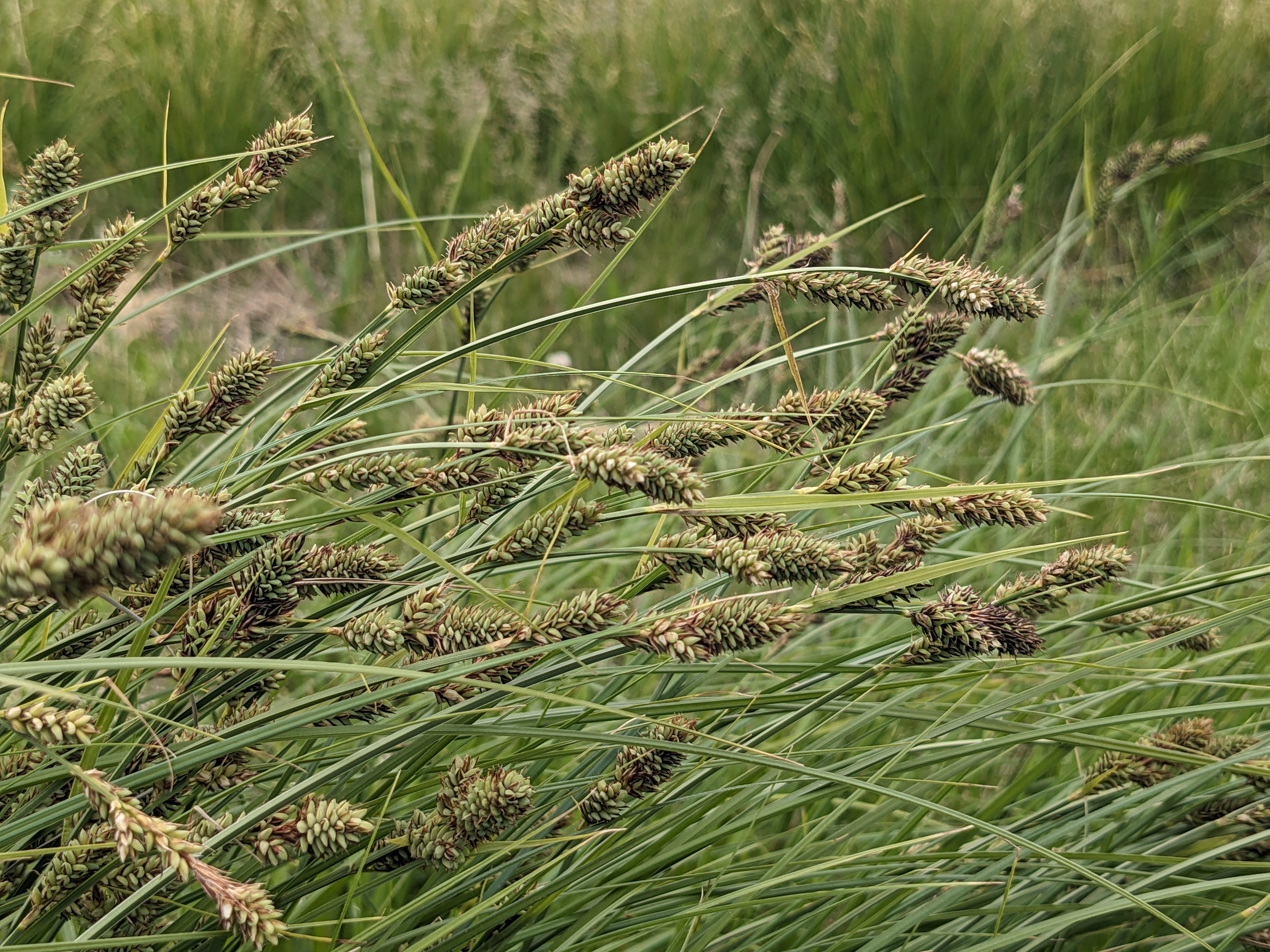
- Seed
Seed characteristics
Seed weight:
Seeds per ounce: 14,500 (IA NRCS)
1000 seed weight: 1.66 g (Seed Information Database)
Description: Seed unit is an achene (2 mm long) with surrounding perigynium (1.5 x 3 mm); perigynia are gray-green with lighter veins and a very short beak; achene is three-sided and brown.
Typical seed test
unknown at this time.
- Habitat and range
Habitat: Mesic to wet soil; partial to full sun; prairie swales, meadows, fens, marshes, ditches; Wetland Indicator Status is Obligate Wetland (OBL) for the Midwest; irrigation is recommended for seed production.
Conservation status: Global- G5, secure; District of Columbia and Georgia- SH, possibly extirpated; Arkansas, Connecticut, Delaware, Kansas, Kentucky, New Hampshire, South Carolina, South Dakota, Tennessee, and Vermont- S1, critically imperiled; Maryland, Missouri, Nebraska, Nevada, Massachusetts, New York, North Carolina, North Dakota, Virginia, and West Virginia- S2, imperiled; California, Idaho, New Jersey, Pennsylvania, Washington, Wyoming, and Illinois- S3, vulnerable (NatureServe)
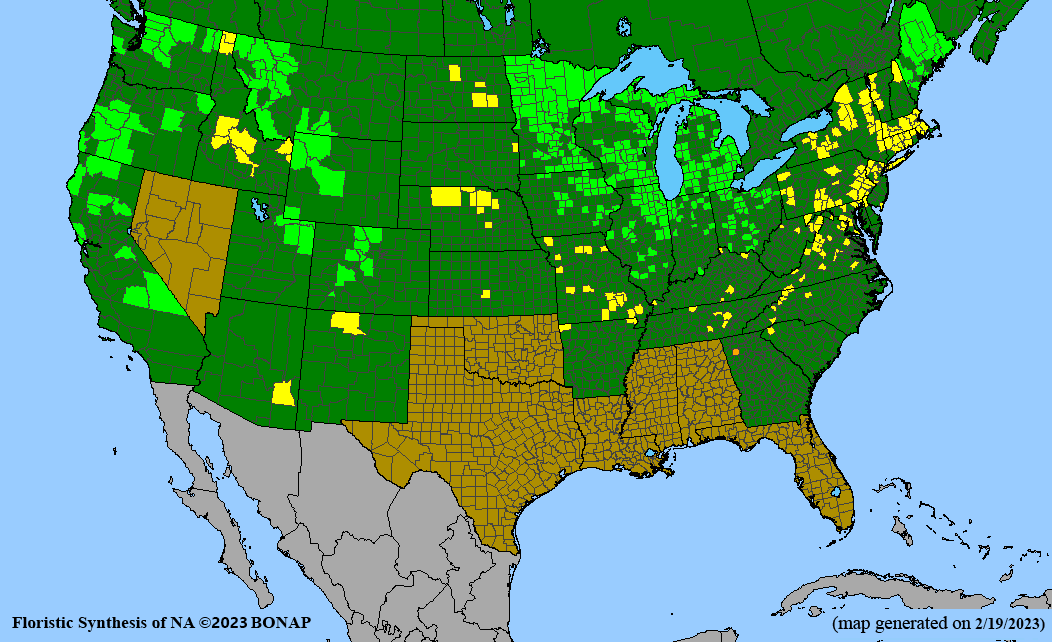
General Comments
Sedges are a large, diverse group of grass-like plants that are important components of prairies, wetlands, and woodlands across our region. In Iowa alone, there are about 120 species of sedges. Grasshoppers and the larvae of skippers and other butterflies and moths feed on wetland sedge foliage, and their seeds are eaten by waterfowl and other birds. Sedges are notoriously difficult to identify to species. Buxbaum’s sedge is distinguishable by, among other characteristics, its rhizomatous habit, bluish green foliage, and dark purplish-brown scales in the seedheads (spikelets). The development of stock seed by the Tallgrass Prairie Center in the early 2000s enabled broader access to reliably identified sedge species by native seed growers. As an obligate wetland species, Buxbaum’s sedge benefits from irrigation in production settings.
Recommendations for Seed Production
- Establishment for seed production
Direct seeding
We do not have experience with direct seeding this species for seed production.
Greenhouse
Seed pre-treatment: Benefits from cold-moist stratification for at least 60 days.
Sowing: Sow in germination flats, covering seed lightly (light improves germination of many sedge species); germination may be slow and sporadic. Daytime temperatures should be around 70-80°F (22-27°C) and allowed to drop at night to 50-60°F (10-15°C). We have had good success dibbling seedlings into 2.5 in deep, 73-cell plug flats that are ridged to direct root development downward and have 3/4 in bottom openings to encourage root pruning and the formation of firmly rooted plugs for transplanting.
Transplanting: Seedlings are ready to transplant to the field about 14-16 weeks after sowing. Pop out a few plugs to check for adequate root development that will provide sturdy plugs for planting. A week or two before transplanting, move flats outside to ‘harden off.’
- Stand management
Weeds: Plastic mulch reduces weed pressure in the first year or more. Plastic must eventually be removed to allow the plants to spread by rhizomes. A well-established stand outcompetes many weeds. In large-scale production systems or those where the use of weed barriers and/or hand weeding is not practical, broad-leaf herbicides and/or pre-emergent herbicides may be useful to prevent weeds from competing with the sedge plants and/or complicating the seed cleaning process. Significant weed problems may be caused by winter annuals (e.g., members of the mustard family), other small-seeded broad-leaf annuals, and annual grasses (e.g., downy brome). Herbicide applications should be timed to most effectively control specific weeds and minimize damage to the sedge plants. Care must be taken to read affected “weed” lists, as sedges are considered weeds in crop systems. Always read and follow label instructions.
Pests: None noted.
Diseases: None noted.
- Seed production
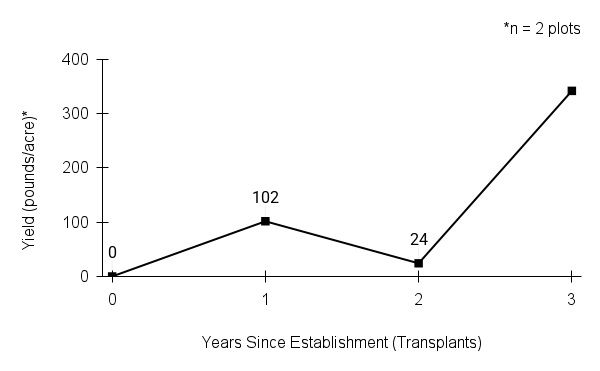 First harvest: Small amounts may be produced in the first and second years after transplanting.
First harvest: Small amounts may be produced in the first and second years after transplanting.Yield/acre: 24-340 lbs per acre
Stand life: Appears to take 3 years to reach peak production; plants are likely long-lived, but uncertain whether yields will be sustained or sporadic; mowing in fall or winter may improve yields in subsequent seasons.
Flowering date: May in northern Iowa
Seed maturity/harvest date: Mid to late June in NE Iowa.
Seed retention: Moderate shattering observed.
Harvest date range at TPC (2010-2011, 2025): June 16 - 27
Recommended harvest method: Combine at maturity; seed threshes cleanly.
- Seed cleaning and storage
Cleaning process: Air-dry combined material for two weeks or more after harvest. Pass material through a coarse screen (1/2 in hardware cloth) to remove larger stemmy material, if needed, then air screen.
Seed storage: Cool/dry (33-50° F, 30-50% RH)
Released Germplasm
Source Identified material: Natural Selections/Iowa Ecotype Zone Iowa
- References
Carex buxbaumii (Buxbaum’s Sedge). Minnesota Wildflowers. (n.d.). https://www.minnesotawildflowers.info/grass-sedge-rush/buxbaums-sedge
Cochrane, T. S., Elliot, K., & Lipke, C. S. (2014). Buxbaum’s Sedge. In Prairie Plants of the University of Wisconsin-Madison Arboretum (3rd ed., p. 161). essay, University of Wisconsin-Madison Arboretum.
Kartesz, J.T., The Biota of North America Program (BONAP). 2023. North American Plant Atlas. (http://bonap.net/napa). Chapel Hill, N.C. [maps generated from Kartesz, J.T. 2023. Floristic Synthesis of North America, Version 1.0. Biota of North America Program (BONAP). (in press)]
Murray, D. F. (2020, November 5). Carex buxbaumii Wahlenberg. Flora of North America. http://floranorthamerica.org/Carex_buxbaumii
NatureServe. 2024. NatureServe Network Biodiversity Location Data accessed through NatureServe Explorer [web application]. NatureServe, Arlington, Virginia. Available https://explorer.natureserve.org/. (Accessed: February 29, 2024).
USDA NRCS National Plant Data Team. (n.d.). Carex buxbaumii Wahlenb.. USDA plants database. https://plants.usda.gov/home/plantProfile?symbol=CABU6
Species Guide Updated 12/2/2024
bottlebrush sedge
bottlebrush sedge dickeye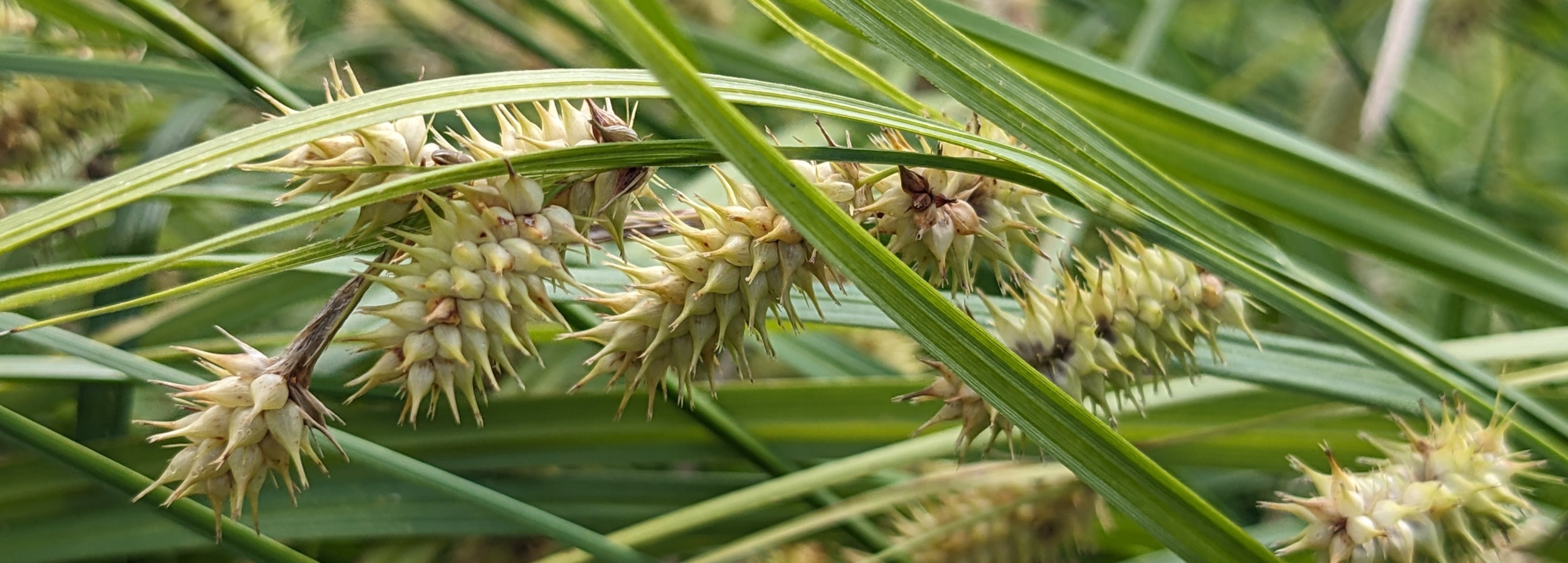
Carex hystericina Muhl. ex Willd.
Alternate Common Name: porcupine sedge
Scientific Synonym: Carex hystricina Muhl. Rydberg.
Family: sedge family (Cyperaceae)
Functional Group: sedges and rushes
Description
- Life cycle and growth form
Perennial with fibrous roots, forms clumps.
Height: 3/4 - 3 ft
- Leaves and stem
Leaves in alternate, 3-ranked arrangement, hairless; basal sheaths are reddish purple and fibrous; culms are stiff and 3-sided, hairless, unbranched.
- Flower, fruit and seedhead
Fruit/seedhead: Seed head consists of a terminal male spike and one to four prickly, cylindrical pistillate spikes, each containing 40-100 perigynia (seed containing structures).
Pollination: wind
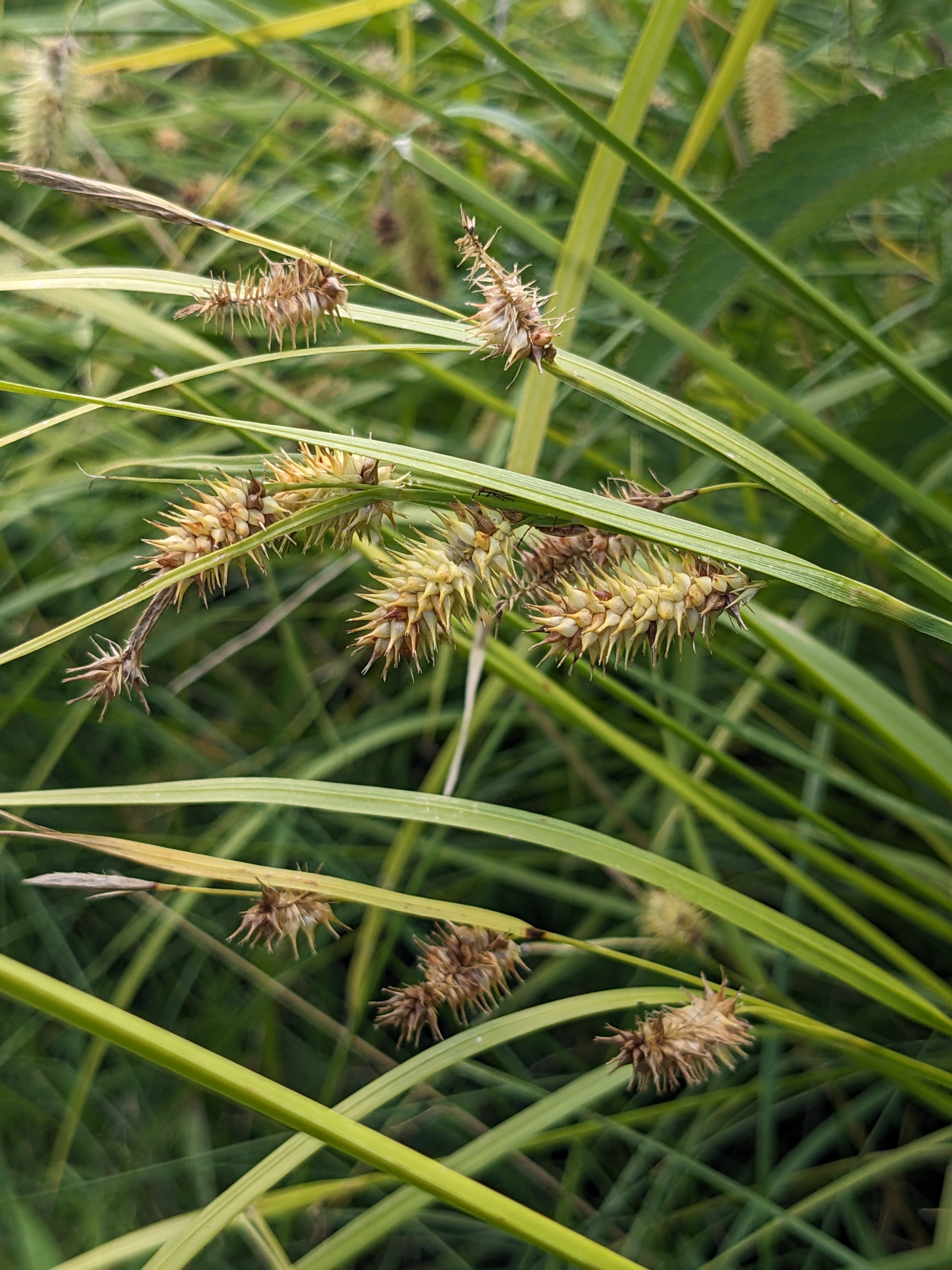
- Seed
Seed characteristics
Seed weight:
Seeds per ounce: 30,000 seeds/oz (IA NRCS)
1000 seed weight: 0.48g (Seed Information Database)
Description: “Seeds” are 3-sided, ovate, brown achenes, wrapped in an inflated, distinctly veined perigynium with a long beak and two short teeth.
Typical seed test
PLS: 87.48% (n=1)
Purity: 99.41% (n=1)
Germination: 62% (n=1)
Dormancy: 26% (n=1, determined by TZ)
(based on one test of a seedlot grown at TPC)
- Habitat and range
Habitat: Moist to wet soil; partial to full sun; prairies, meadows, seeps, fens, marshes, swamps, ditches; Wetland Indicator Status is Obligate Wetland (OBL) for the Midwest.
Conservation status: Global- G5, secure; District of Columbia and Kentucky- SH, possibly extirpated; Maryland- S1, critically imperiled; California and Georgia- S2, imperiled; Arizona, Kansas, Washington, West Virginia, Illinois, and Wyoming- S3, vulnerable (NatureServe)
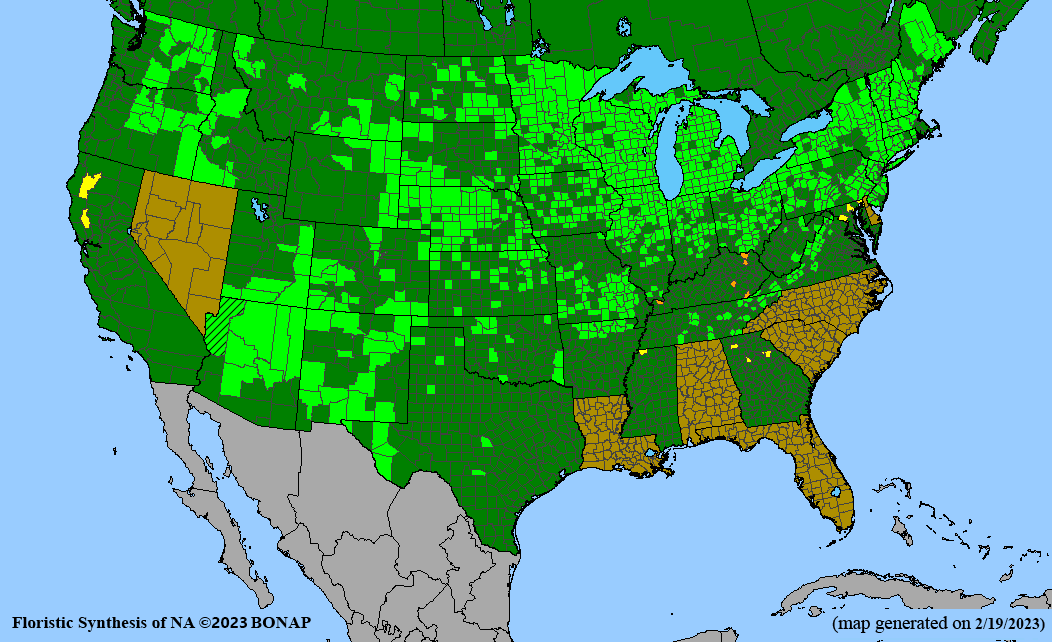
General Comments
Sedges are a large, diverse group of grass-like plants that are important components of prairies, wetlands, and woodlands across our region. In Iowa alone, there are about 120 species of sedges. Grasshoppers and the larvae of skippers and other butterflies and moths feed on wetland sedge foliage, and their seeds are eaten by waterfowl and other birds. Sedges are notoriously difficult to identify to species. The prickly, cylindrical spikes of bottlebrush sedge are somewhat distinctive, but this species can be confused with longhair or bristly sedge (Carex comosa) which also occurs in our region and sallow sedge (Carex lurida) which is a state listed species in Iowa but is more common in neighboring states to the south and east. The development of stock seed by the Tallgrass Prairie Center in the early 2000s enabled broader access to reliably identified sedge species by native seed growers. As an obligate wetland species, bottlebrush sedge benefits from irrigation in production settings.
Recommendations for Seed Production
- Establishment for seed production
Direct seeding
We do not have experience with direct seeding this species for seed production.
Greenhouse
Seed pre-treatment: Benefits from cold-moist stratification for 30 days.
Sowing: Sow in germination flats or directly into plugs (2-3 seeds per cell), covering seed lightly (light improves germination of many sedge species); maintain even moisture until germination. Daytime temperatures should be around 70-80°F (22-27°C) and allowed to drop at night to 50-60°F (10-15°C). We have had good success planting into 2.5 in deep, 73-cell plug flats that are ridged to direct root development downward and have 3/4 in bottom openings to encourage root pruning and the formation of firmly rooted plugs for transplanting.
Transplanting: Seedlings are ready to transplant to the field about 10 weeks after sowing. Pop out a few plugs to check for adequate root development that will provide sturdy plugs for planting. A week or two before transplanting, move flats outside to ‘harden off.’
- Stand management
Weeds: Plastic mulch reduces weed pressure in the first year or more. Holes in the plastic should be widened somewhat in subsequent years to allow the bunches to expand. Bunching plants are robust and leafy, competing well with many weeds; we have interplanted porcupine sedge with wetland forbs to provide support and reduce weed pressure.
Pests: None noted.
Diseases: None noted.
Soil moisture: Irrigation is recommended, though bottlebrush sedge may require less supplemental water than other wetland sedges. Drip tape can be applied under plastic mulch as planting beds are formed.
- Seed production
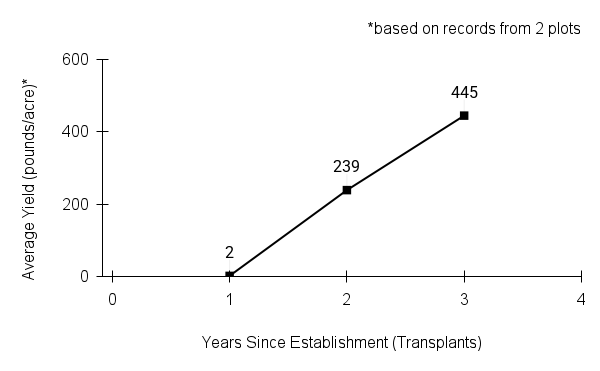
First harvest: Plants produce a small amount of seed in the year following the transplant year. Peak harvest may be in the third year after transplanting.
Yield: At peak (3 years after planting), yields are around 445 lbs per acre (extrapolated from two production plots).
Stand life: Plants may be long-lived, but long-term yields are unknown.
Flowering date: June-July
Seed maturity/harvest date: Early to mid-July in northeast Iowa.
Seed retention: Seed begins to shatter in mid-July.
Harvest date range at TPC (2012-2024): June 26 - July 22
Recommended harvest method: Combine larger plantings. Hand harvest is effective for small plantings, and seed threshes easily from stems once dried.
- Seed cleaning and storage
Cleaning process: Air-dry seed for two weeks or more after harvest. Pass material through a coarse screen (1/2 in hardware cloth) to remove larger stemmy material, if needed, then air screen.
Seed storage: Cool/dry (33-50° F, 30-50% RH)
Released Germplasm
Source Identified material: Natural Selections/Iowa Ecotype Zone IA
- References
Carex hystericina (Porcupine Sedge). Minnesota Wildflowers. (n.d.). https://www.minnesotawildflowers.info/grass-sedge-rush/porcupine-sedge
Eggers, S. D., & Reed, D. M. (1997). Shallow Marshes. In Wetland Plants and Plant Communities of Minnesota and Wisconsin (2nd ed., p. 82). essay, U.S. Army Corps of Engineers, St. Paul District
Great Plains Flora Association. (1991). Sedge Family. In Flora of the Great Plains (2nd ed., p. 1080). University Press of Kansas.
Houseal, G. (2010). Plasticulture for seed production of wetland (Carex) species. Native Plants Journal, 11(1), 58-64. https://doi.org/10.2979/NPJ.2010.11.1.58
Kartesz, J.T., The Biota of North America Program (BONAP). 2023. North American Plant Atlas. (http://bonap.net/napa). Chapel Hill, N.C. [maps generated from Kartesz, J.T. 2023. Floristic Synthesis of North America, Version 1.0. Biota of North America Program (BONAP). (in press)]
Kettenring KM, Gardner G, Galatowitsch SM. Effect of light on seed germination of eight wetland Carex species. Ann Bot. 2006 Oct;98(4):869-74. doi: 10.1093/aob/mcl170. Epub 2006 Aug 11. PMID: 16905568; PMCID: PMC2806167.
Kettering, K.M. & Galatowitsch S.M. (2007) Temperature requirements for dormancy break and seed germination vary greatly among 14 wetland Carex species. Aquatic Botany, 87(3), 209 -220. https://doi.org/10.1016/j.aquabot.2007.06.003
Mohlenbrock, R. H. (1999). Carex hystericina. In Illustrated Flora of Illinois - Sedges: Carex (p. 285). Southern Illinois University Press.
NatureServe. 2024. NatureServe Network Biodiversity Location Data accessed through NatureServe Explorer [web application]. NatureServe, Arlington, Virginia. Available https://explorer.natureserve.org/. (Accessed: February 29, 2024)..
Porcupine Sedge. Illinois Wildflowers. (n.d.). https://www.illinoiswildflowers.info/grasses/plants/porc_sedge.htm
USDA NRCS National Plant Data Team. (n.d.). Carex hystericina Muhl. ex Willd.. USDA plants database. https://plants.usda.gov/home/plantProfile?symbol=CAHY4
Species Guide Updated 12/1/2025
broom sedge
broom sedge dickeye
Carex scoparia Schkuhr ex Willd.
Alternate Common Names: pointed broom sedge, lance-fruited oval sedge
Scientific Synonyms: Carex scoparia Schkuhr var. moniliformis Tuckerm., Carex scoparia Schkuhr var. condensa Fern.
Family: sedge family (Cyperaceae)
Functional Group: sedges and rushes
Description
- Life cycle and growth form
perennial, fibrous rooted, short-rhizomatous, clump forming
Height: 1-2.5 ft
- Leaves and stem
Leaves flat and hairless with rough margins, alternate arrangement, 3-ranked, shorter than flowering stems; top of sheath around flowering stem (culm) has a ‘u’ or ‘v’ shaped notch, basal sheaths are brown and fibrous; culm is hairless and 3-sided, smooth and unbranched.
- Flower, fruit and seedhead
Fruit/seedhead: 3-10 spikes per culm, each up to 2/3 in (10-15 mm) long, often crowded at the end of the culm but still distinct as individual elliptical to oval spikes; golden-tan color at maturity, stem may bend or arch at the tip or be straight.
Pollination: wind
- Seed
Seed characteristics
Seed weight:
Seeds per ounce: 84,000 seeds/oz (IA NRCS)
1000 seed weight: 0.44g (Seed Information Database)
Description: “seed” is an ovate to elliptic, brown achene that is enclosed in a perigynium; perigynium is golden-tan, flat, and hairless, 5-veined on each side, lance-shaped and often 3-4 times as long as wide.
Typical seed test
PLS: 93% (n = 5)
Purity: 96% (n = 5)
Germination: 50% (n = 3)
Dormancy: 66% (n = 5)
(averages obtained from n tests of purchased seed lots)
- Habitat and range
Habitat: Moist to wet soil; partial to full sun; prairies, shorelines, swales, fens, seeps, marshes, ditches; Wetland Indicator Status is Facultative Wetland (FACW) for the Midwest.
Conservation status: Global- G5, secure; North Dakota- SH, possibly extirpated; Arkansas, Utah, and Wyoming- S1, critically imperiled; Montana- S1/S2, critically imperiled to imperiled; Georgia- S3, vulnerable (NatureServe)
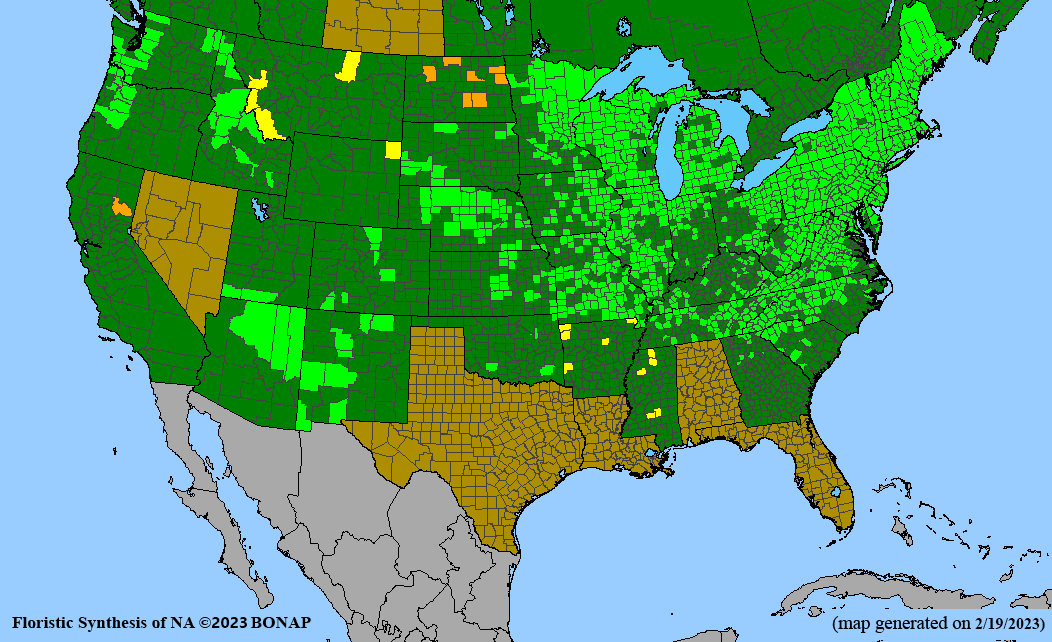
General Comments
Sedges are a large, diverse group of grass-like plants that are important components of prairies, wetlands, and woodlands across our region. In Iowa alone, there are about 120 species of sedges. Grasshoppers and the larvae of skippers and other butterflies and moths feed on sedge foliage, and their seeds are eaten by grassland birds and waterfowl. They are notoriously difficult to identify to species, especially the oval sedges to which broom sedge belongs. The development of stock seed by the Tallgrass Prairie Center in the early 2000s enabled broader access to reliably identified sedge species by native seed growers. Broom sedge is found naturally in moist to wet soils and may benefit from supplemental watering in seed production systems.
Recommendations for Seed Production
- Establishment for seed production
Direct seeding
We do not recommend direct seeding for this species.
Greenhouse
Seed pre-treatment: Benefits from cold-moist stratification for 30 days.
Sowing: Sow in germination flats or directly into plugs (2-3 seeds per cell), covering seed lightly (light improves germination of many sedge species); maintain even moisture until germination. Daytime temperatures should be around 70-80°F (22-27°C) and allowed to drop at night to 50-60°F (10-15°C). We have had good success planting into 2.5 in deep, 73-cell plug flats that are ridged to direct root development downward and have 3/4 in bottom openings to encourage root pruning and the formation of firmly rooted plugs for transplanting.
Transplanting: Seedlings are ready to transplant to an irrigated field about 10 weeks after sowing. Pop out a few plugs to check for adequate root development that will provide sturdy plugs for planting. A week or two before transplanting, move flats outside to ‘harden off.’
- Stand management
Weeds: Plastic mulch reduces weed pressure in the first year or more. Holes in the plastic should be widened somewhat in subsequent years to allow the bunches to expand. Bunching plants are robust and leafy, competing well with many weeds; we have interplanted broom sedge with cardinalflower to provide support and reduce weed pressure (note: interplanting necessitates hand harvest of the sedge and eliminates broadleaf herbicides as an option). In large-scale production systems or those where the use of weed barriers and/or hand weeding is not practical, herbicides (e.g., broad-leaf herbicides and/or pre-emergents) may be useful to prevent weeds from competing with the sedge plants and/or complicating the seed cleaning process. Significant weed problems may be caused by winter annuals (e.g., members of the mustard family), other small-seeded broad-leaf annuals, and annual grasses (e.g., downy brome). Herbicide applications should be timed to most effectively control specific weeds and minimize damage to the sedge plants. Care must be taken to read affected “weed” lists, as sedges are considered weeds in crop systems. Always read and follow label instructions.
Pests: None noted.
Diseases: None noted.
Soil moisture: Irrigation is recommended. Drip tape can be applied under plastic mulch as planting beds are formed.
- Seed production
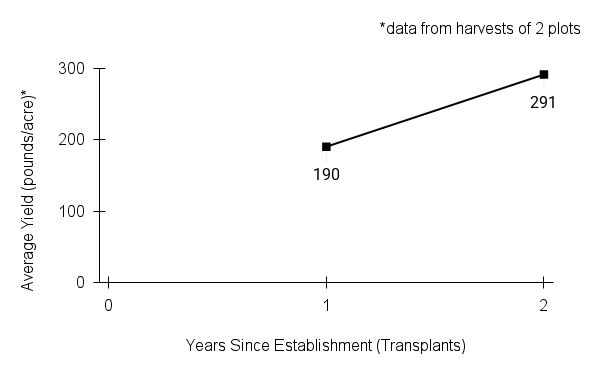 First harvest: First harvest one year after transplanting
First harvest: First harvest one year after transplantingYield/acre: 190-290 pounds per acre (extrapolated from cleaned seed harvested from two plots at TPC)
Stand life: Unknown, but plants are likely long-lived and should continue to be productive with proper weed management.
Flowering date: June
Seed maturity/Harvest date: Late June to early July in northeastern Iowa
Seed retention: Moderate risk of shattering at maturity; also vulnerable to lodging, potentially complicating combine harvest.
Harvest date range at TPC (2010-2023): June 28 - July 3
Recommended harvest method: We have harvested small plots using hand sickles; seed threshes easily after drying on tarps. Combining should also work well, if seed is mature.
- Seed cleaning and storage
Cleaning process: Air-dry seed for two weeks or more after harvest. Pass material through a coarse screen (1/2 in hardware cloth) to remove larger stemmy material, if needed, then air screen.
Seed storage: Cool/dry (33-50° F, 30-50% RH)
Released Germplasm
Source Identified material: Natural Selections/Iowa Ecotype Zone IA
- References
Carex scoparia (Pointed Broom Sedge). Minnesota Wildflowers. (n.d.). https://www.minnesotawildflowers.info/grass-sedge-rush/pointed-broom-sedge
Houseal, G. (2010). Plasticulture for seed production of wetland (Carex) species. Native Plants Journal, 11(1), 58-64. https://doi.org/10.2979/NPJ.2010.11.1.58
Kartesz, J.T., The Biota of North America Program (BONAP). 2023. North American Plant Atlas. (http://bonap.net/napa). Chapel Hill, N.C. [maps generated from Kartesz, J.T. 2023. Floristic Synthesis of North America, Version 1.0. Biota of North America Program (BONAP). (in press)]
Kettenring and Galatowitsch (2007) https://www.sciencedirect.com/science/article/pii/S030437700700085X
Kettenring KM, Gardner G, Galatowitsch SM. Effect of light on seed germination of eight wetland Carex species. Ann Bot. 2006 Oct;98(4):869-74. doi: 10.1093/aob/mcl170. Epub 2006 Aug 11. PMID: 16905568; PMCID: PMC2806167.
Mohlenbrock, R. H. (1999). Carex scoparia. In Illustrated Flora of Illinois - Sedges: Carex (p. 108). Southern Illinois University Press.
Murphy, M. & Spyreas, G. & Marcum, P. (2025) Carex of Illinois & Surrounding States: The Oval Sedges. University of Illinois Press
NatureServe. 2024. NatureServe Network Biodiversity Location Data accessed through NatureServe Explorer [web application]. NatureServe, Arlington, Virginia. Available https://explorer.natureserve.org/. (Accessed: February 29, 2024).
Pointed Broom Sedge. Illinois Wildflowers. (n.d.). https://www.illinoiswildflowers.info/grasses/plants/pb_sedge.htm
USDA NRCS National Plant Data Team. (n.d.). Carex scoparia Schkuhr ex Willd.. USDA plants database. https://plants.usda.gov/home/plantProfile?symbol=CASC11
Species Guide Updated 2/7/2025
